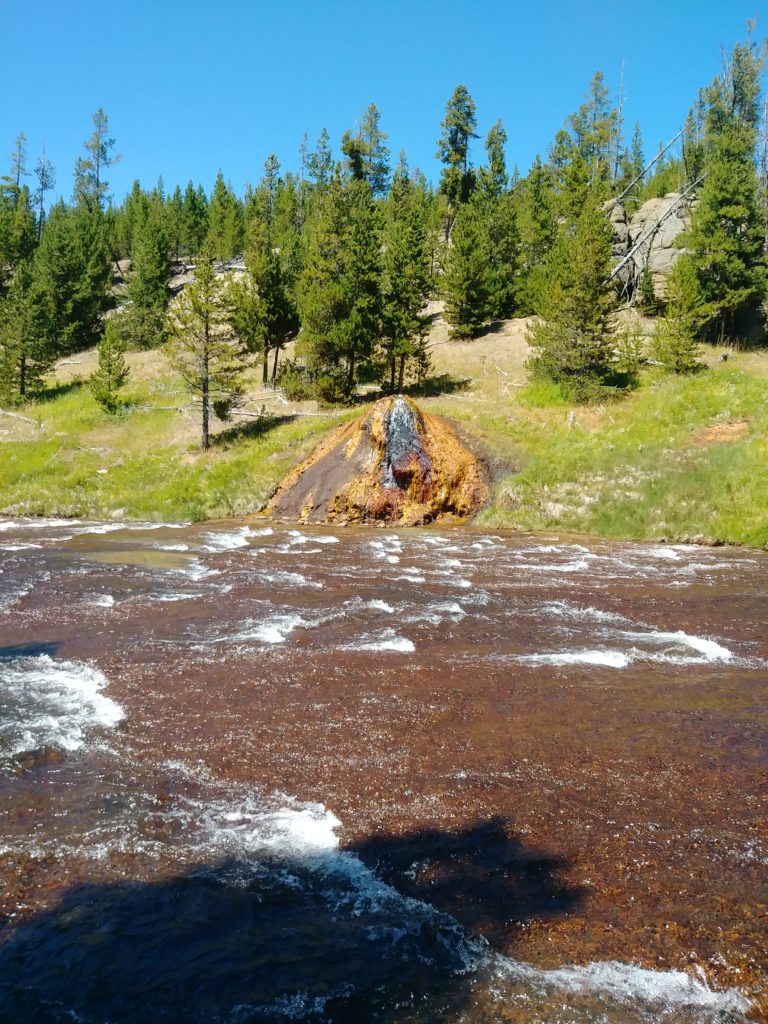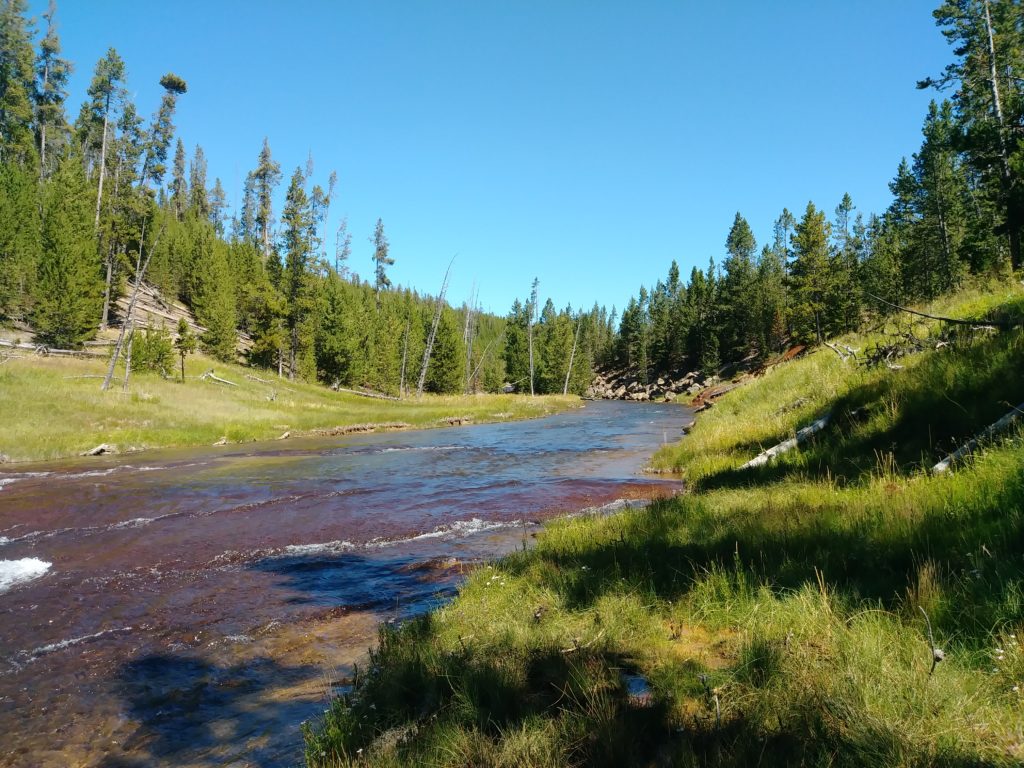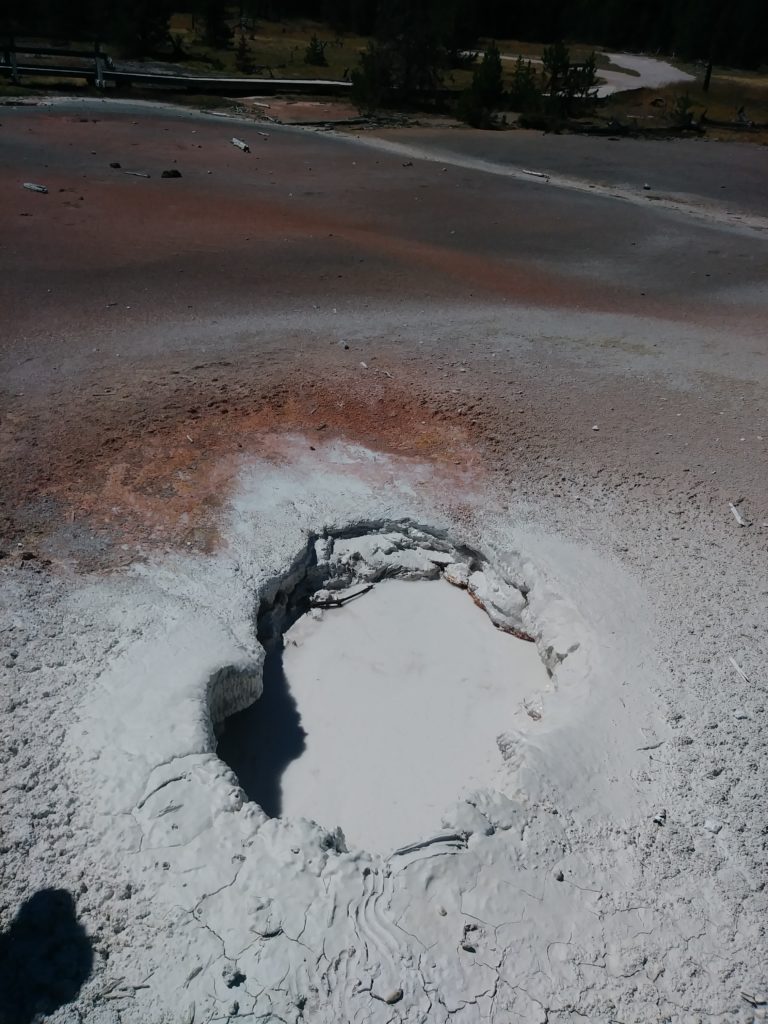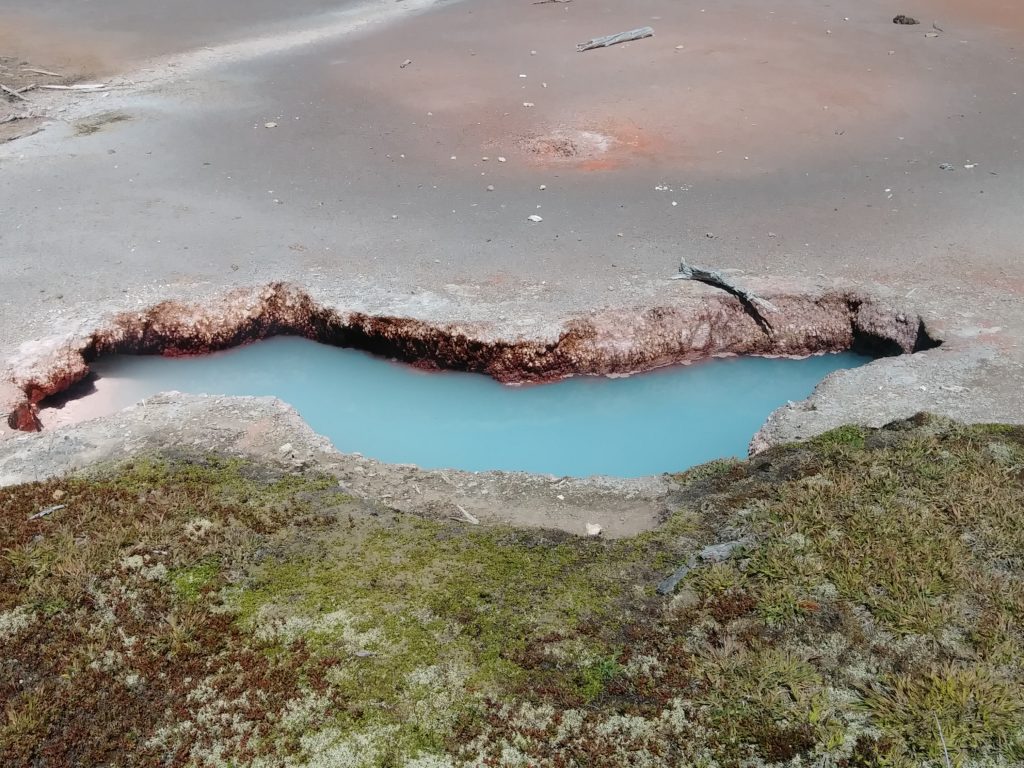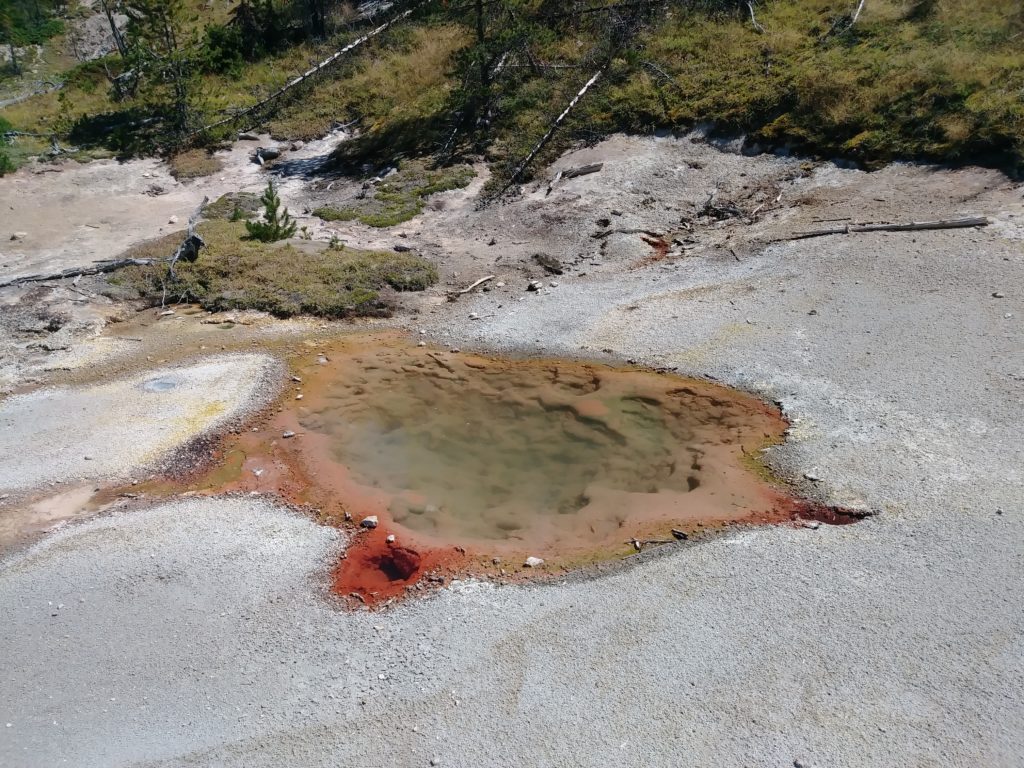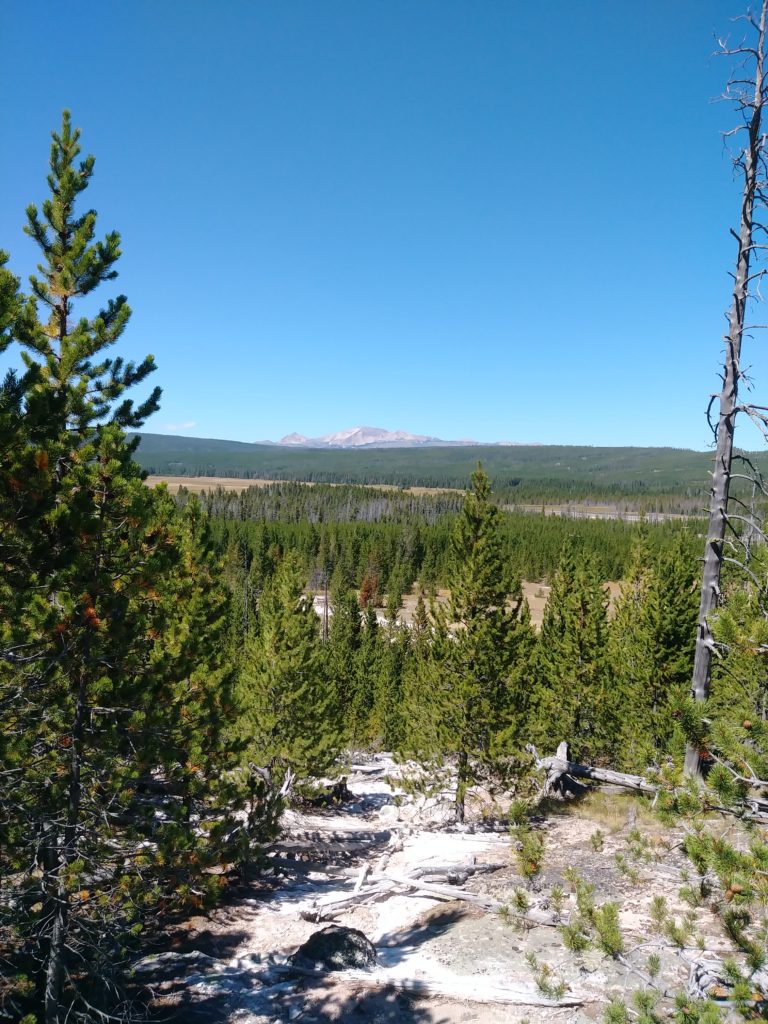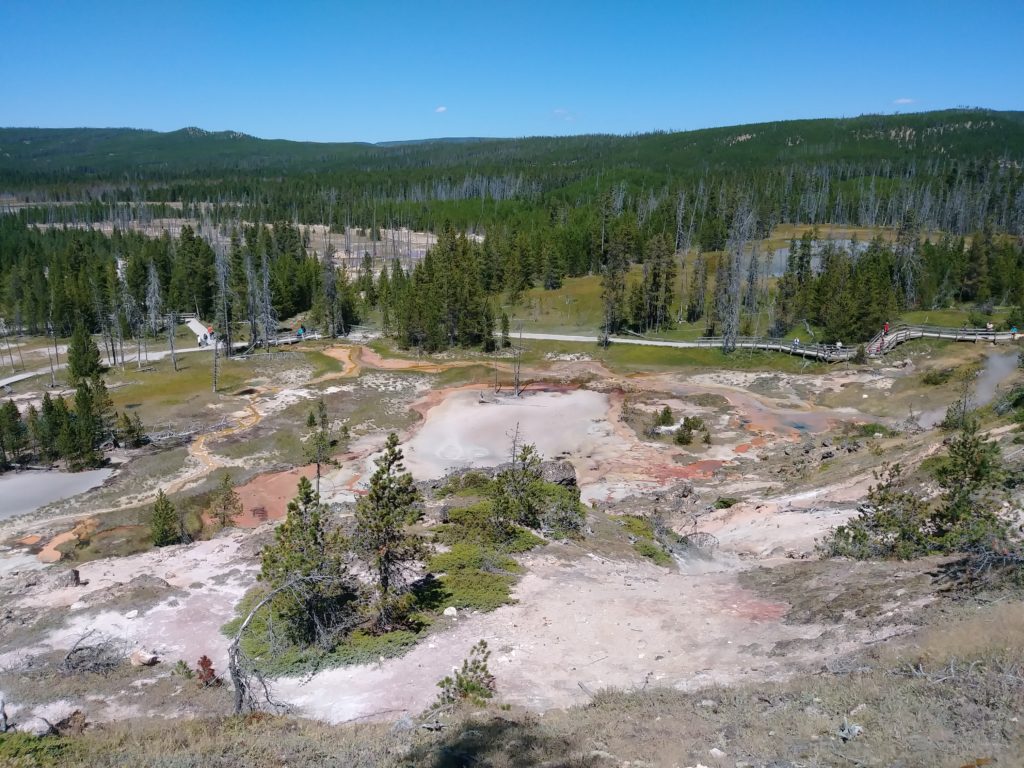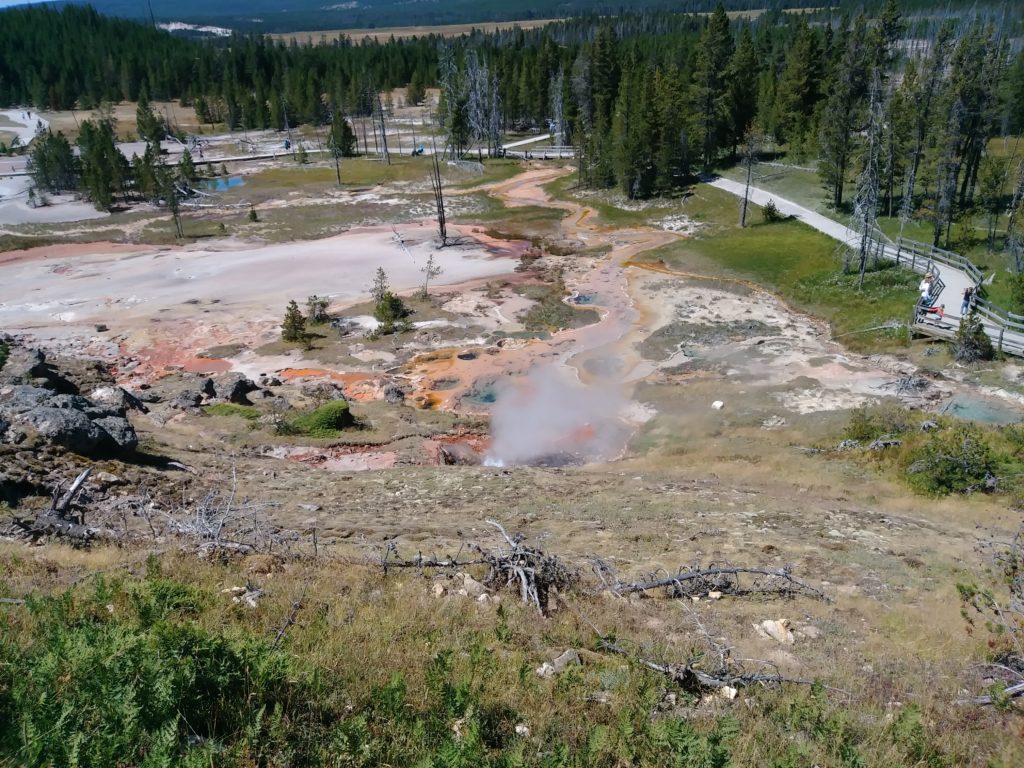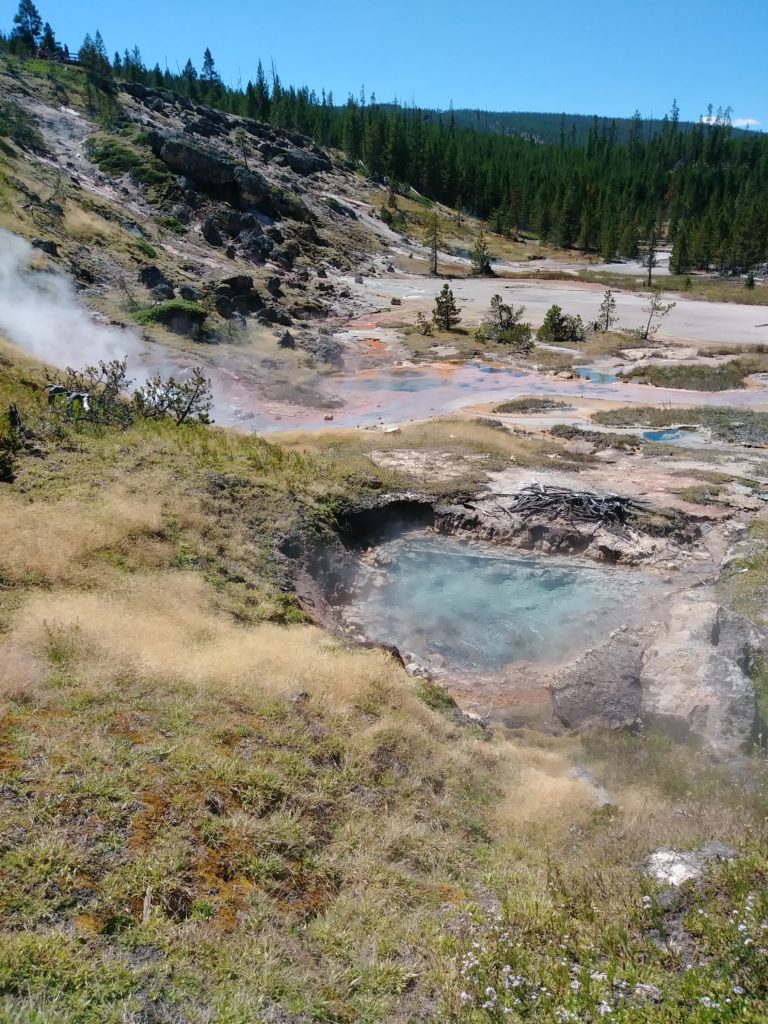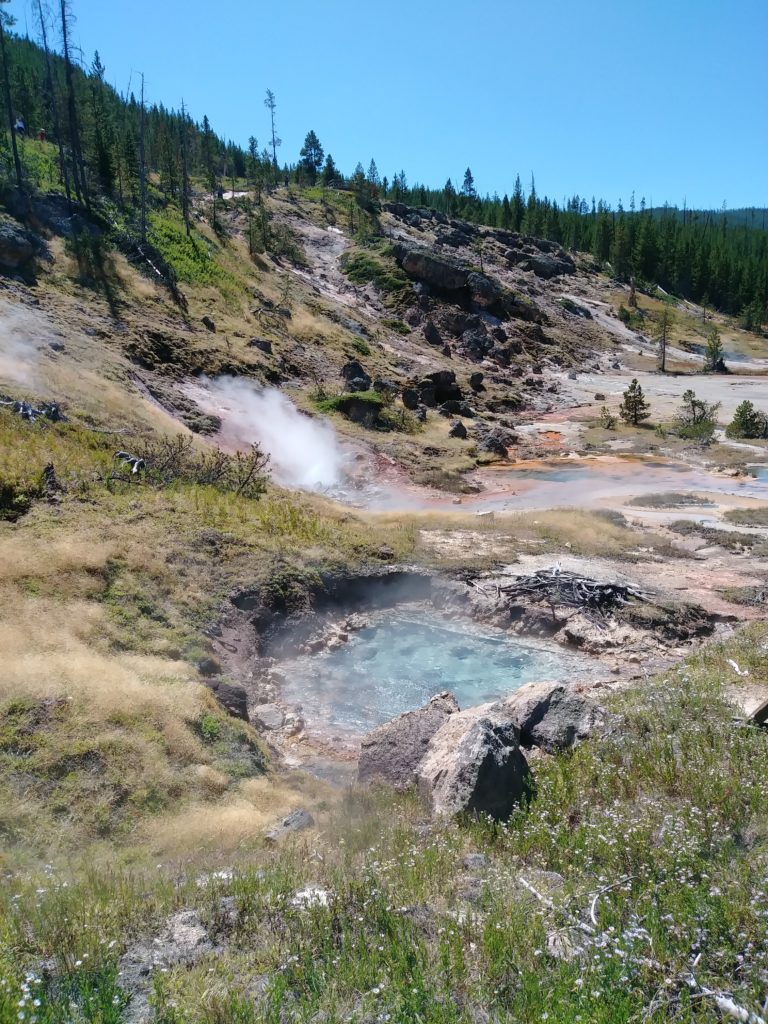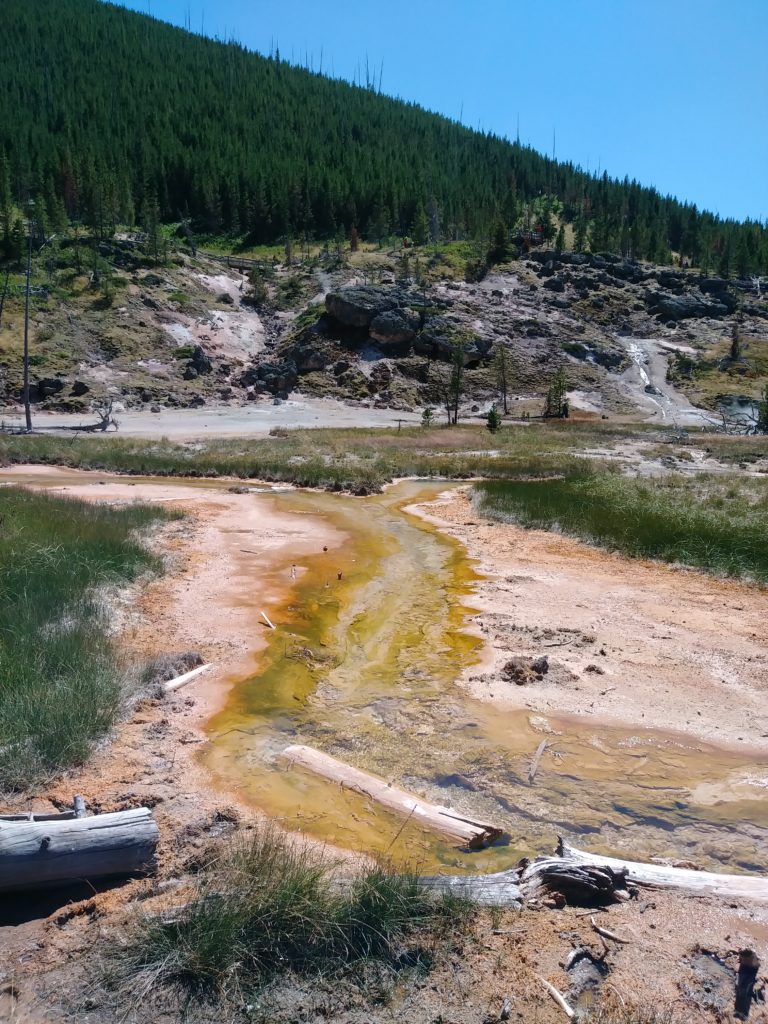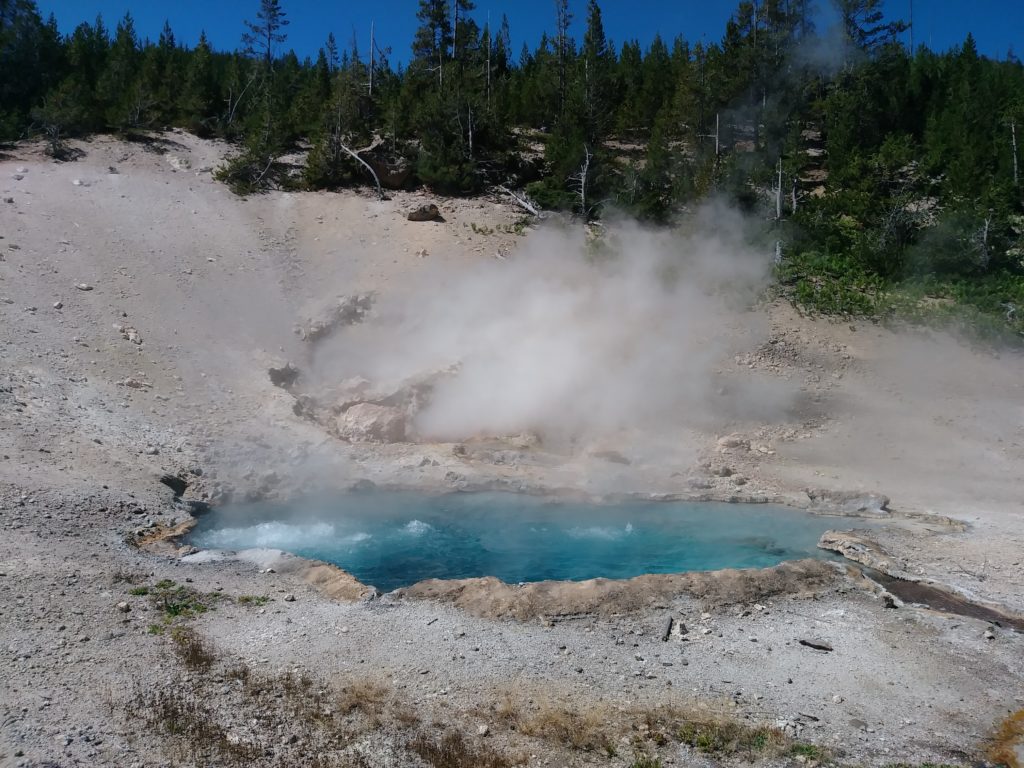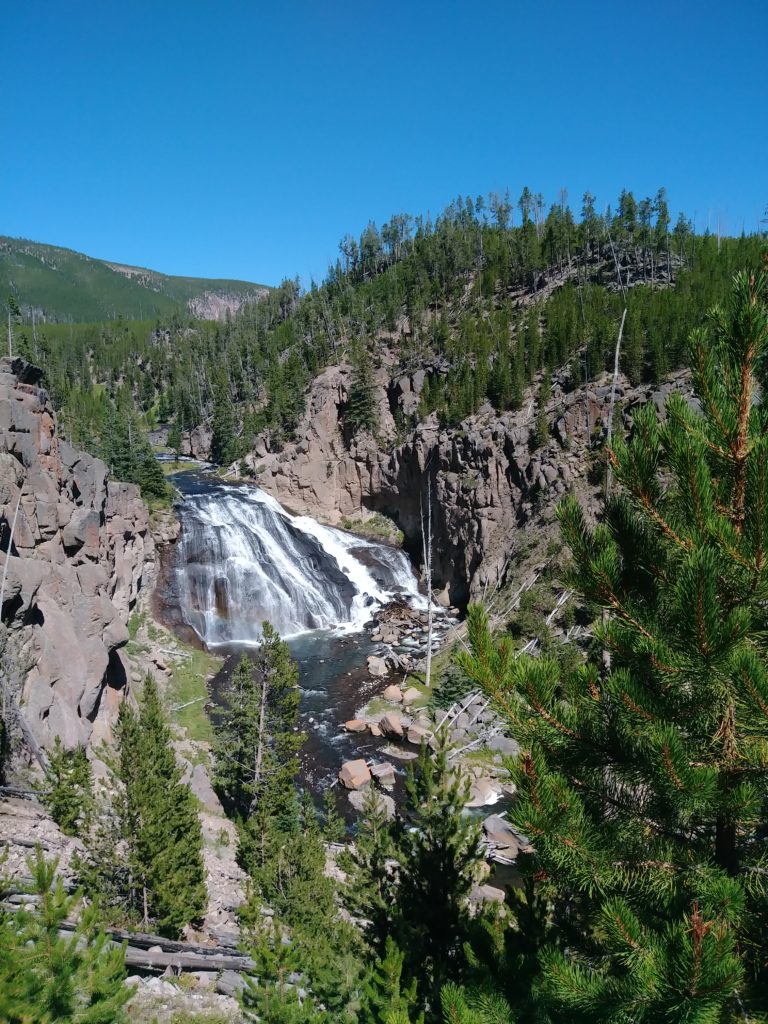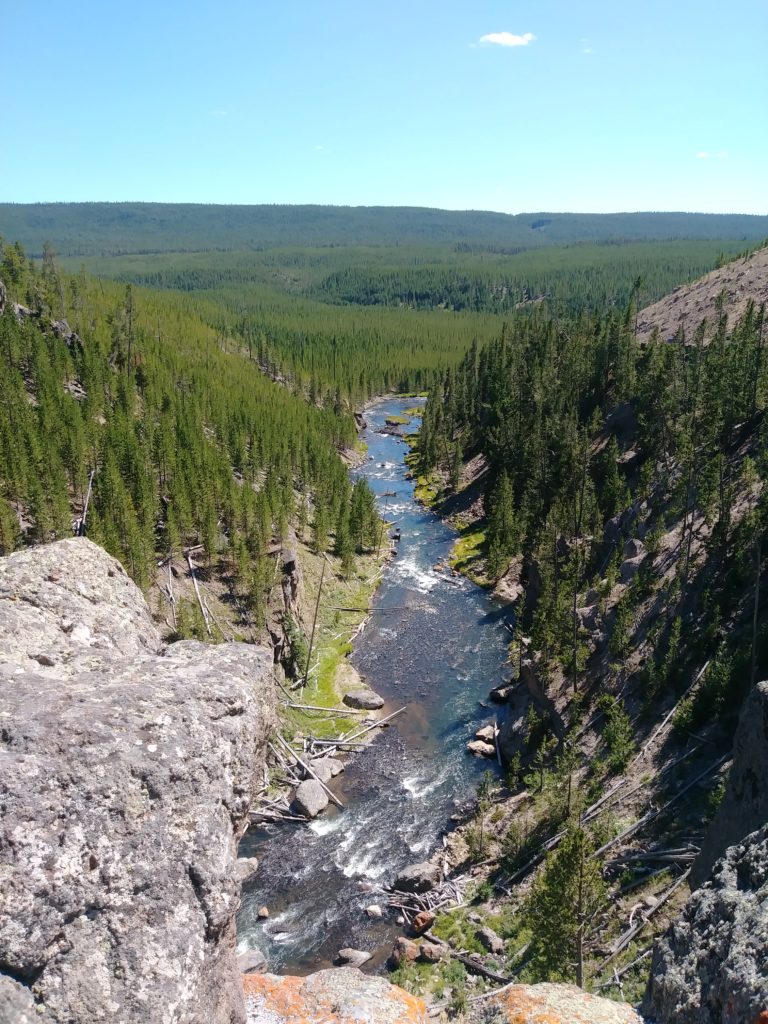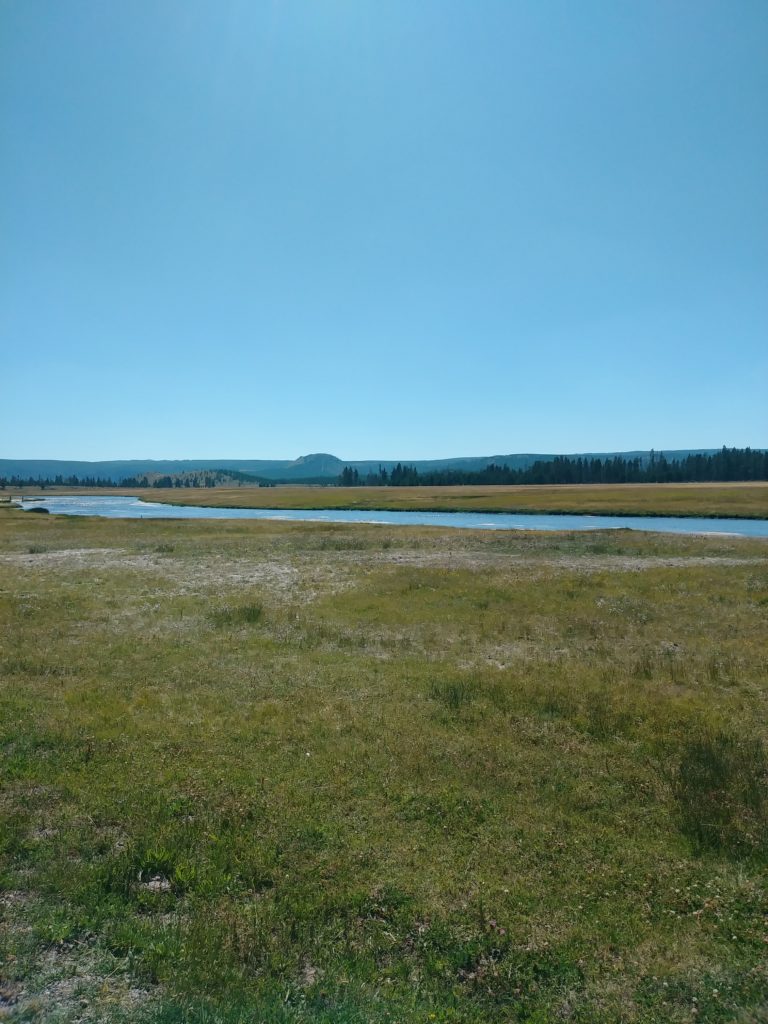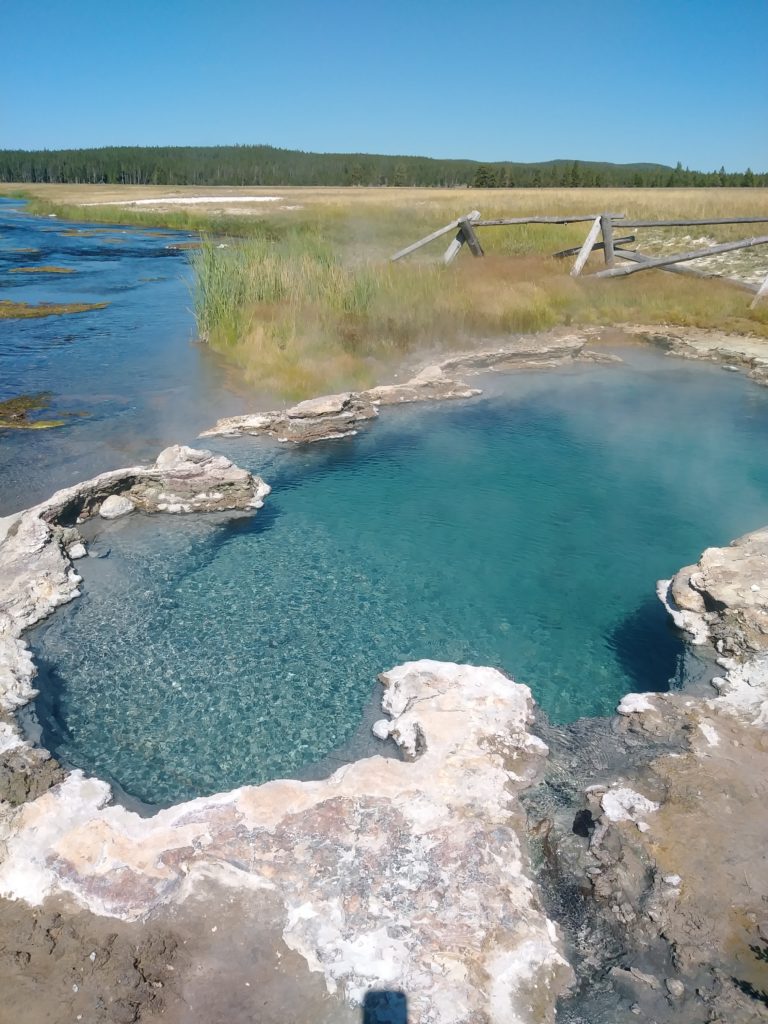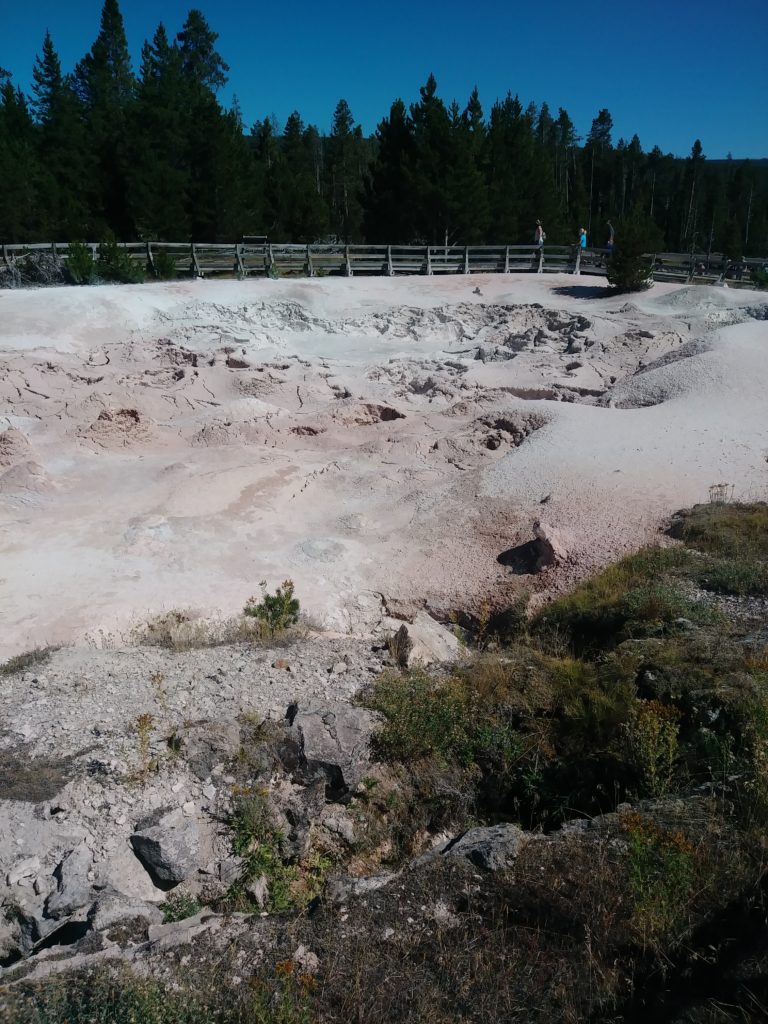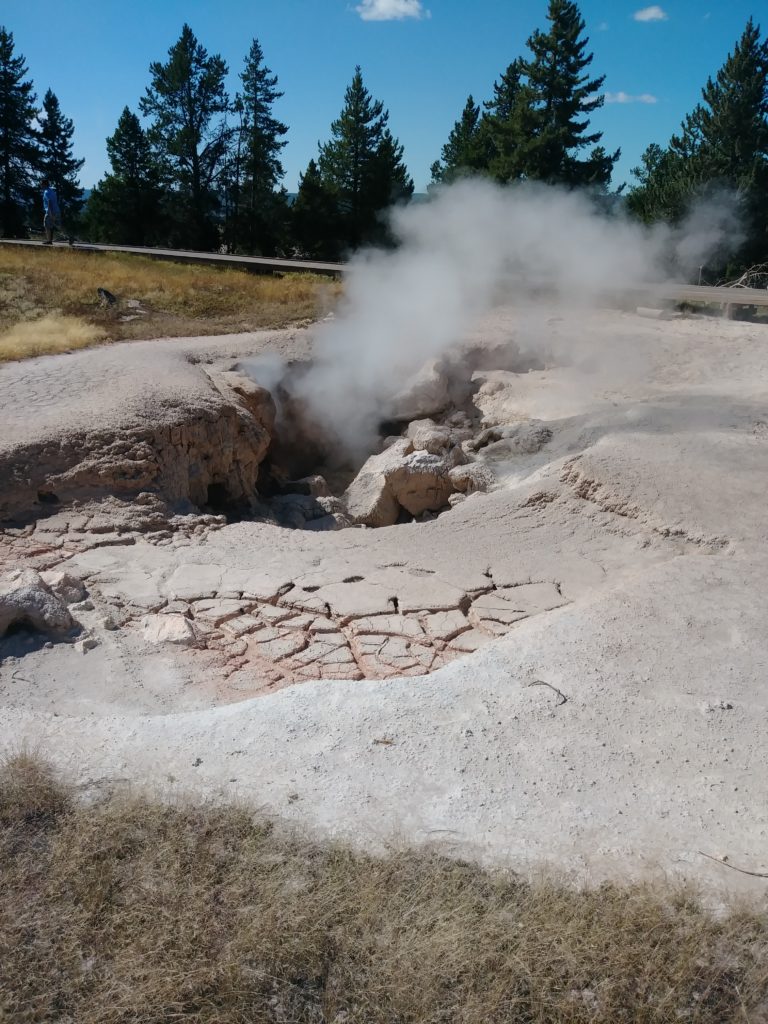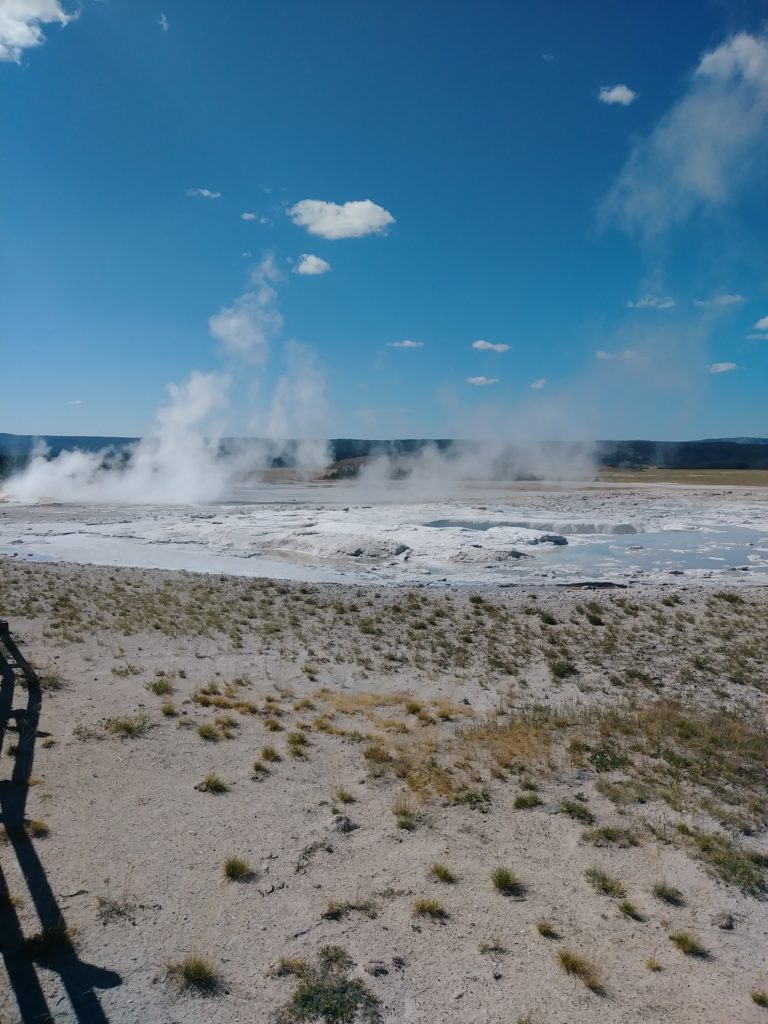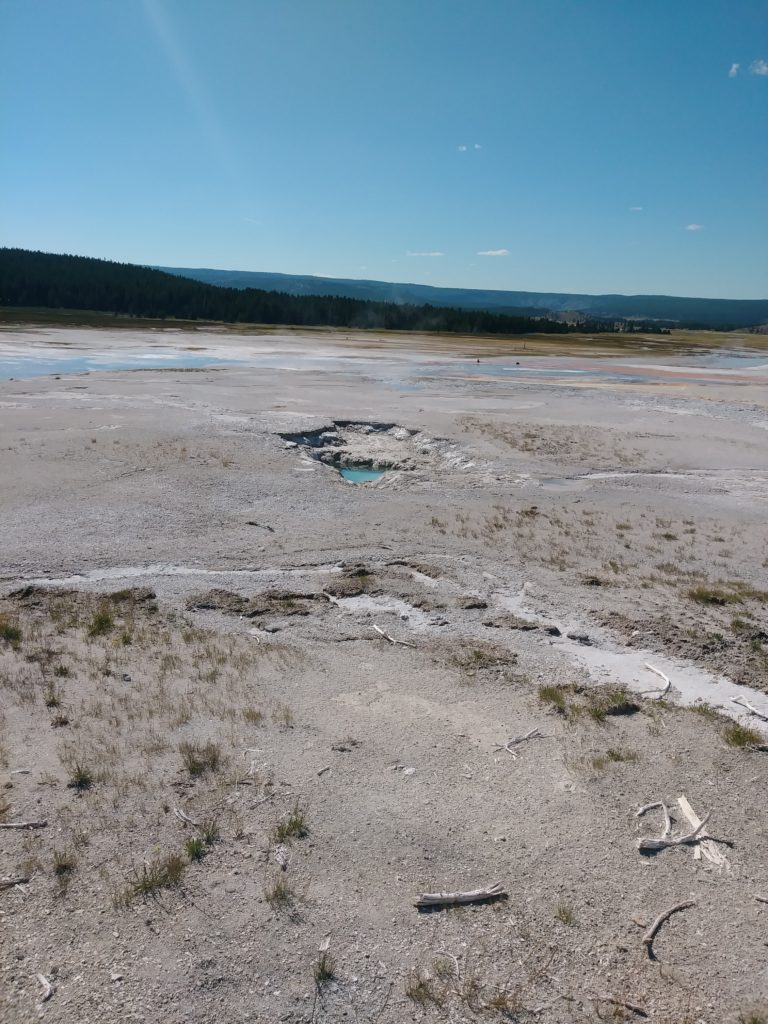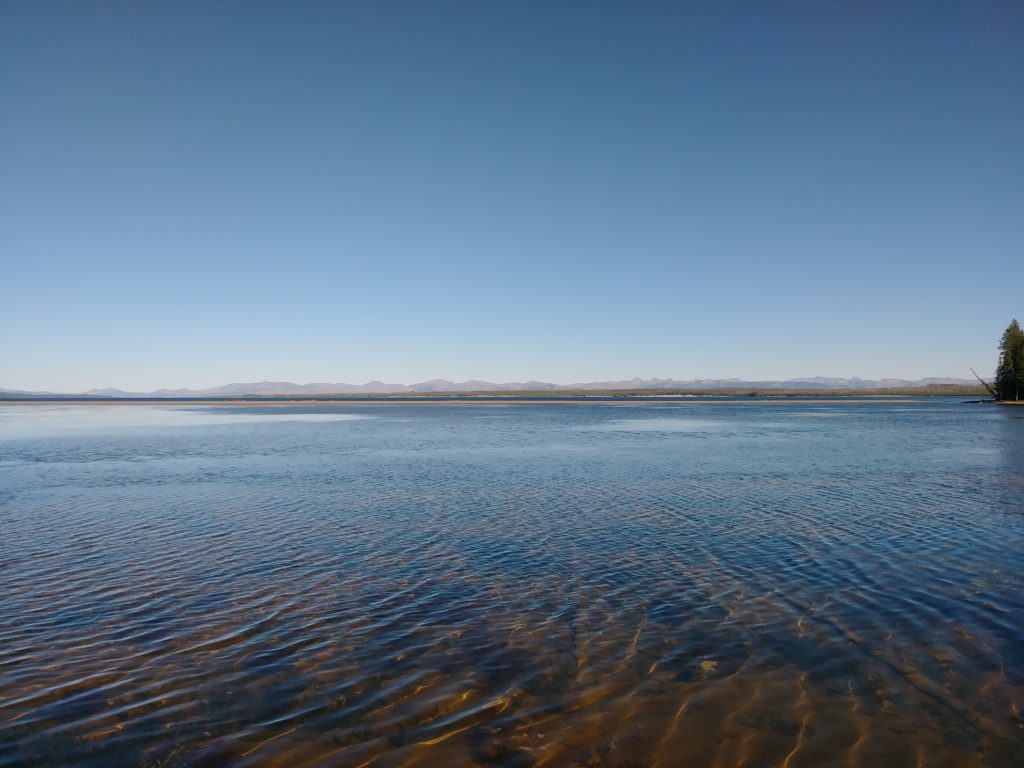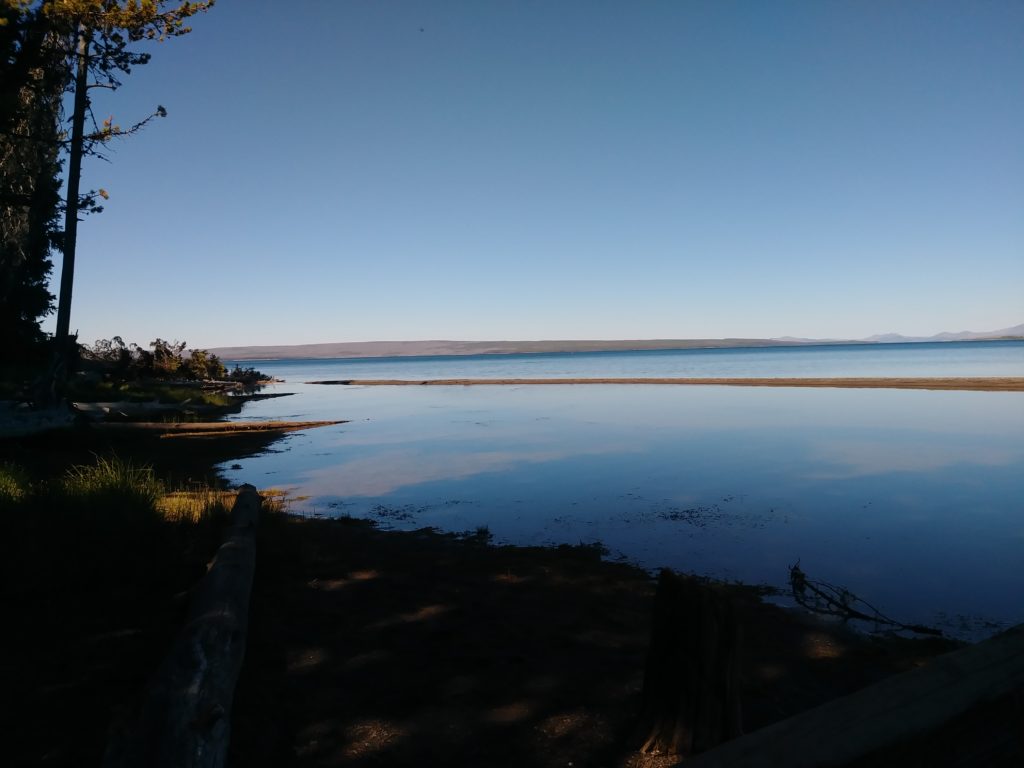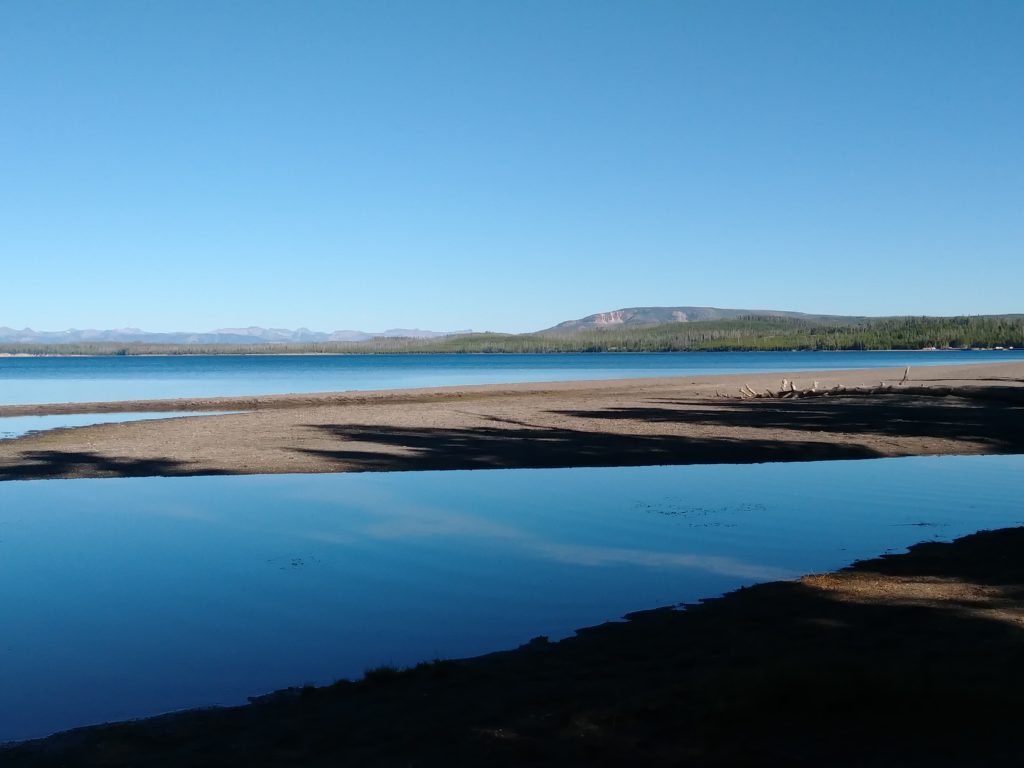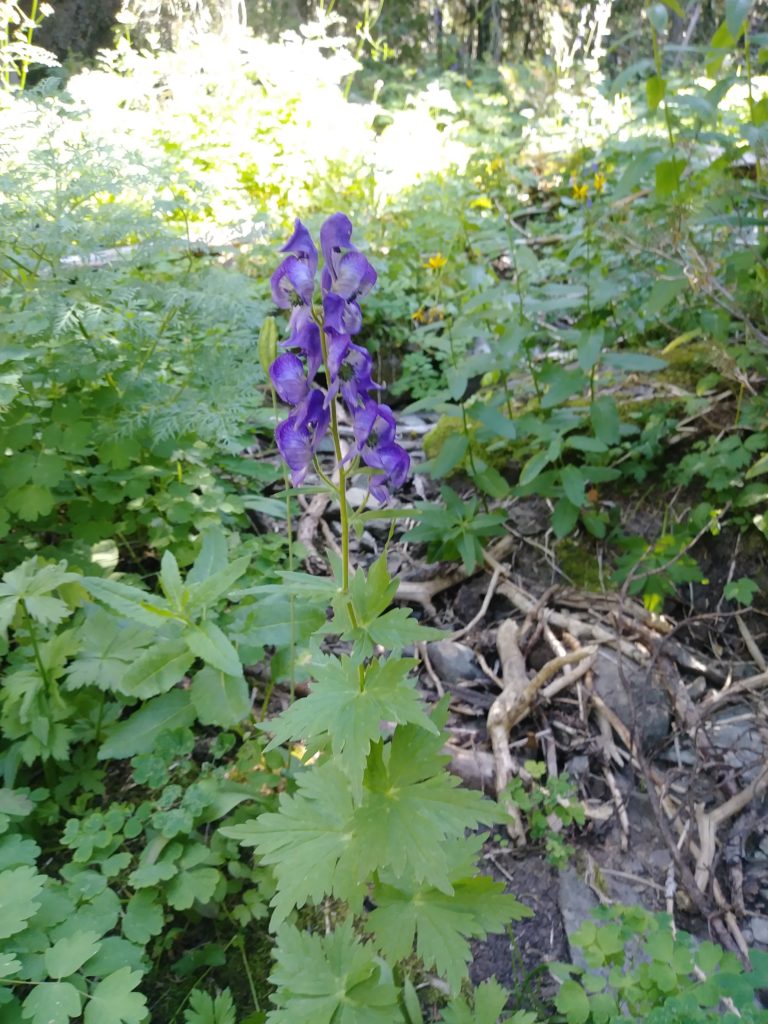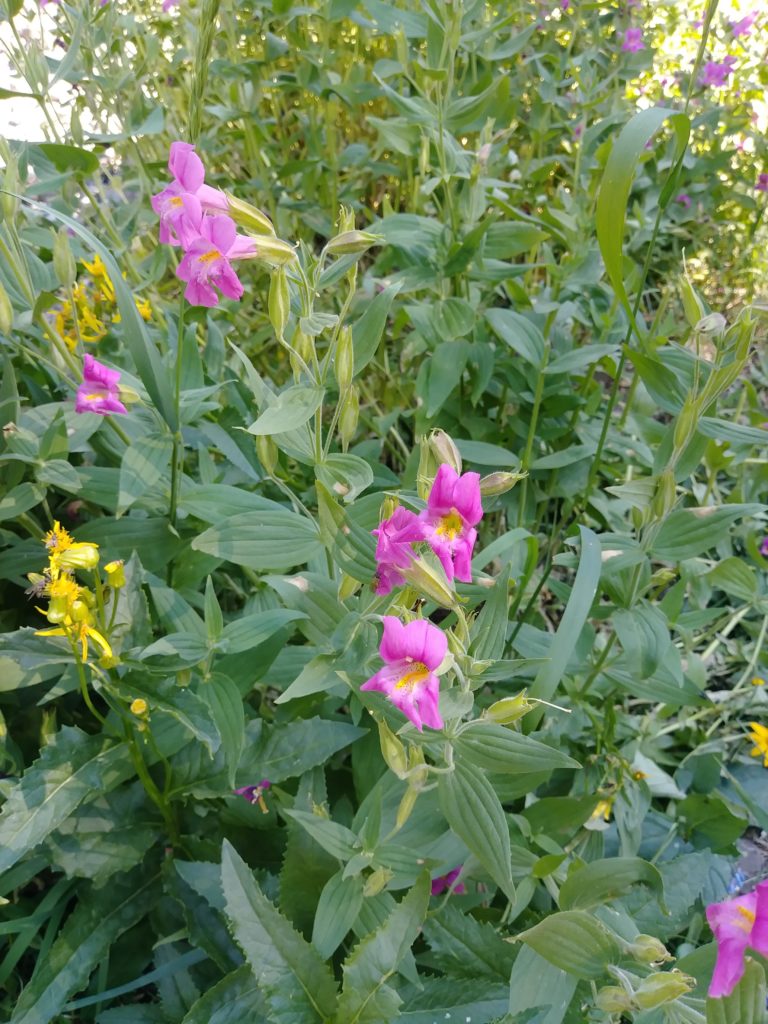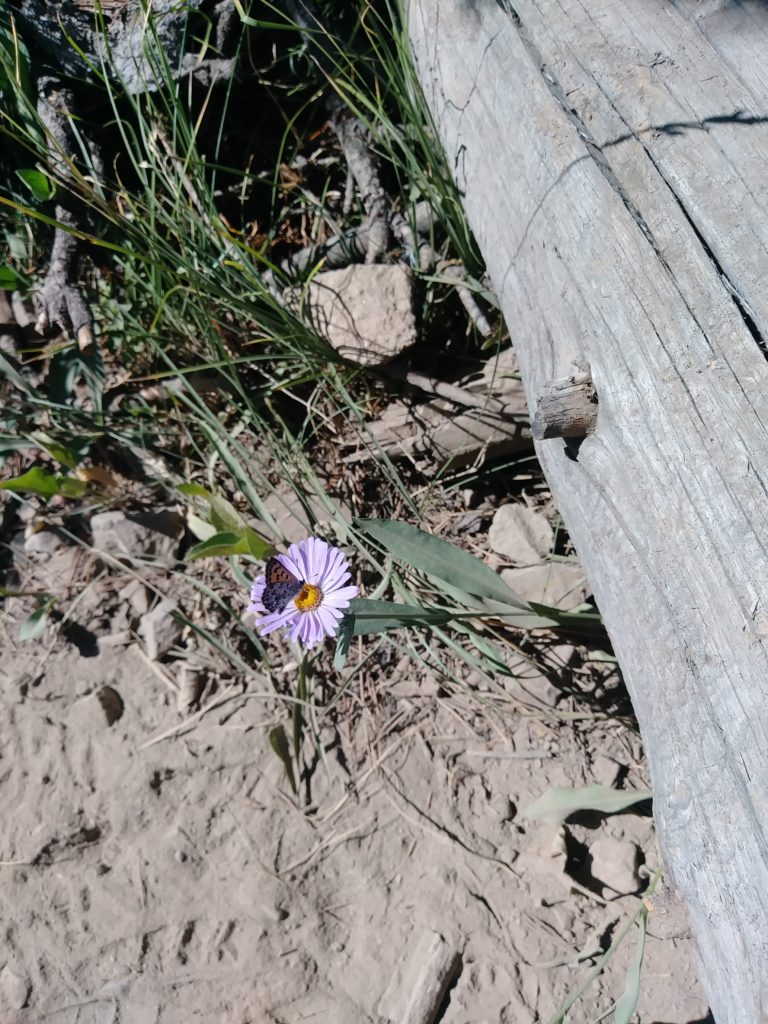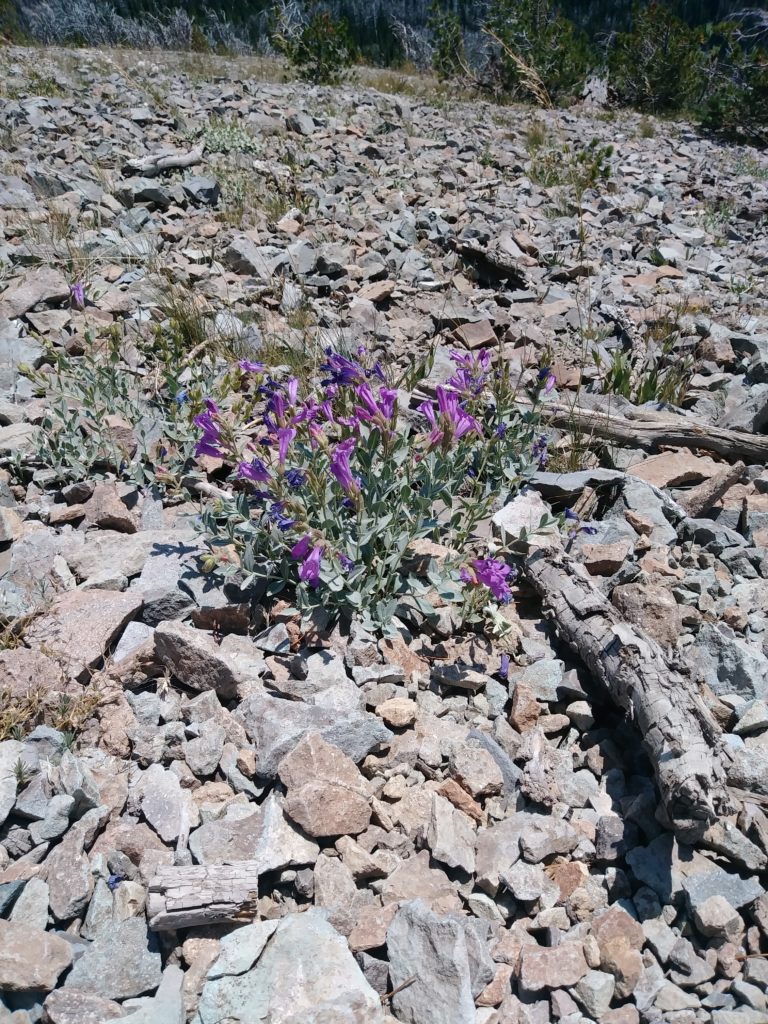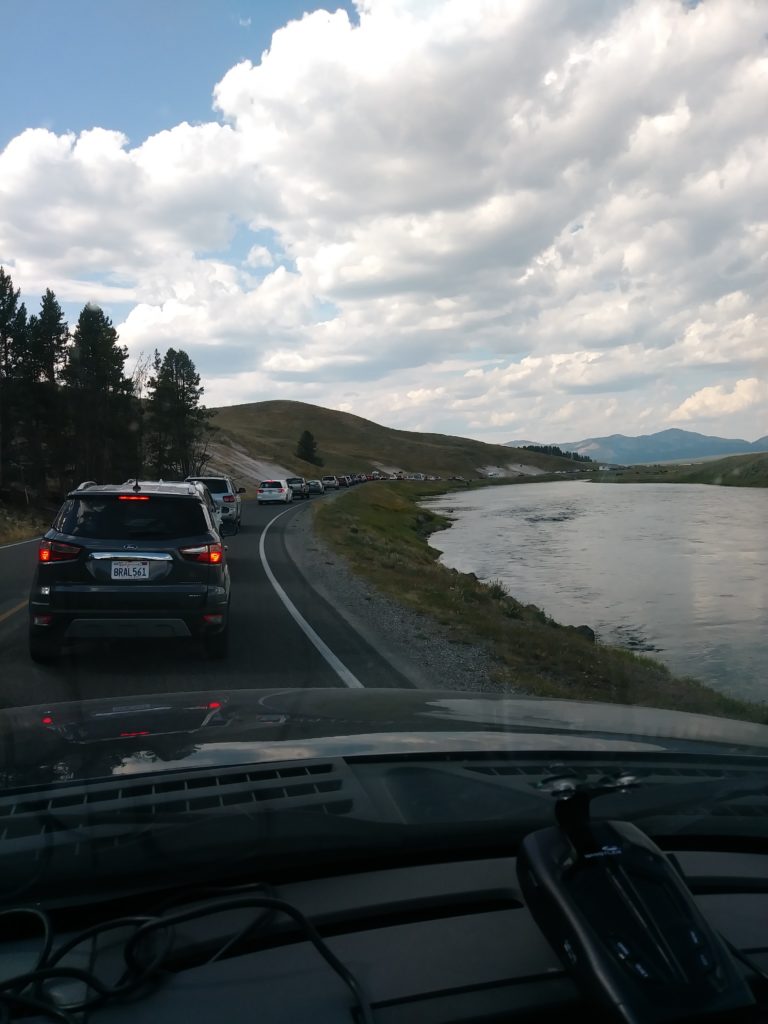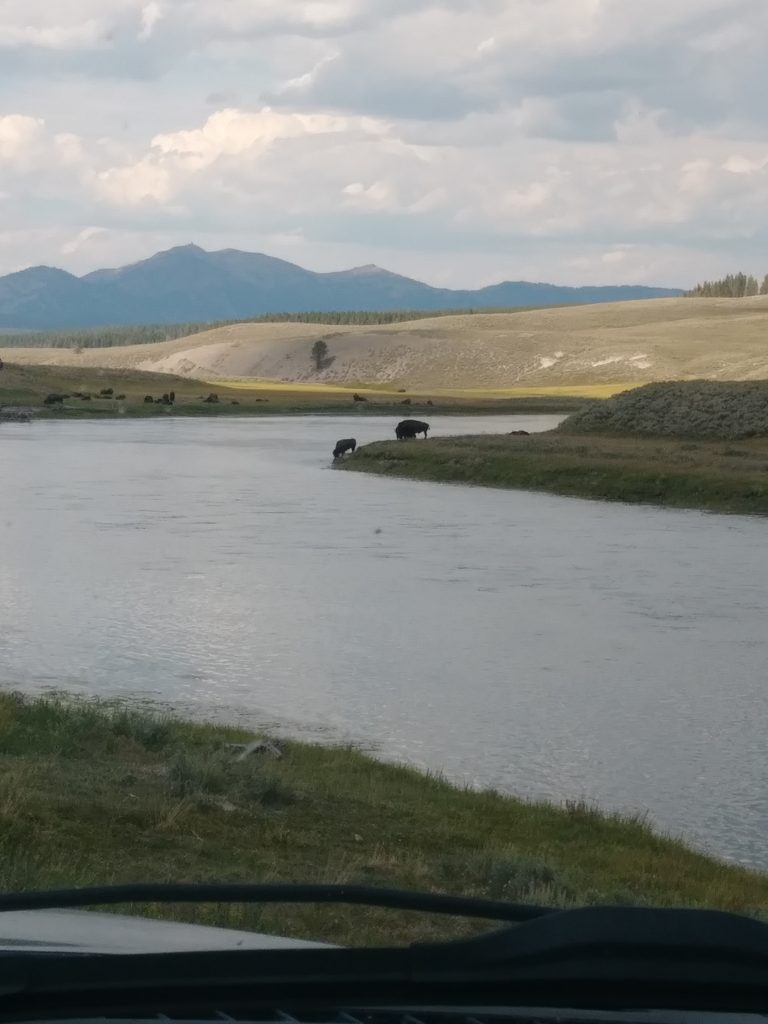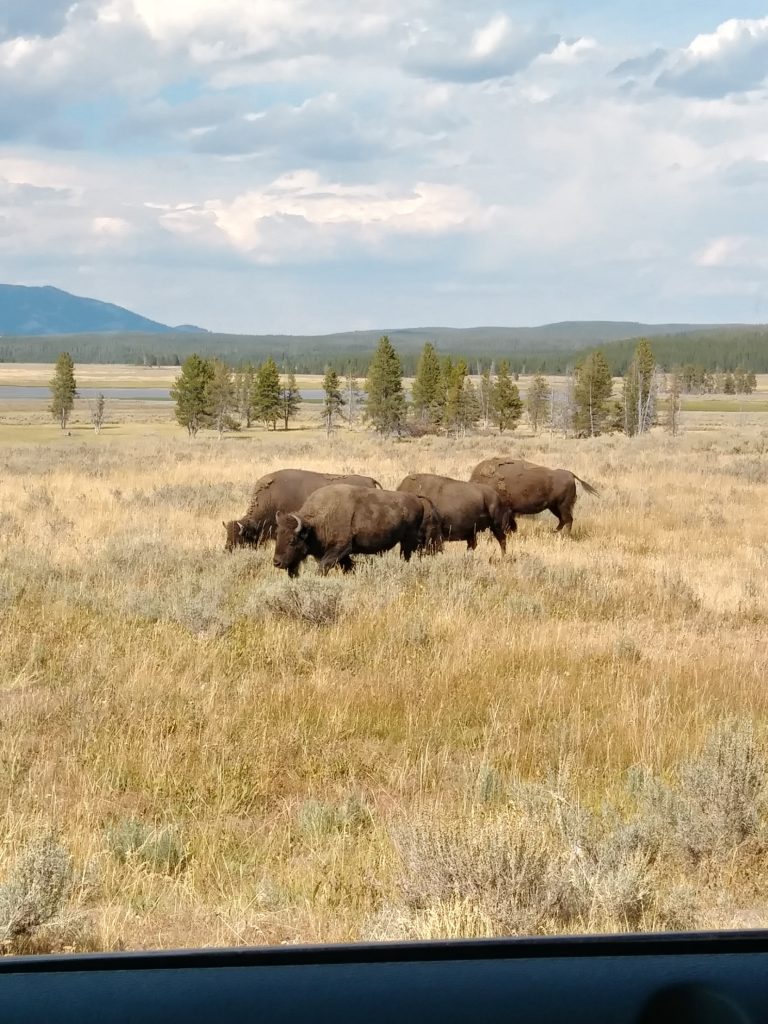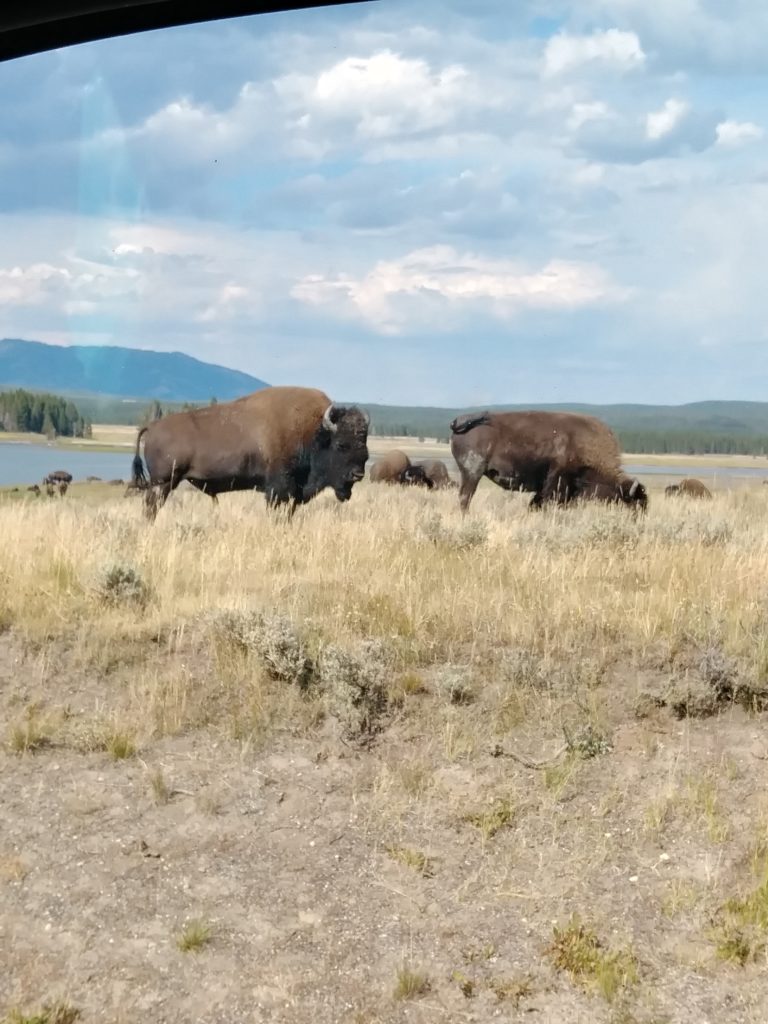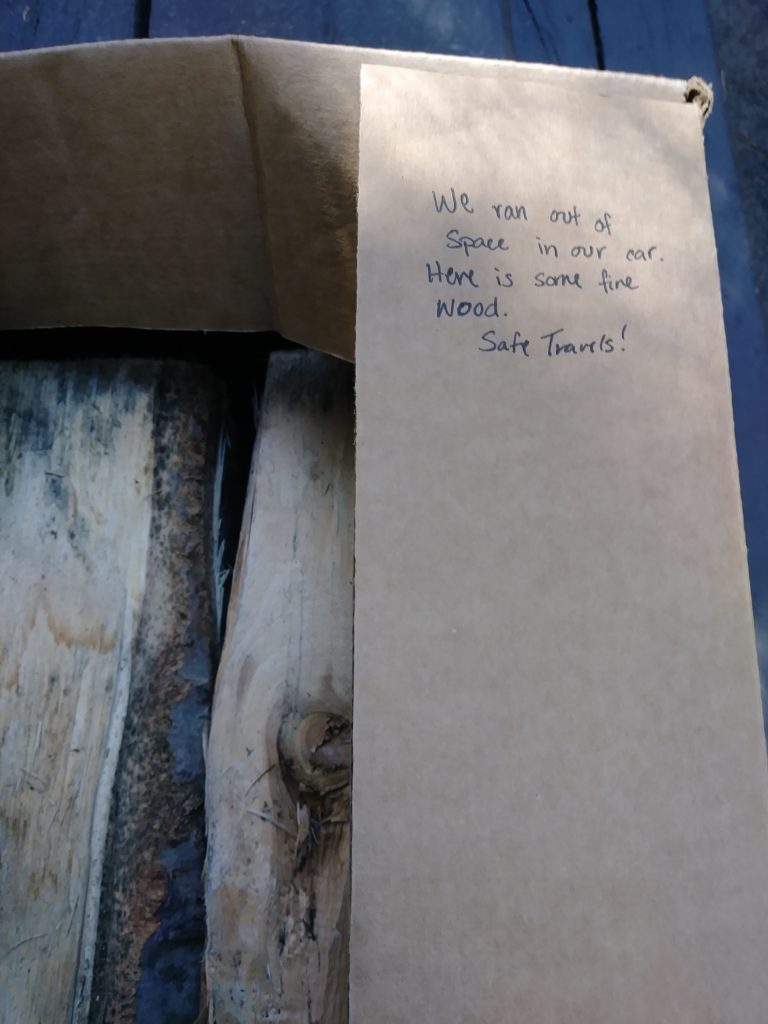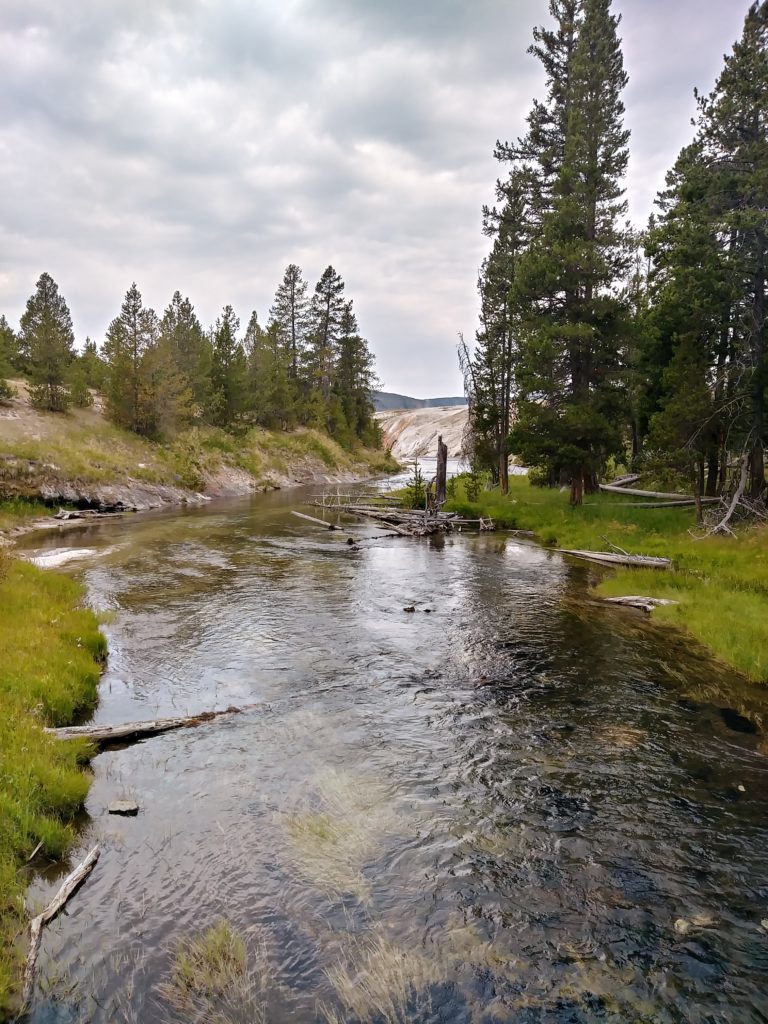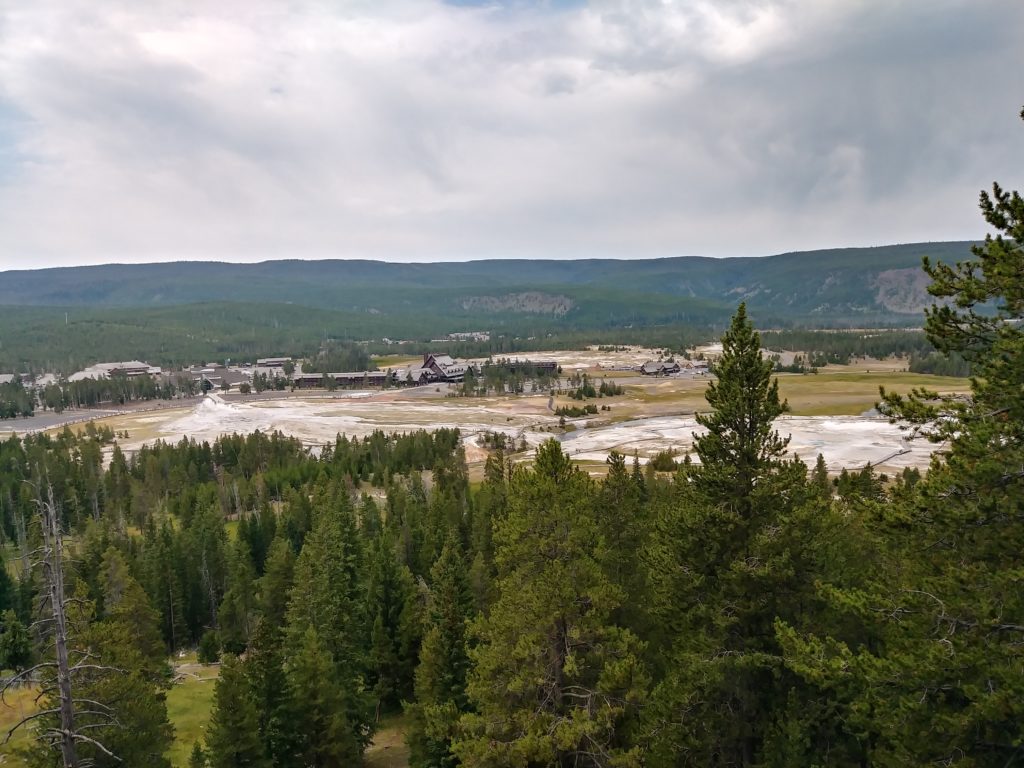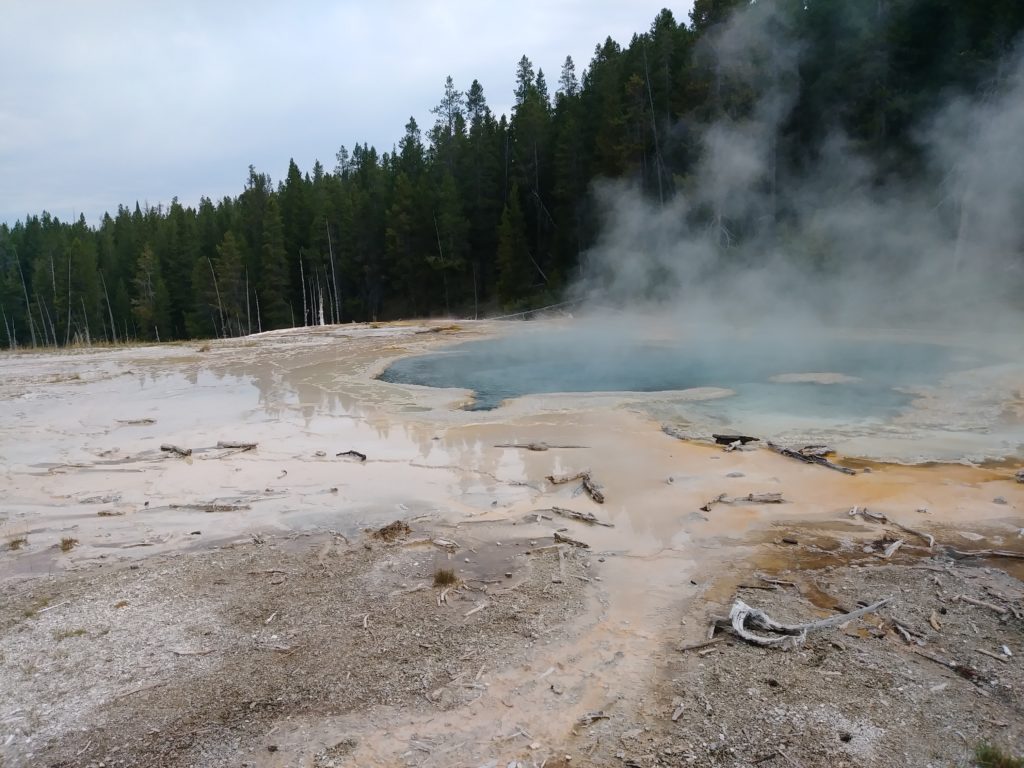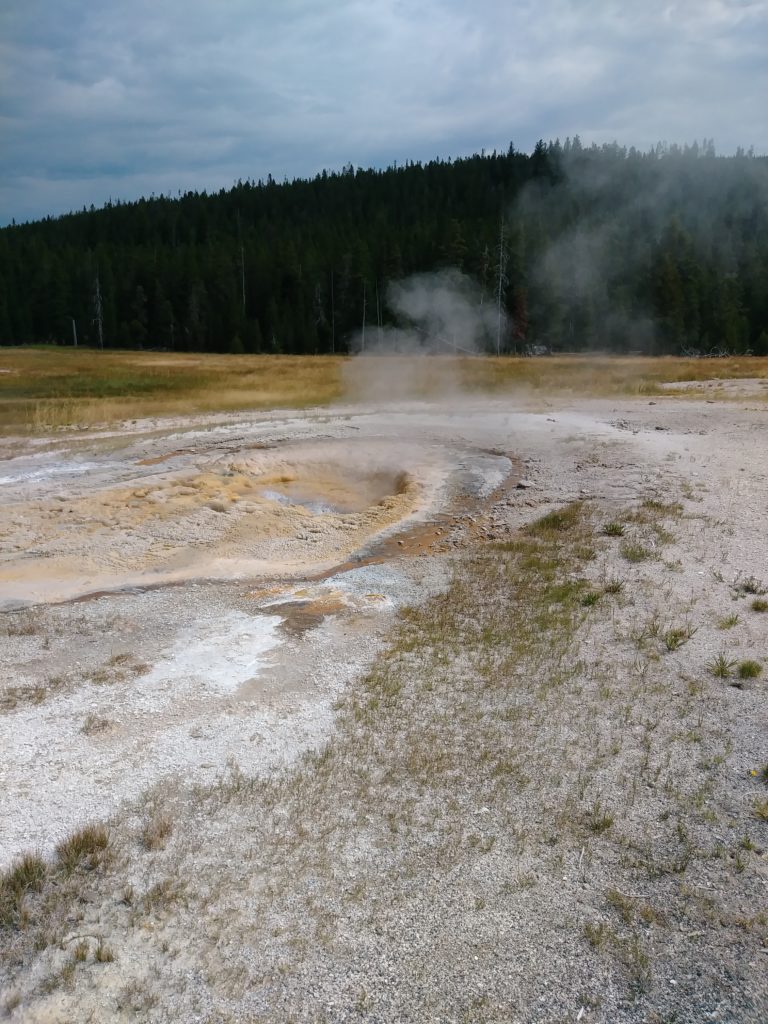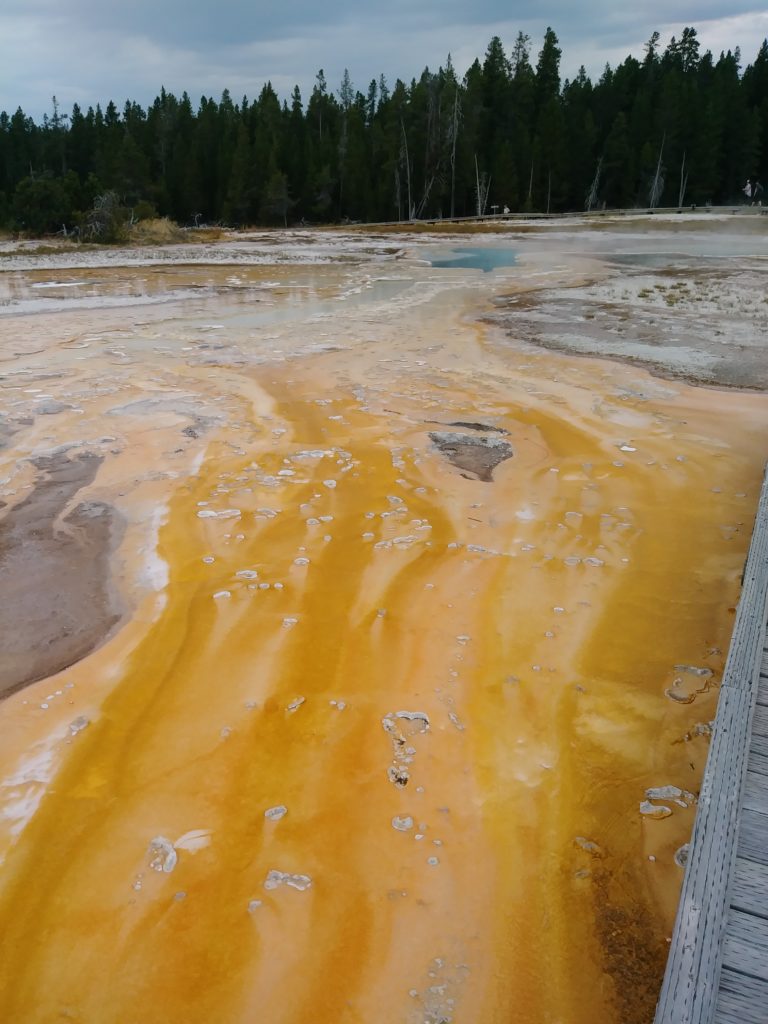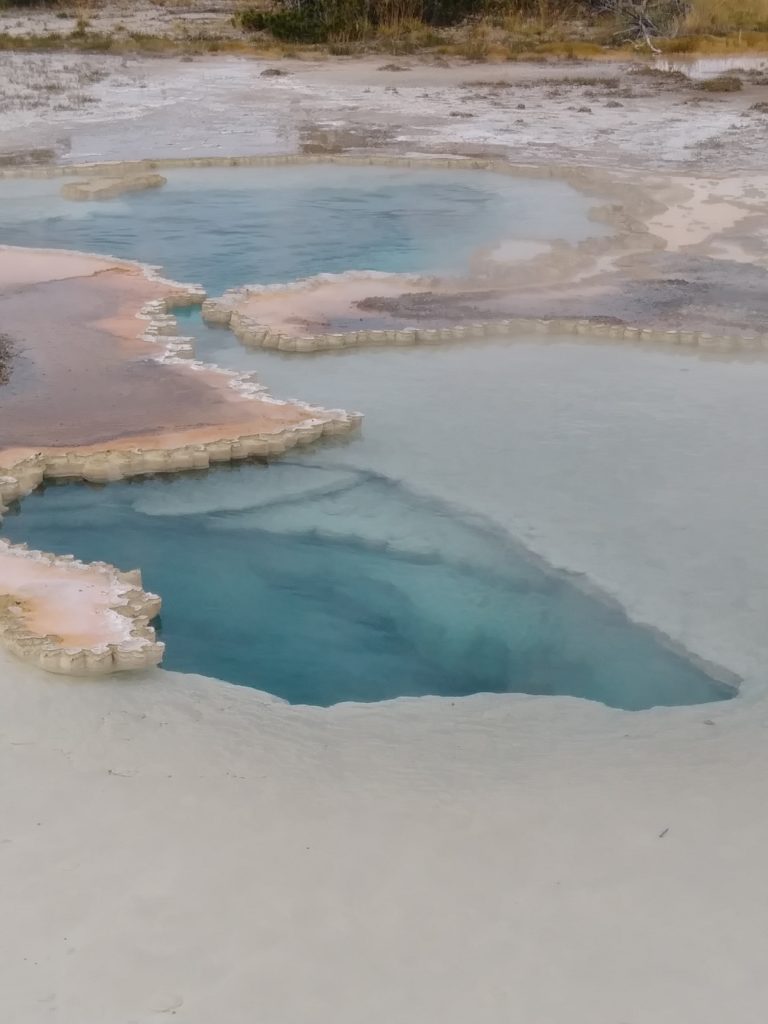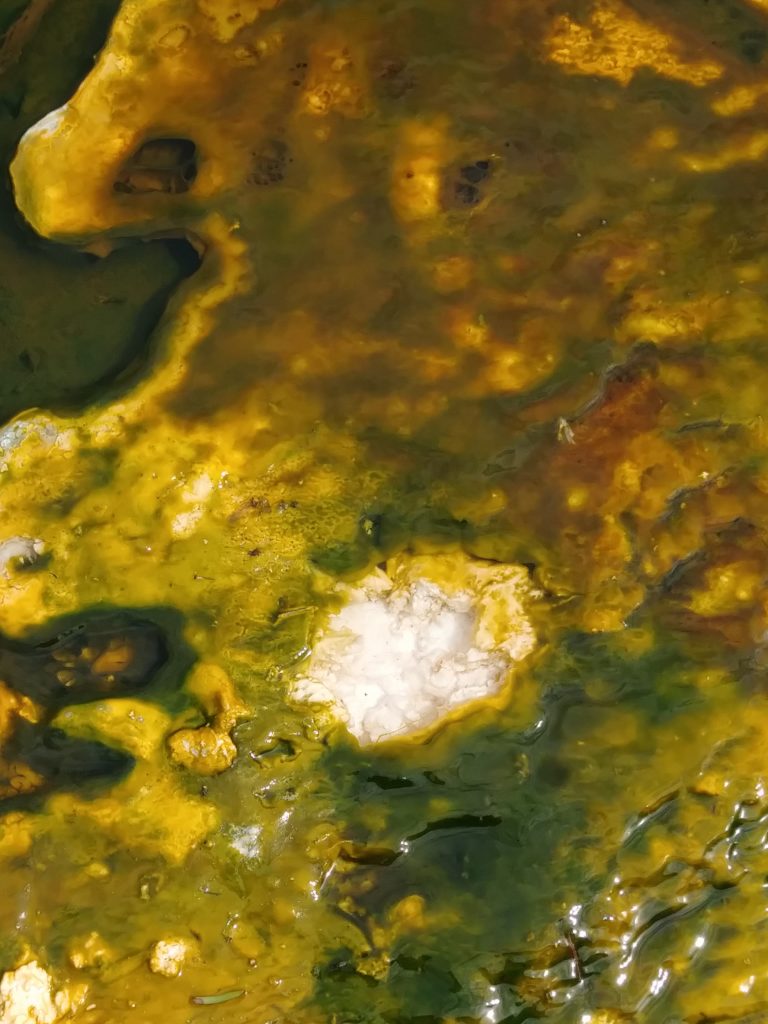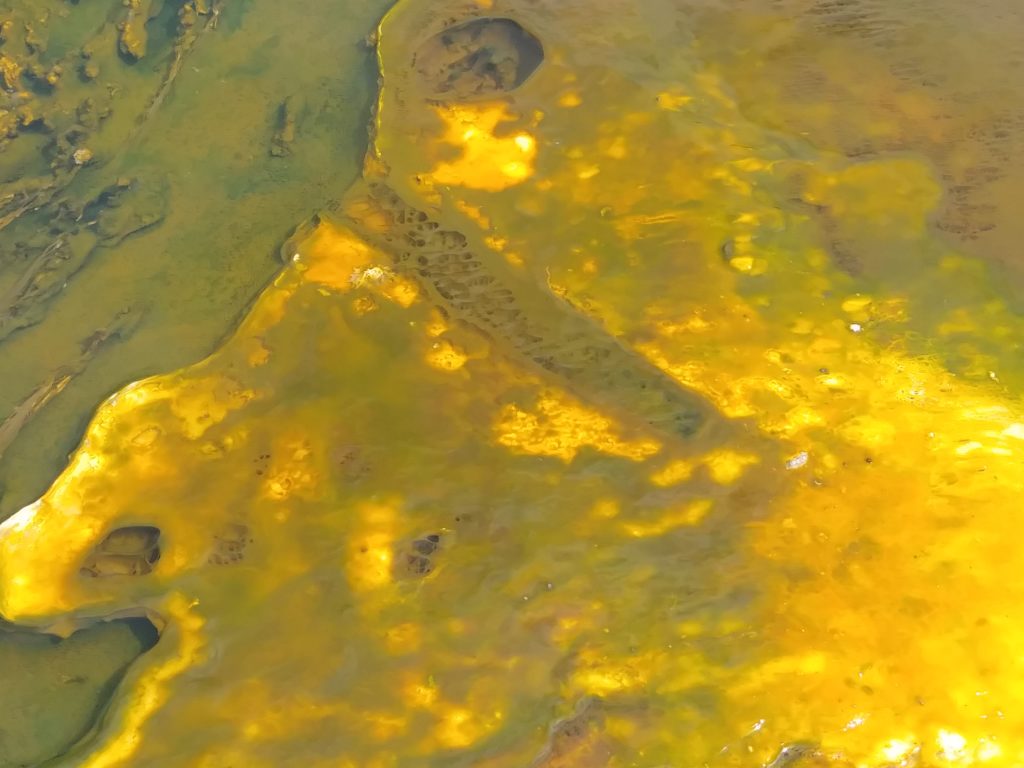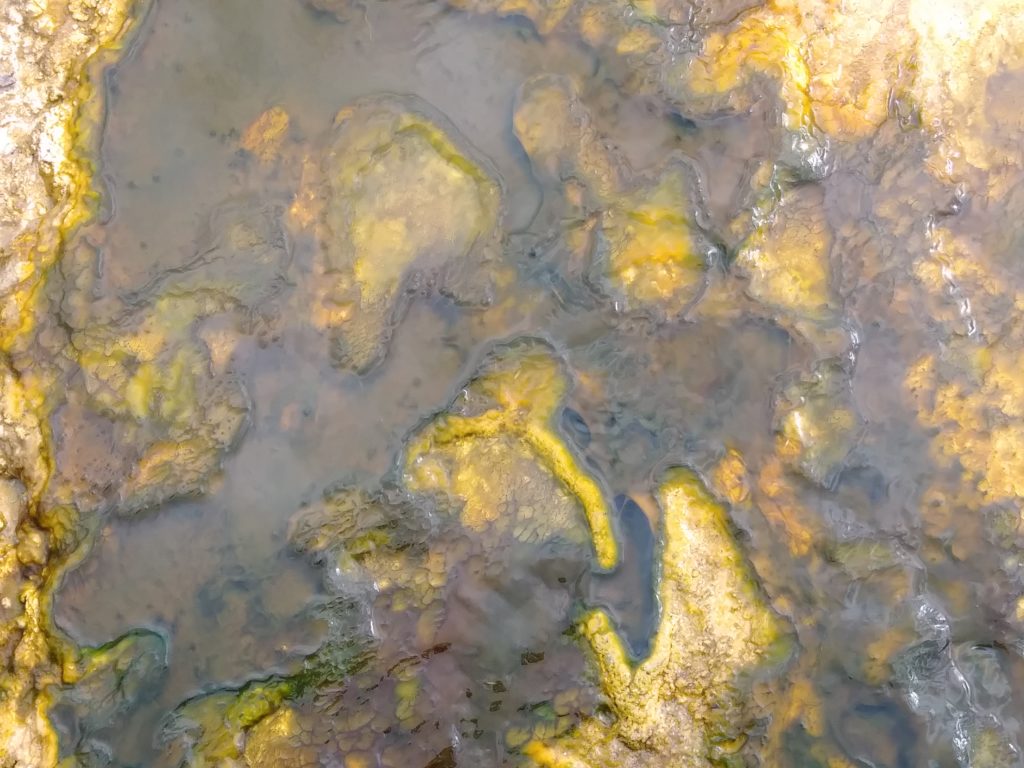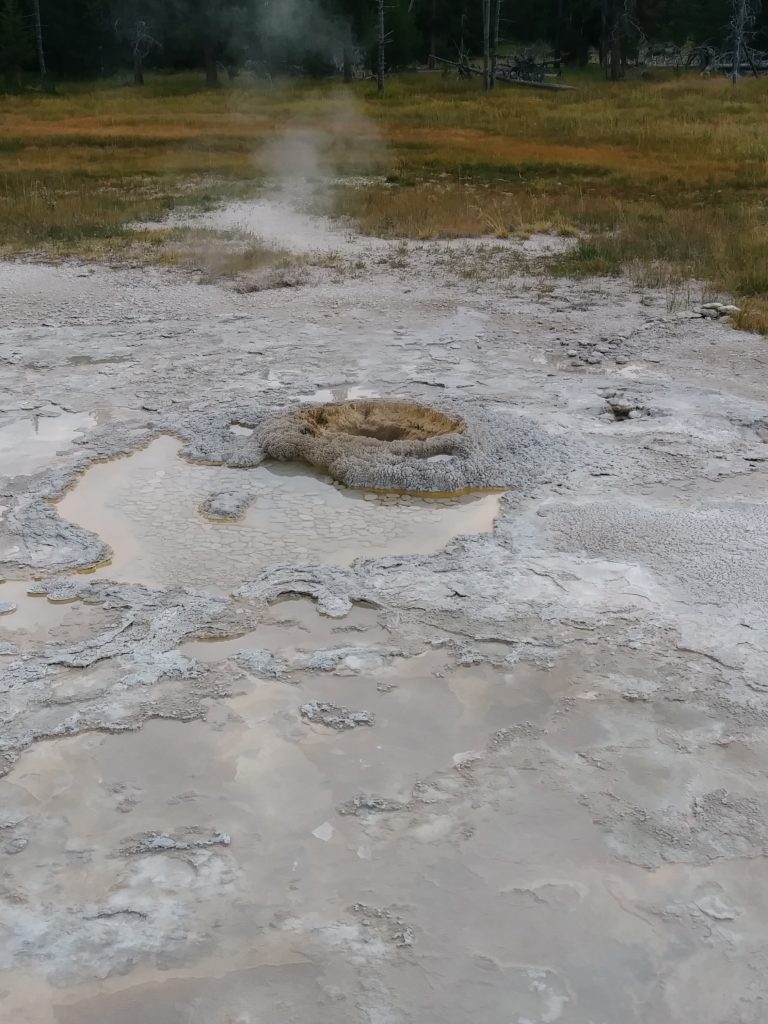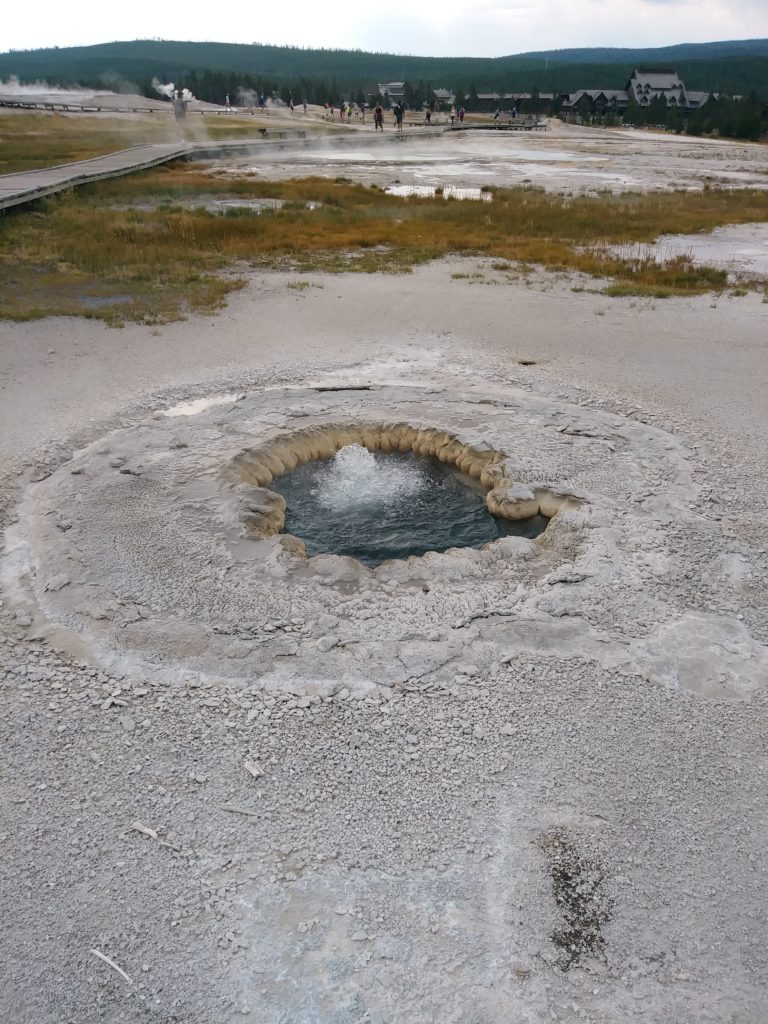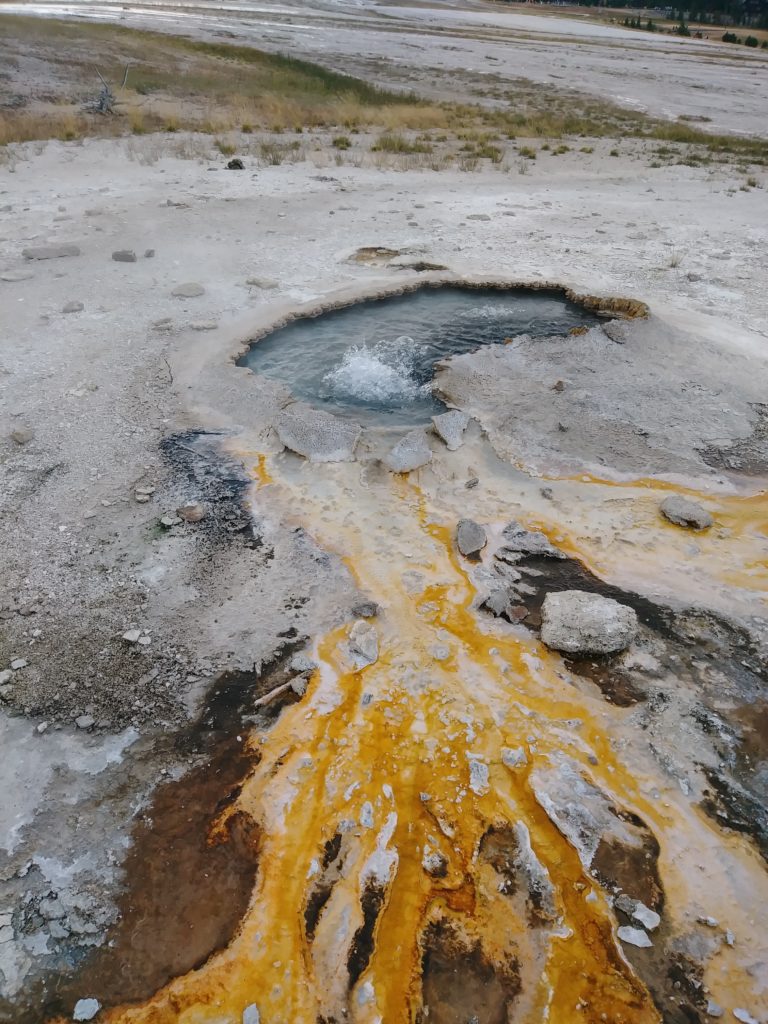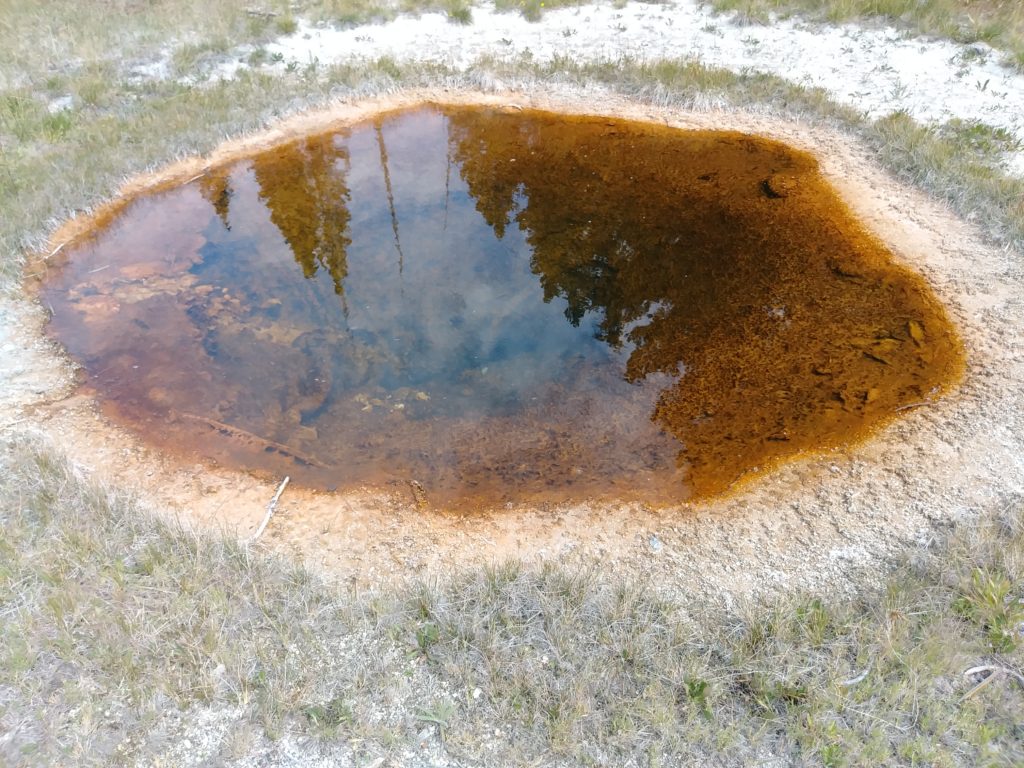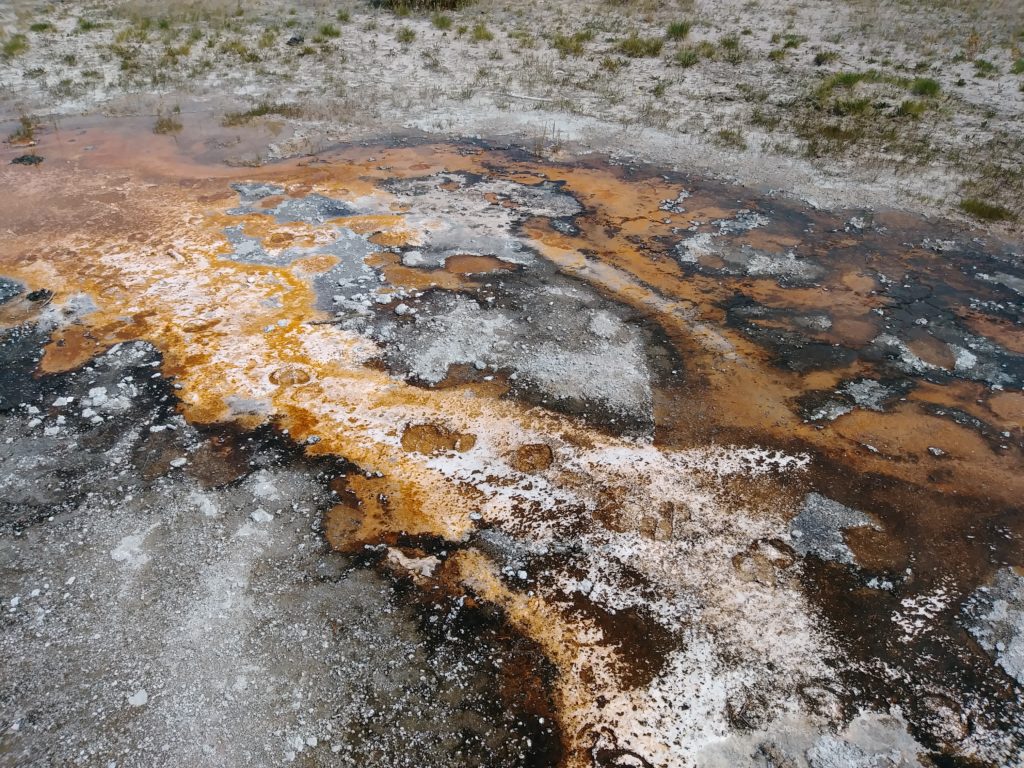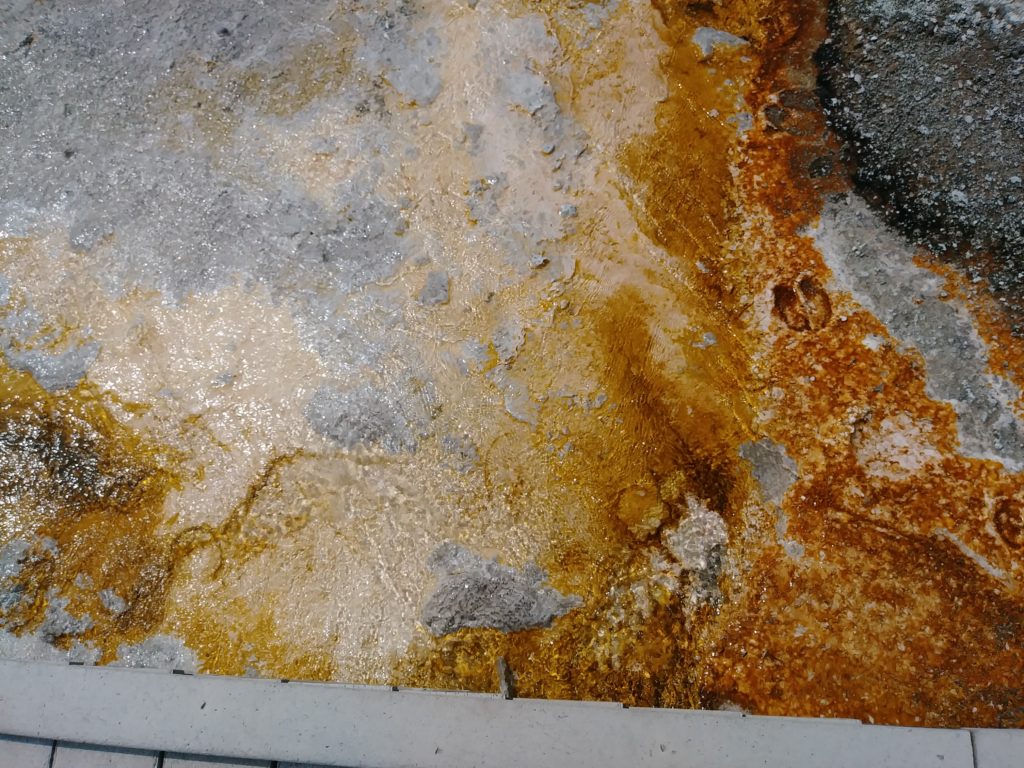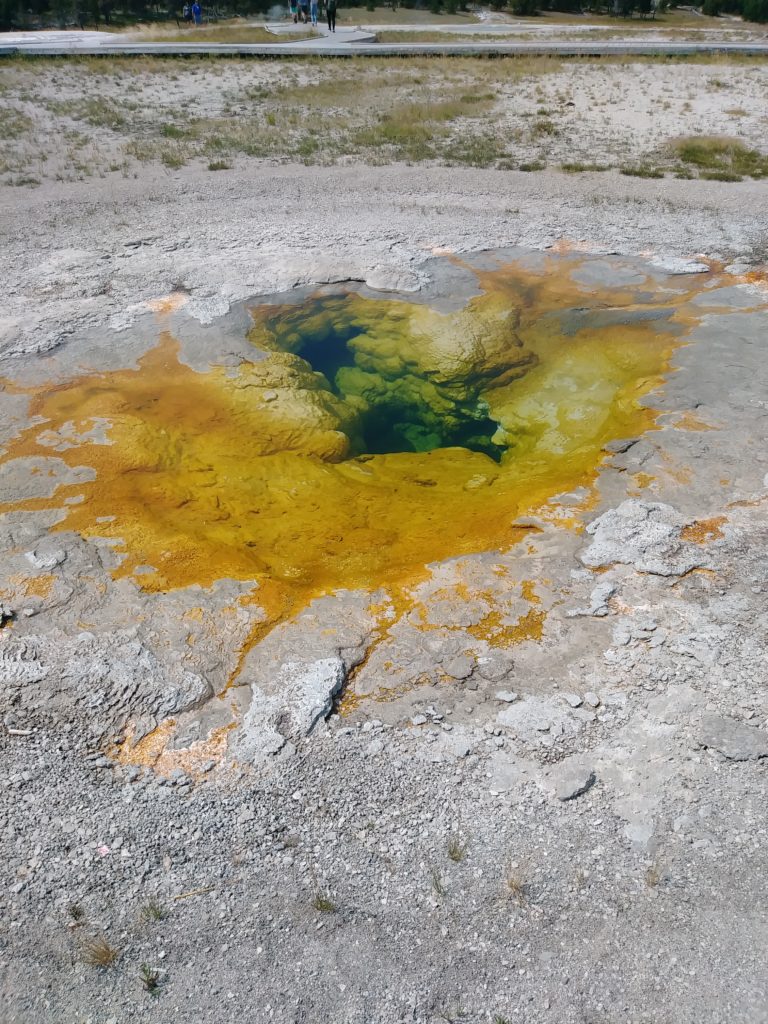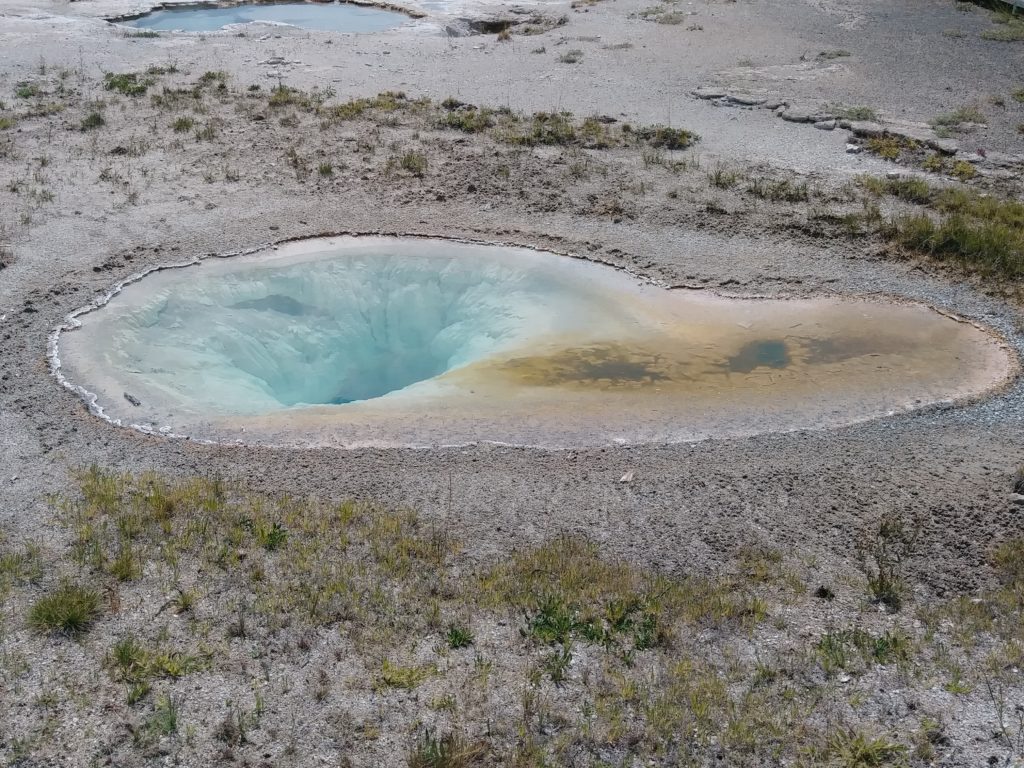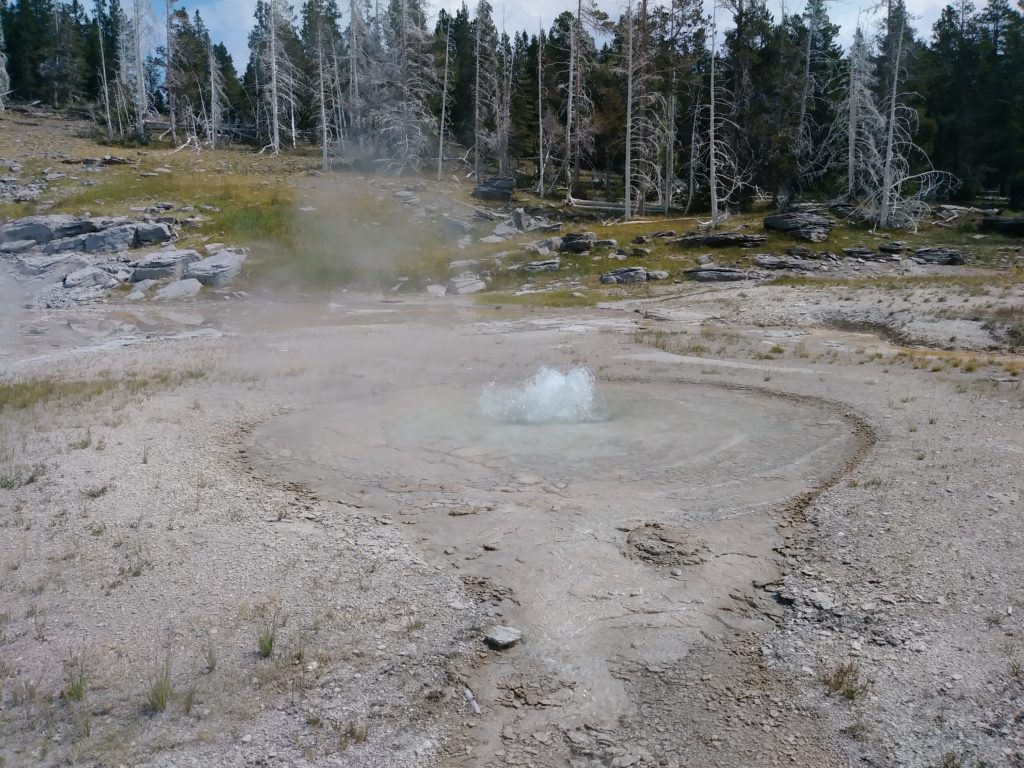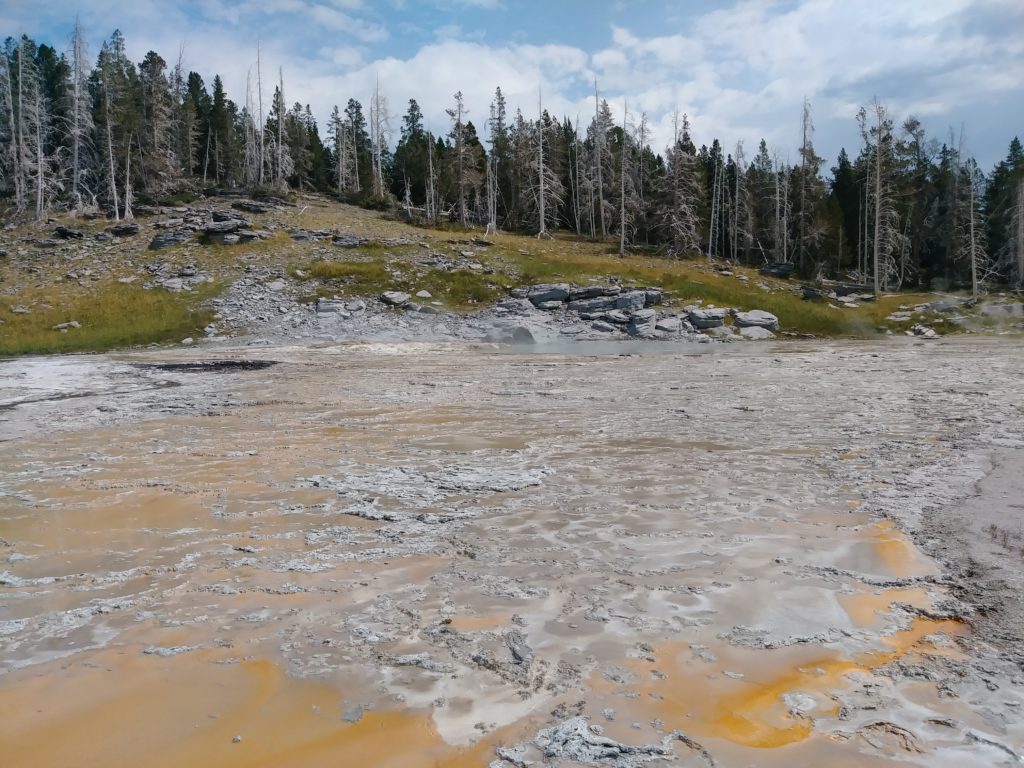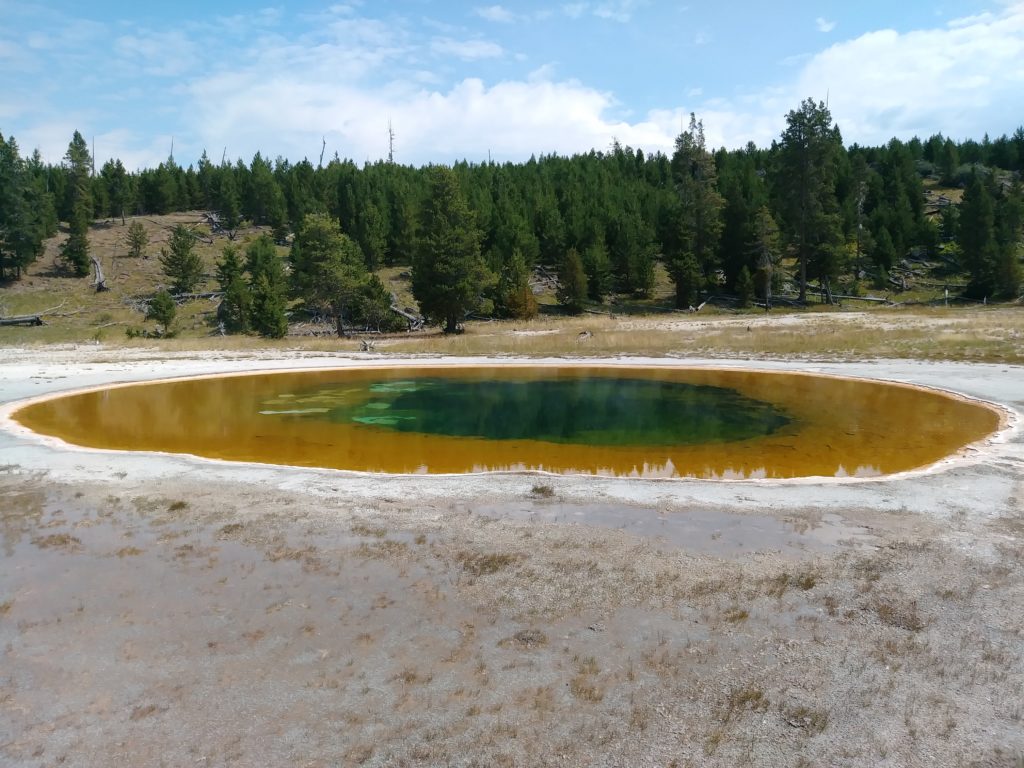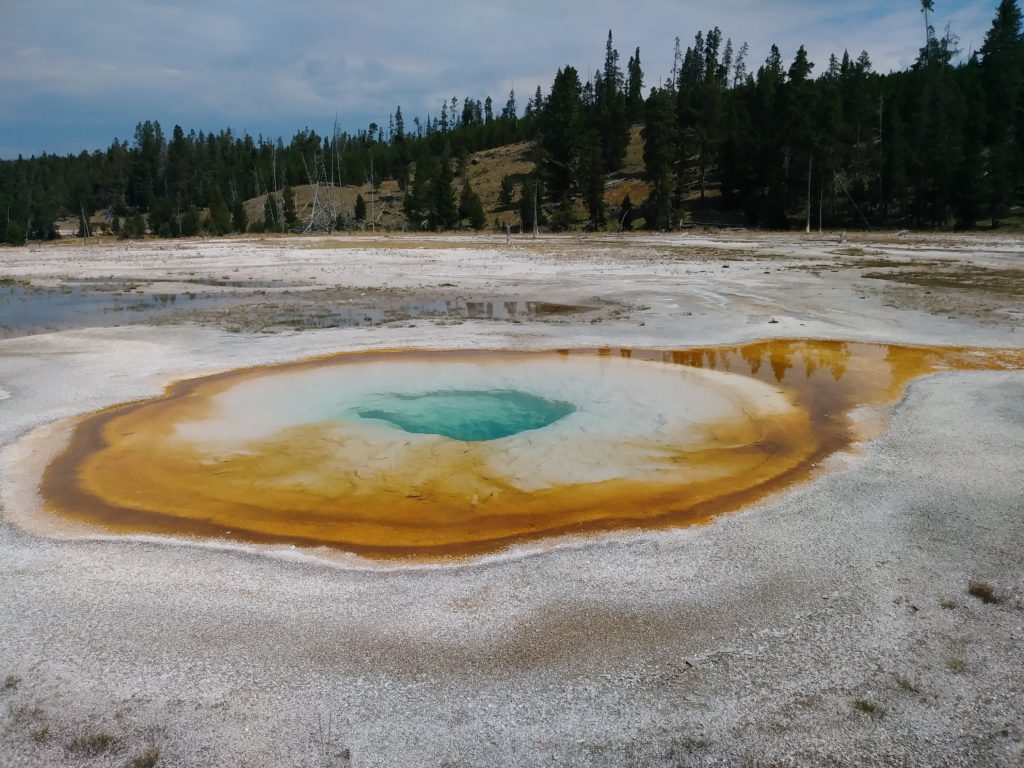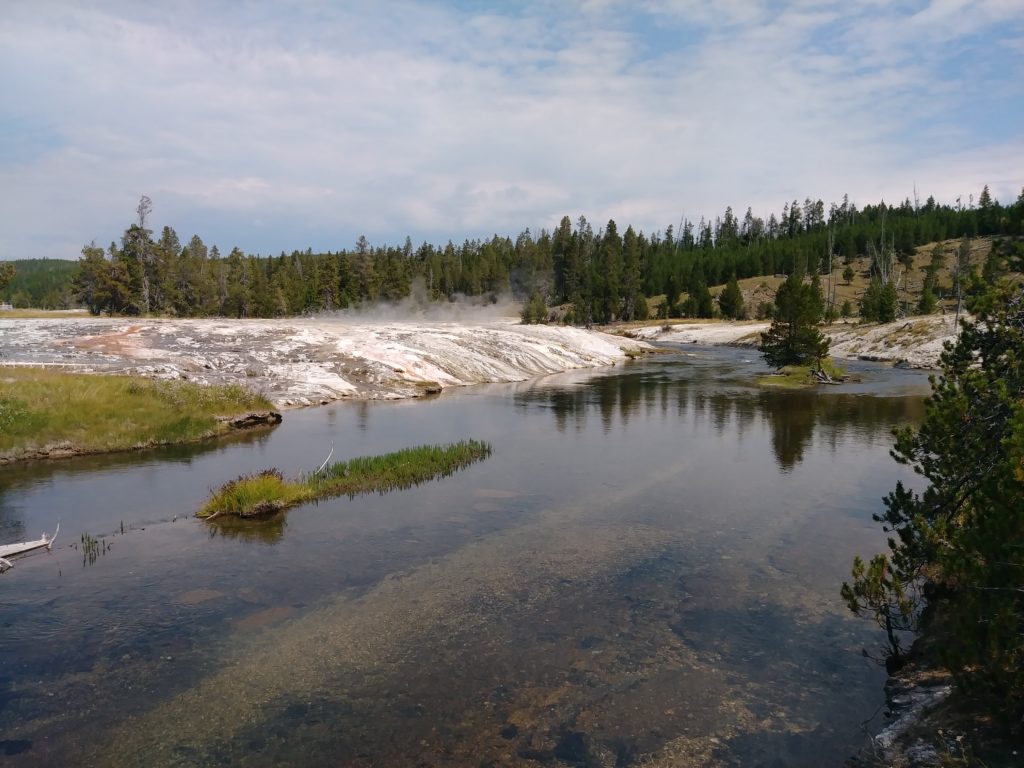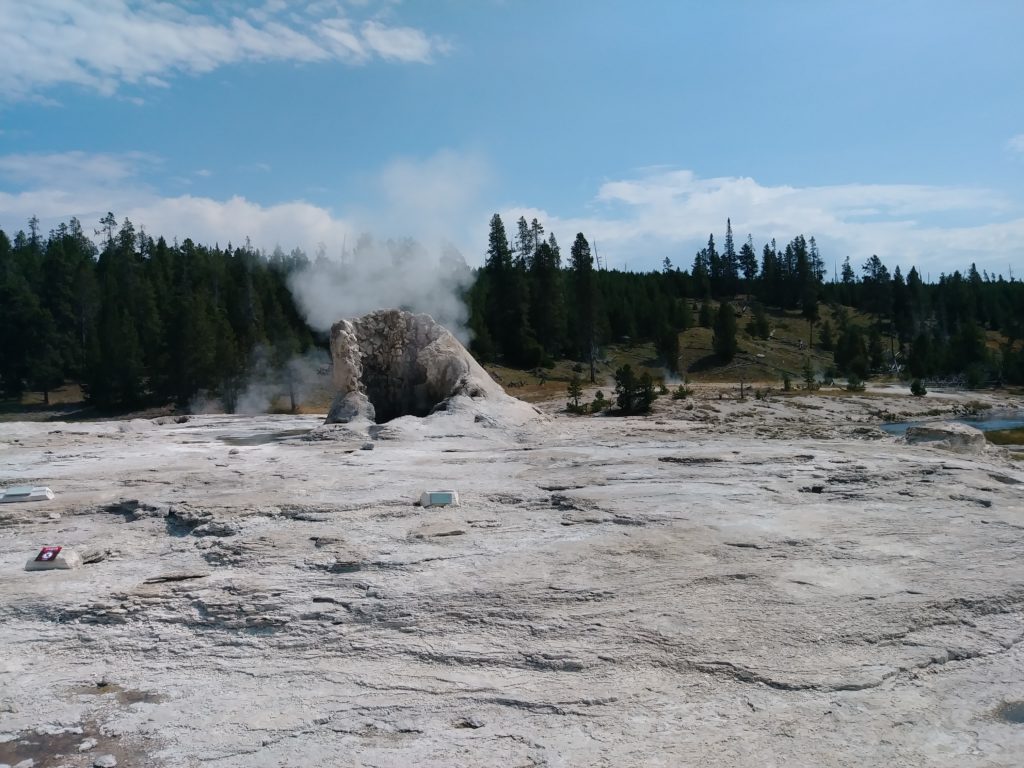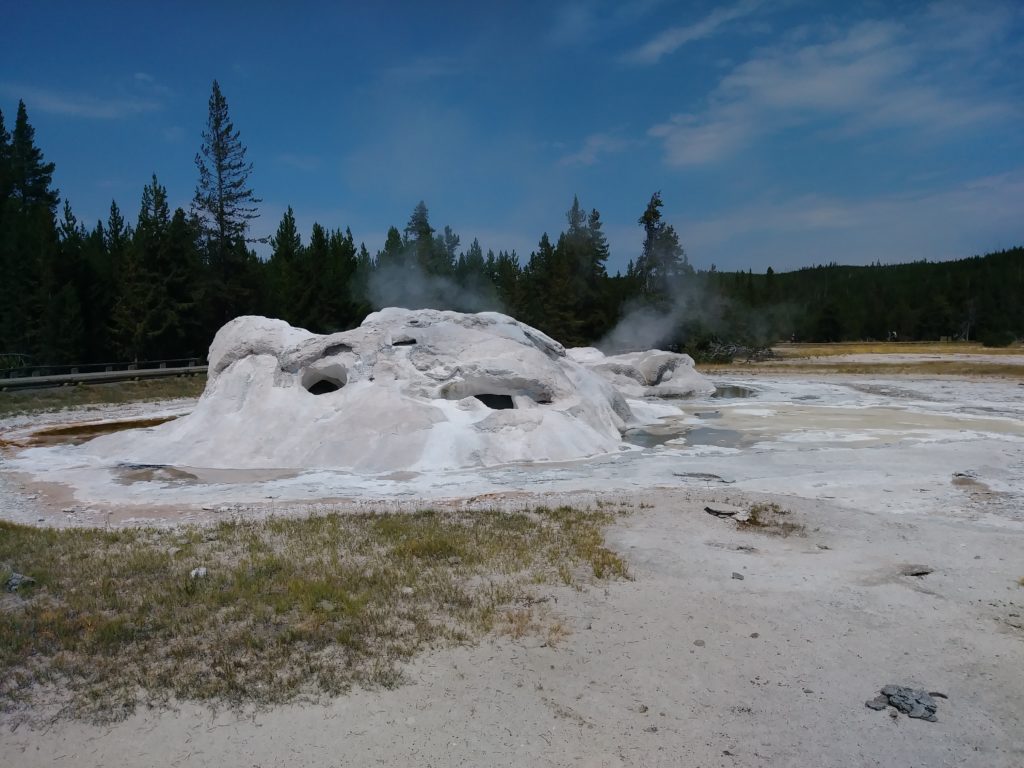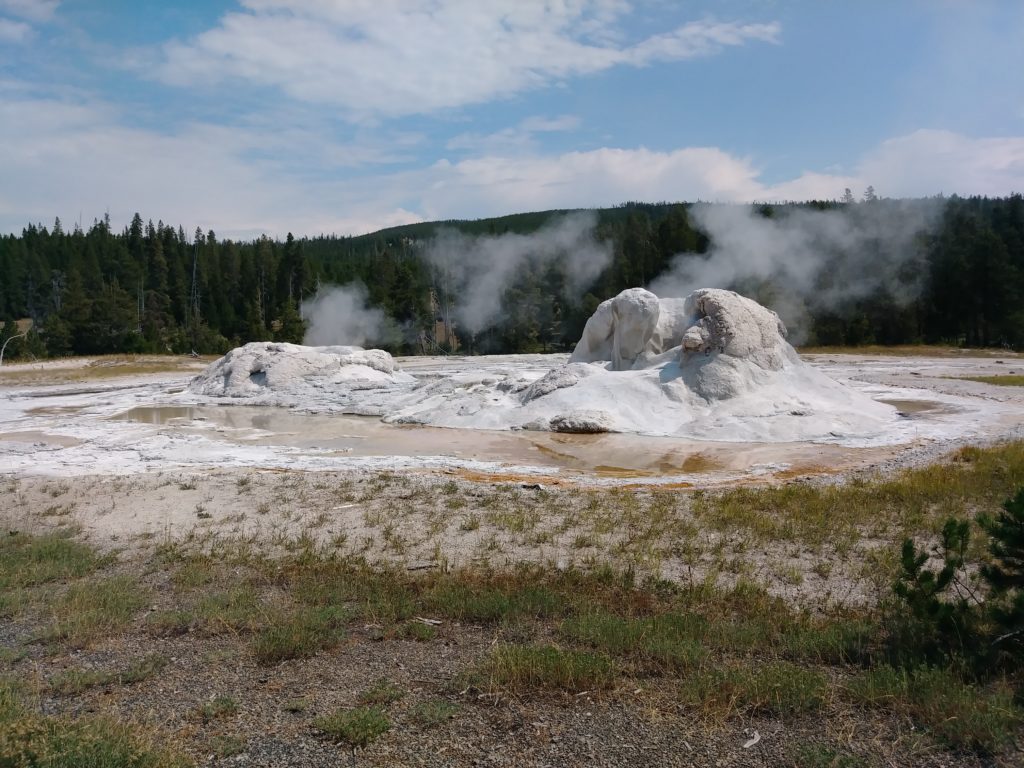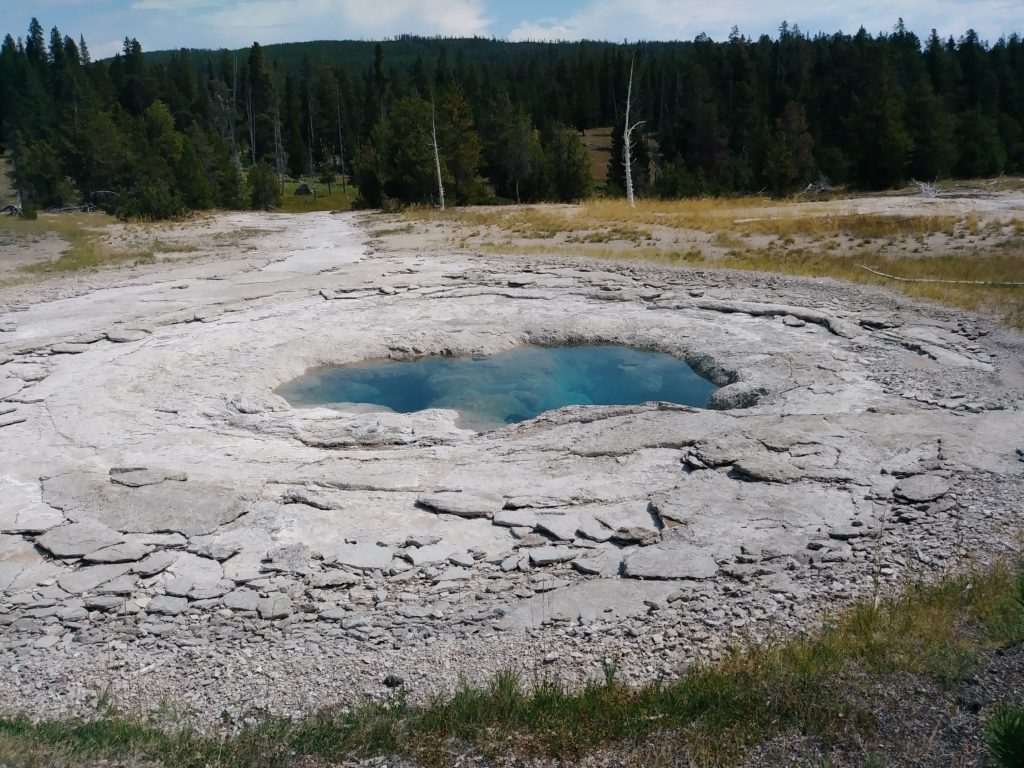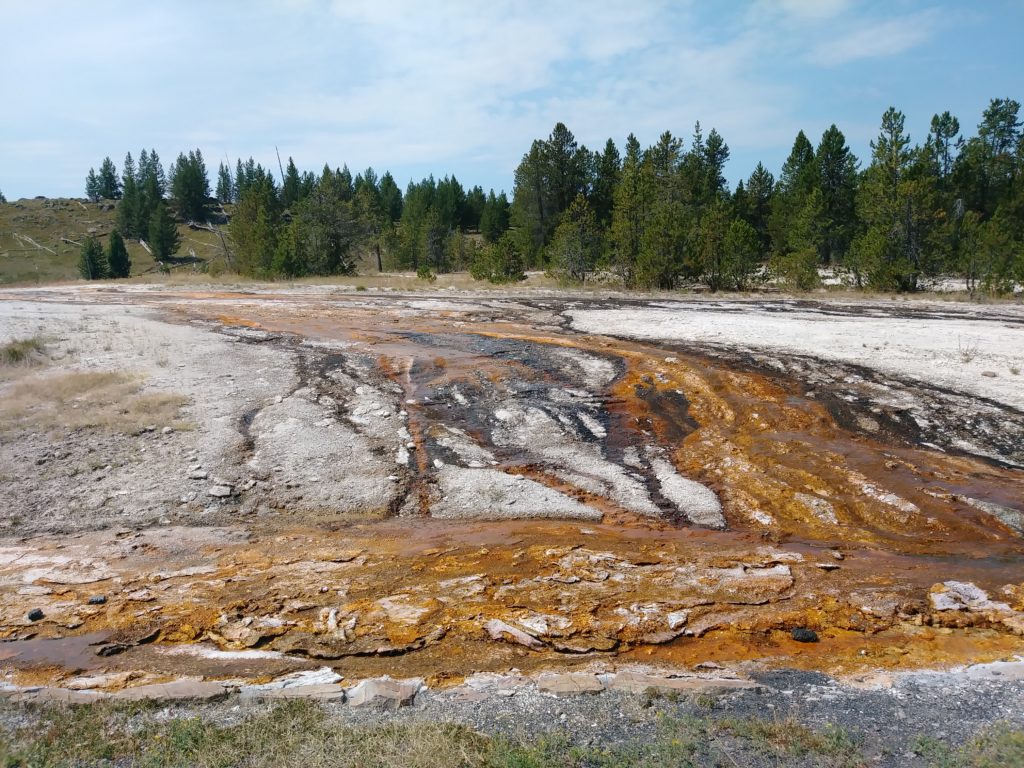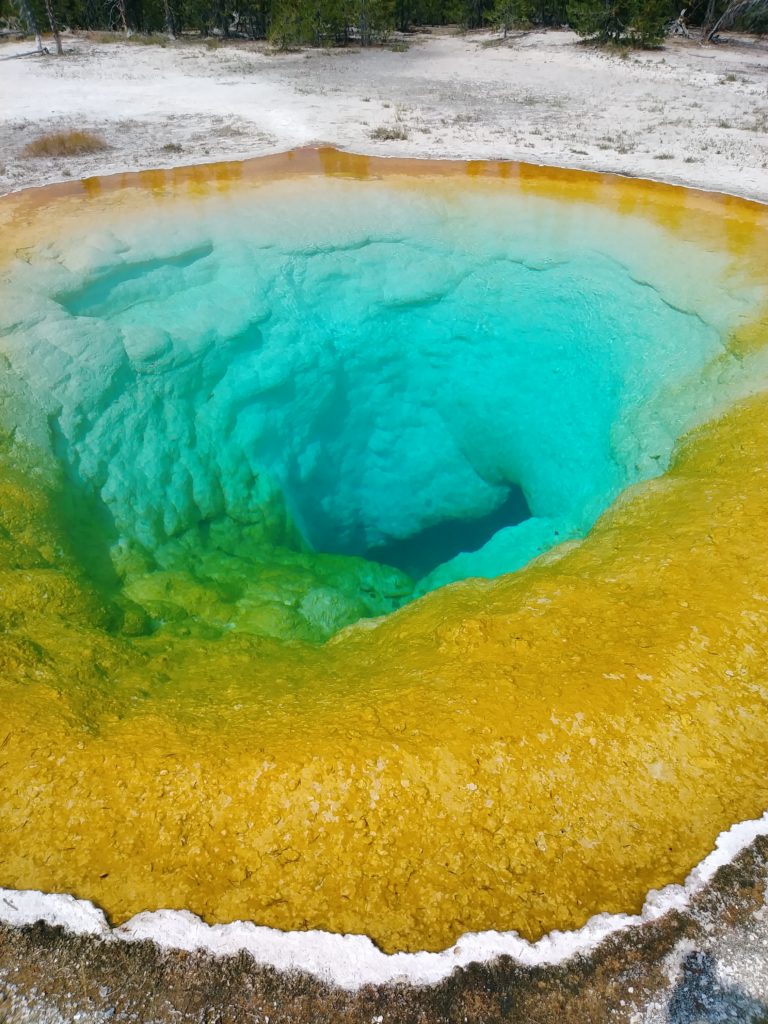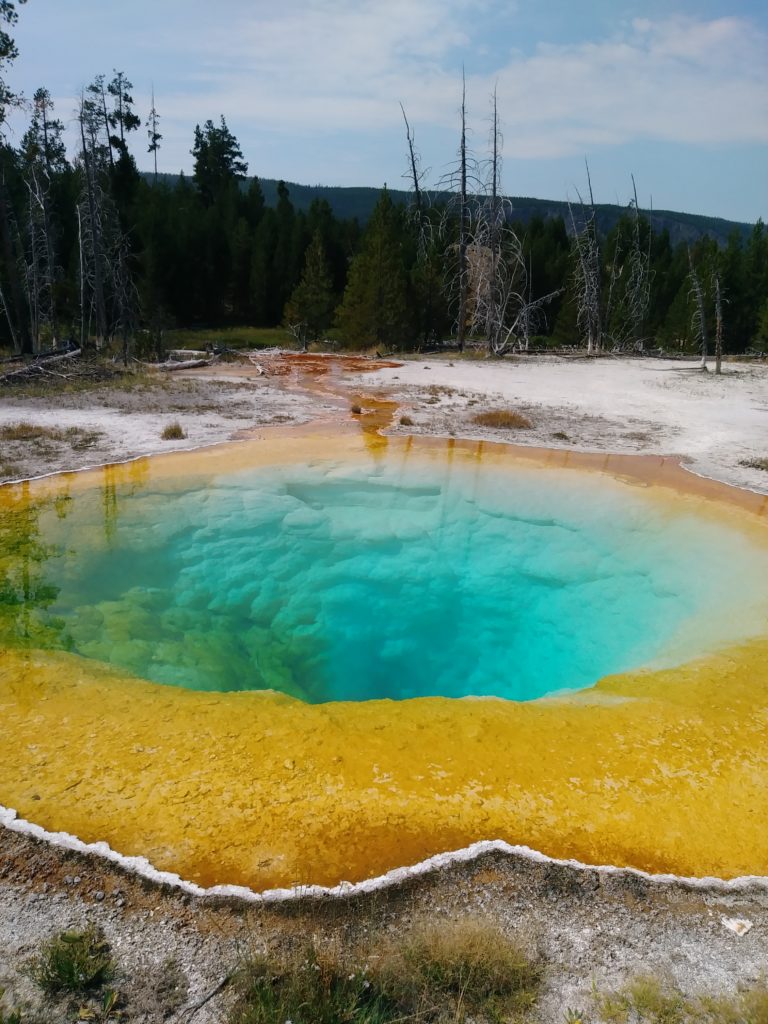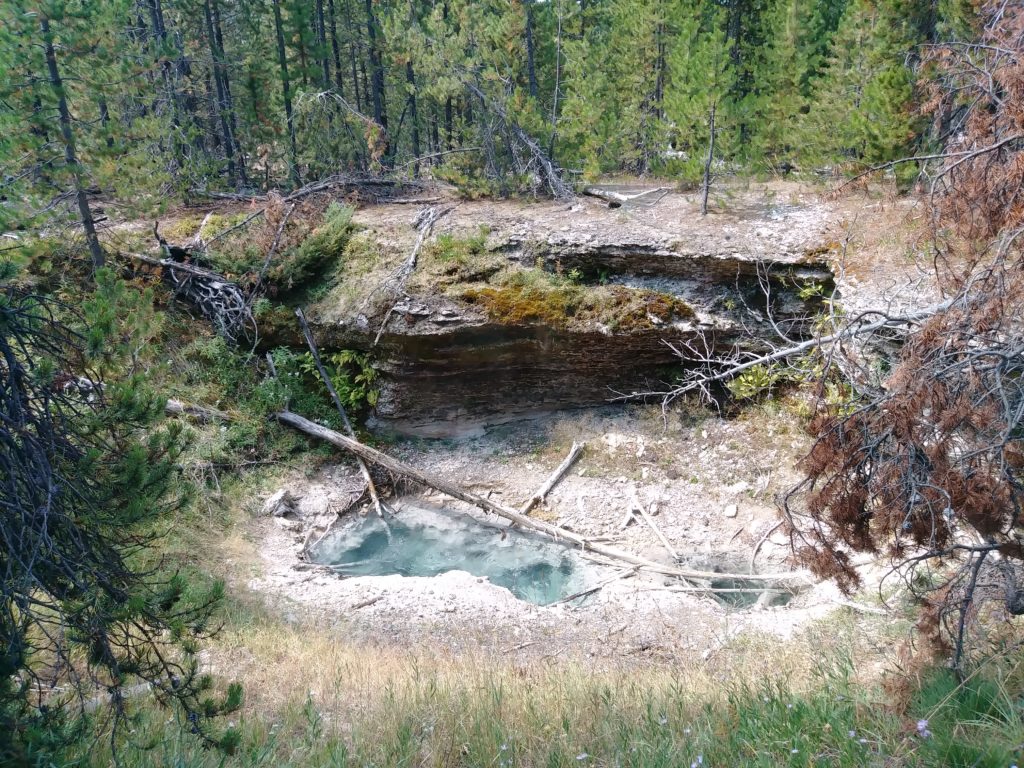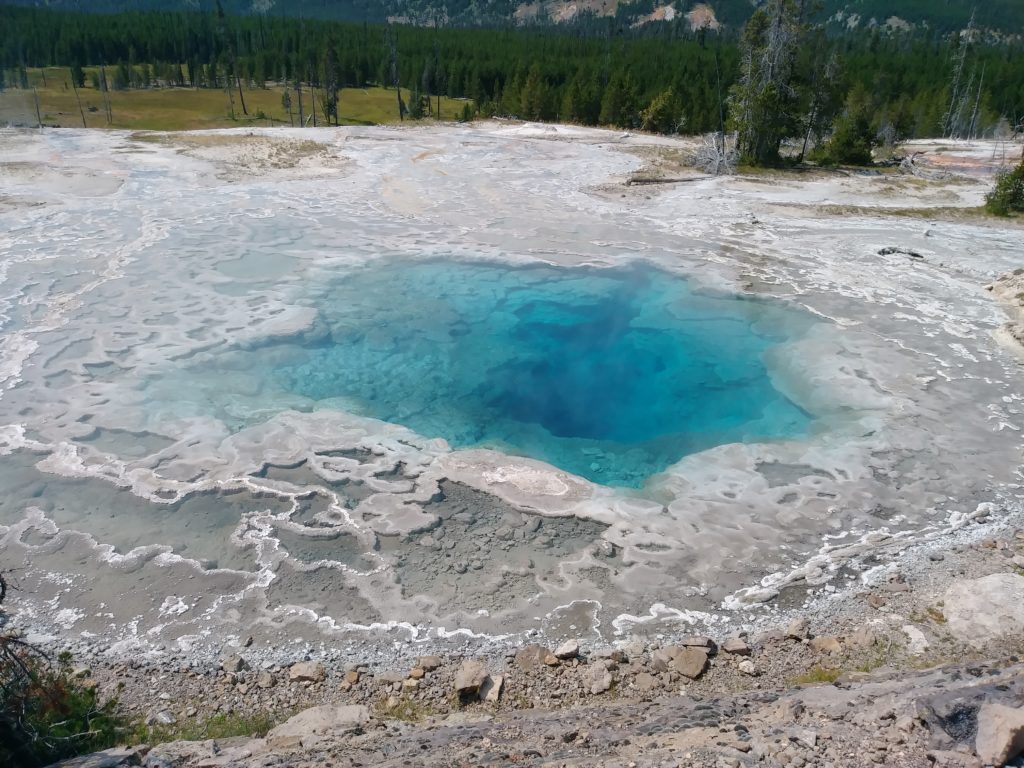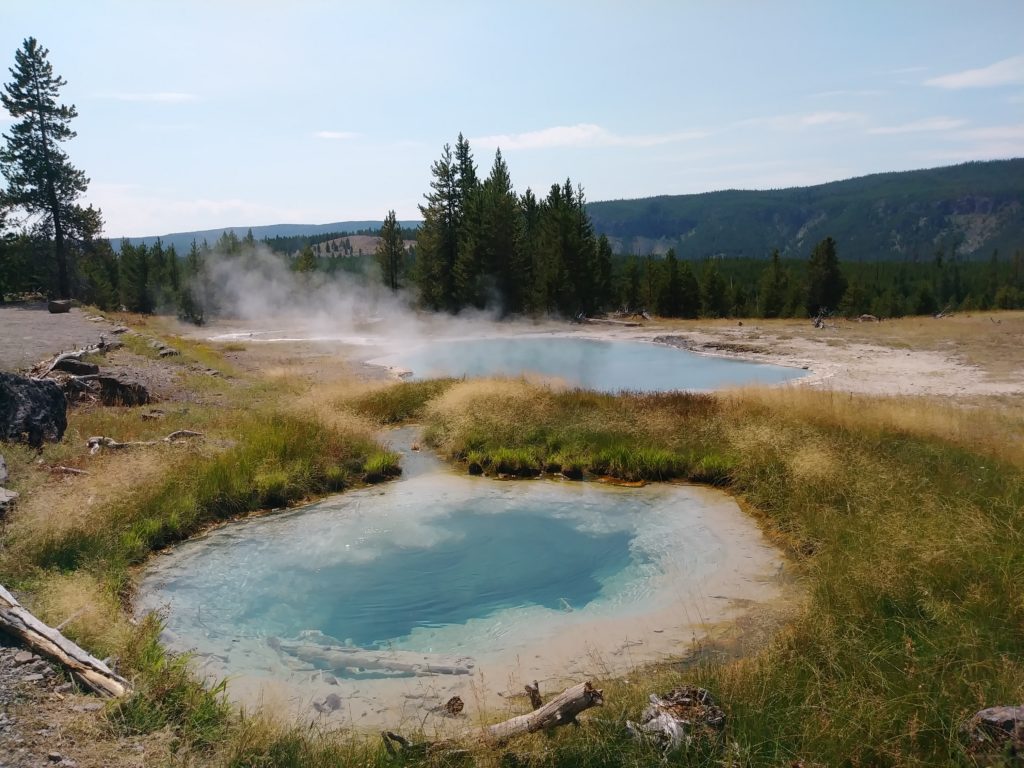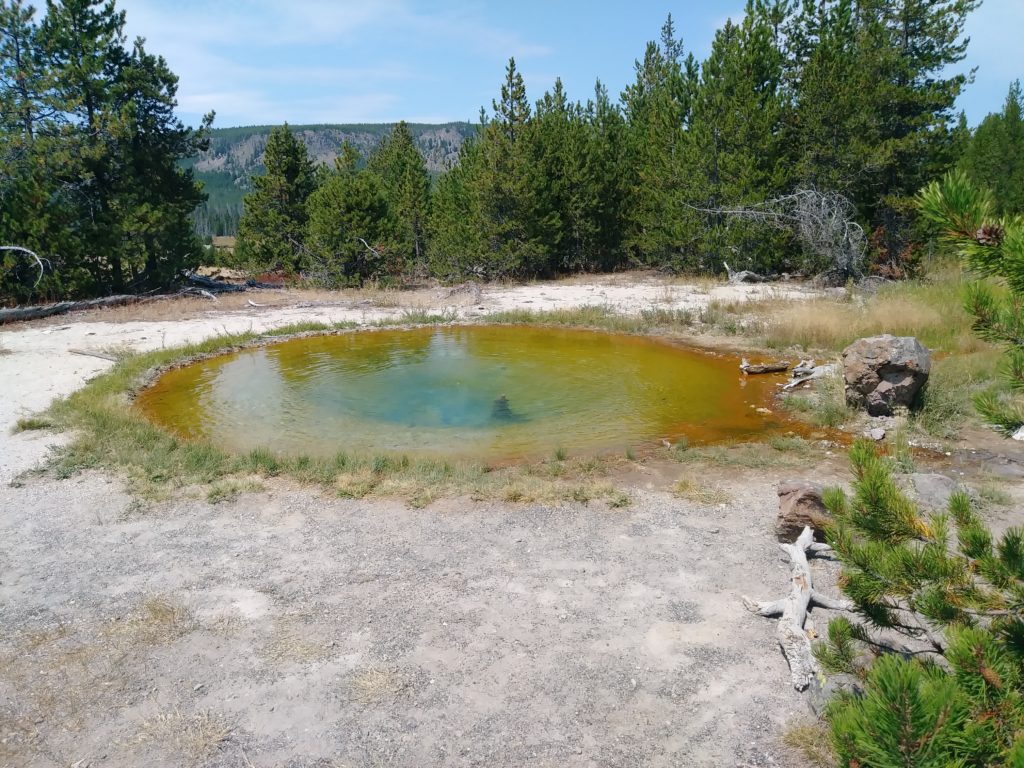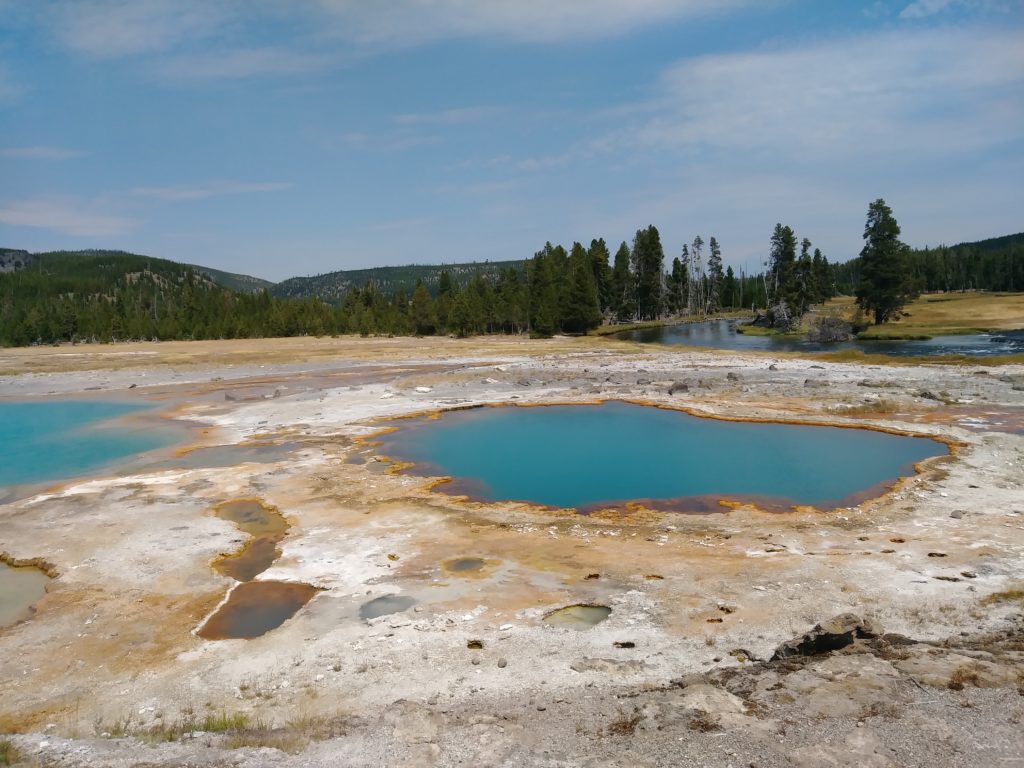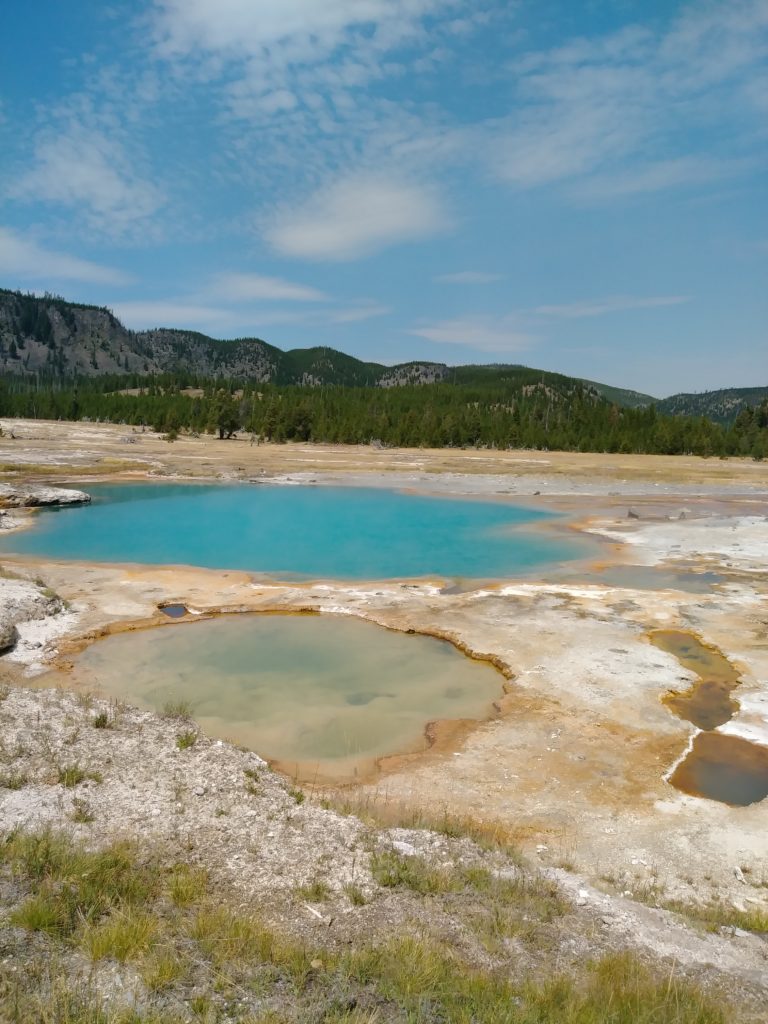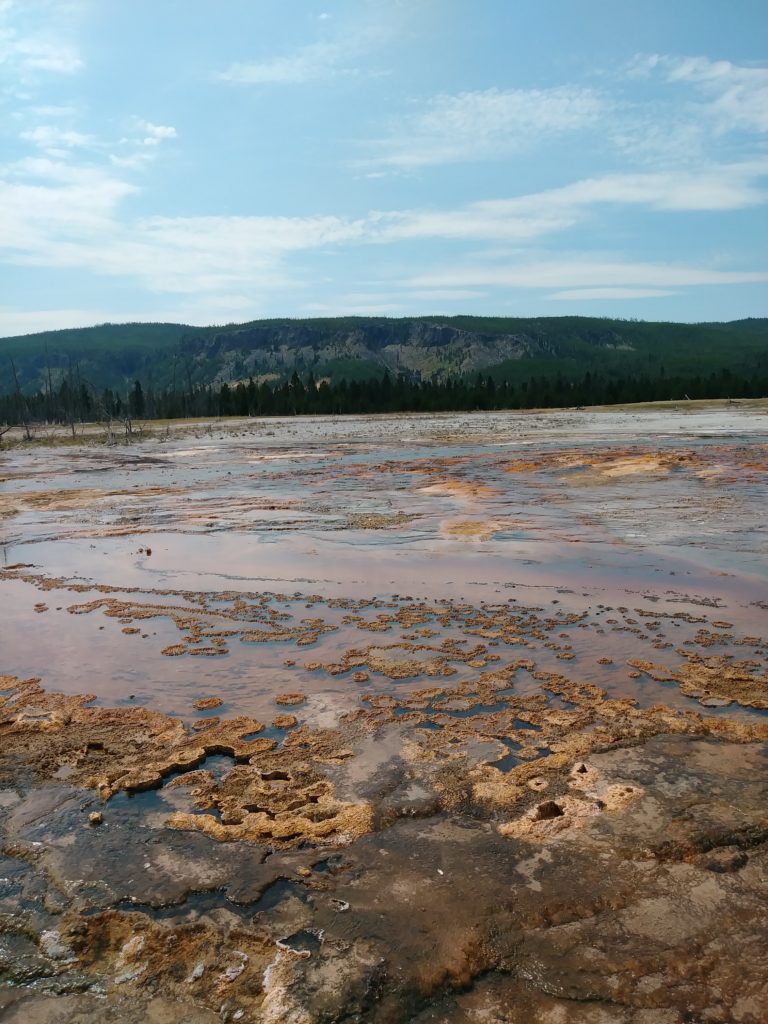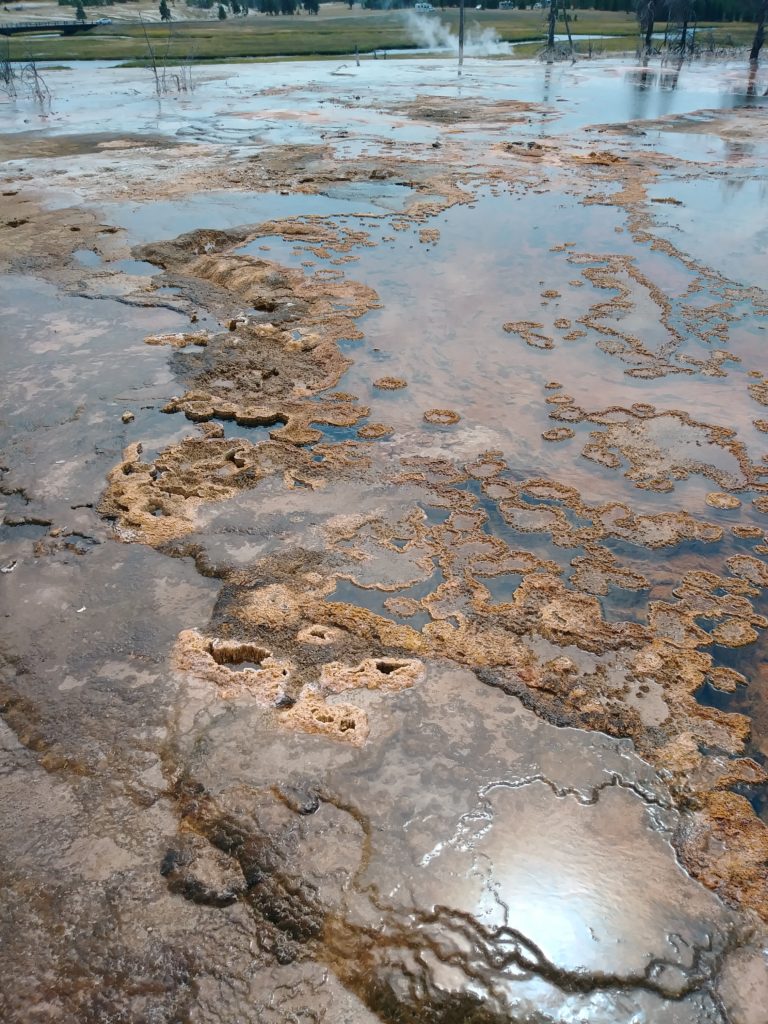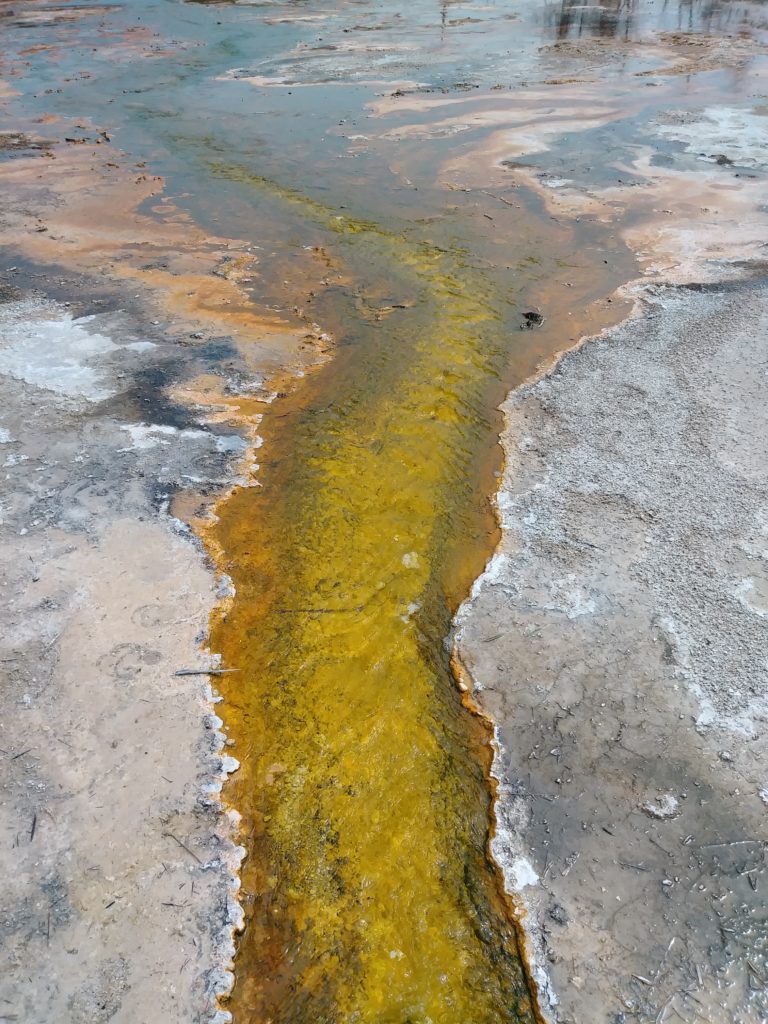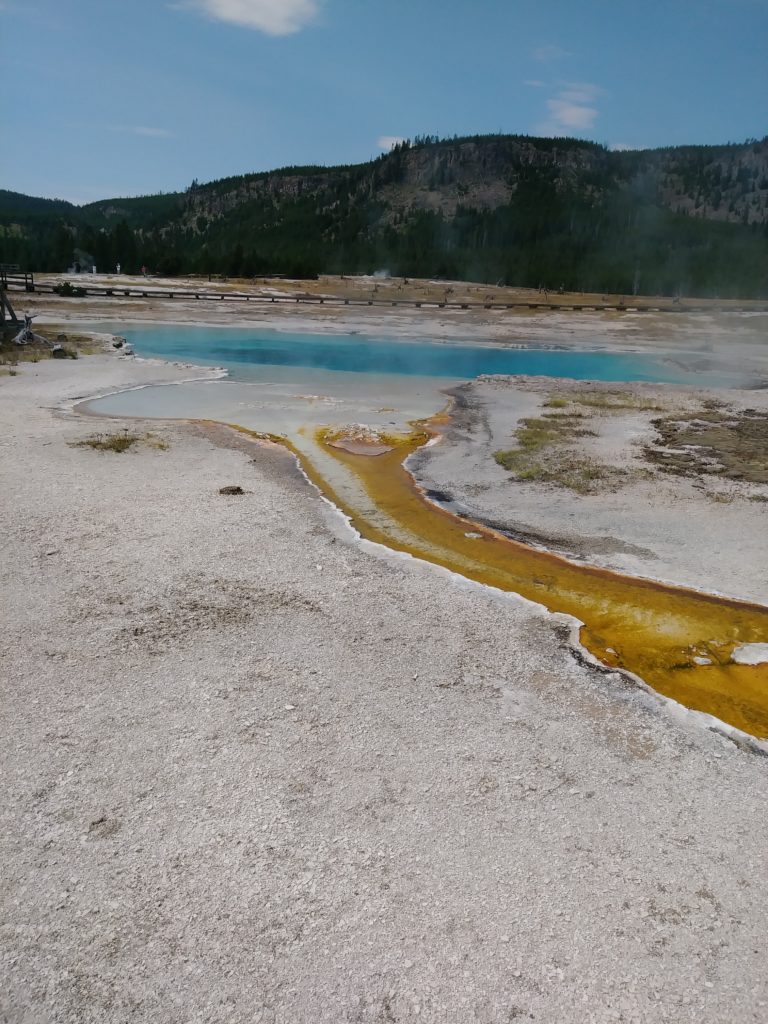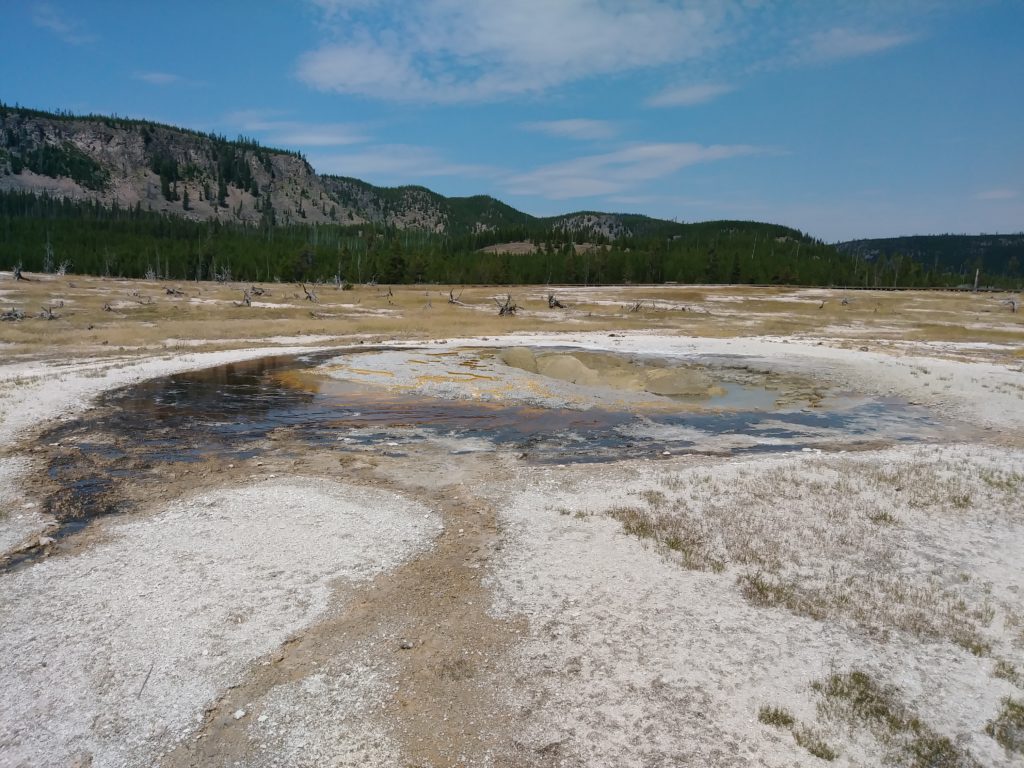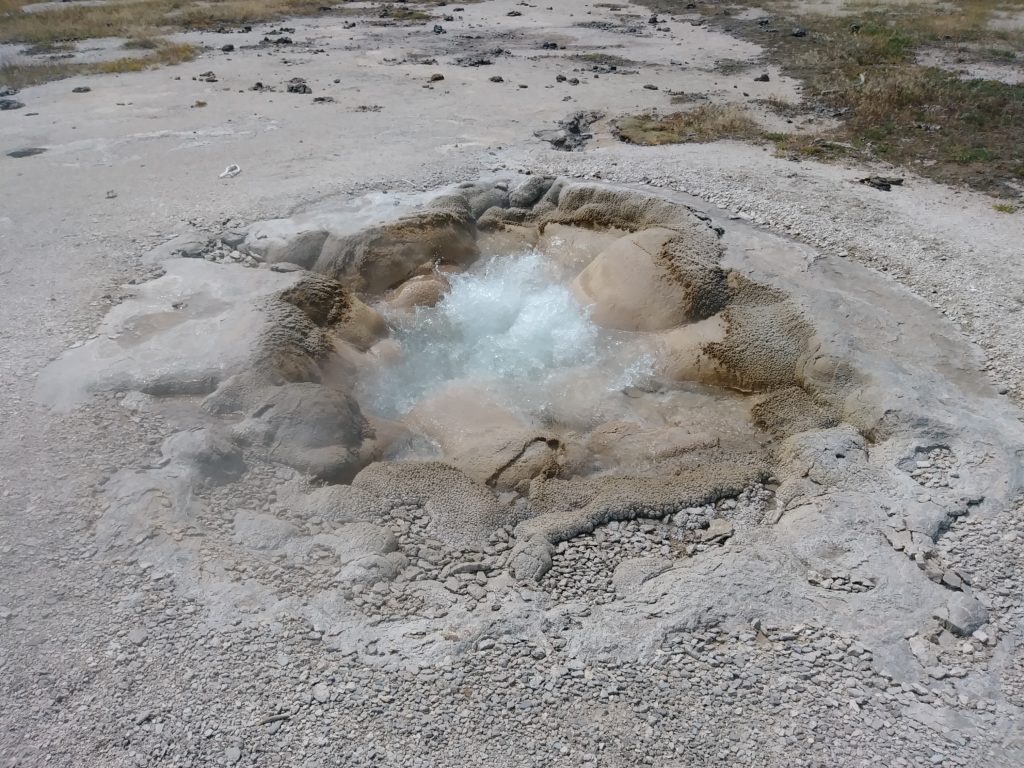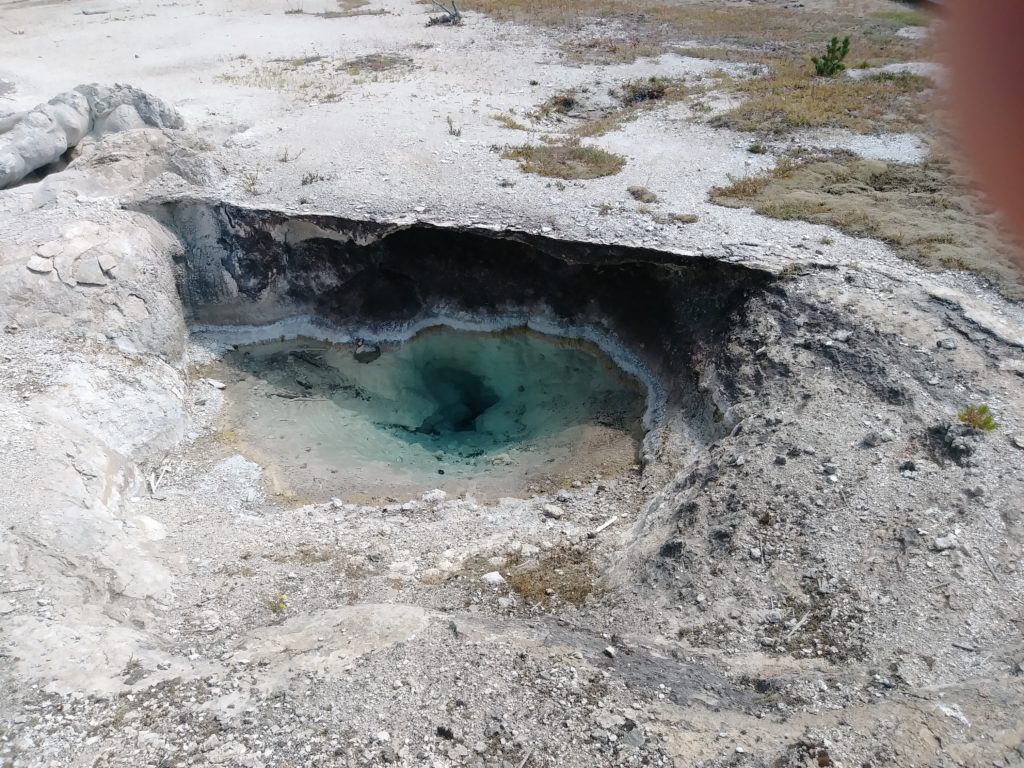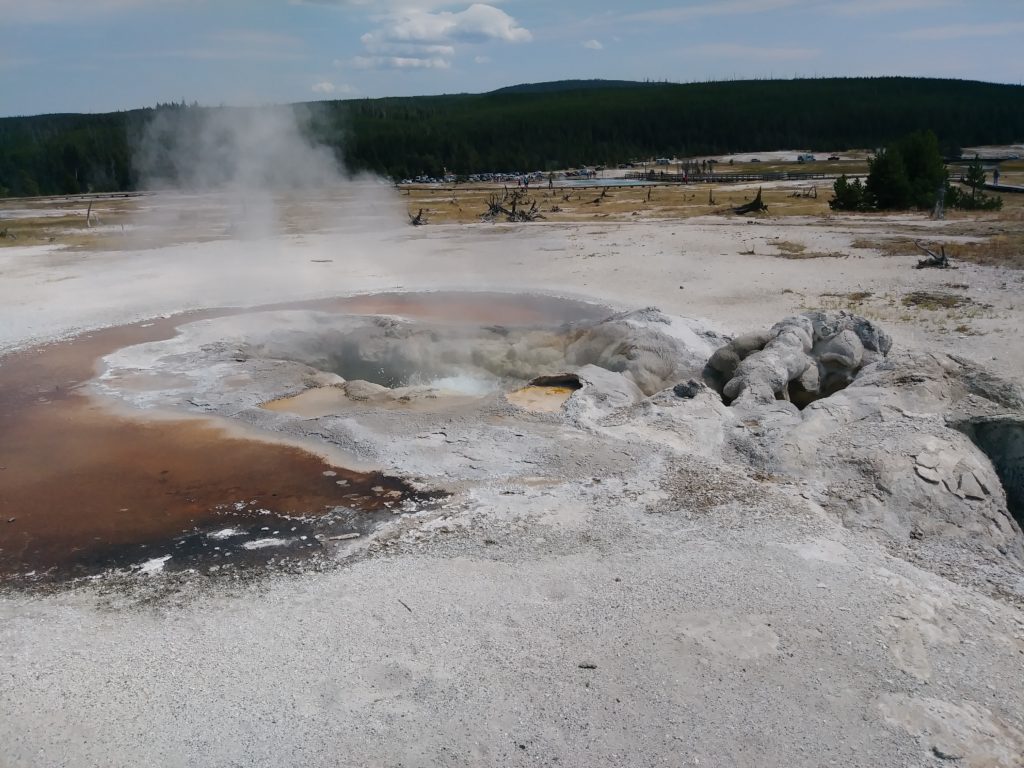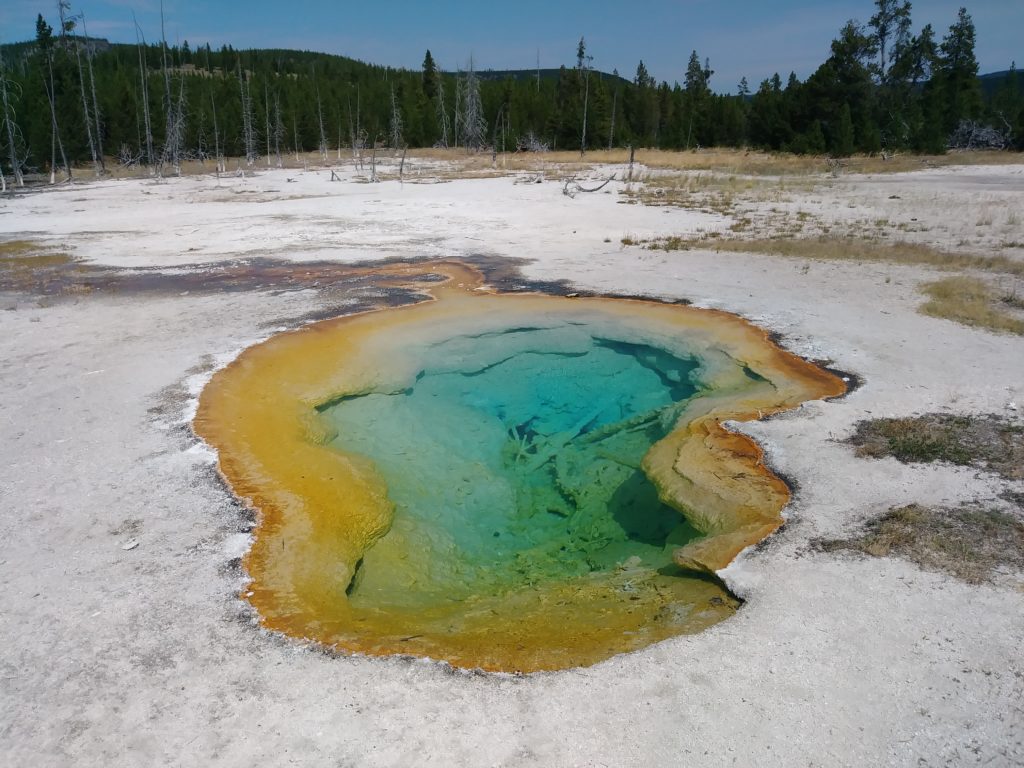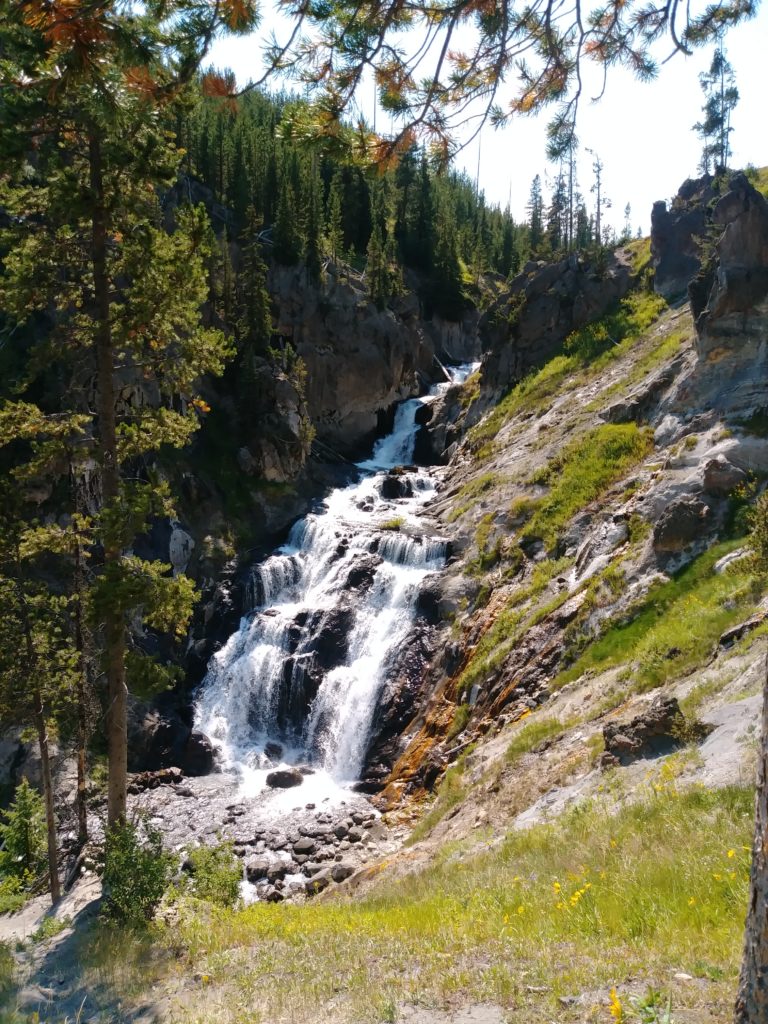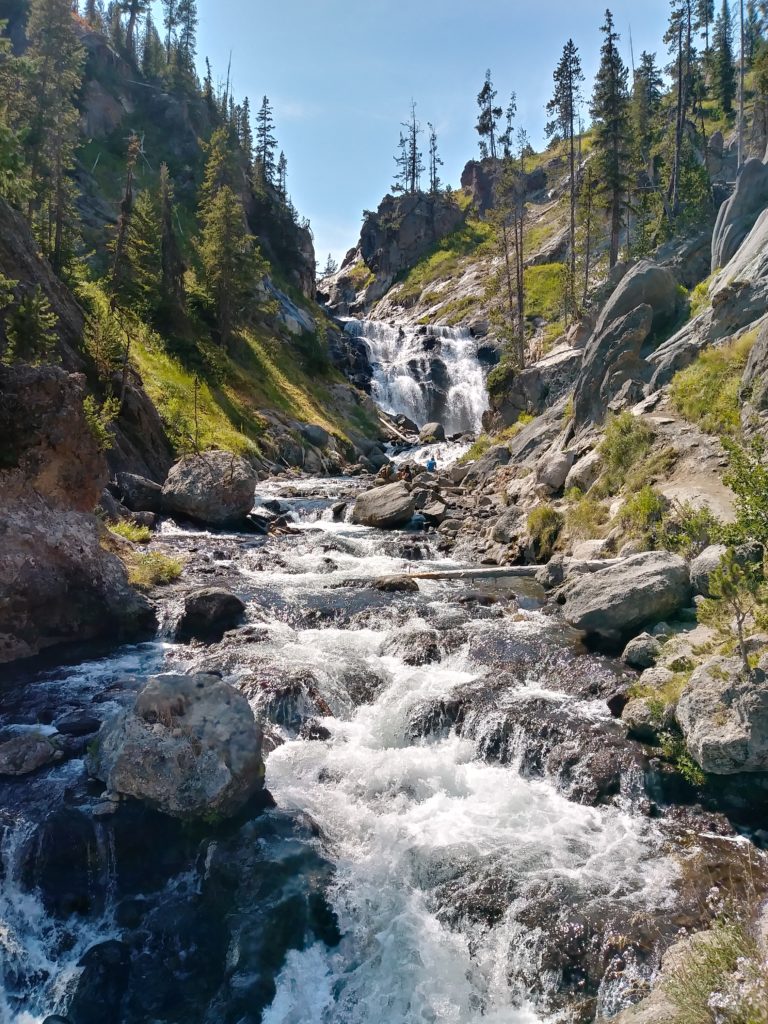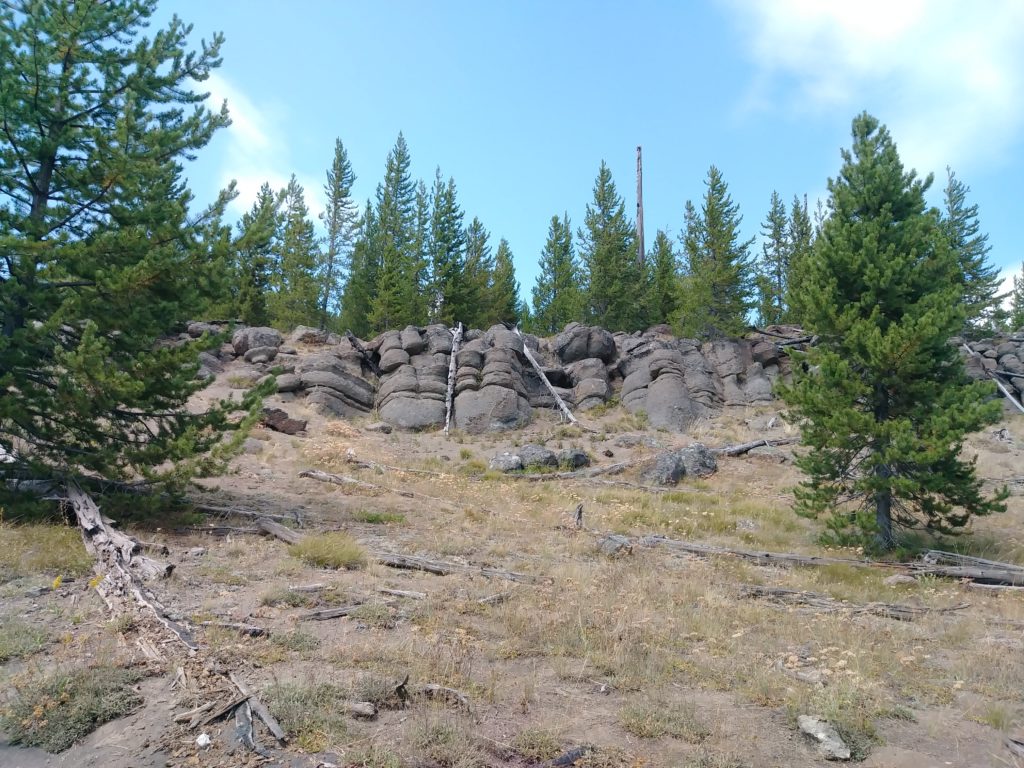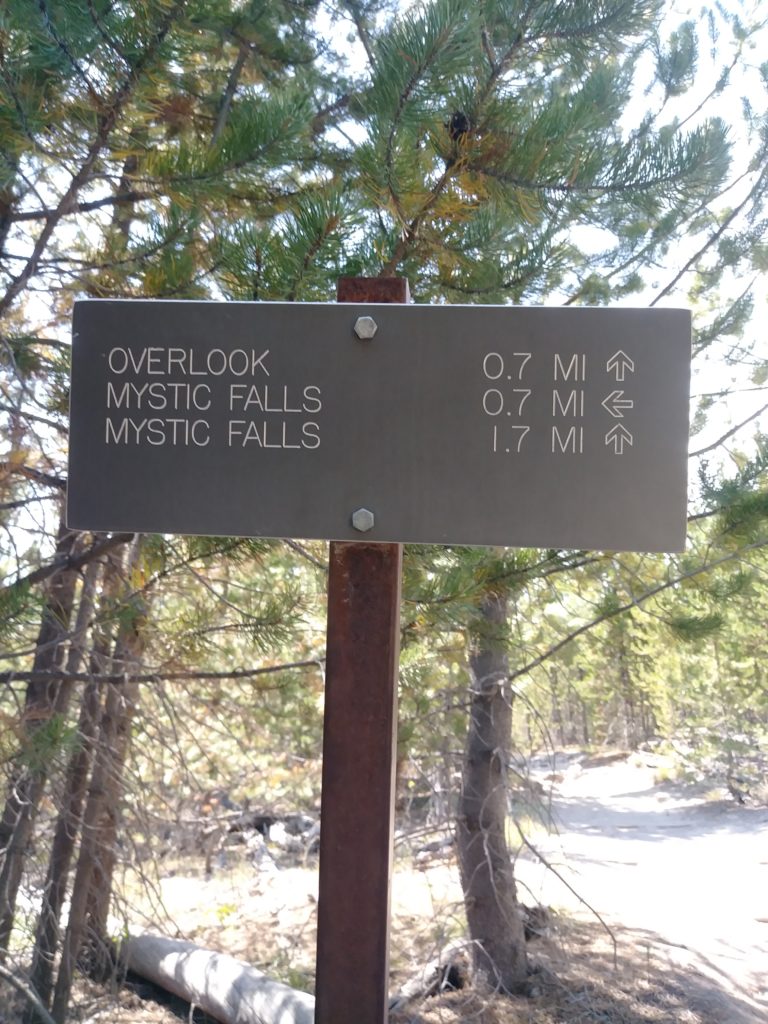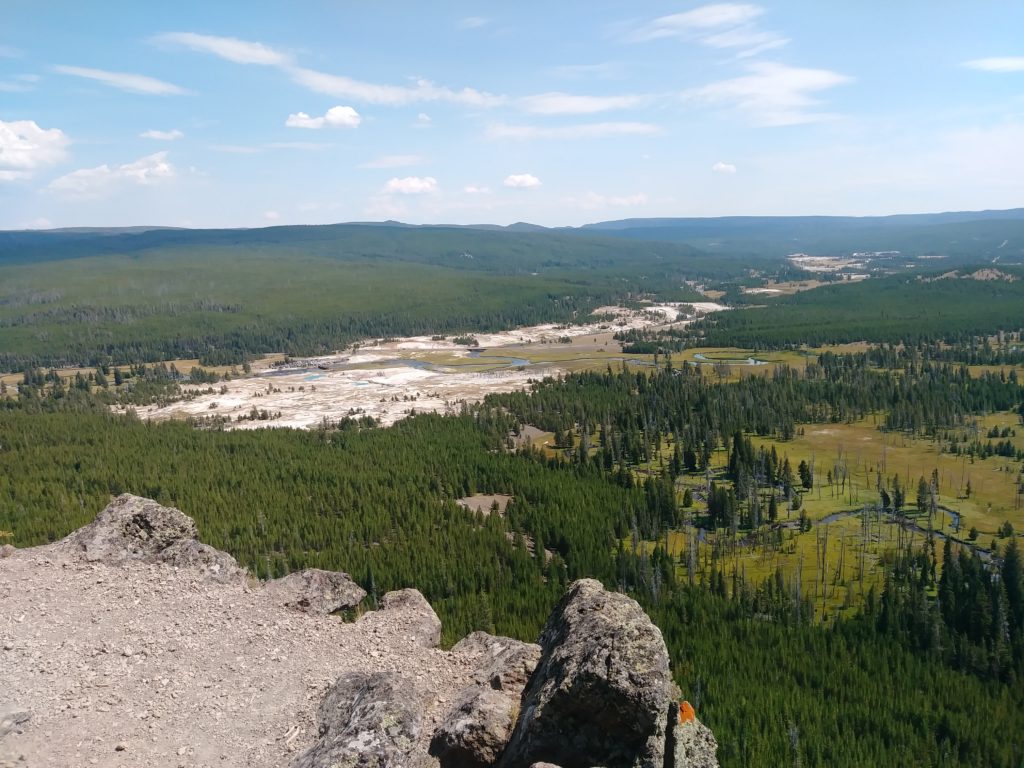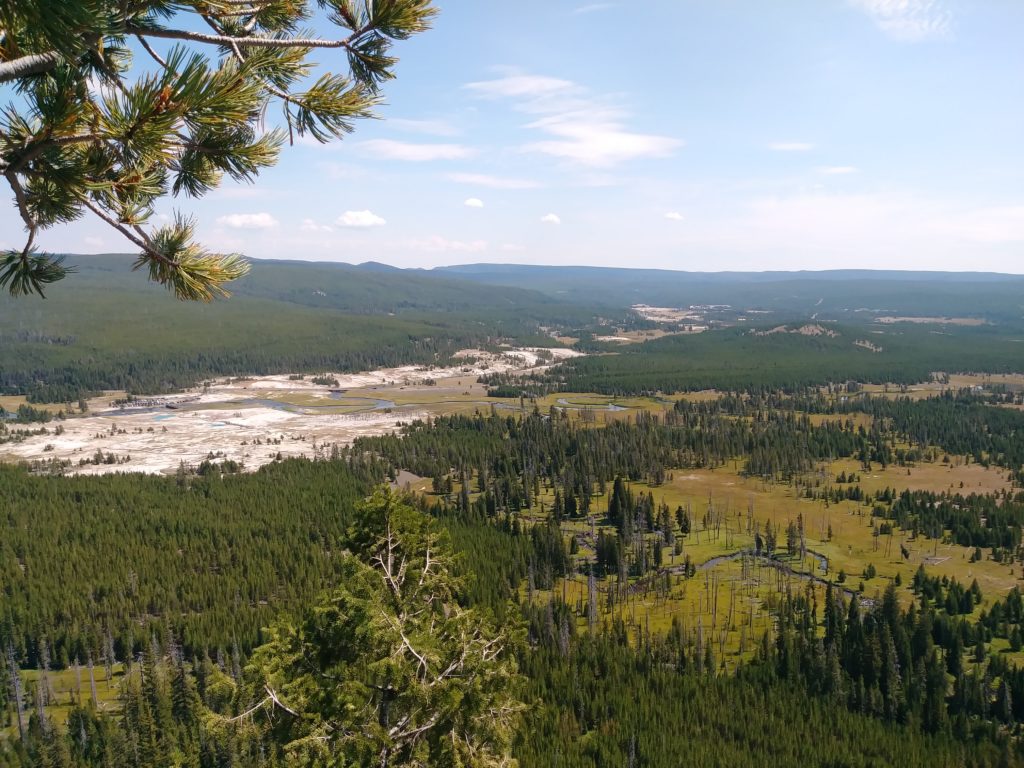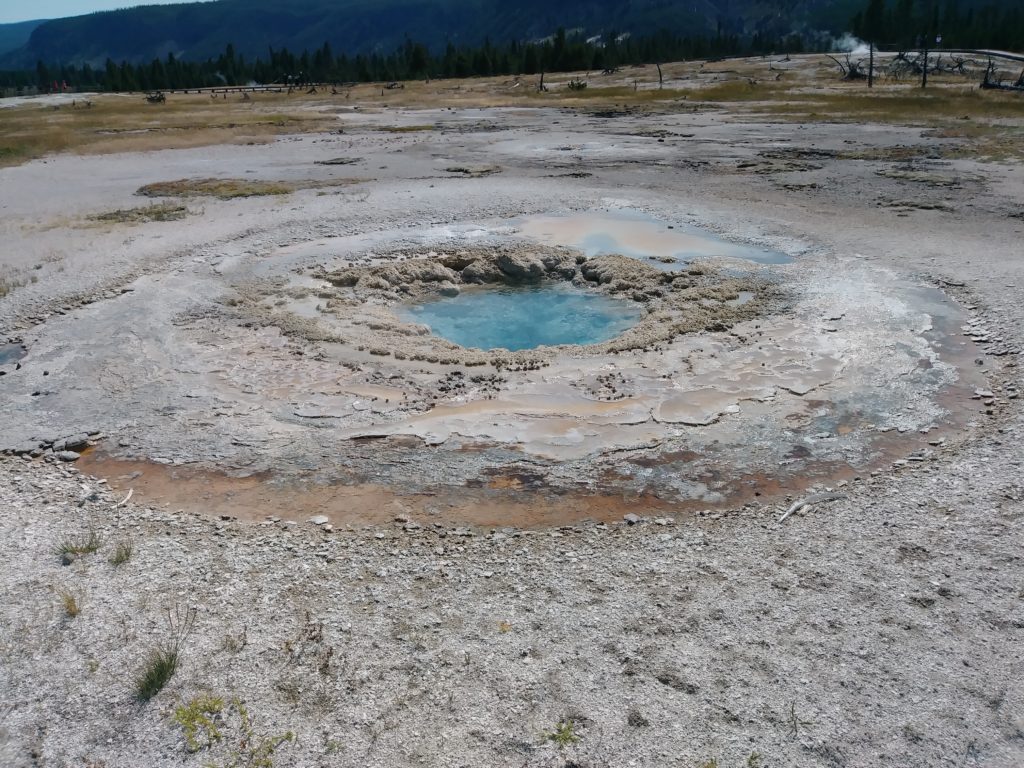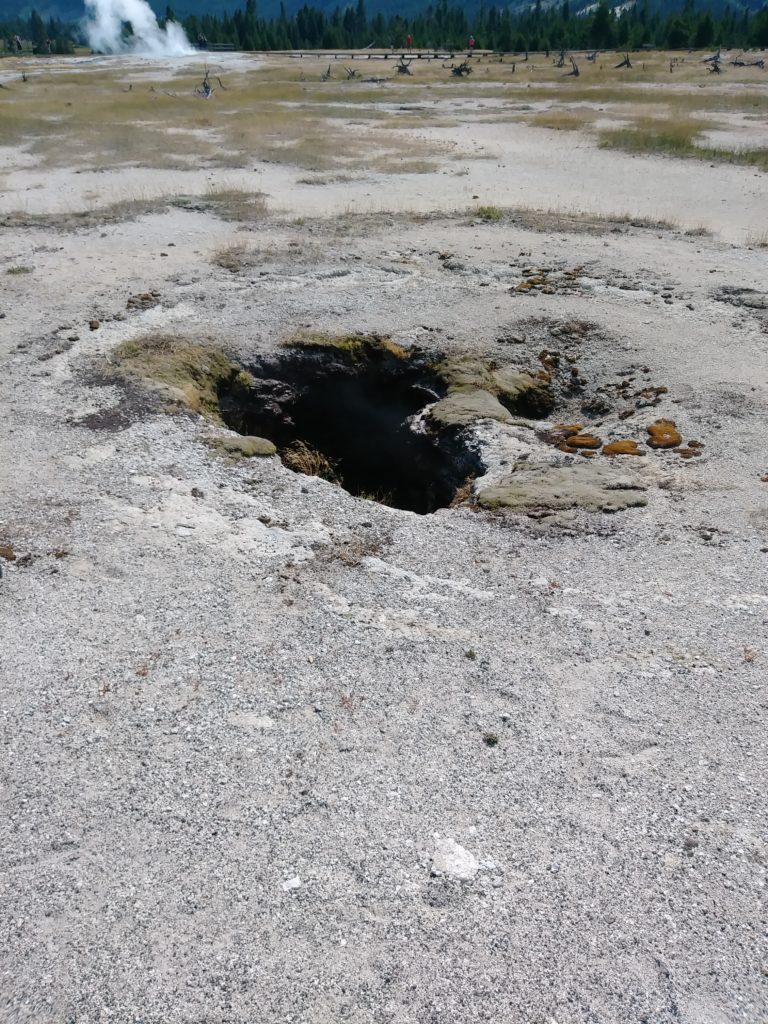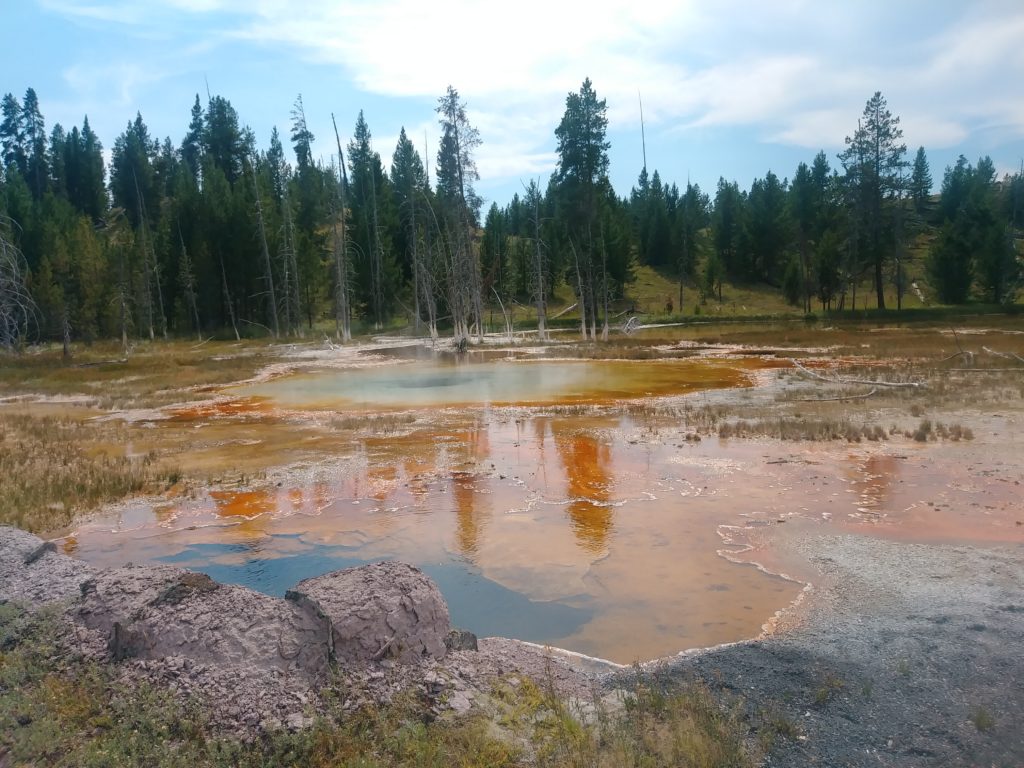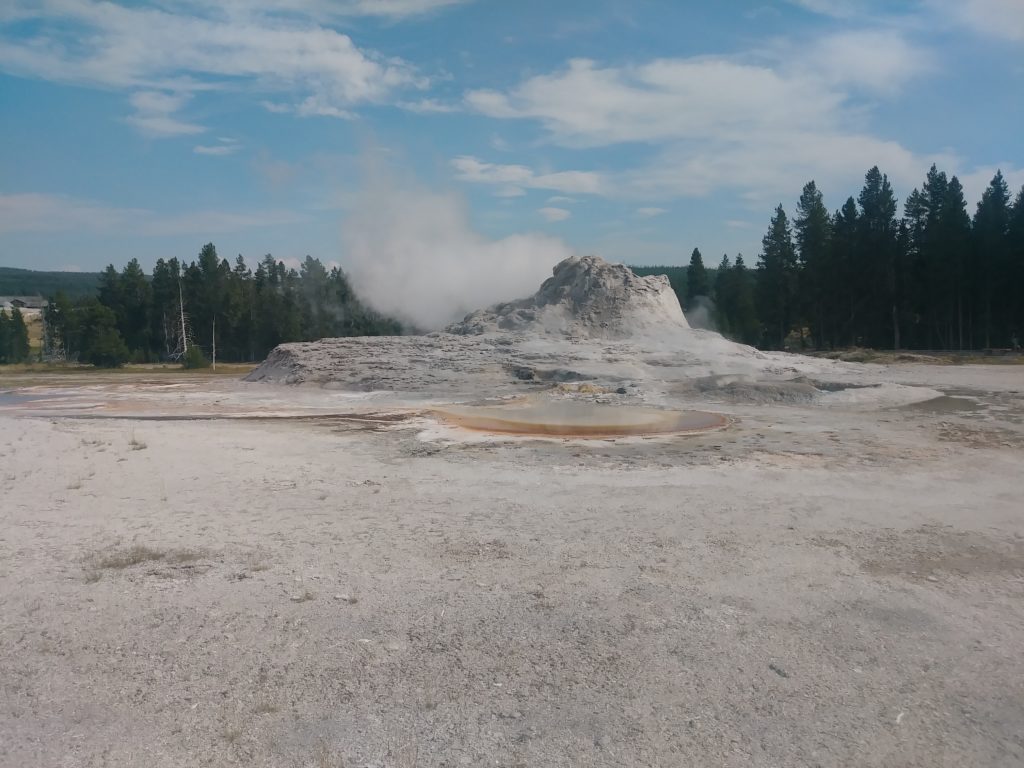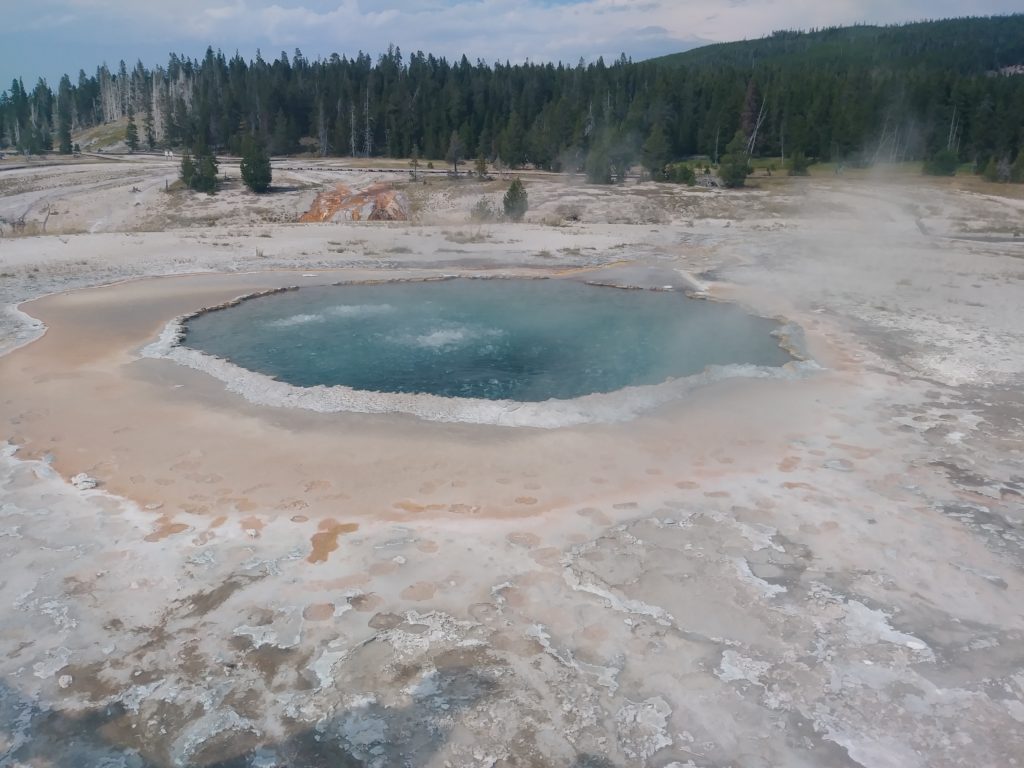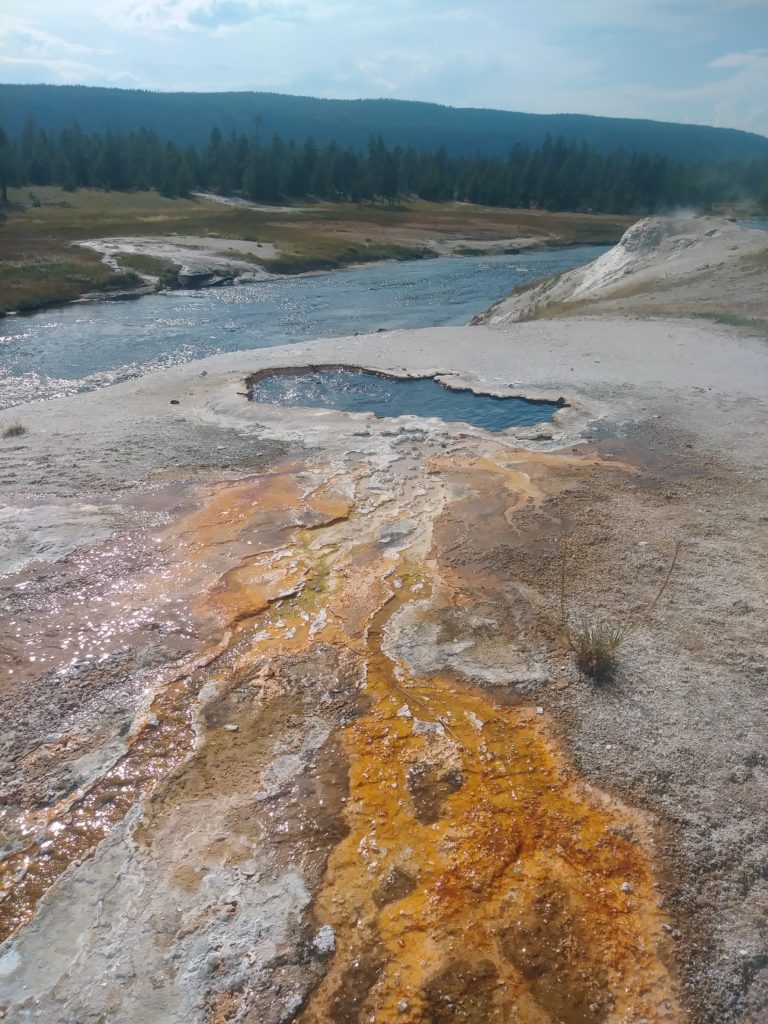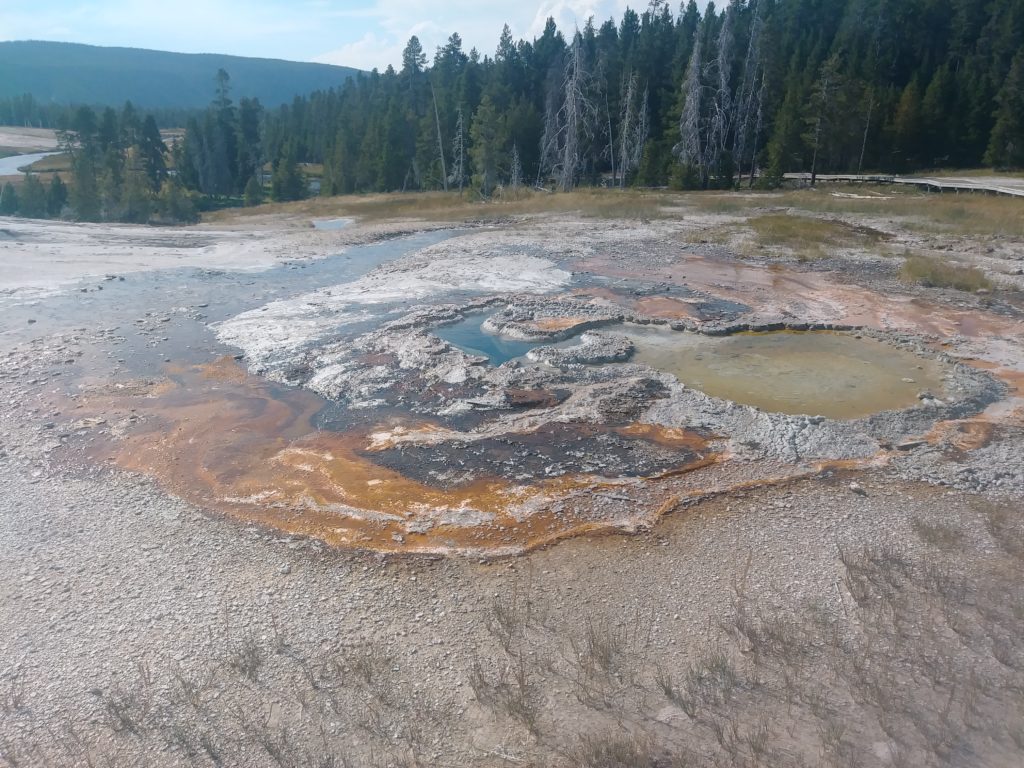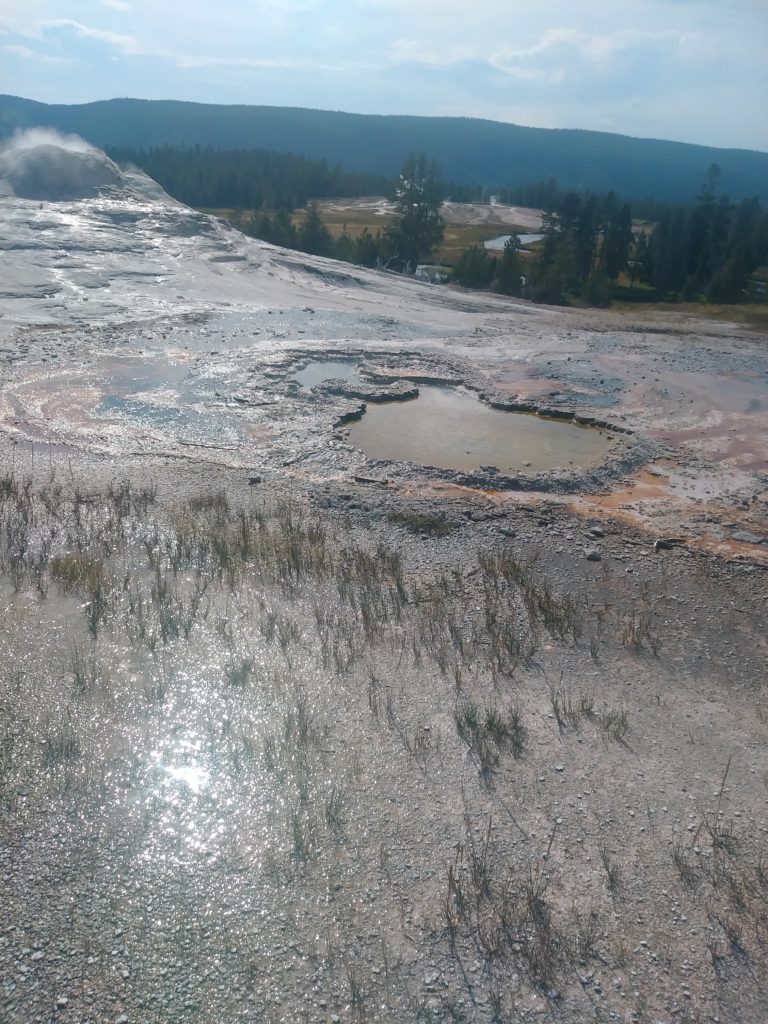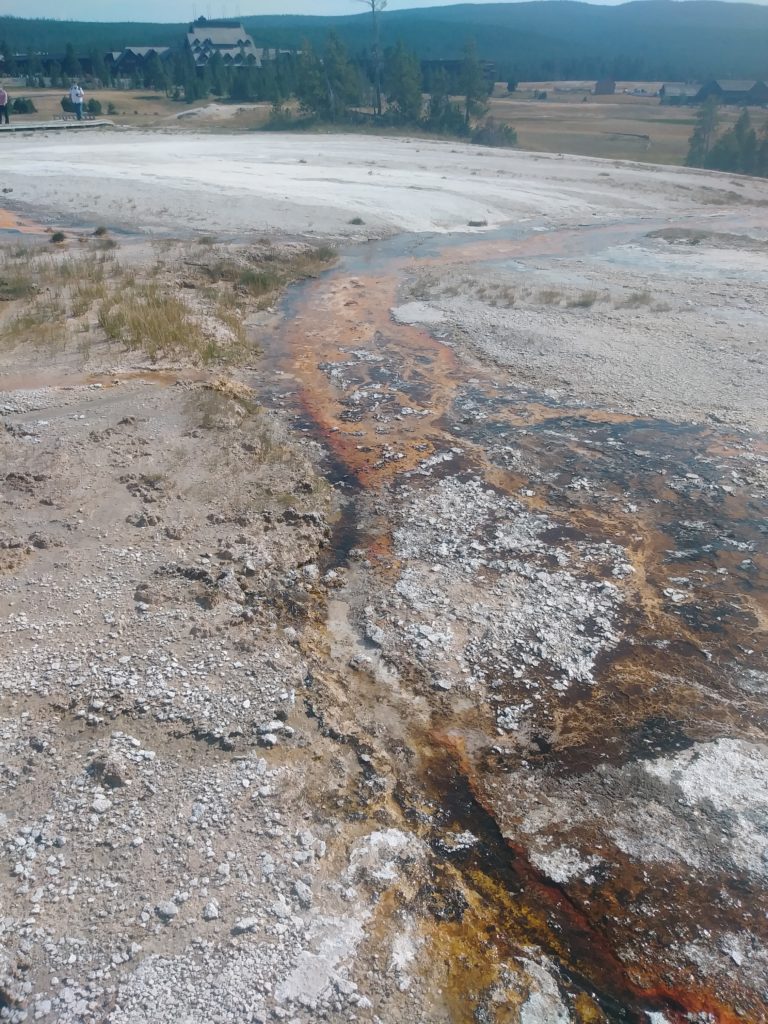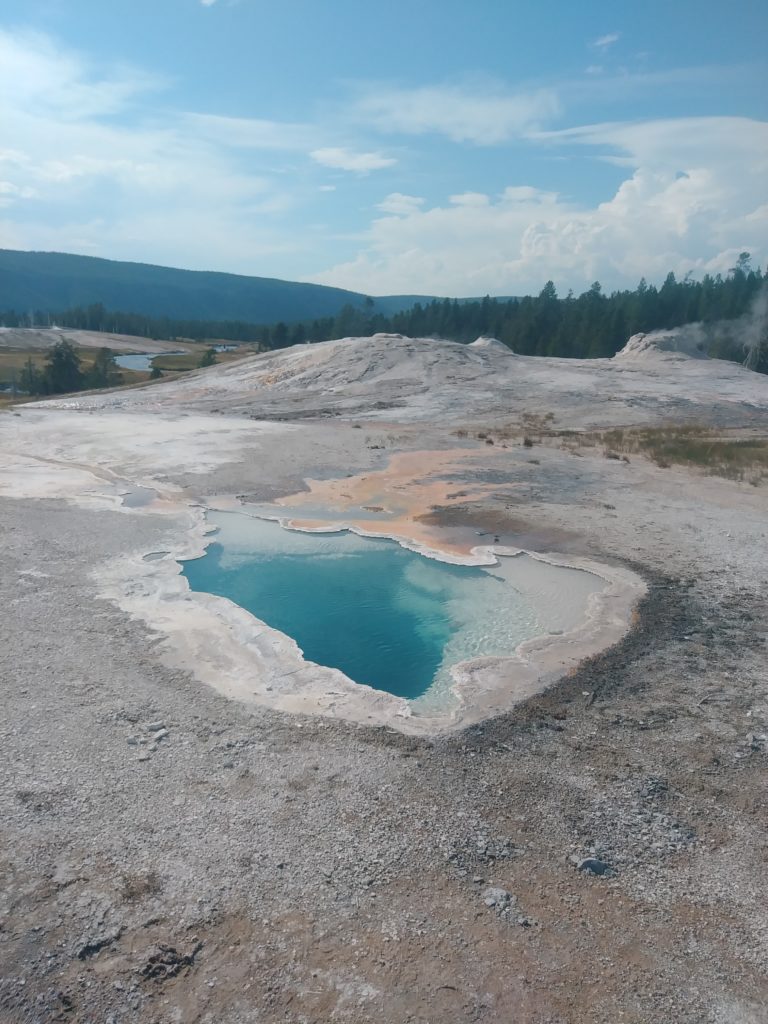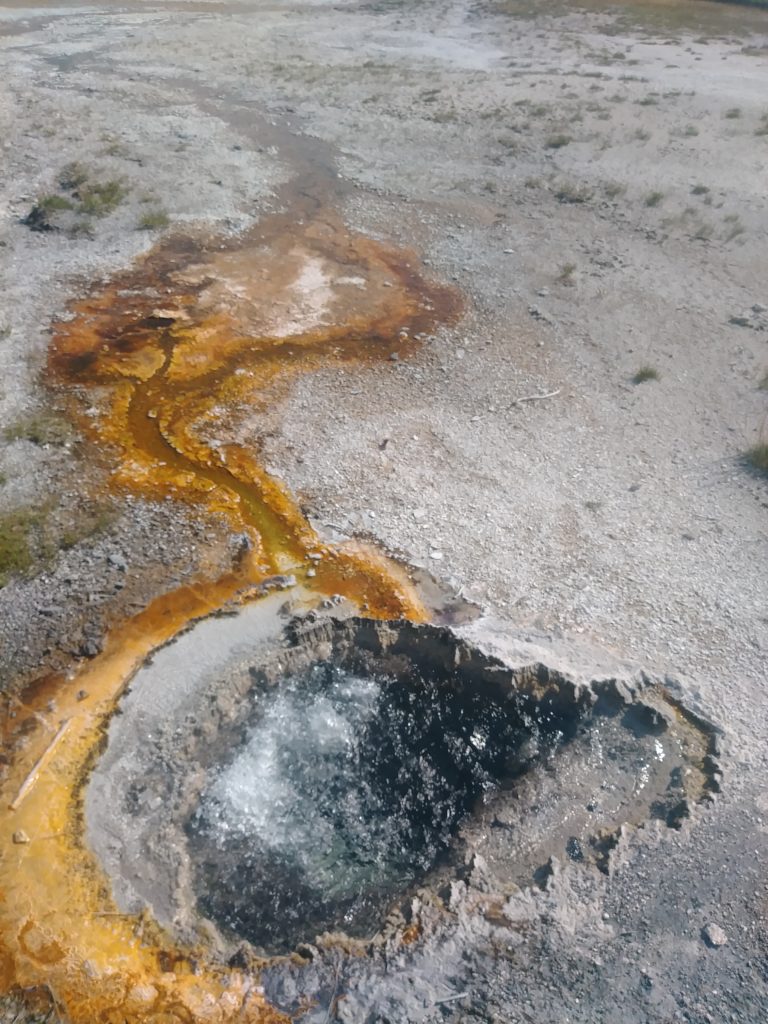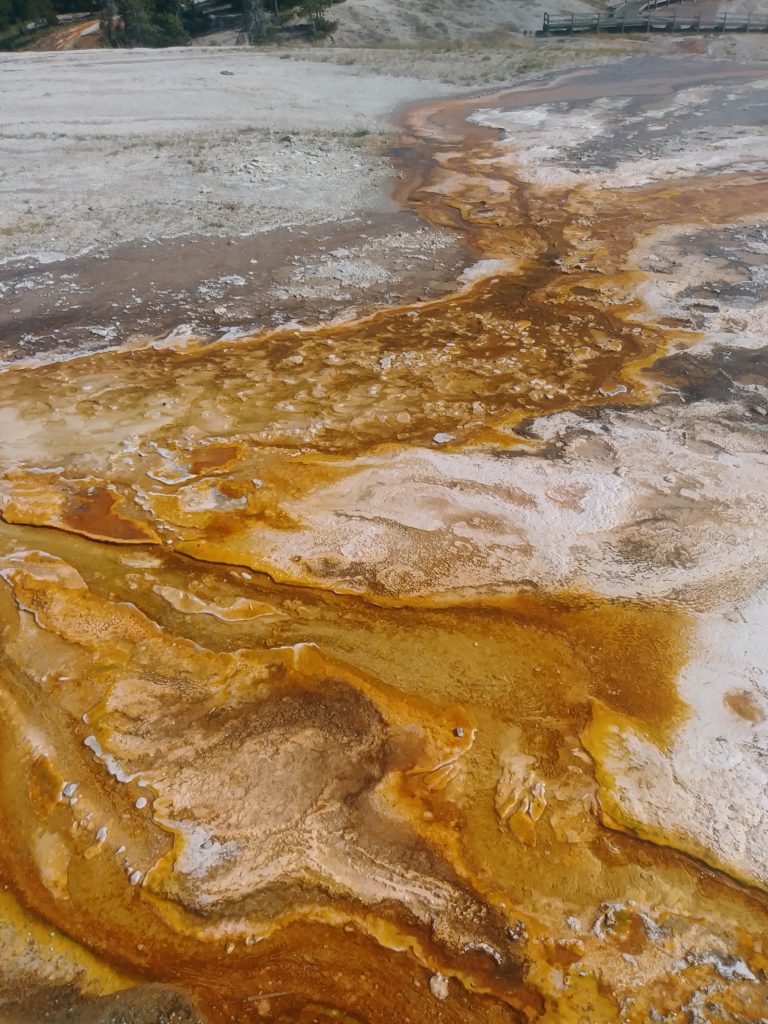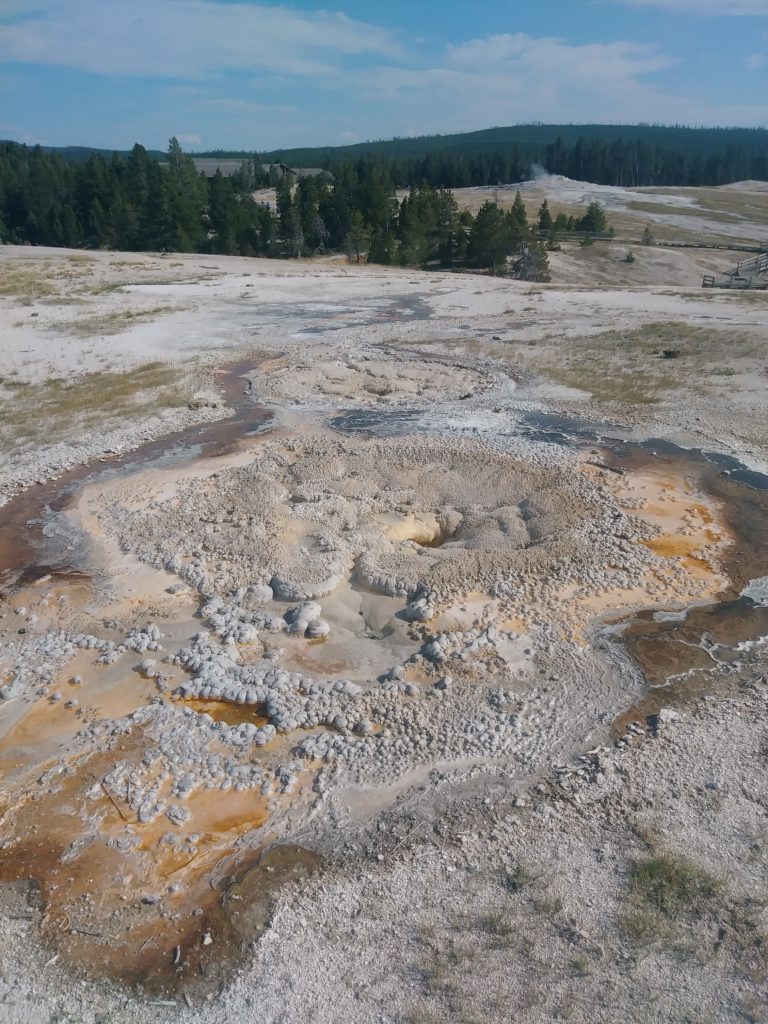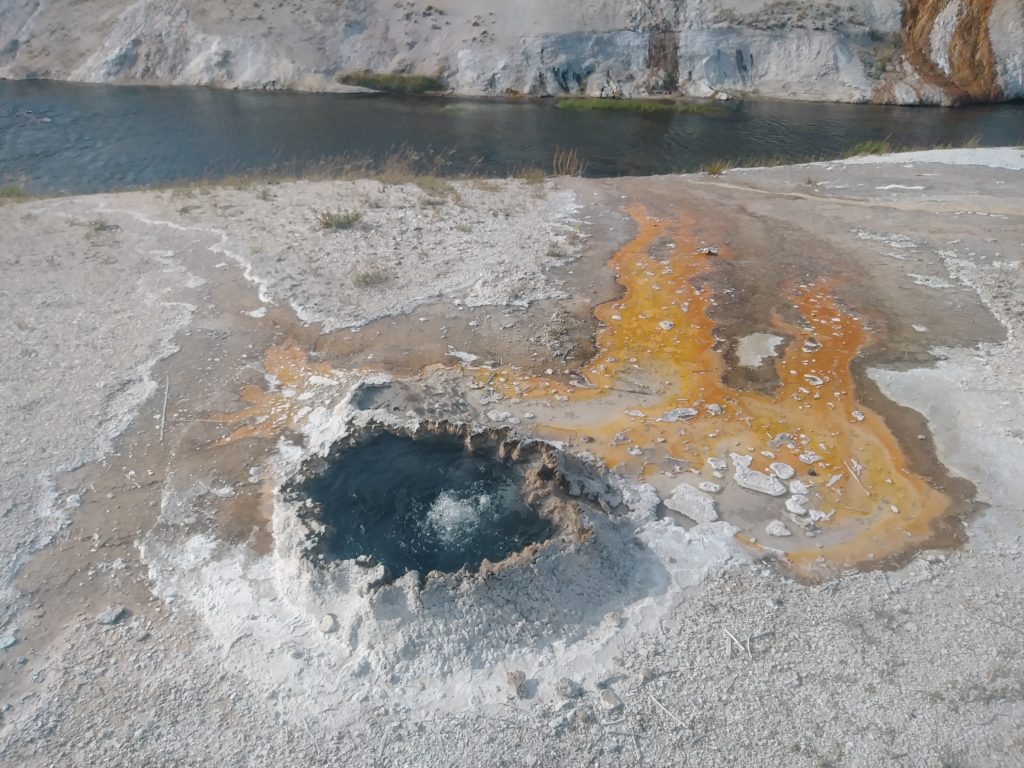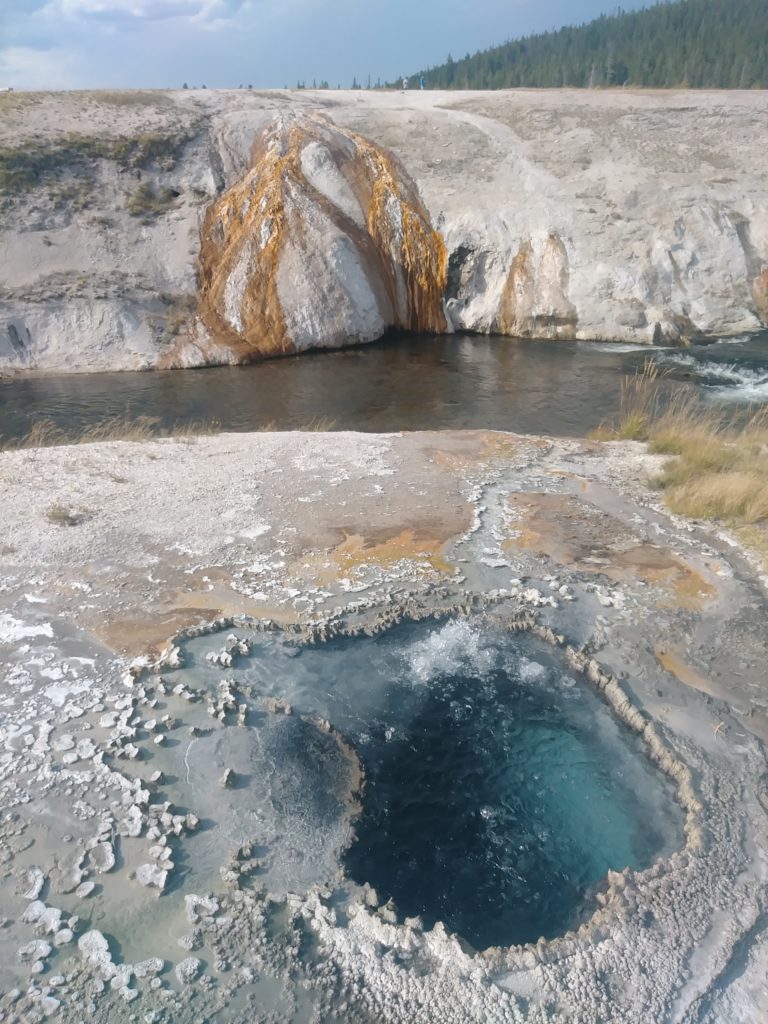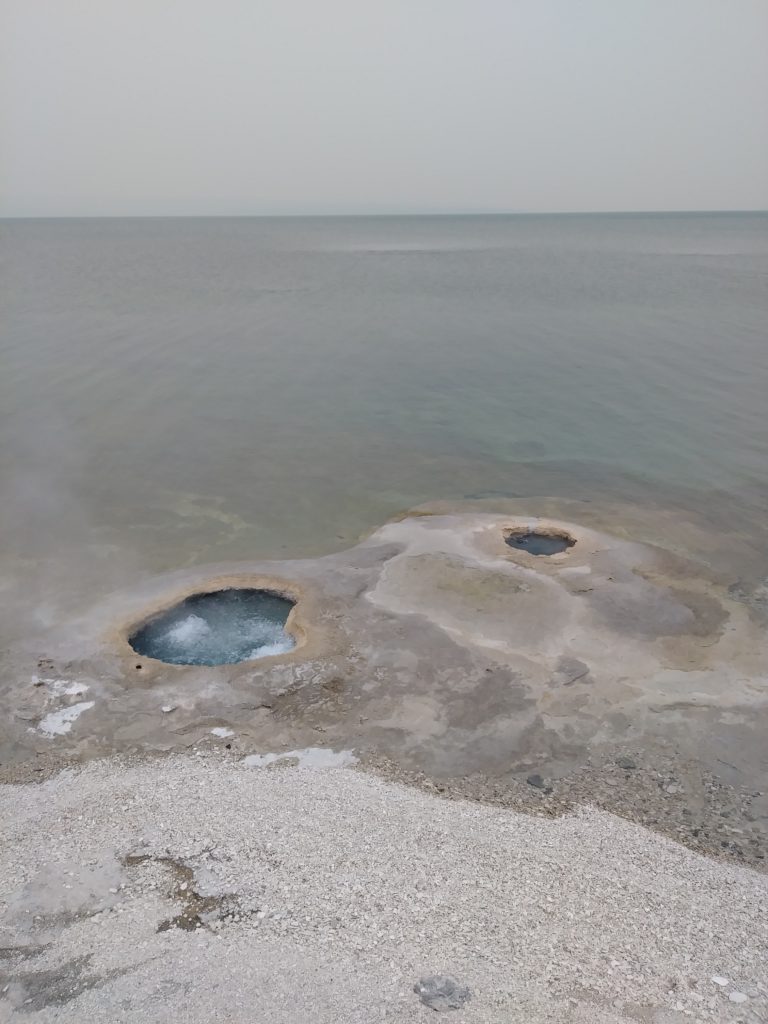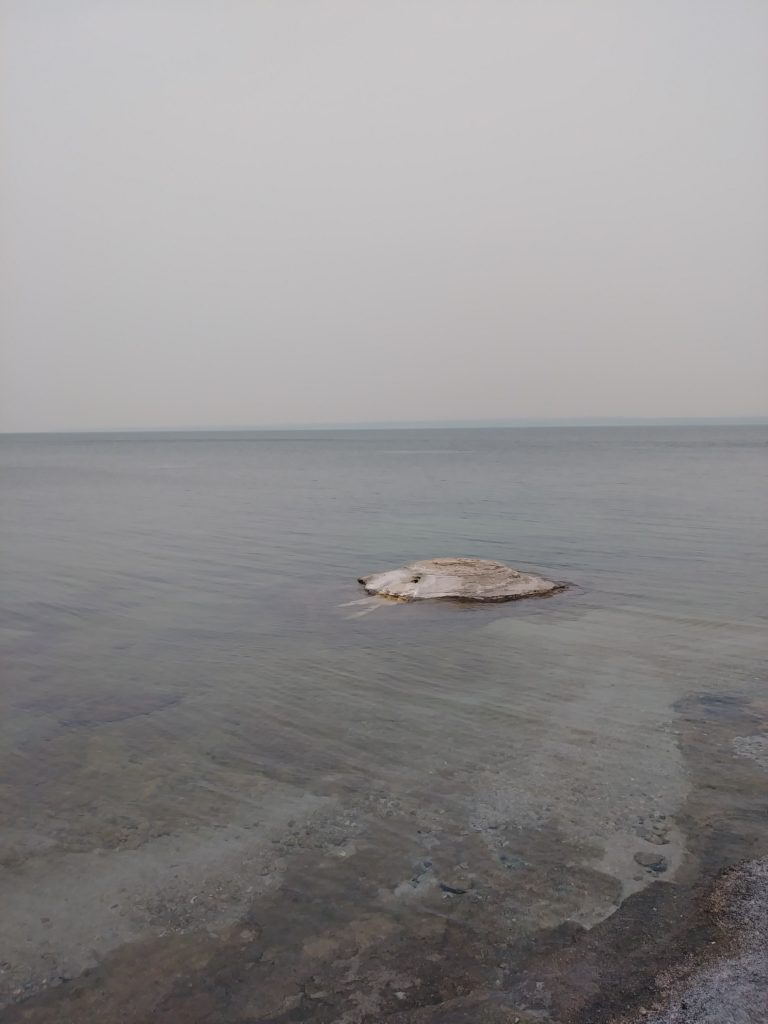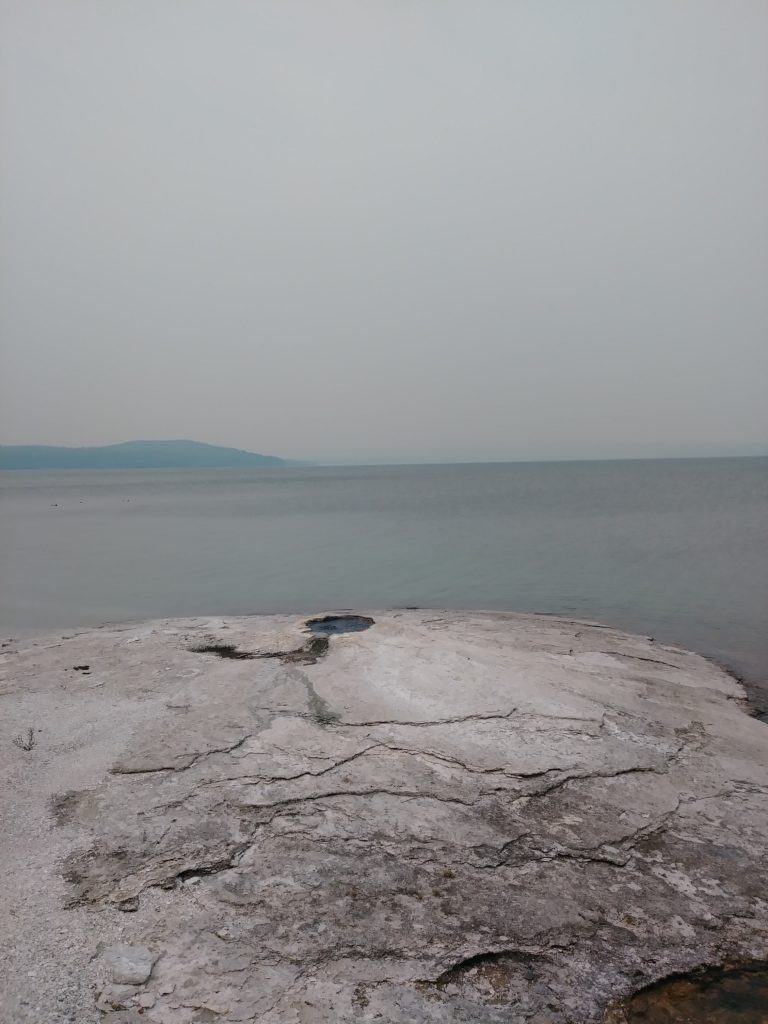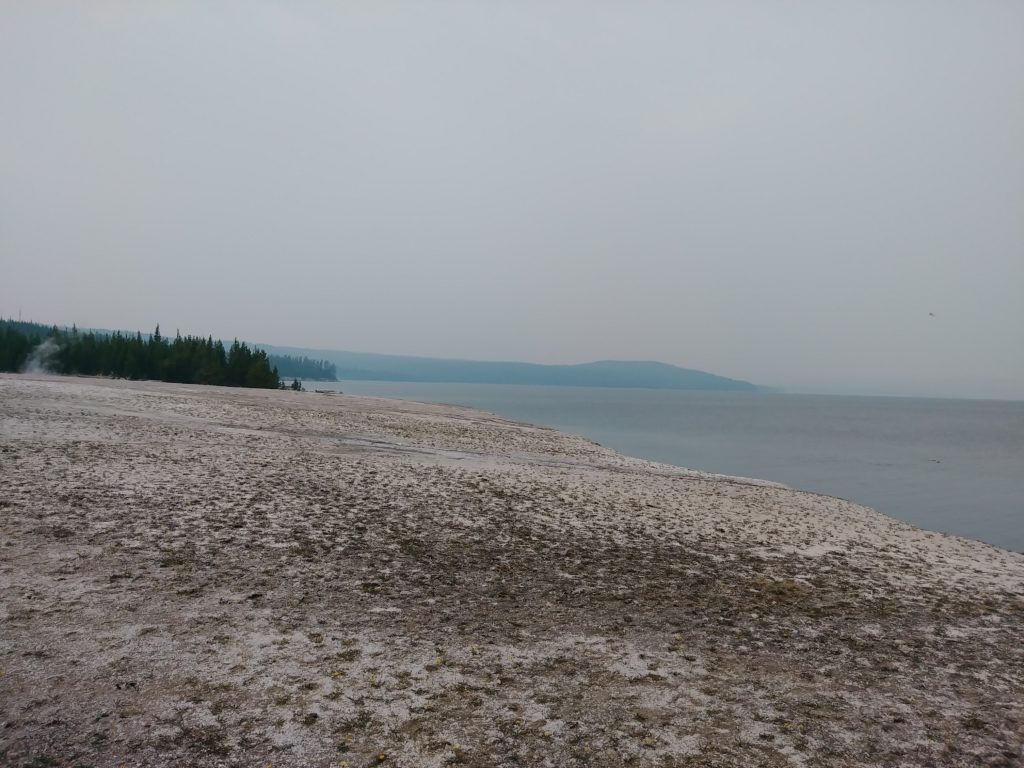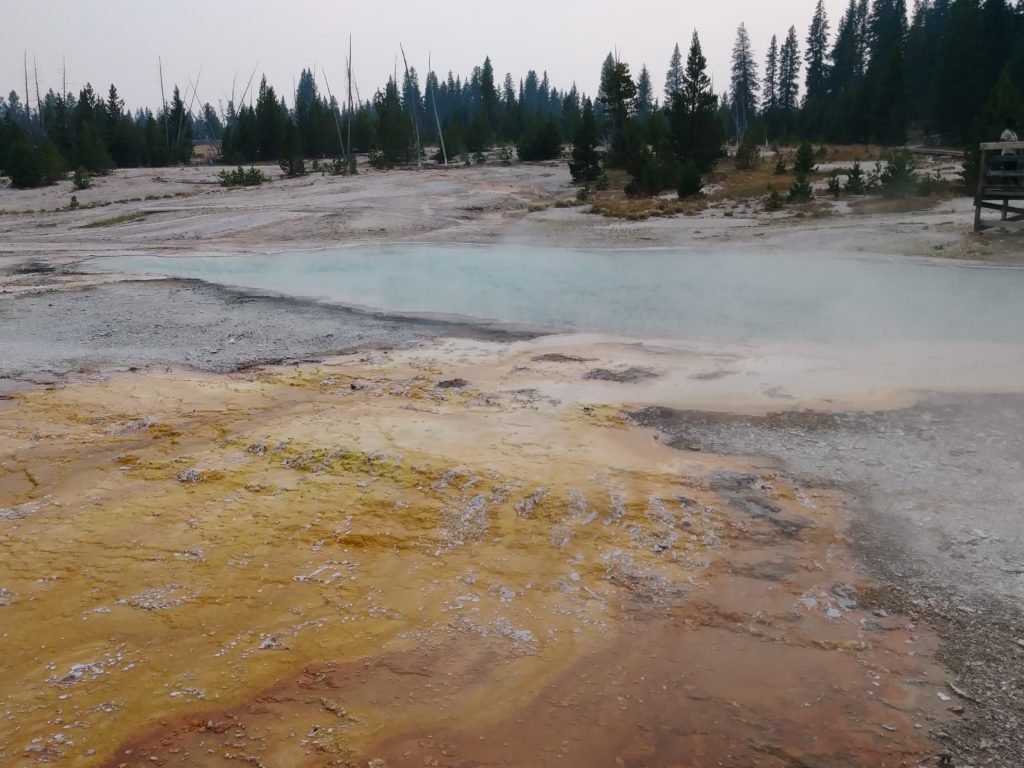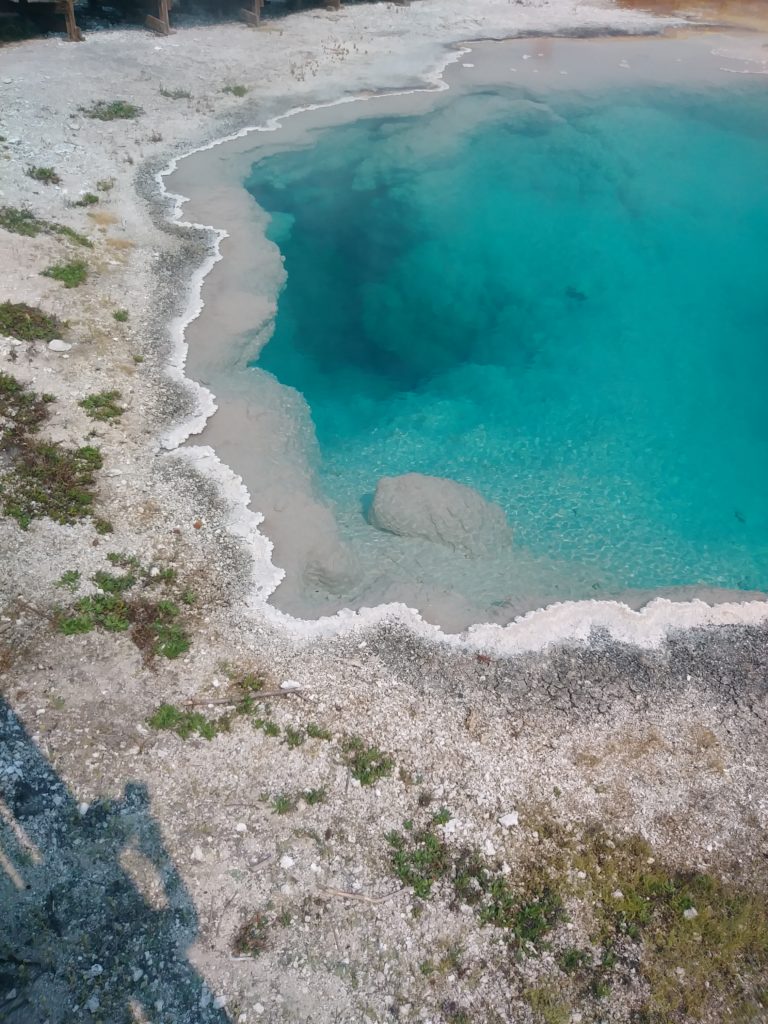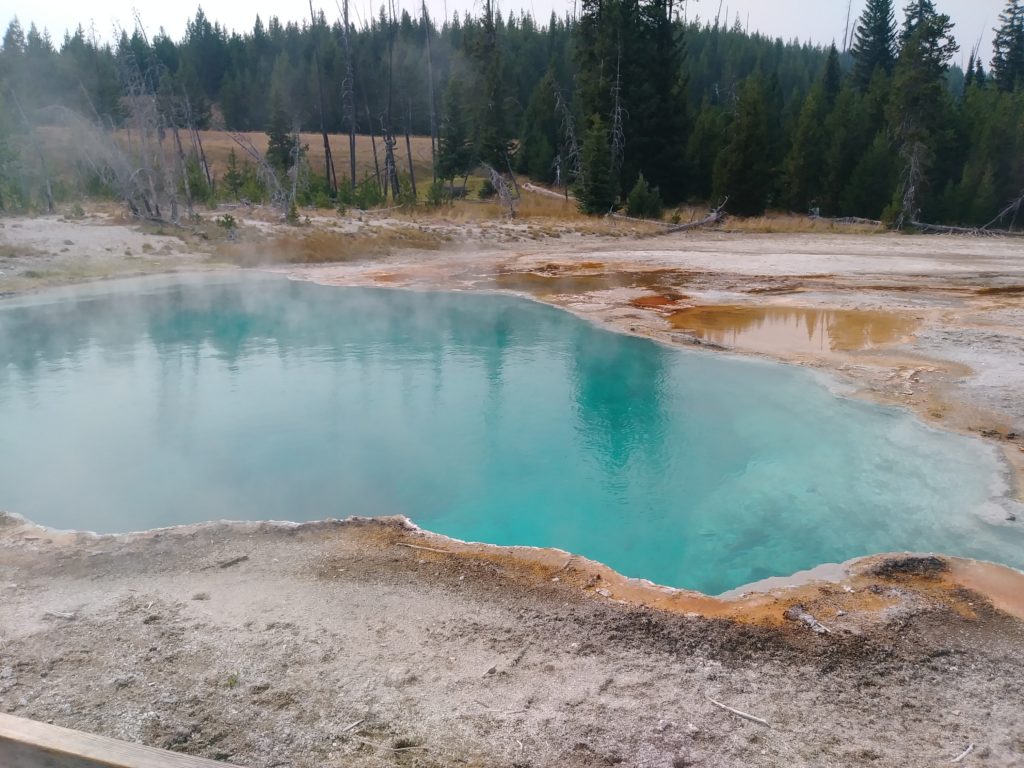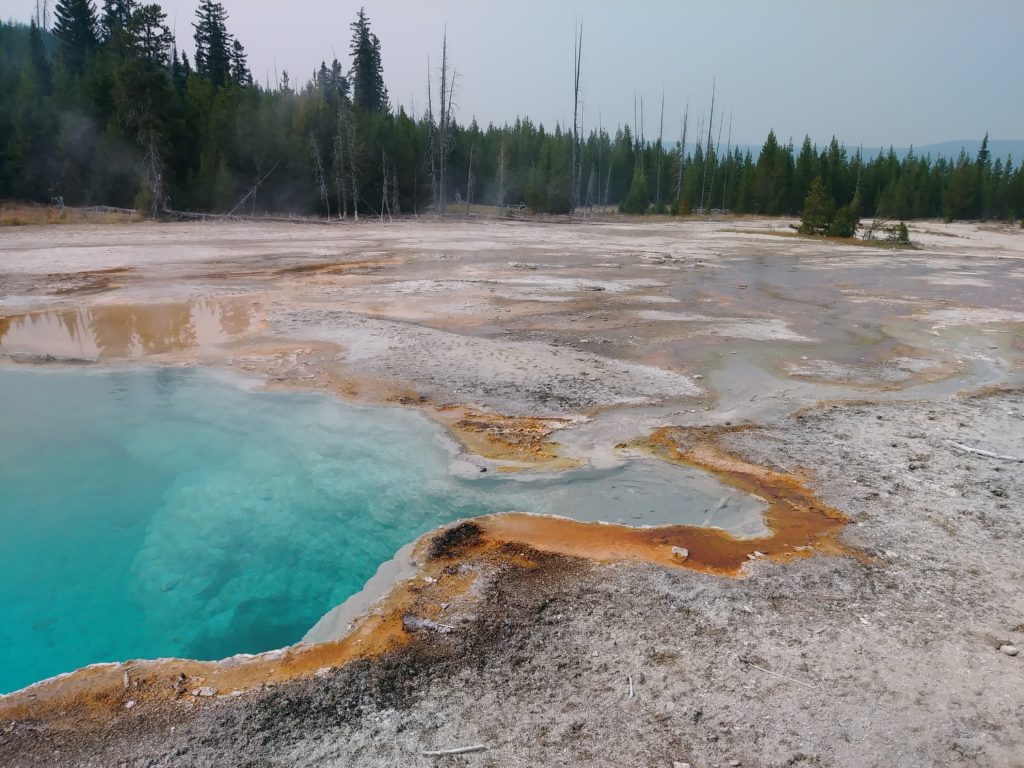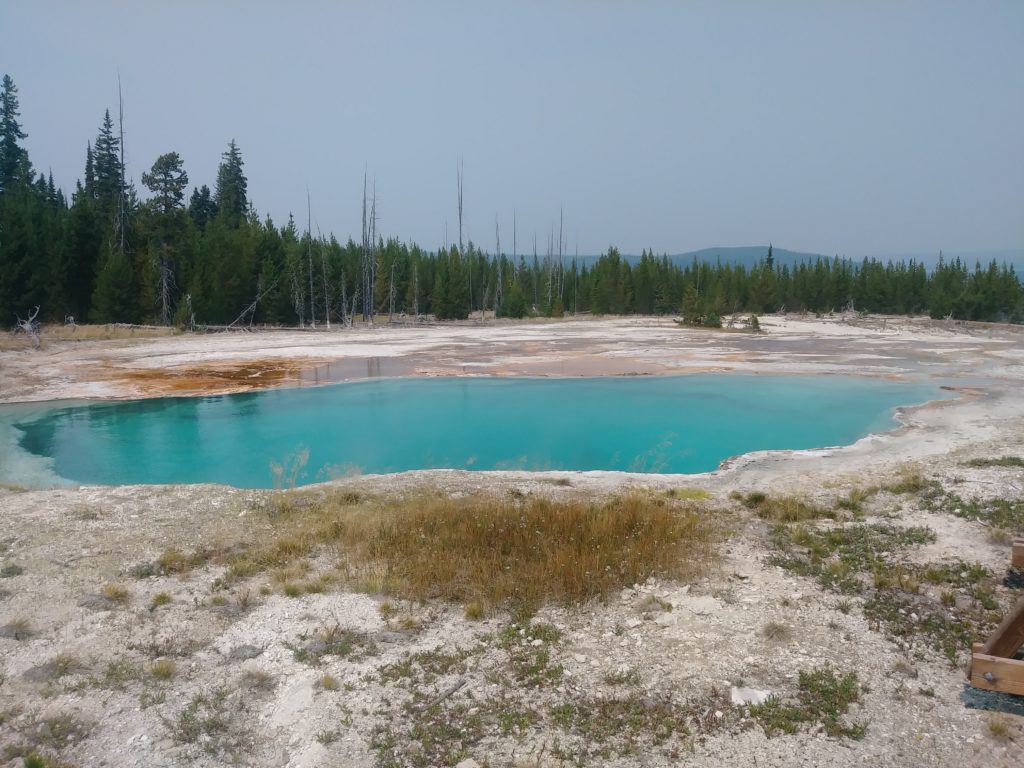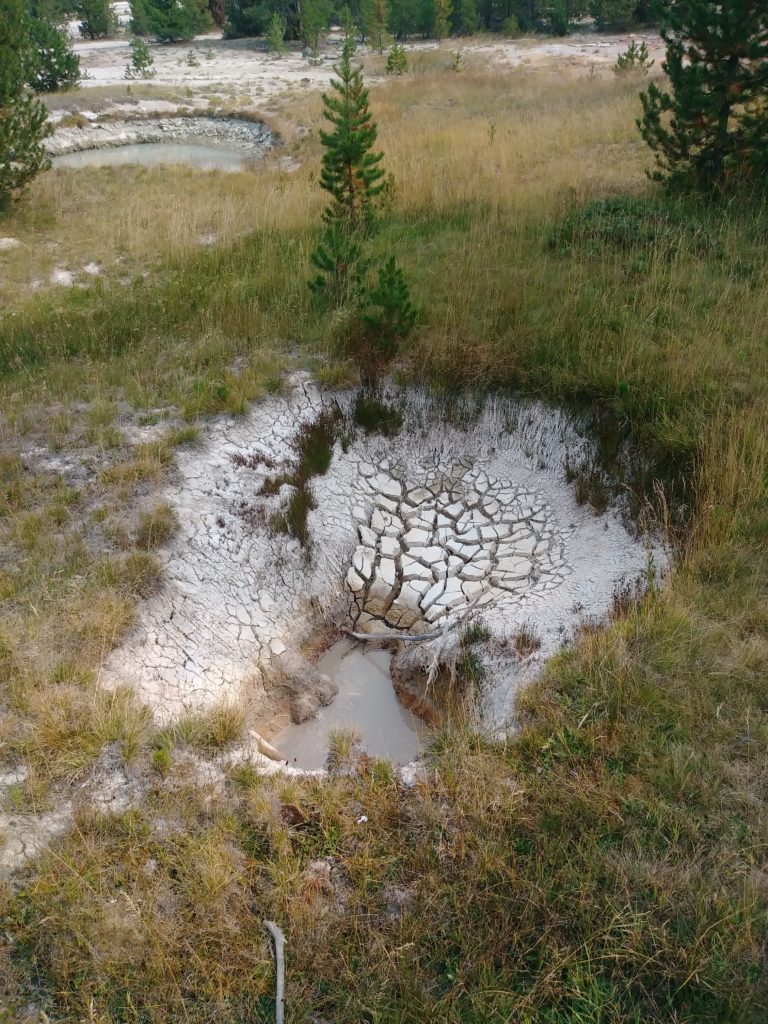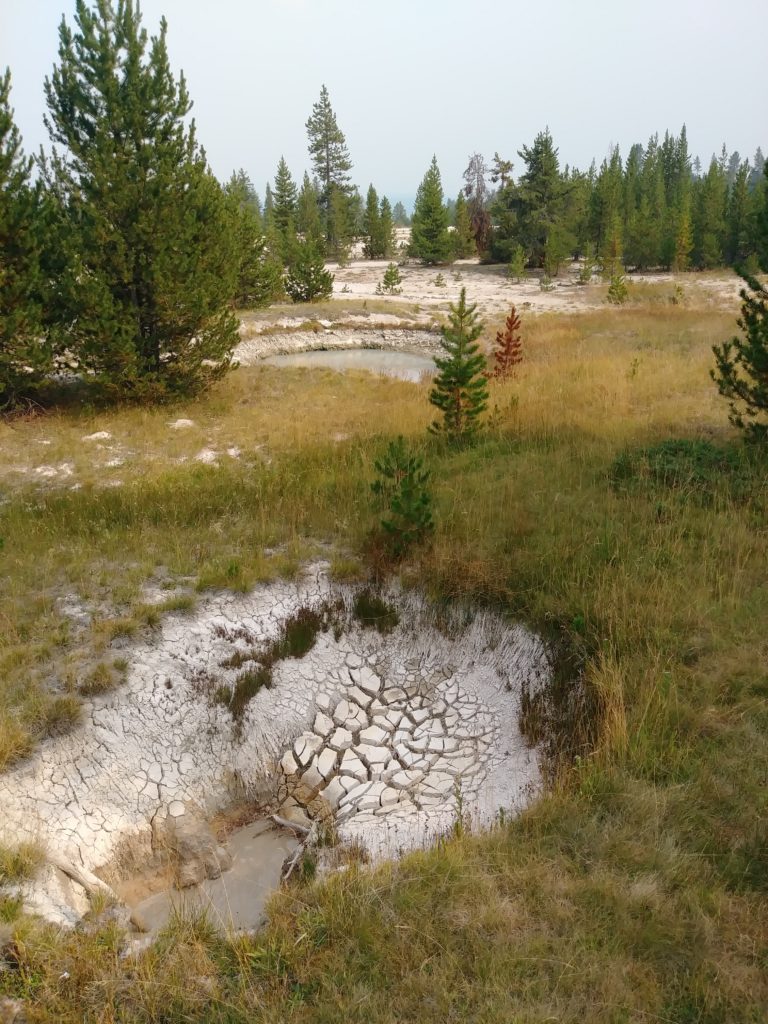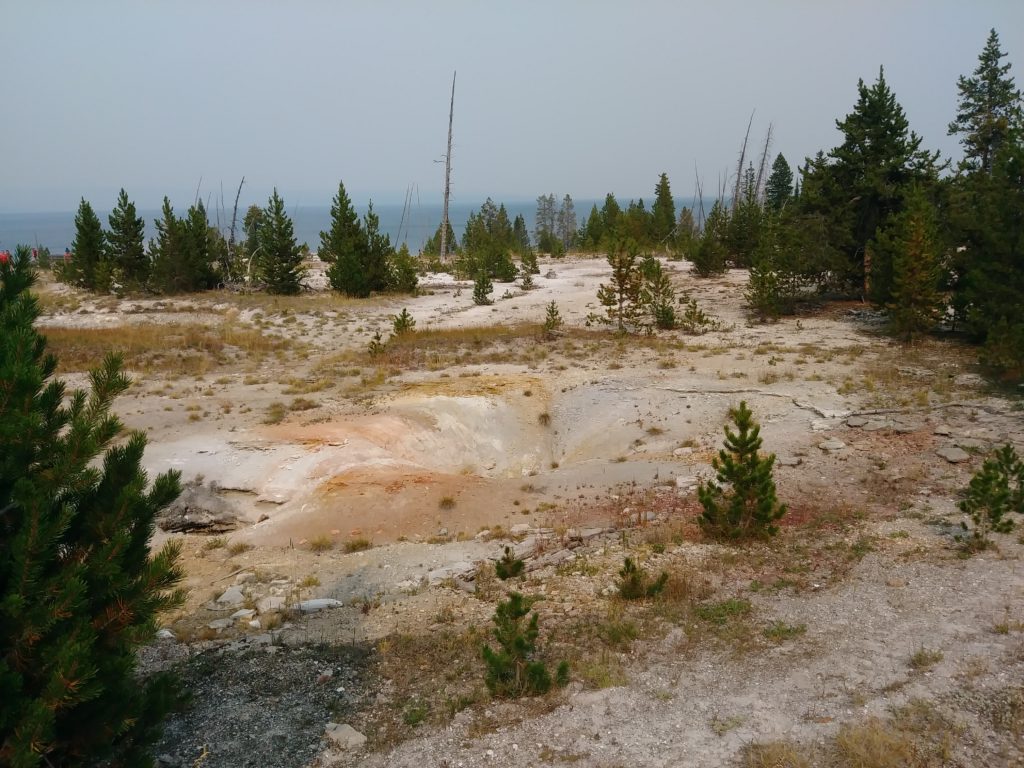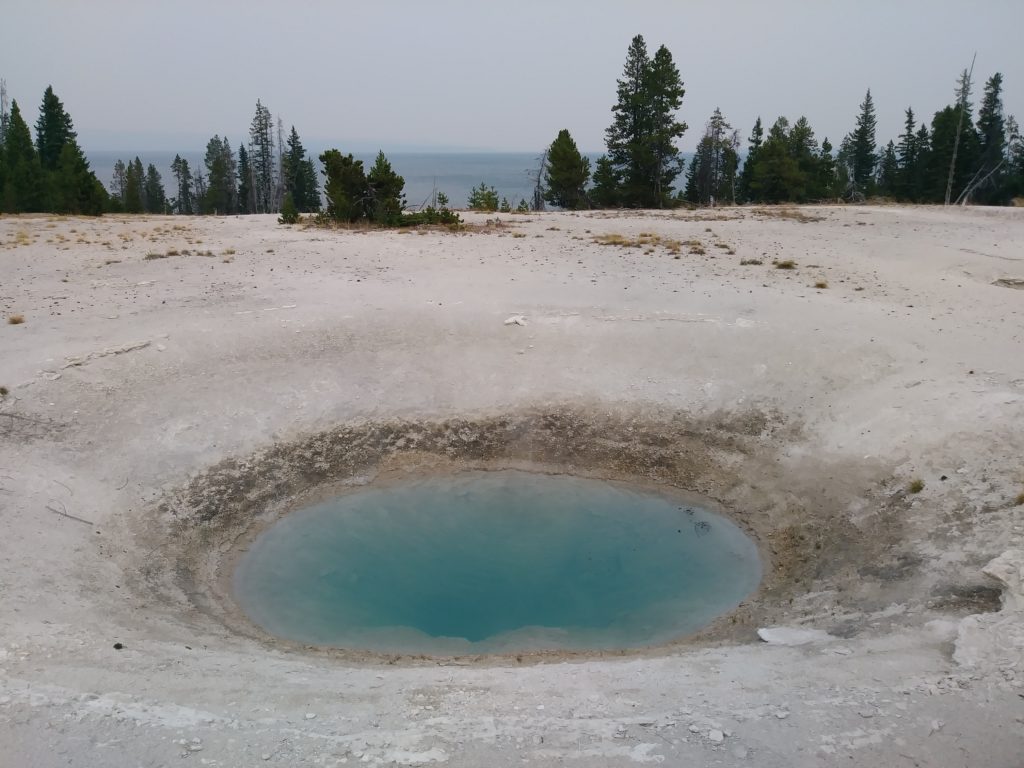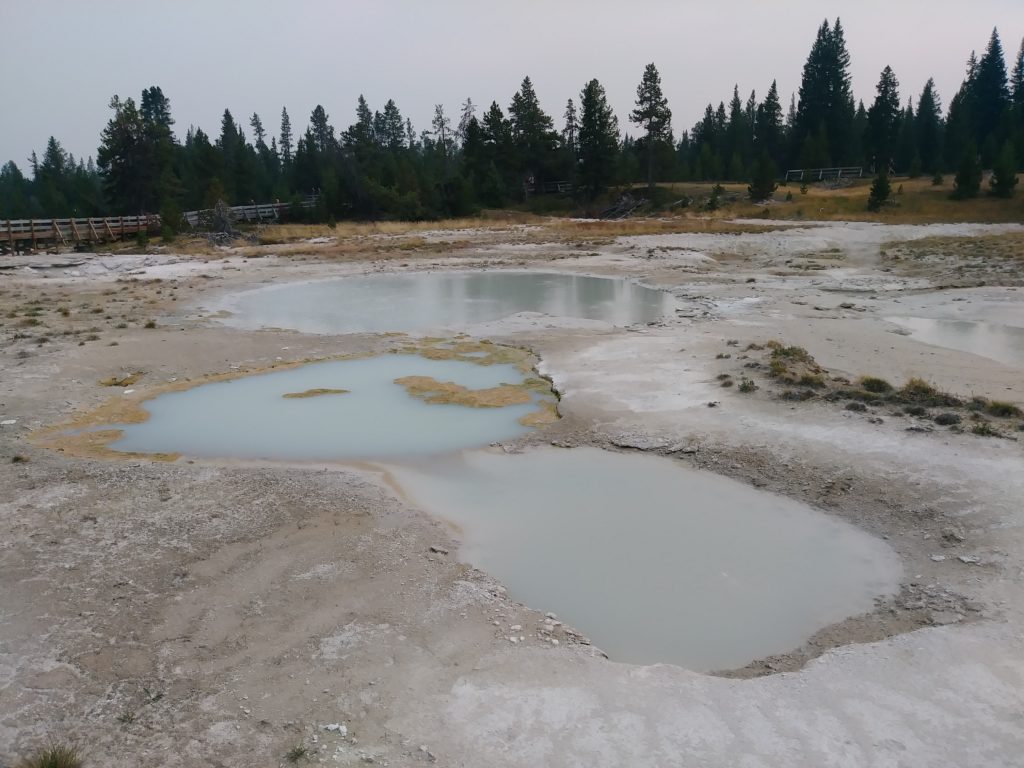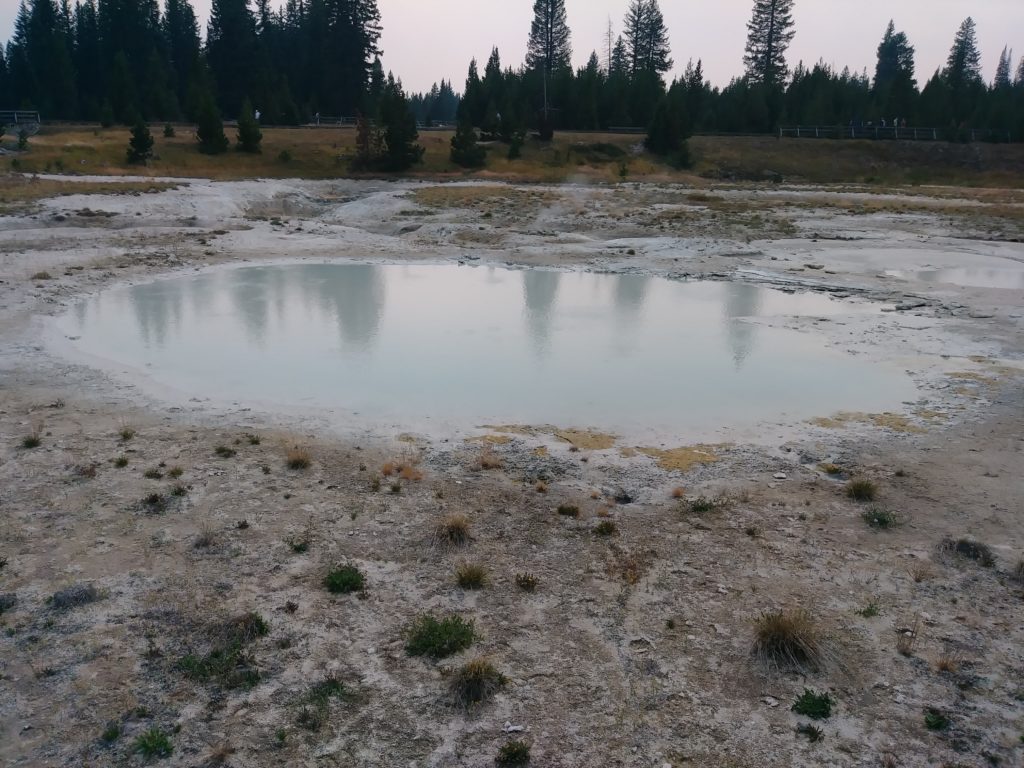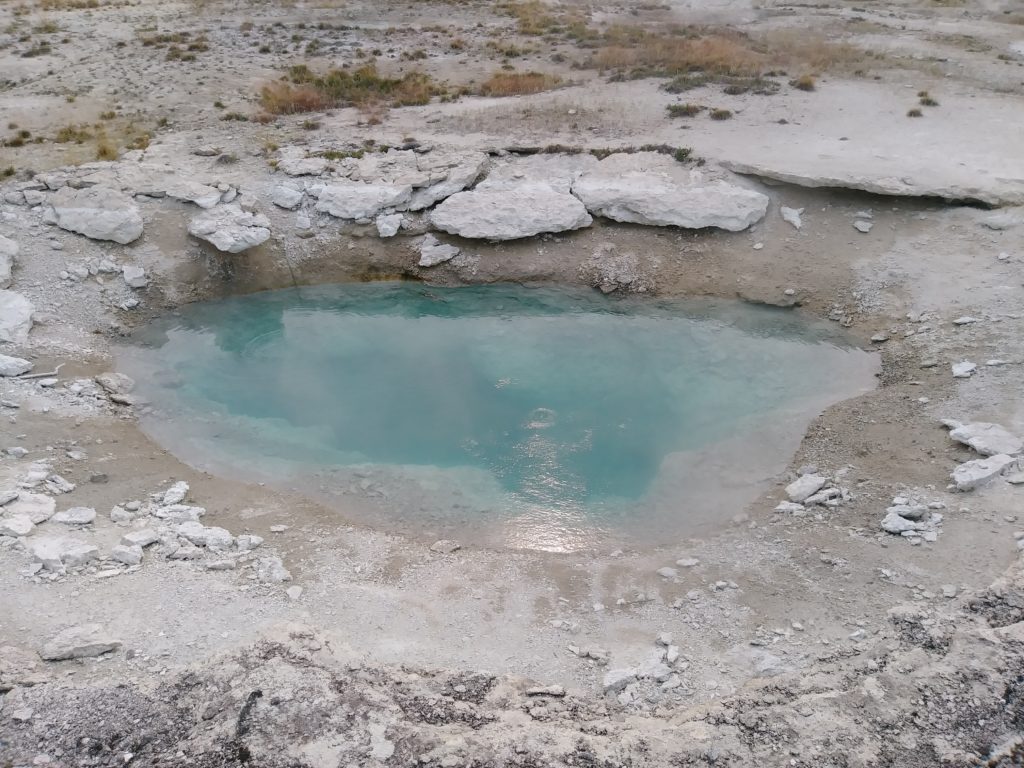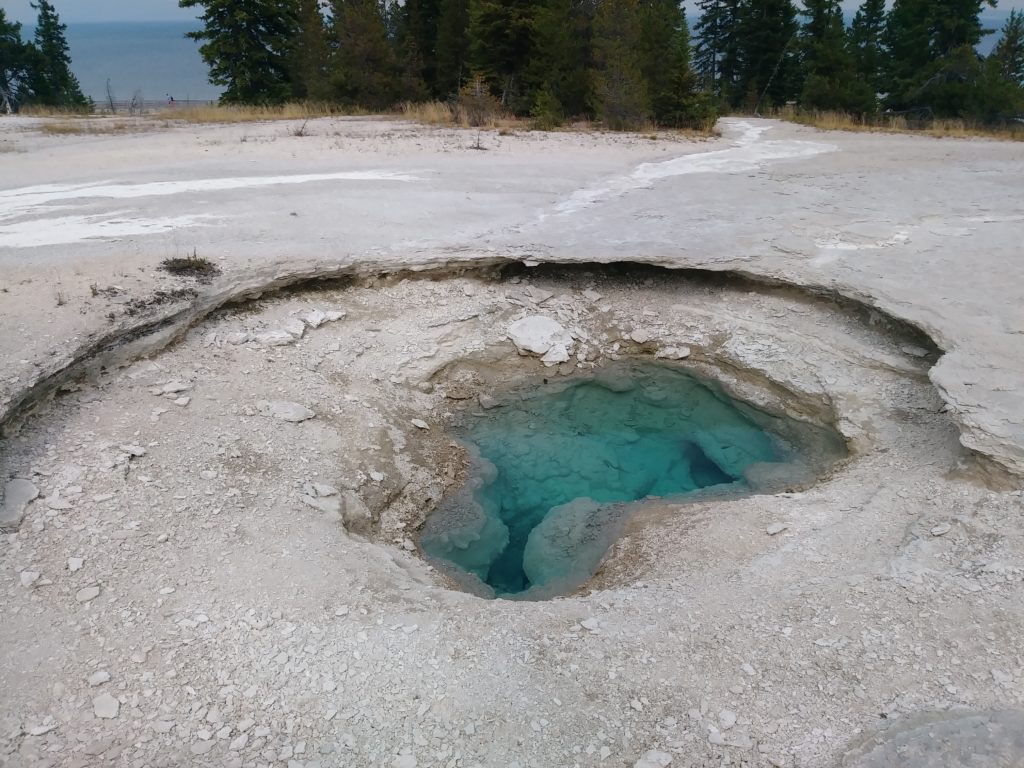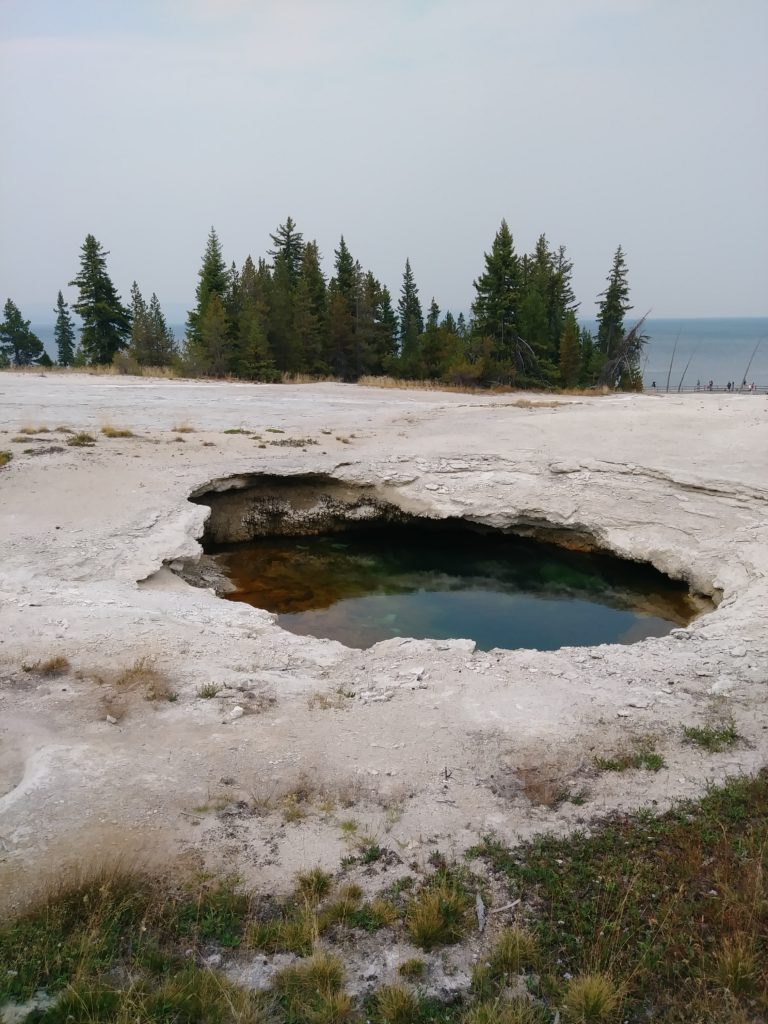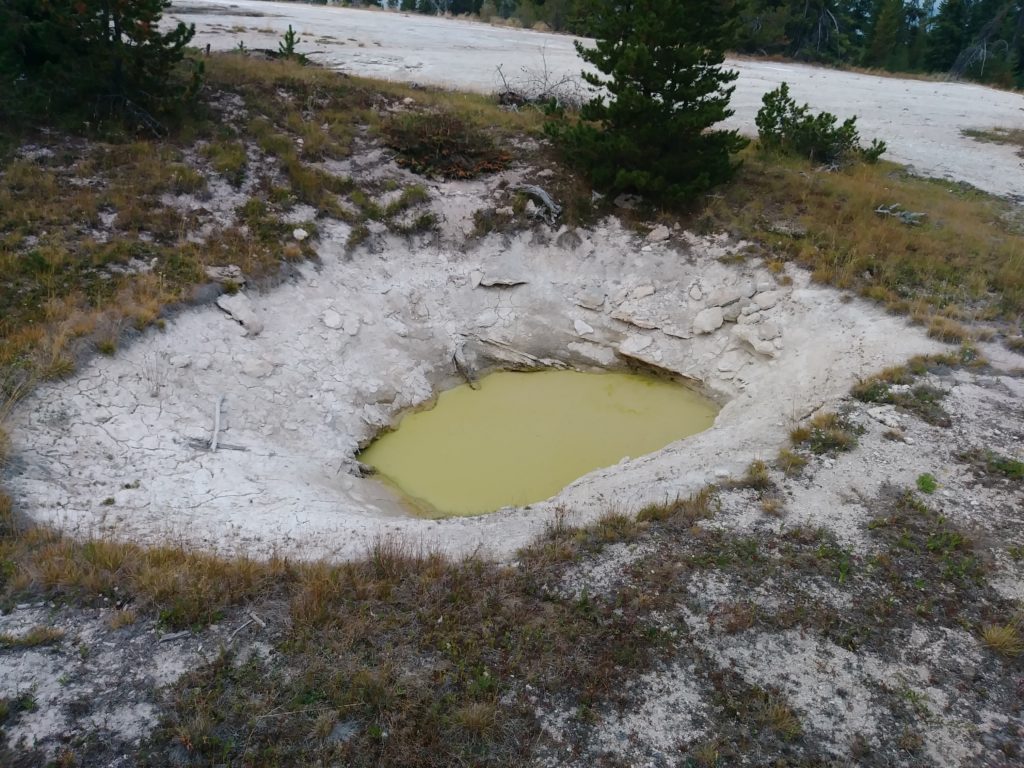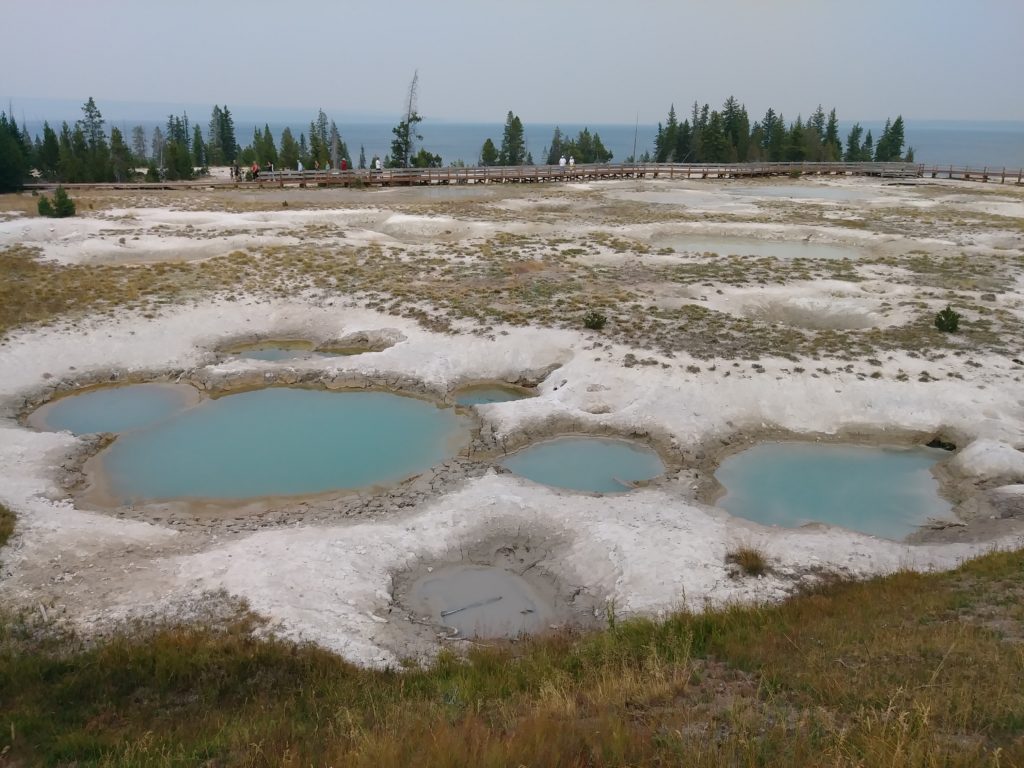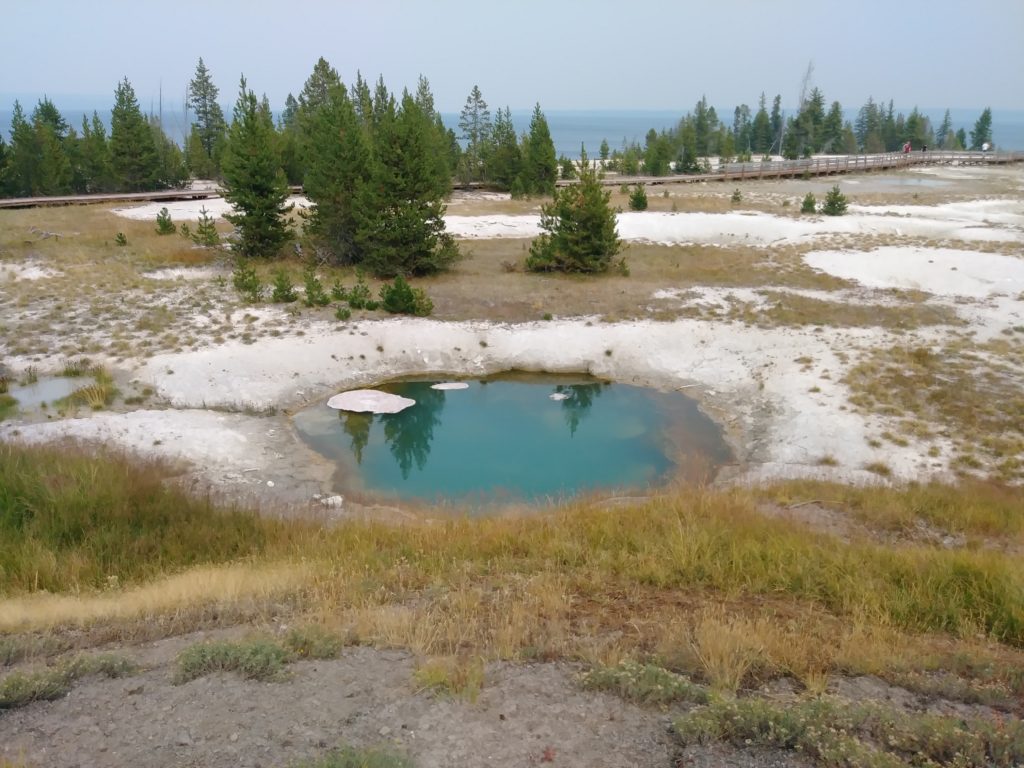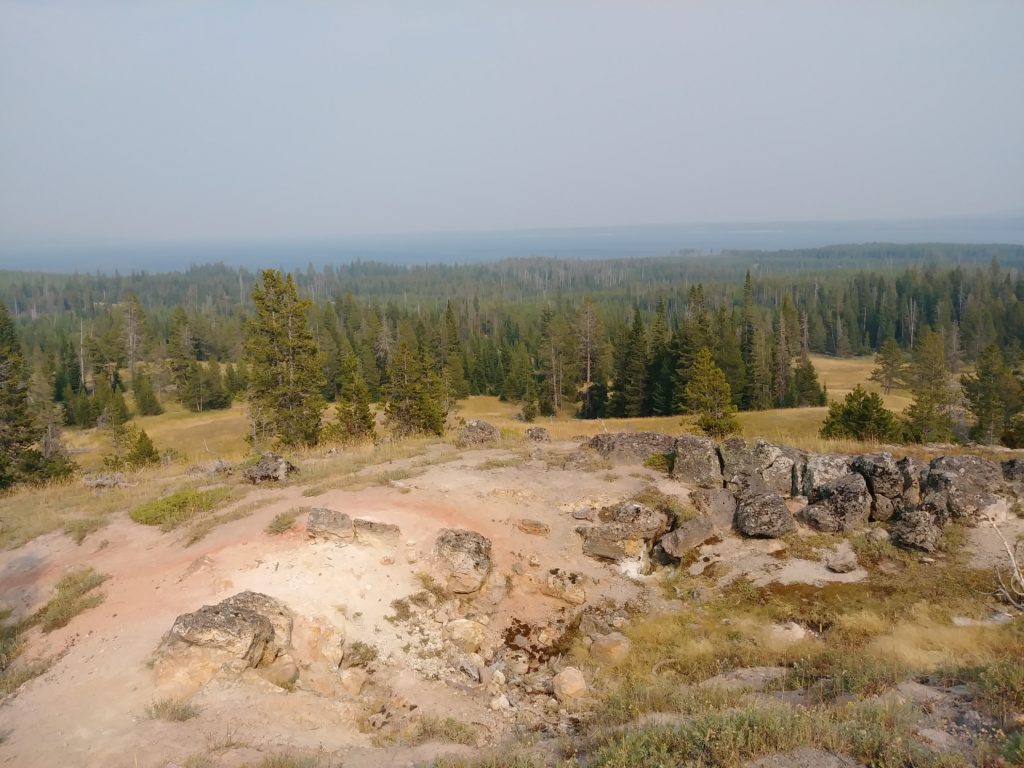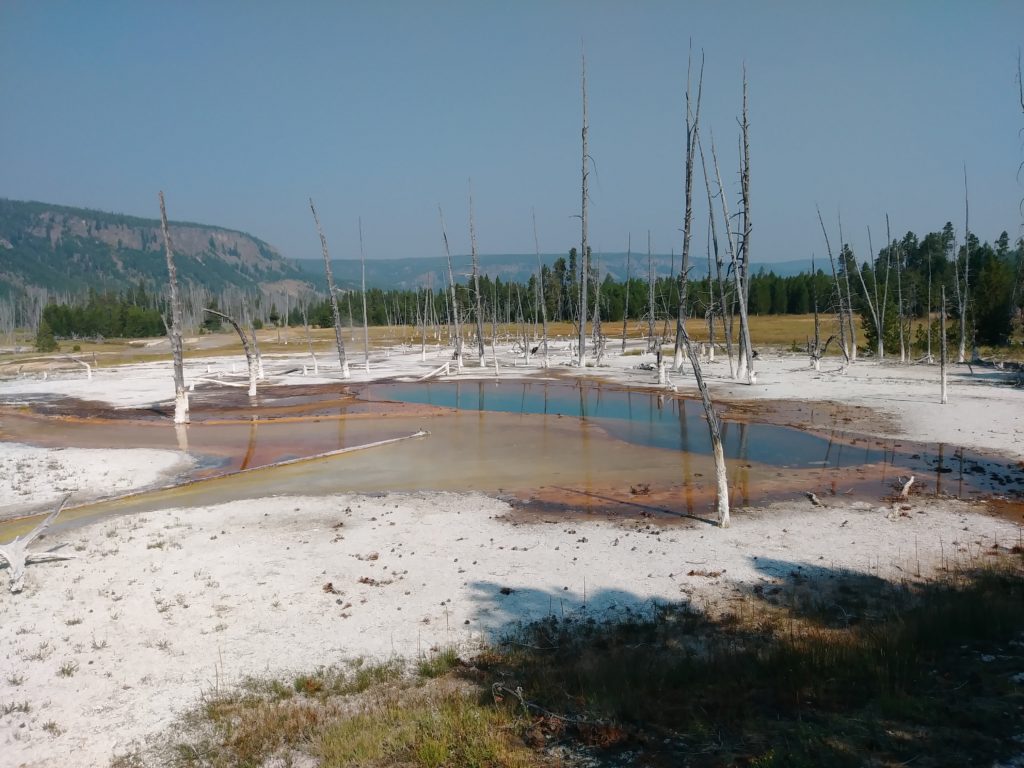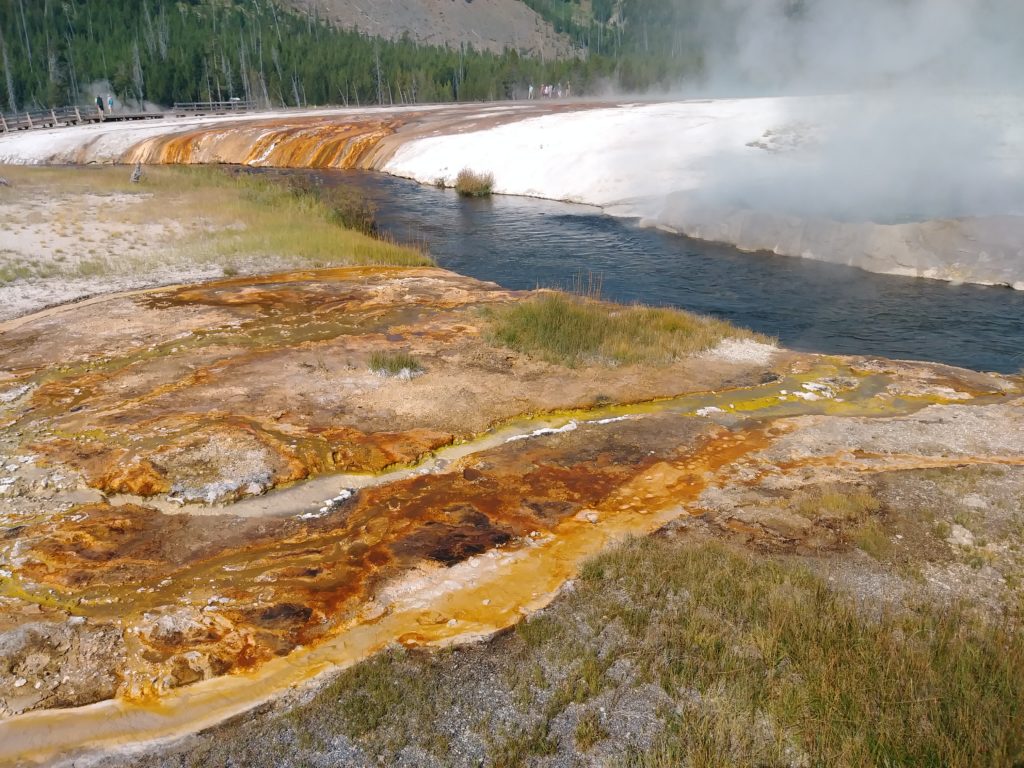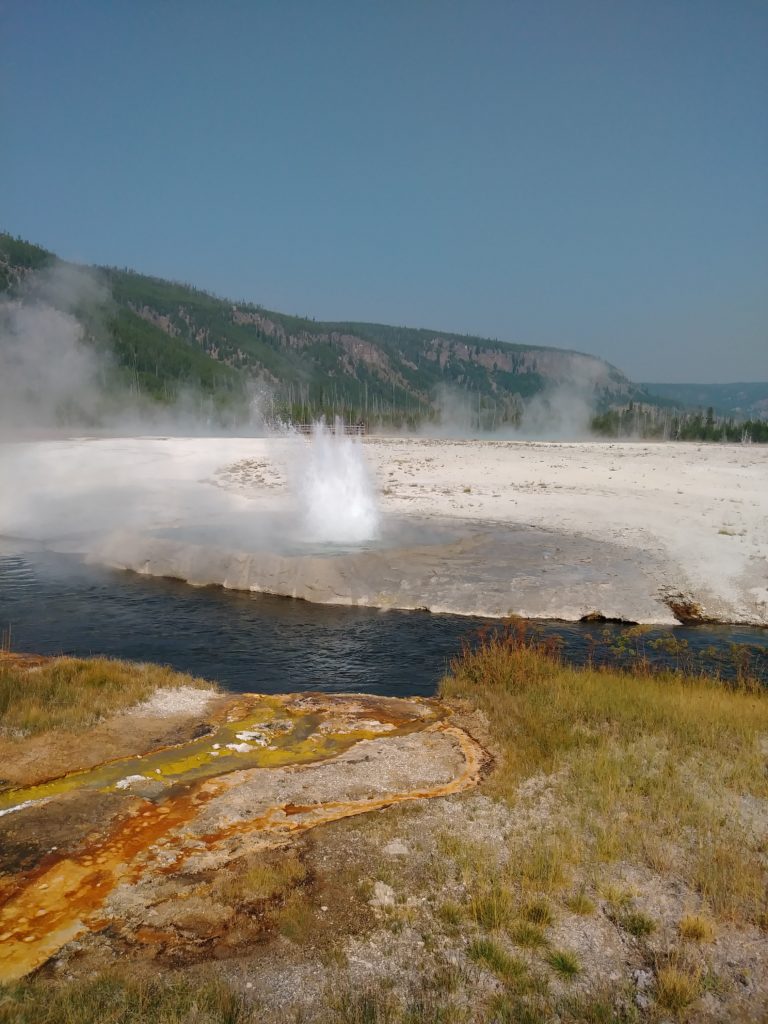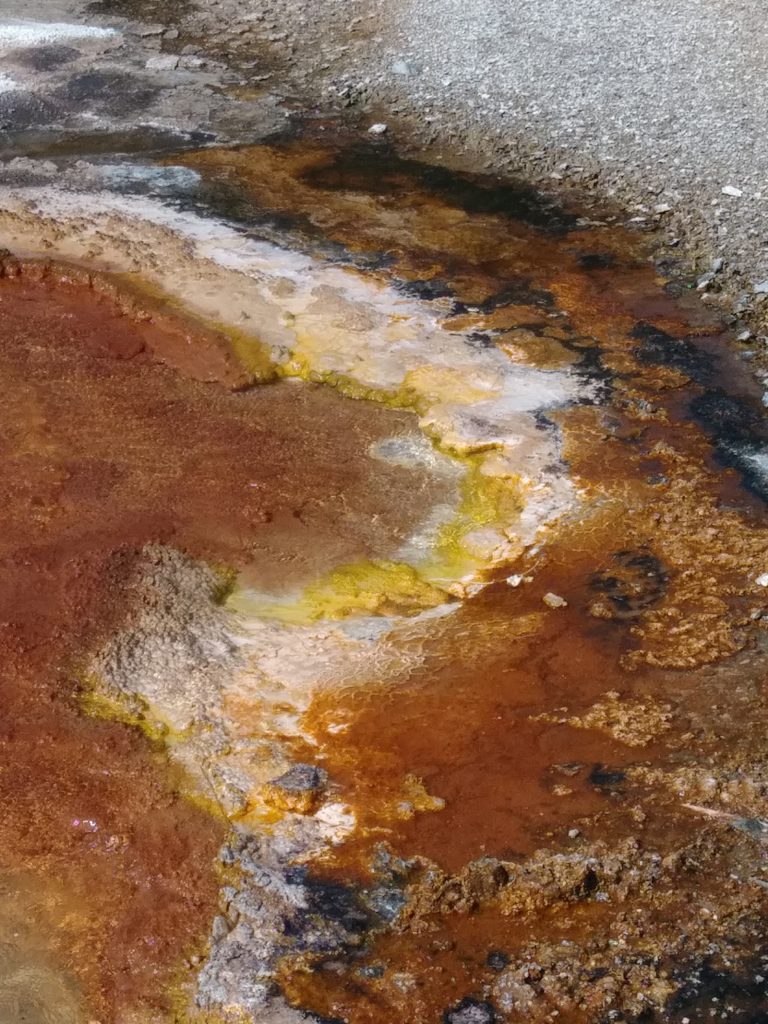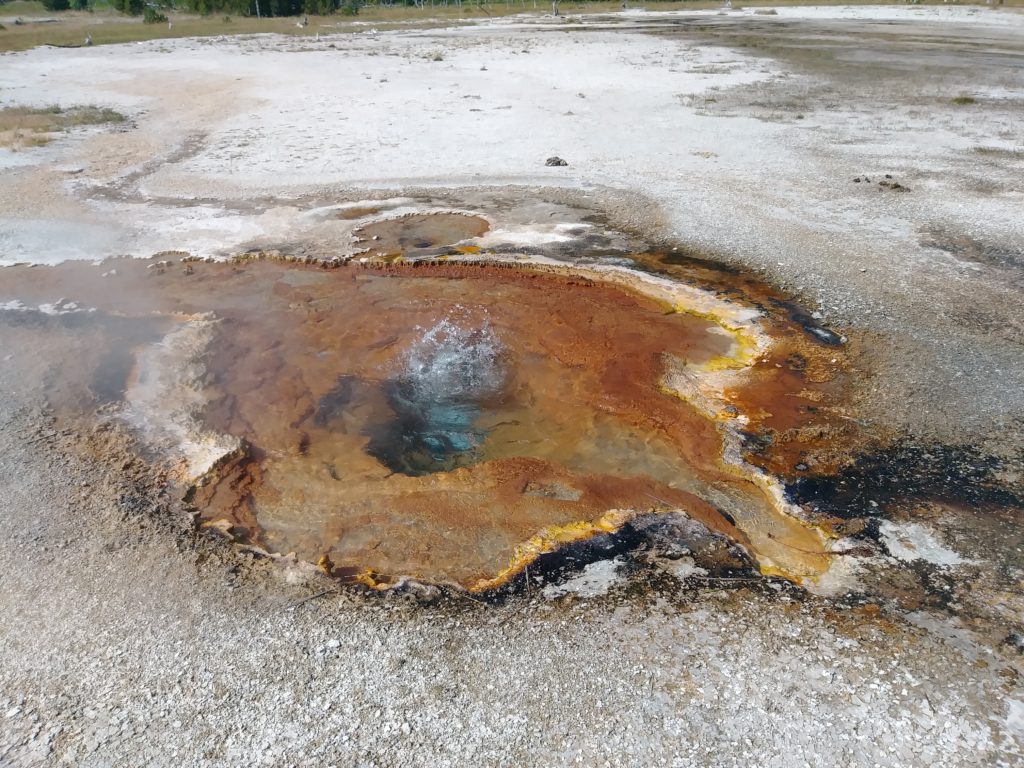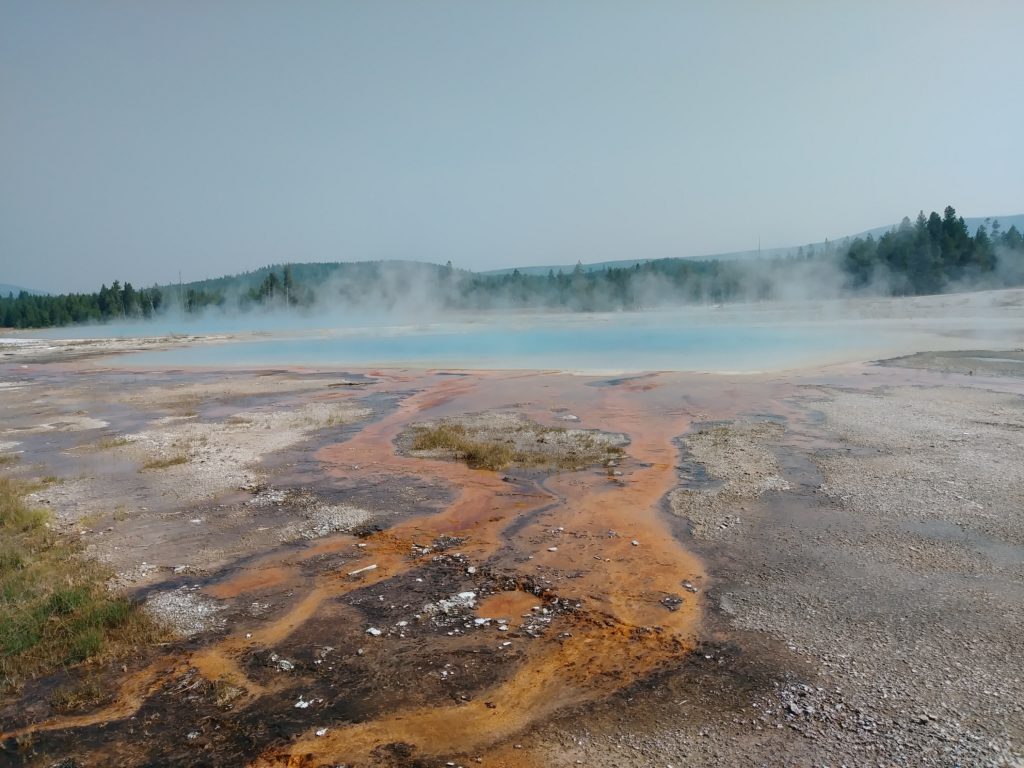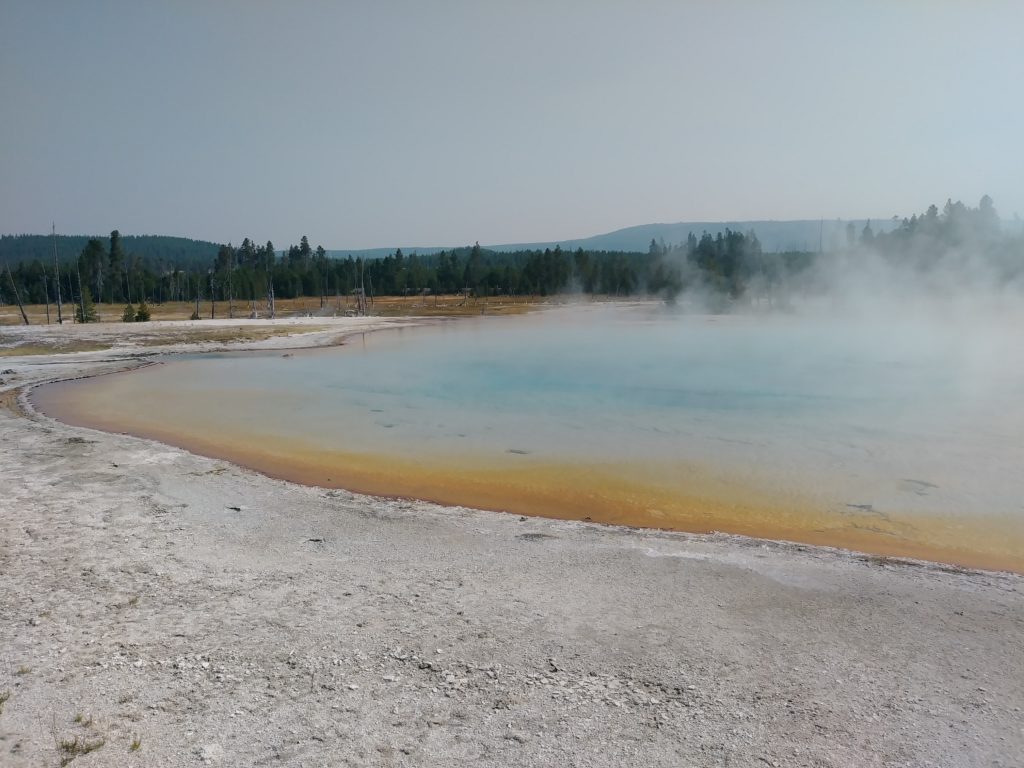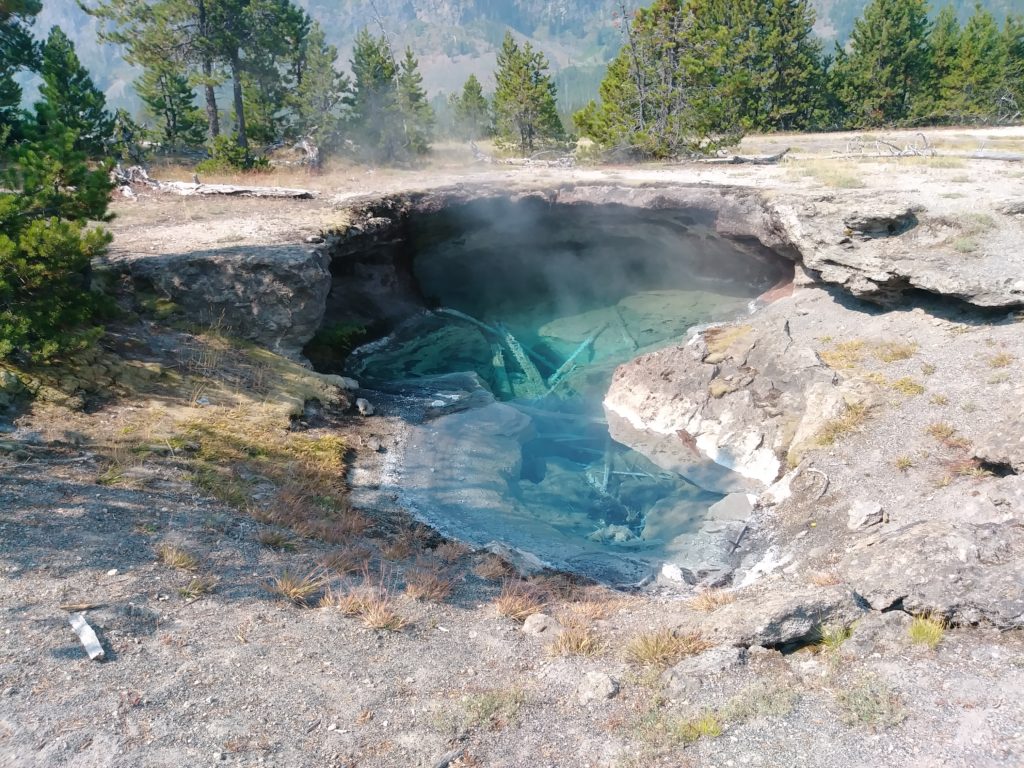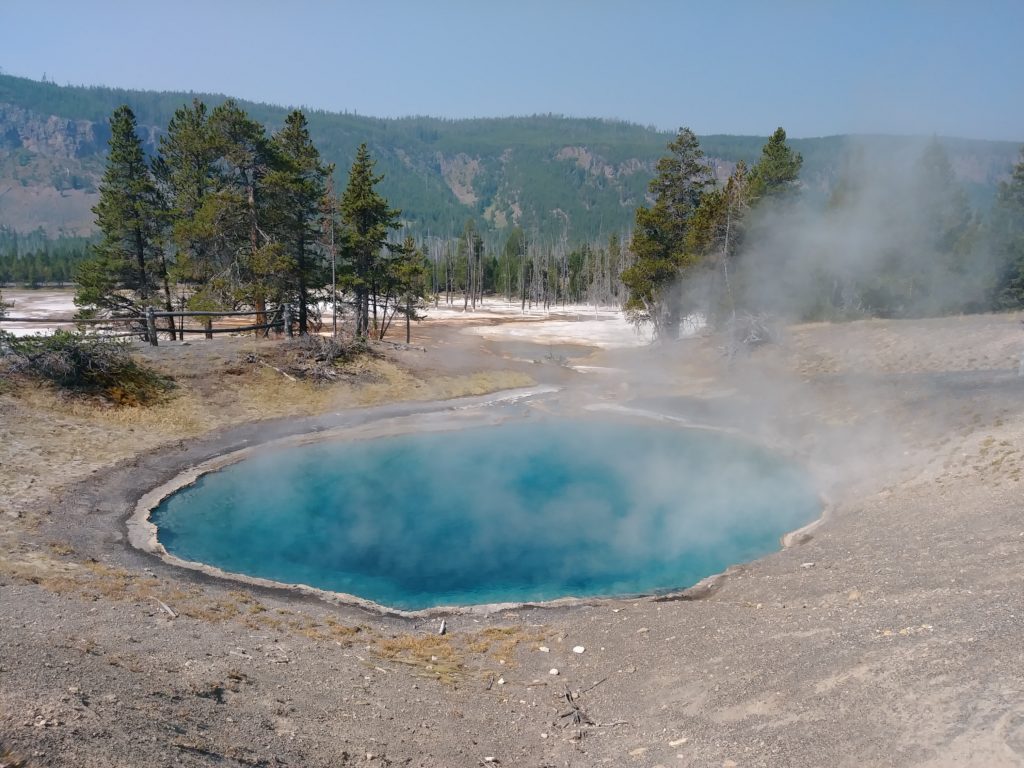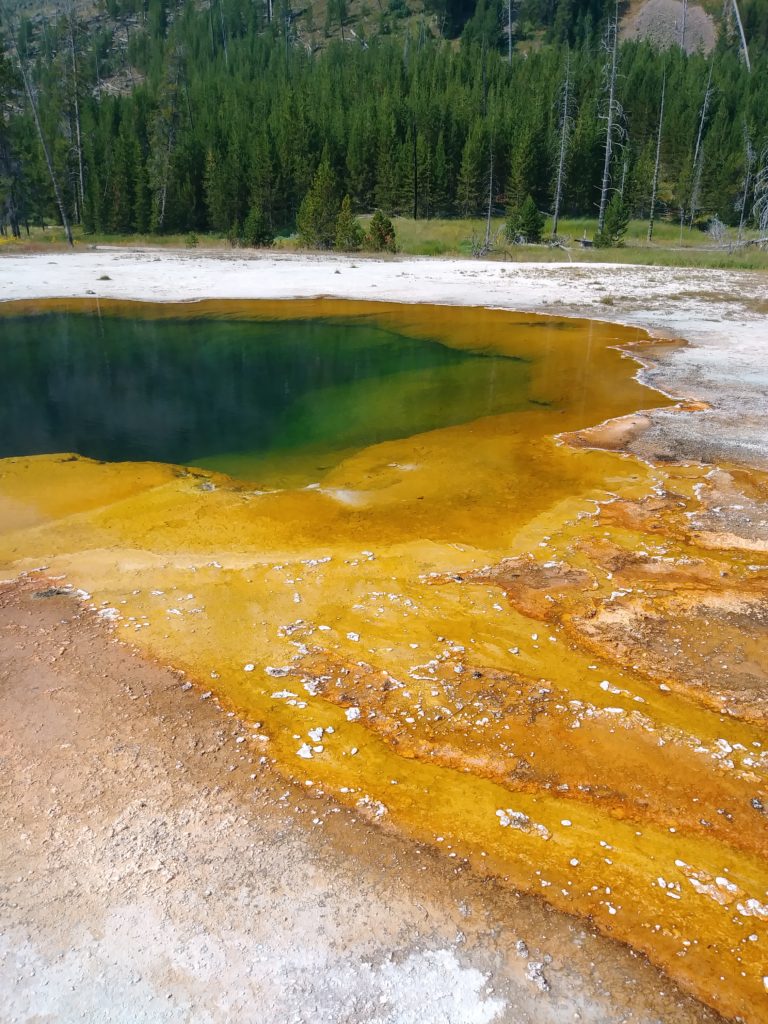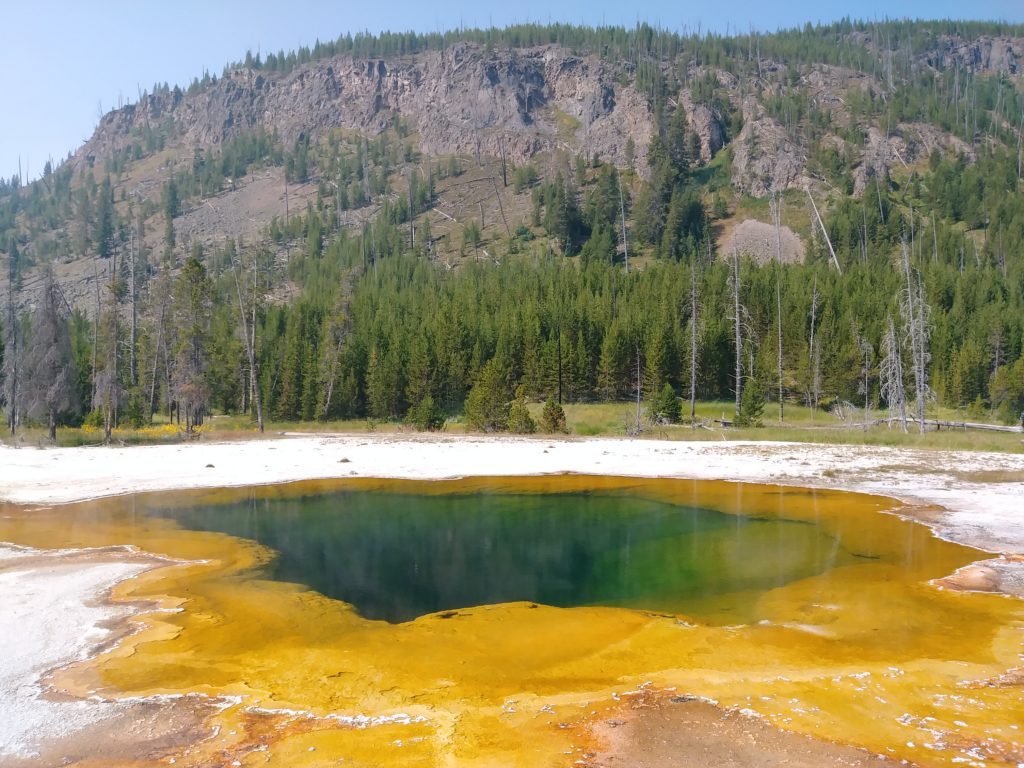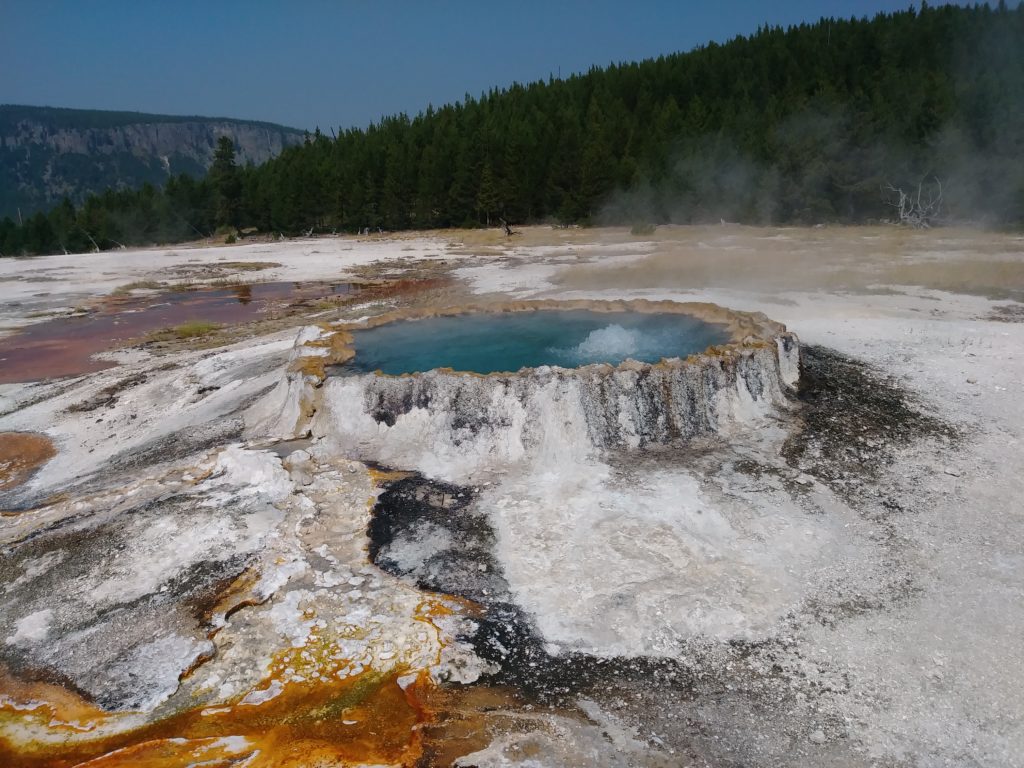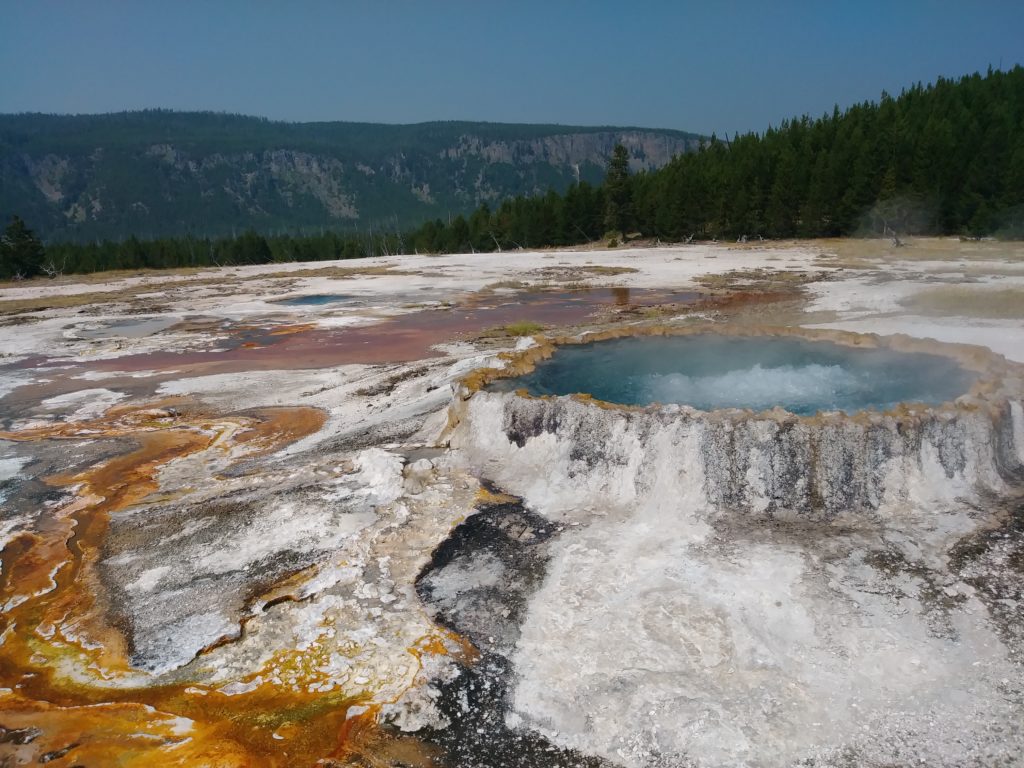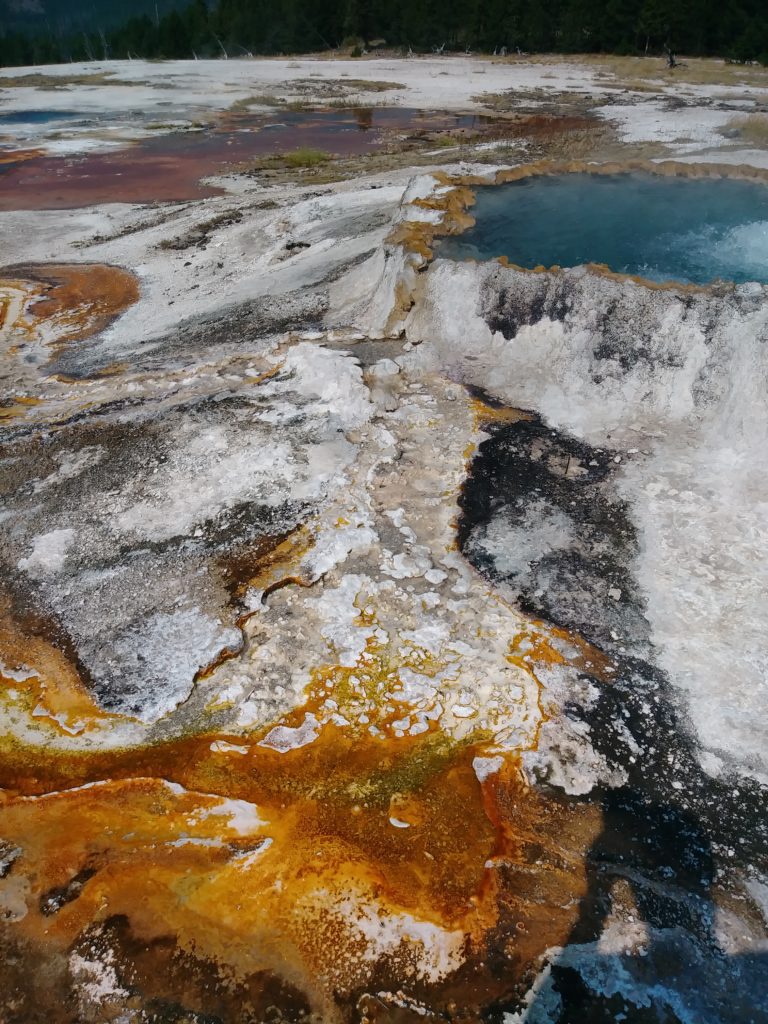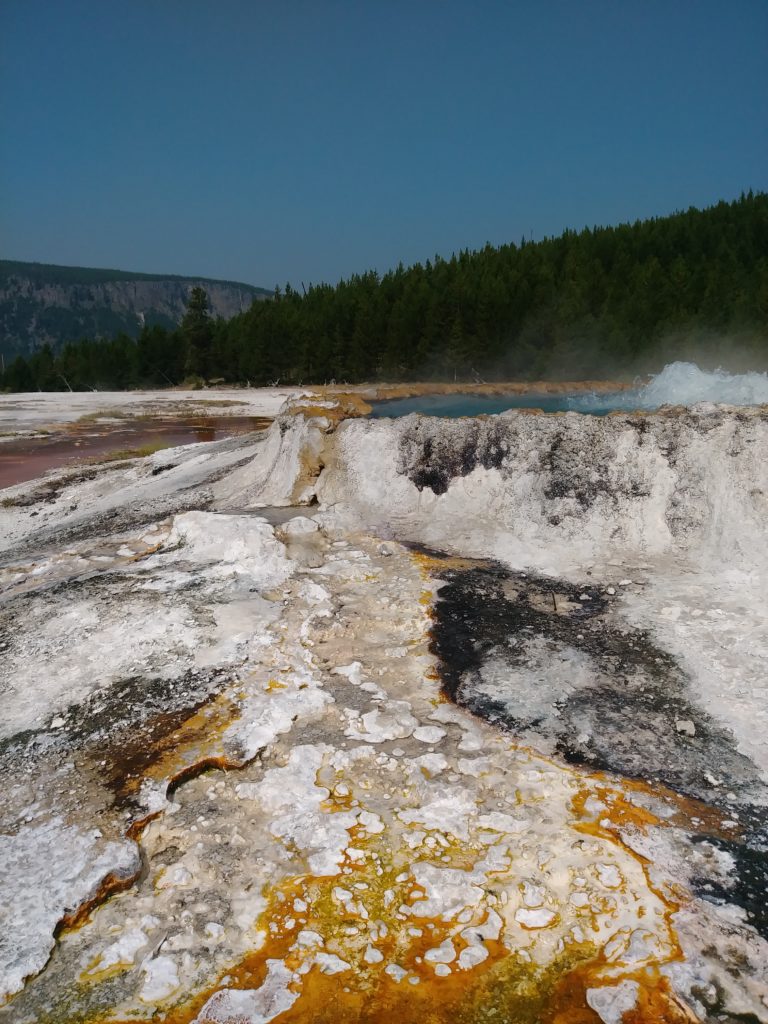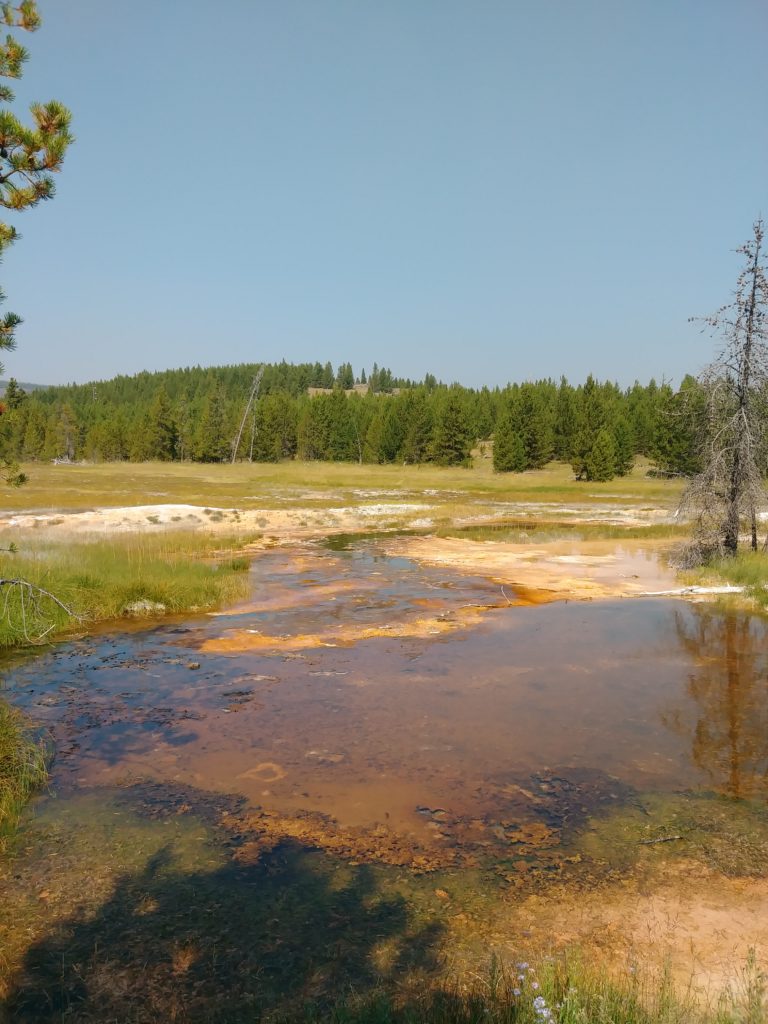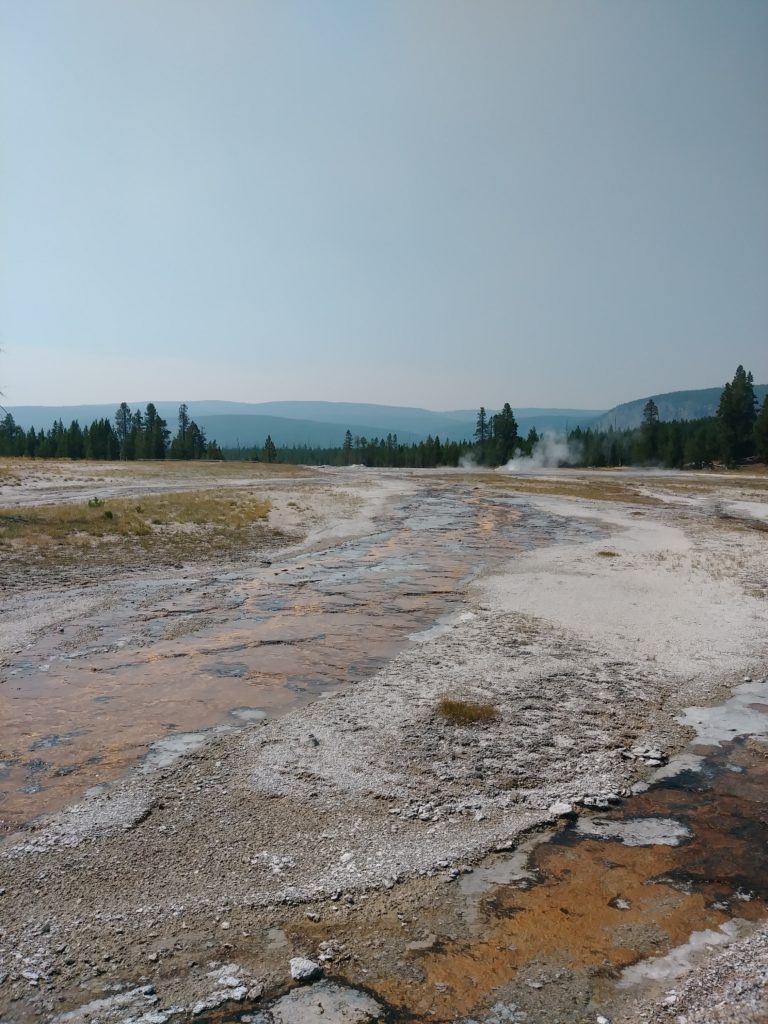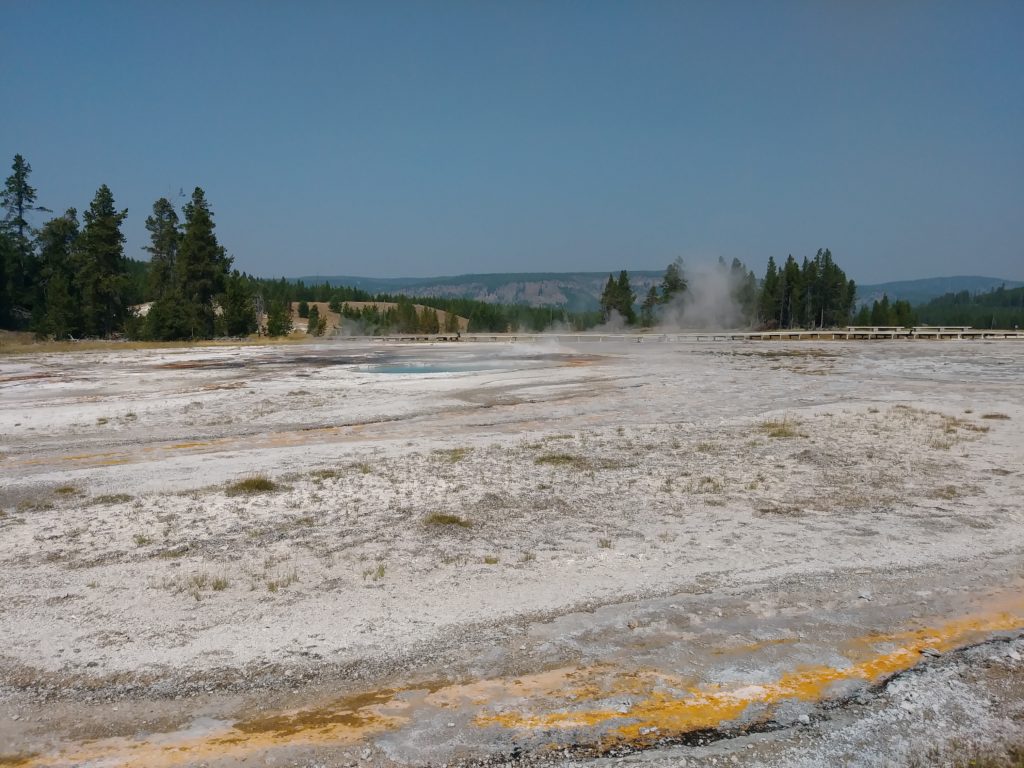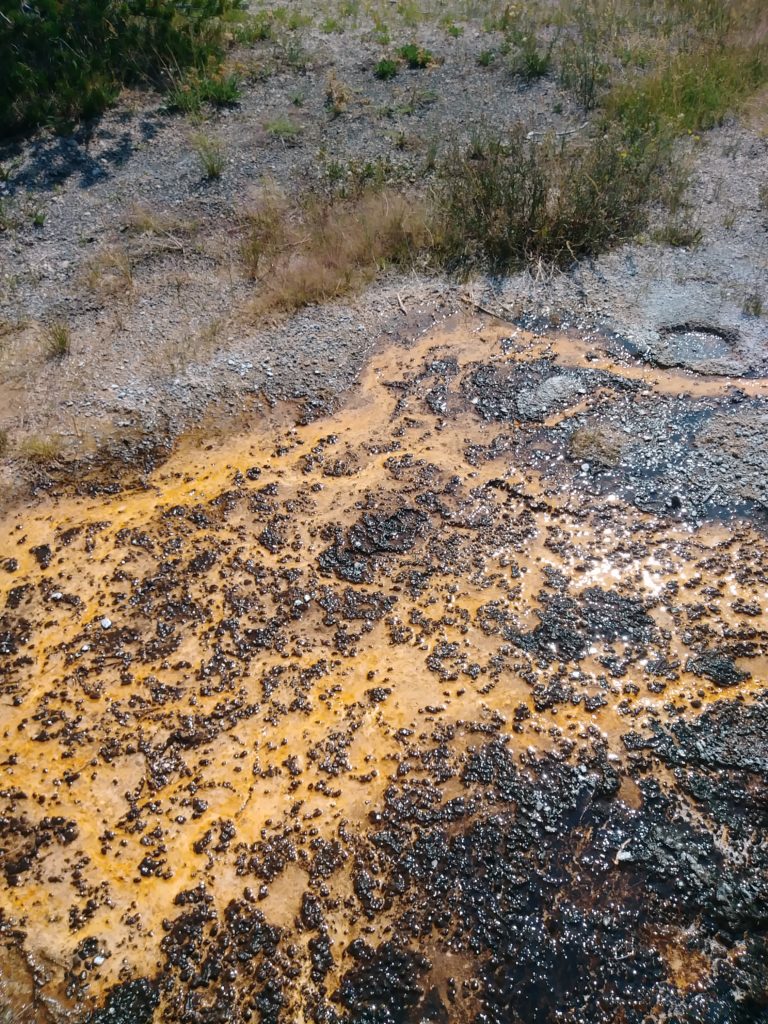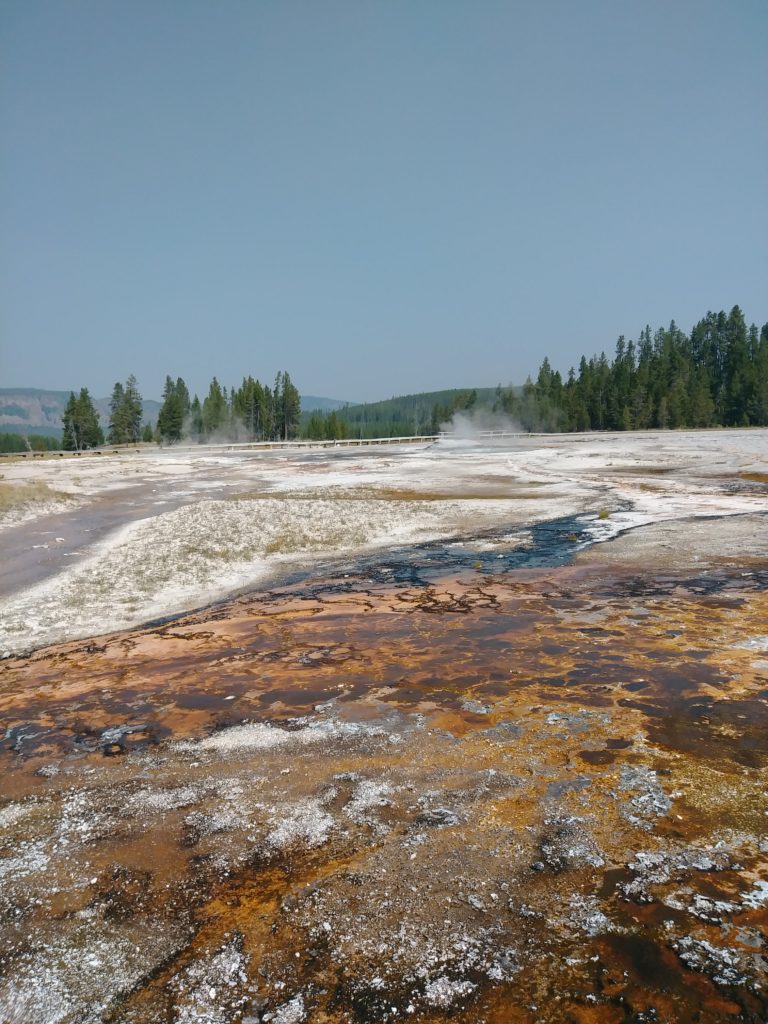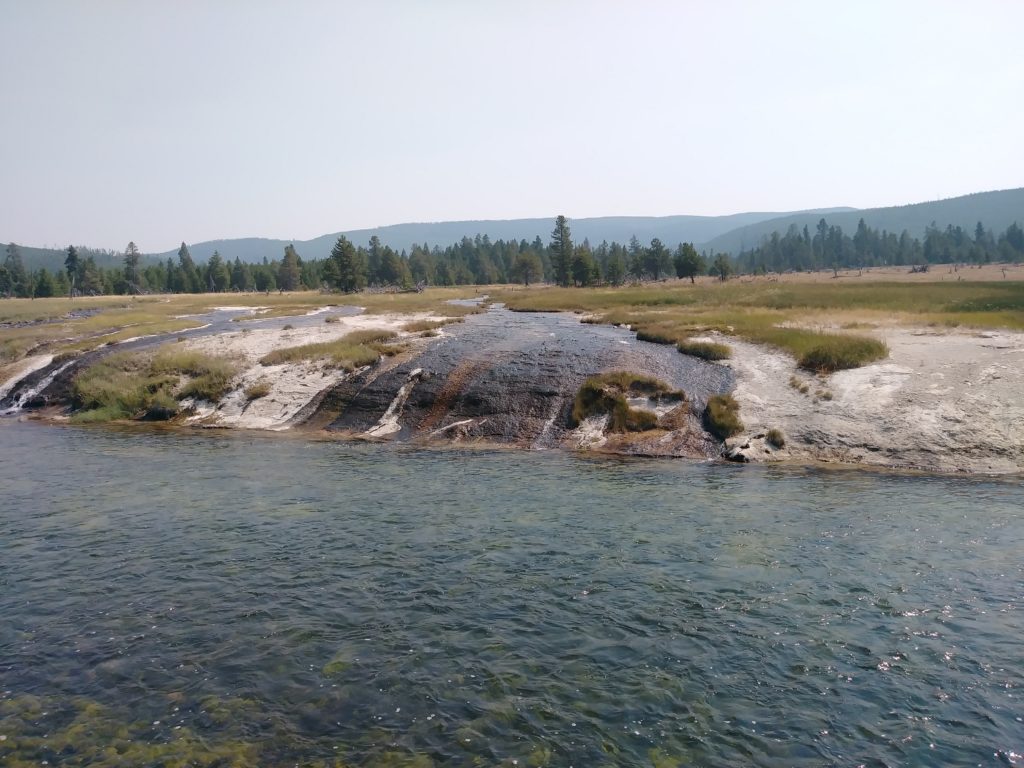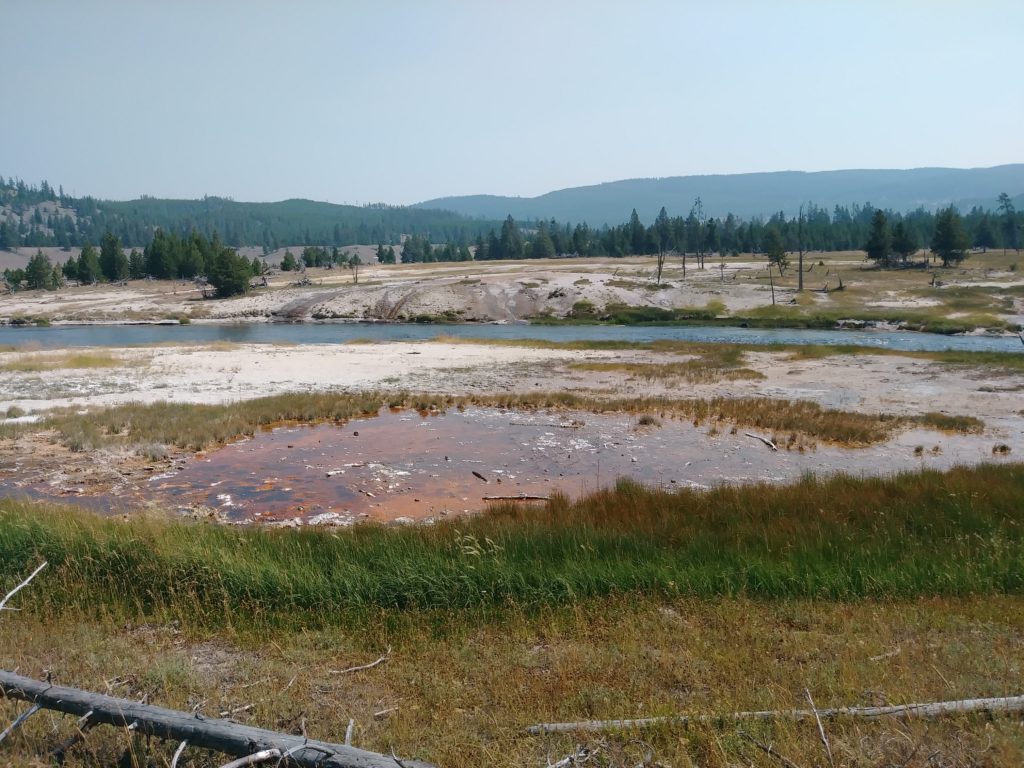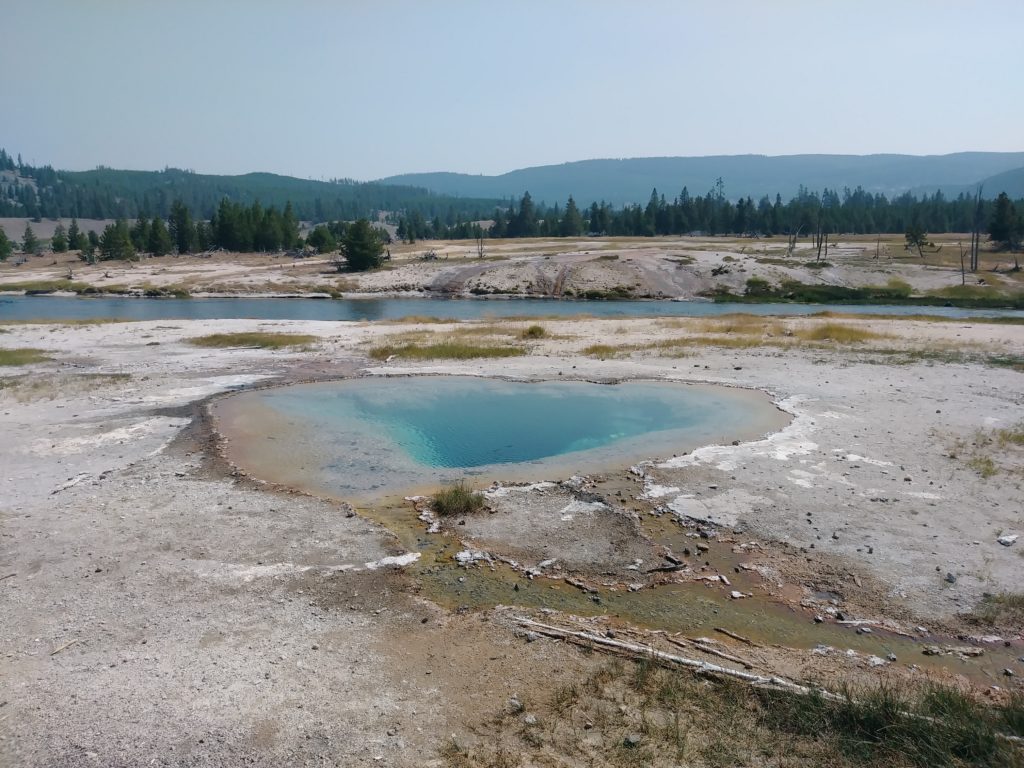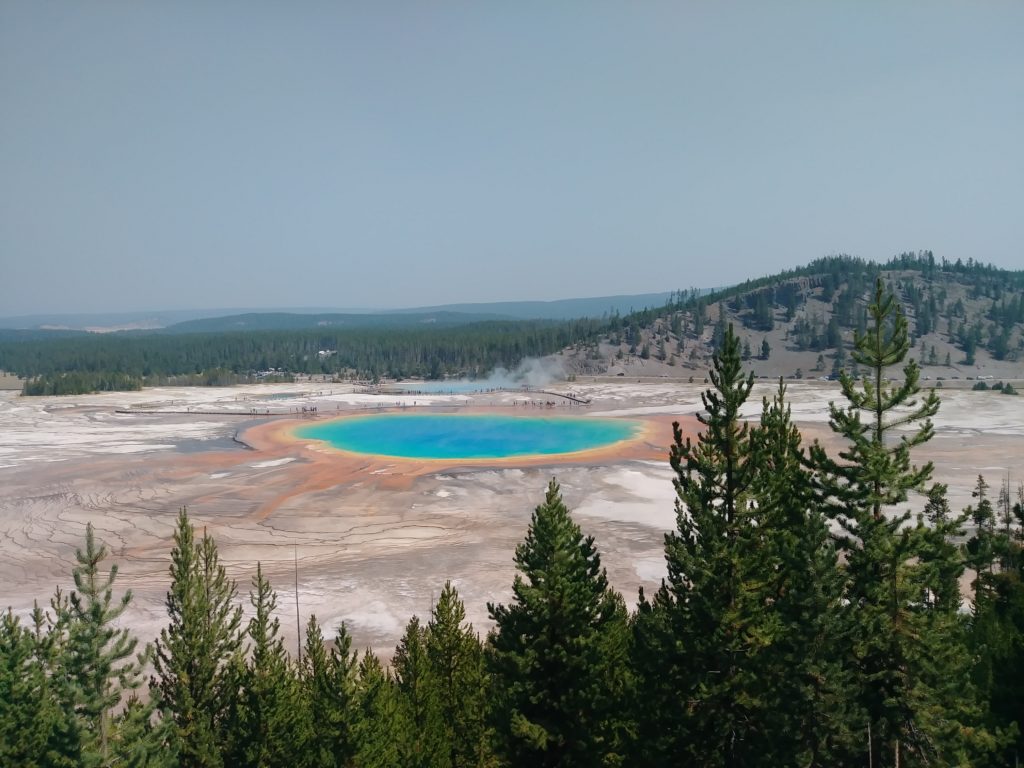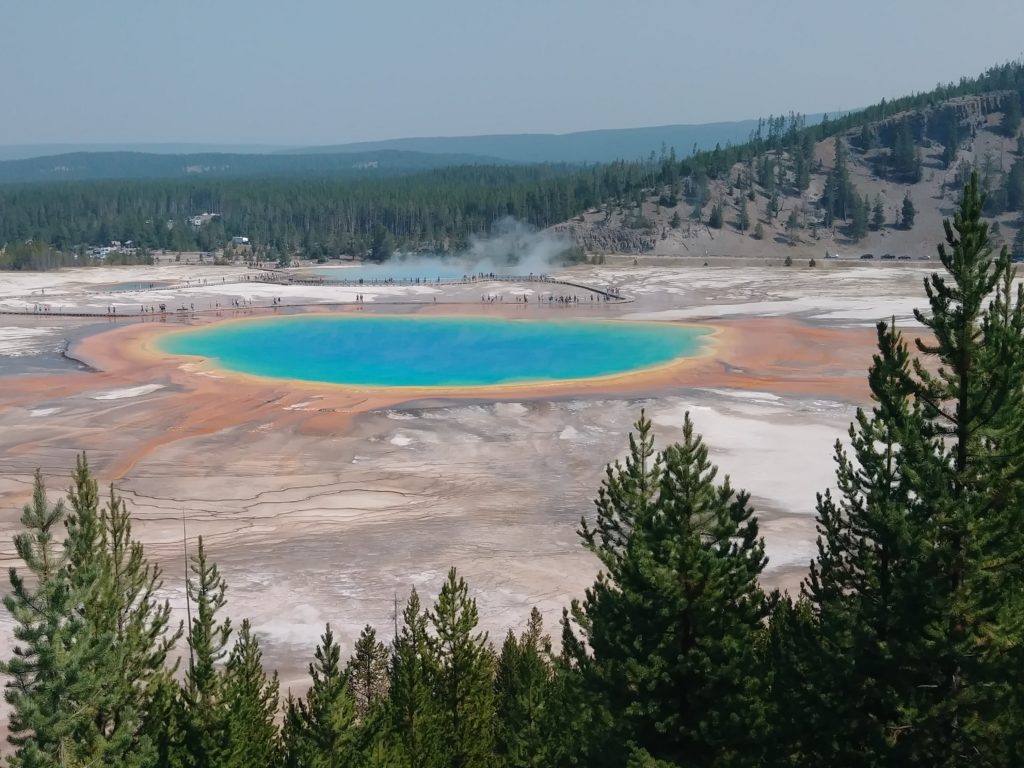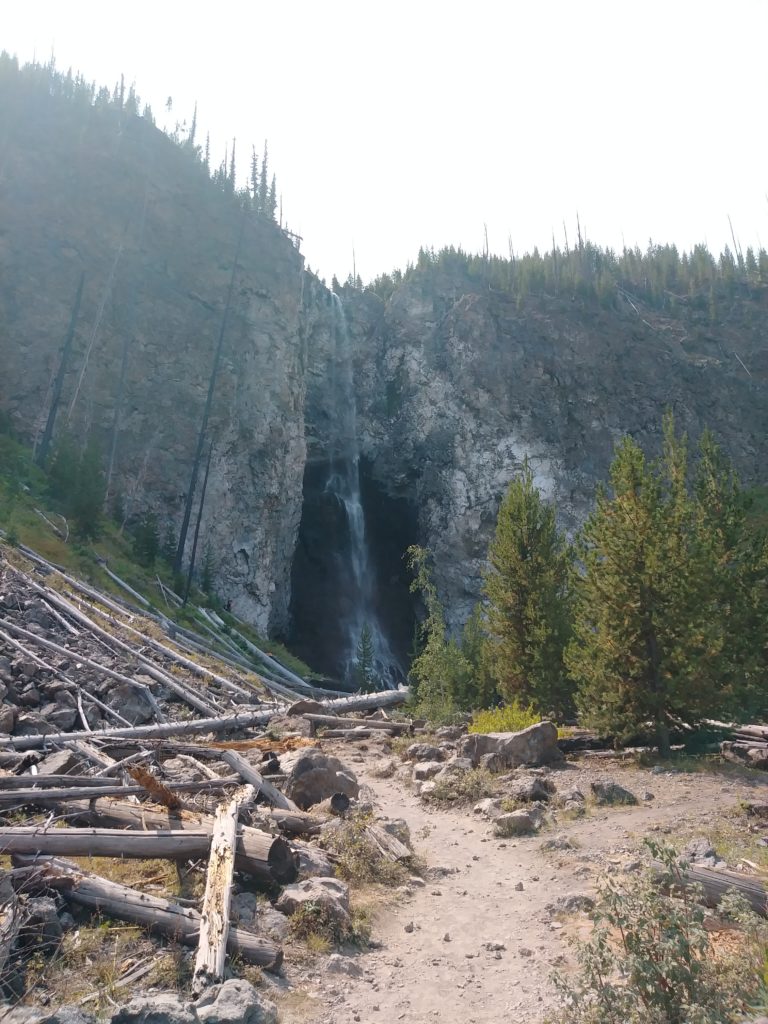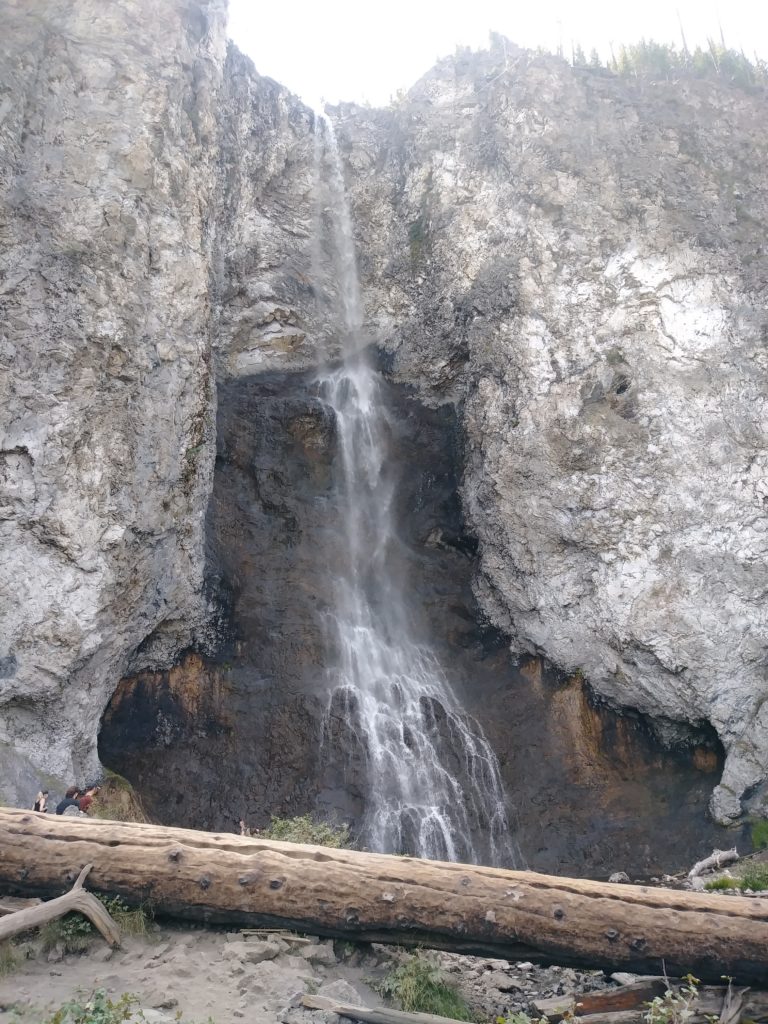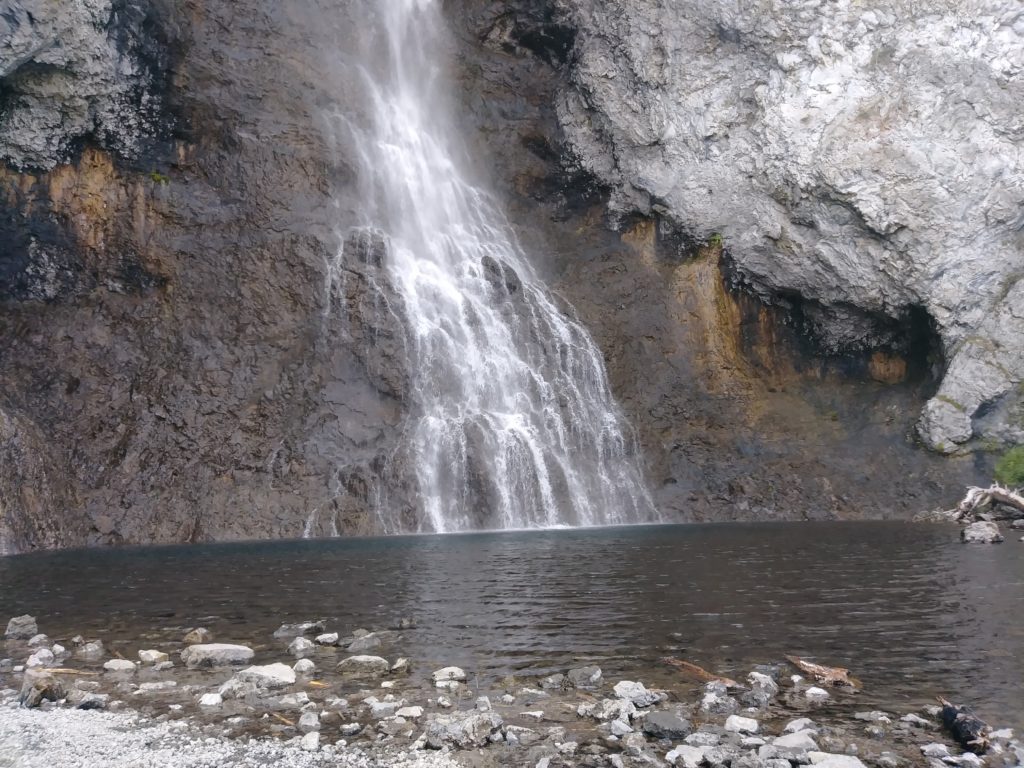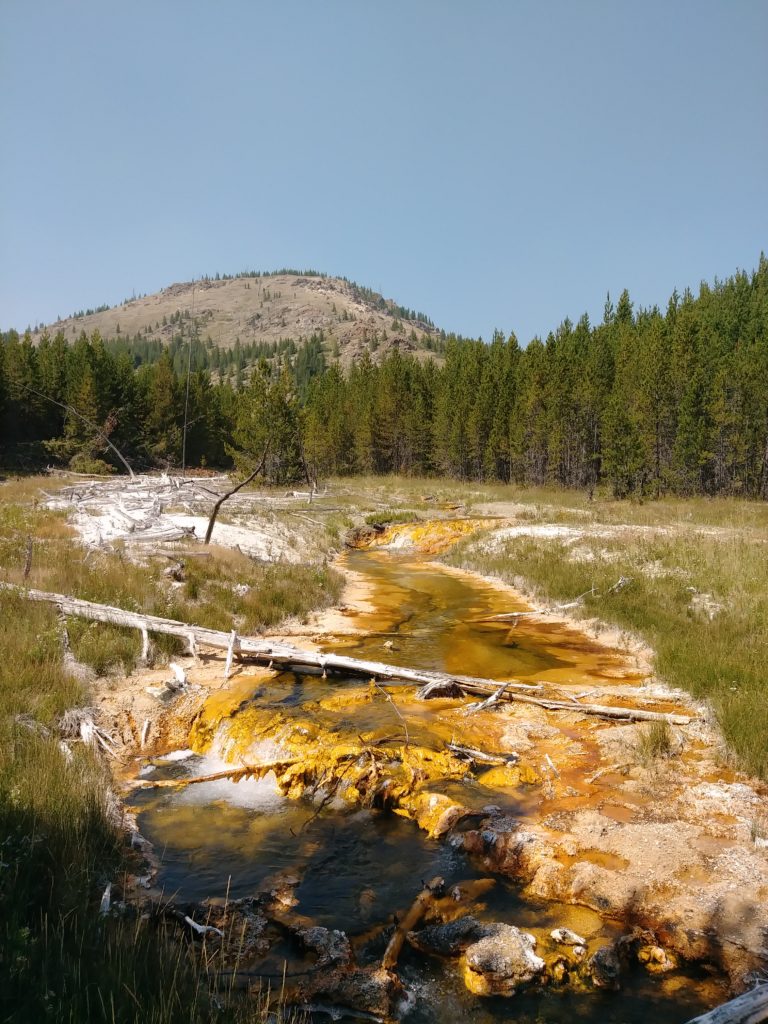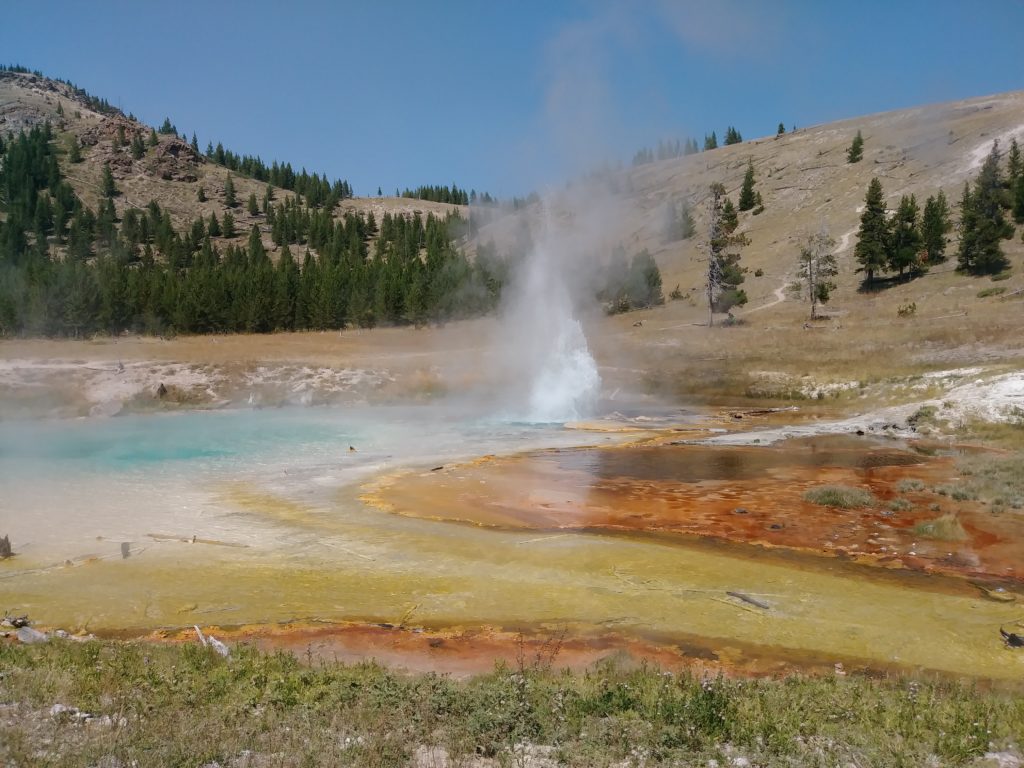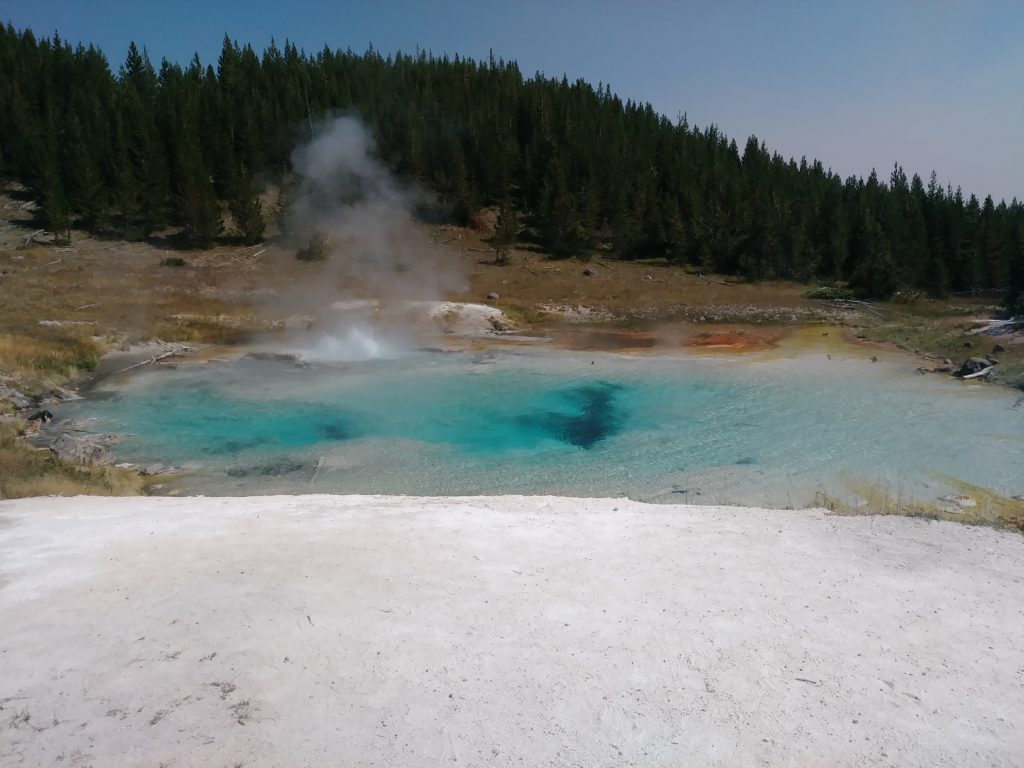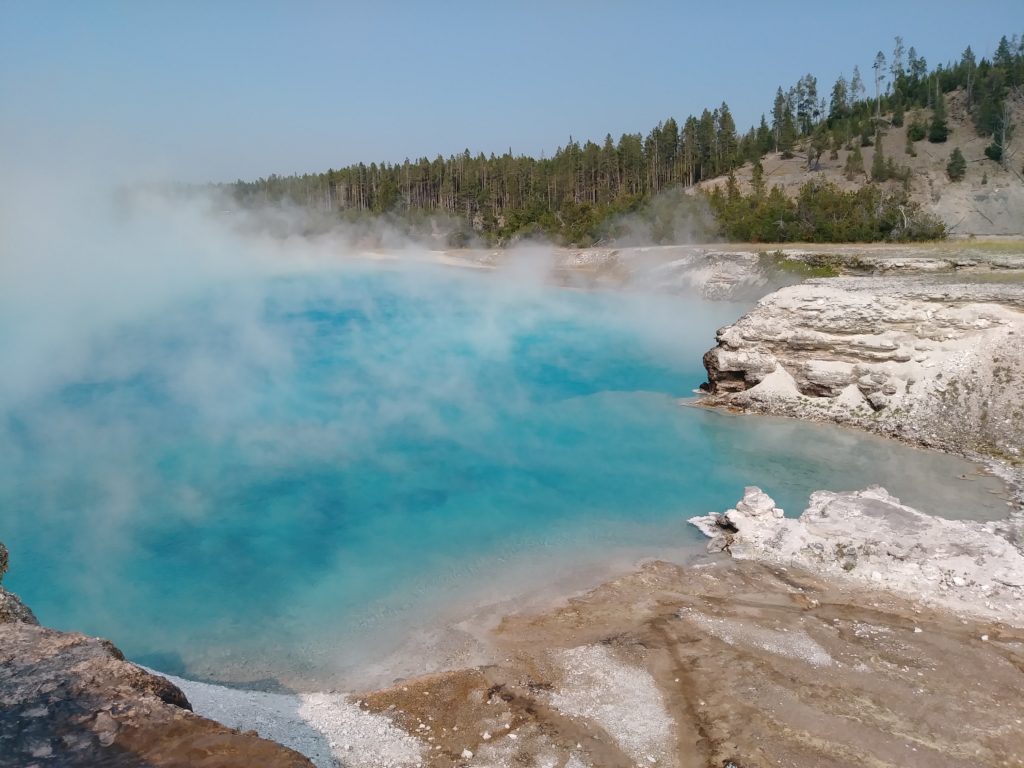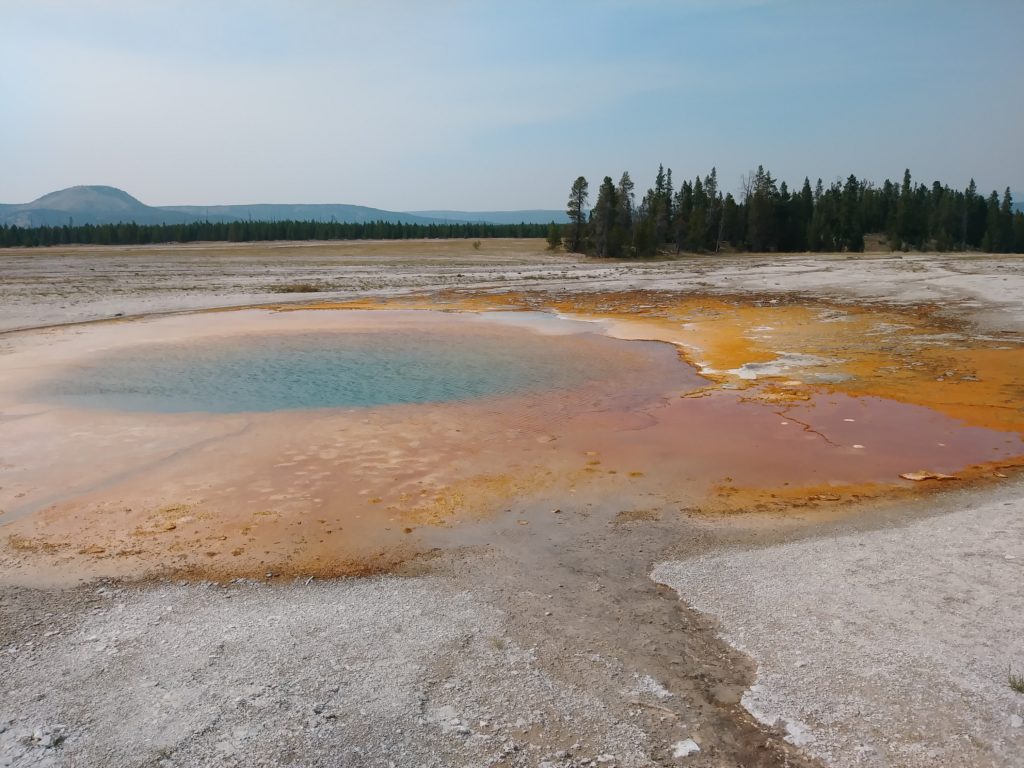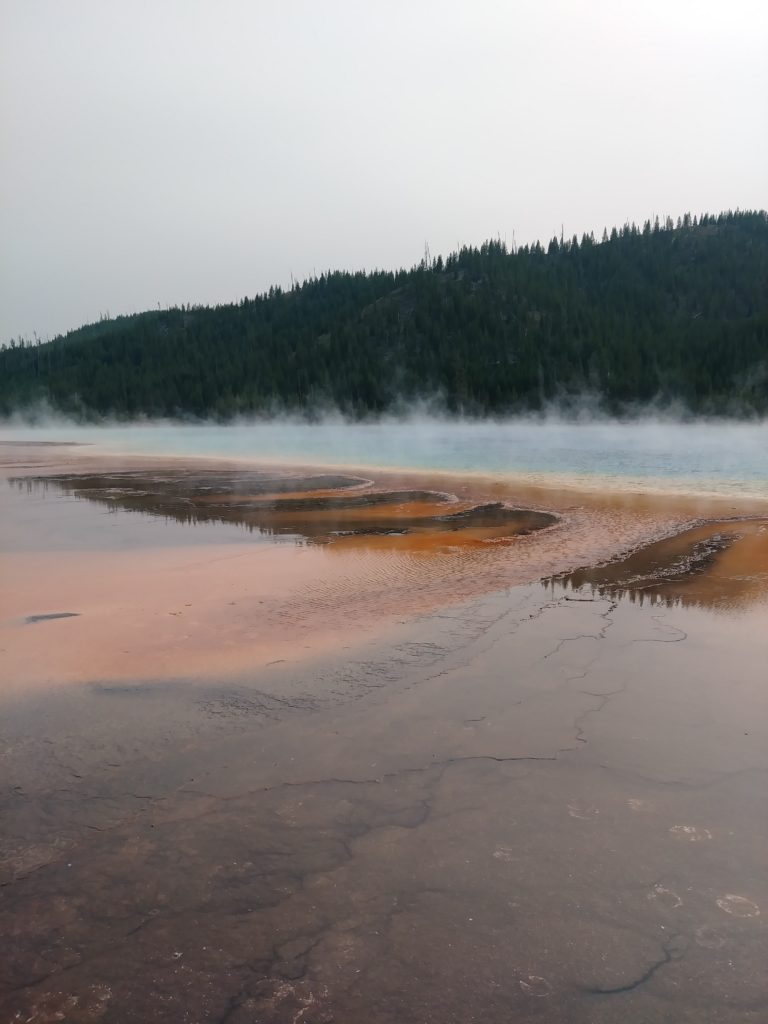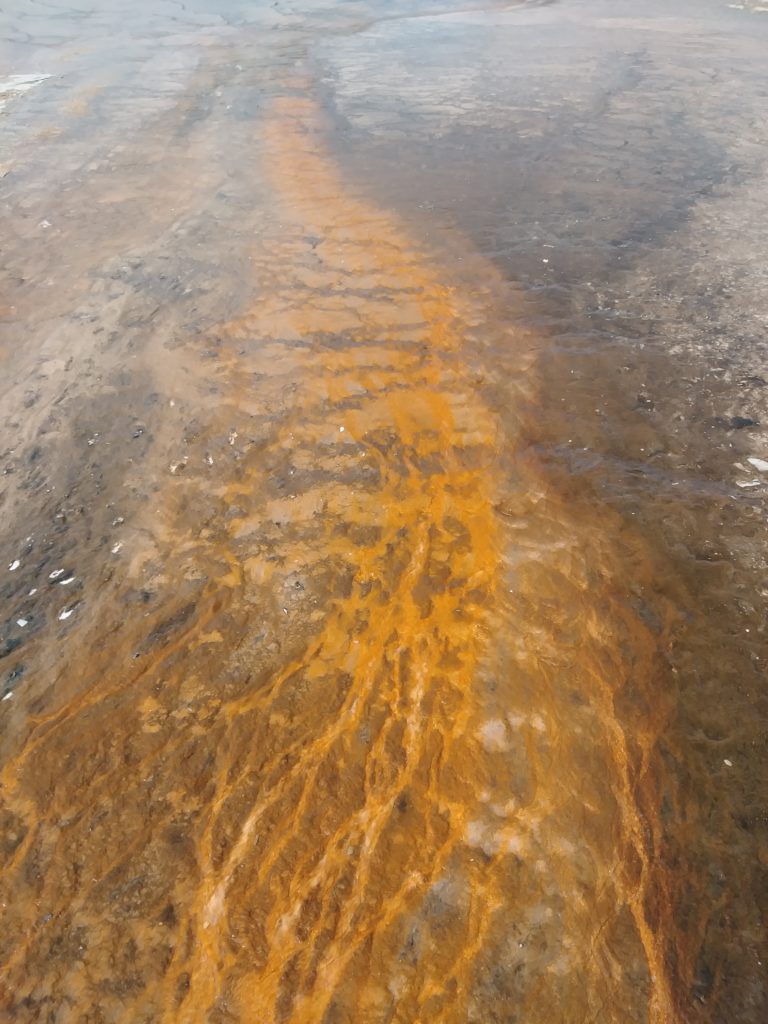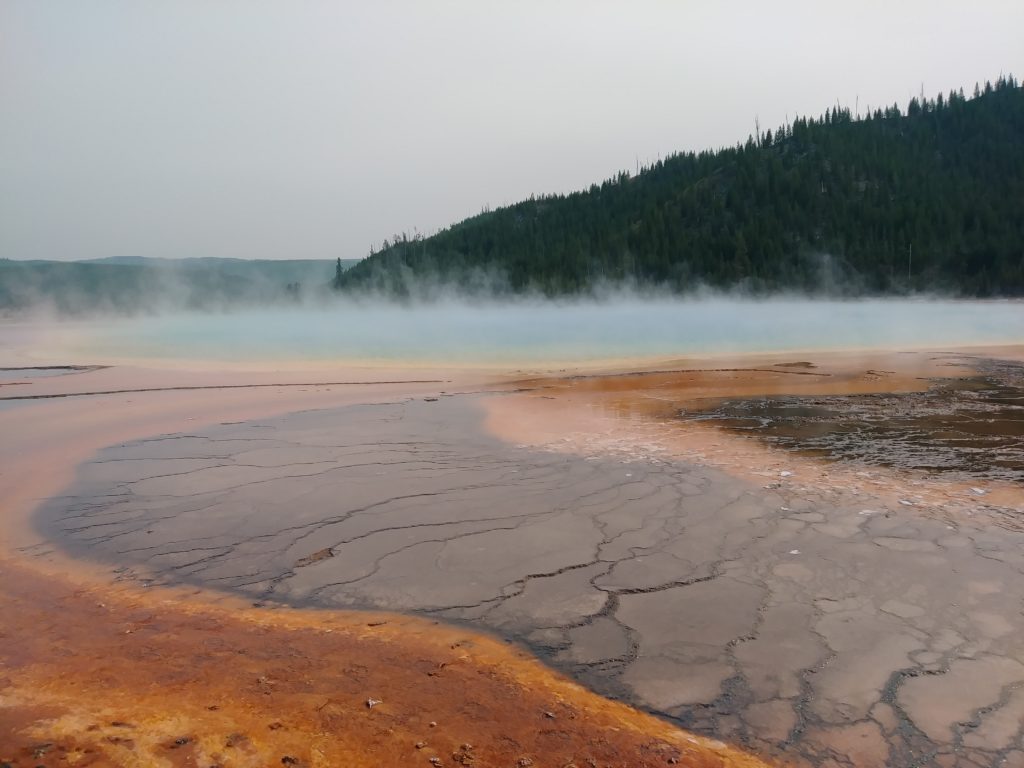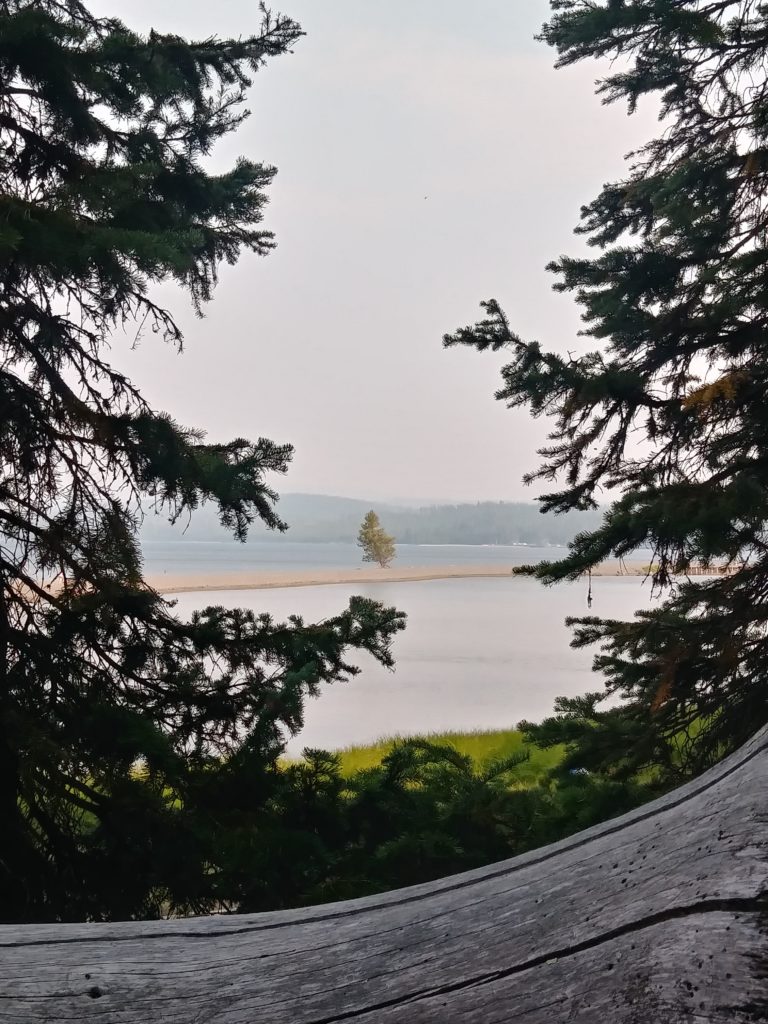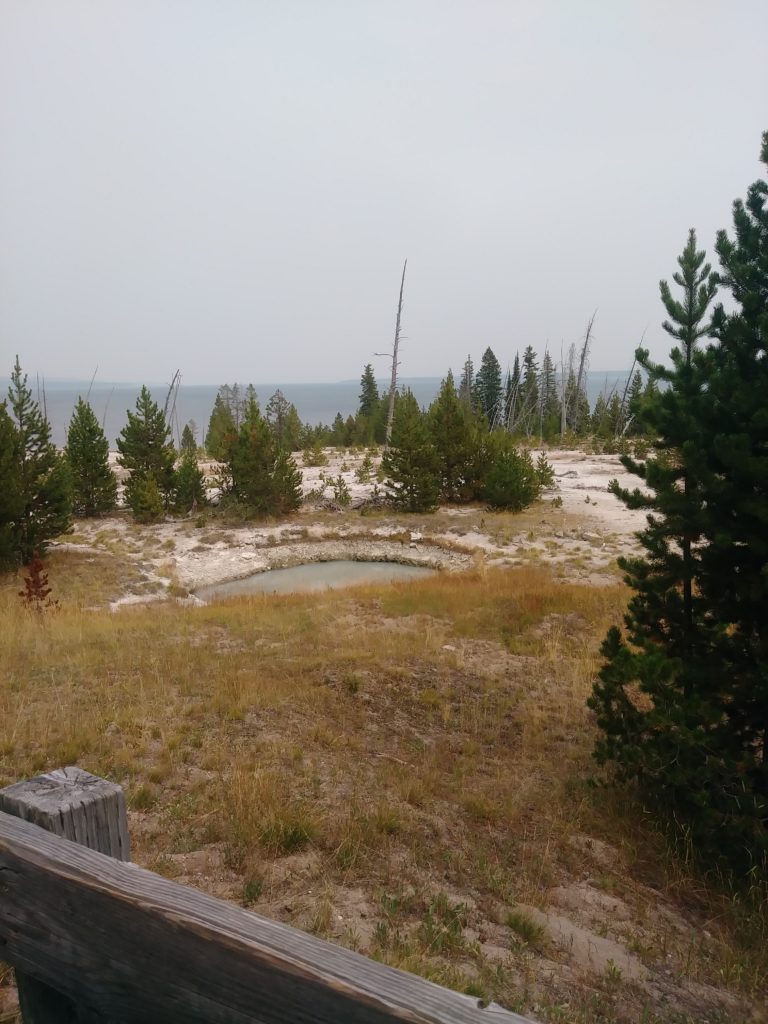Week 2, Base camp: Grant Village
Grant Village Campground isn’t quite as nice as Canyon, and the site I was originally assigned was a shitty site on the end of the loop by the road with no bearbox in sight (apparently there was one shared amongst 4 sites, clearly nowhere near mine) and an 8% grade on Parker’s parking spot.
I requested a reassignment, which I received.
I found it inexplicable that, on tent-only loops, there should often be only one small old bearbox for three or four sites. The management of the campgrounds is terribly insistent on locking up the slightest thing that might attract a bear- not just food, but all toiletries, scented items of any stripe, even water bottles. The rangers and camp hosts patrol the campground regularly throughout the day, confiscate anything left out, and leave behind $500 fines.
Don’t misunderstand. I support locking up the least thing that might bring a grizzly bear into the campground wholeheartedly, especially since Grant is in an area frequented by the bears. I just think it’s stupid to not provide sufficient bearboxes to do so. Leaving food in the bed of one’s truck is not a good option.
I shared a bearbox with one other site- half of it was enough room for my needs, but not enough for theirs.
Grant is a large campground, right on Yellowstone Lake. Its elevation is 7,800 feet. The road into the campground is a horrific disaster just now. Stretches of it and its bridges under major construction; there’s a temporary stoplight over a bridge (I cannot comprehend the reason for its being one-way), the duration of the signal being a minimum of two minutes.
Well.
Two minutes if you wait for it to turn green before you proceed, that is.
Sights on road to Grant
Just because I decamped to another part of the park doesn’t mean I didn’t have a long drive with many opportunities for sightseeing.
Yellowstone is gigantic.
My drive took me down into the caldera, past a great deal of interesting things. I stopped at them until I ran out of time.
I stopped at a random turnoff (well, I drove by it, saw something that looked cool through the trees, and executed a rather inadvisable U-turn), and there was this gorgeous, unlabeled, not-on-any-map hot spring feeding into Gibbon River, near the Gibbon Meadow picnic area.
I climbed down to it and admired it.
Artists Paintpots was a short, easy hike, some of it paved and highly accessible. Very pretty and not terribly smelly (although, again, it was a breezy day, which I suspect helped). Anyways, the nice part about this is you can admire the features on their level, as well as take an easy walk up above and look down on them.
Blood Geyser is not actually belching out the blood of innocents, or of the condemned enduring everlasting torment in Tartarus.
Of course not! That’d be silly!
If you insist on a mundane explanation, there is a high concentration of iron oxide in its water. This precipitates out, producing the red marks visible around the geyser.
Suuuuuuuuurrrrrrrrrrreeeee.
People will believe anything.
Beryl Springs is just right there by the road, sitting at a turnoff. The water is a pretty color; it’s one of the hottest springs in Yellowstone, measuring between 188.5 and 192°F. The water is quite violently agitated due to volcanic gases, mostly steam.
The part of the loop I was driving followed Gibbon River for quite a ways. I pulled off at Gibbon Falls, which were well worth the stop. As well as getting a nice gander at the falls, one commands a good view of the caldera from this point. (The caldera being the insides of the supervolcano’s collapsed magma chamber; it is the area with Old Faithful and a high concentration of other geothermal features, left over from said supervolcano.)
Gibbon Falls currently has an 84 foot drop.
I saw a ground squirrel pop out of the earth there. The body of the thing is sort of alarmingly long, and you wonder just exactly how much critter is going to emerge from that hole, the chief concern being it might be extremely long indeed, like a furry snake.
Ew.
It wasn’t so bad once it emerged.
Fountain Flat Drive was a short loop, but there were good scenic views as the river wound across the meadow, and a surprise hot pool.
The real star of that day’s explorations was the Lower Geyser Basin. You’re on a flat, grassy floor and can see for a long ways as you drive towards it. Fountain Geyser (and Spasm Geyser, much smaller) was going off, so I saw these plumes of steam rising up, from a white strip from a ways off. Intriguing pools and springs and mudpot in this geyser basin.
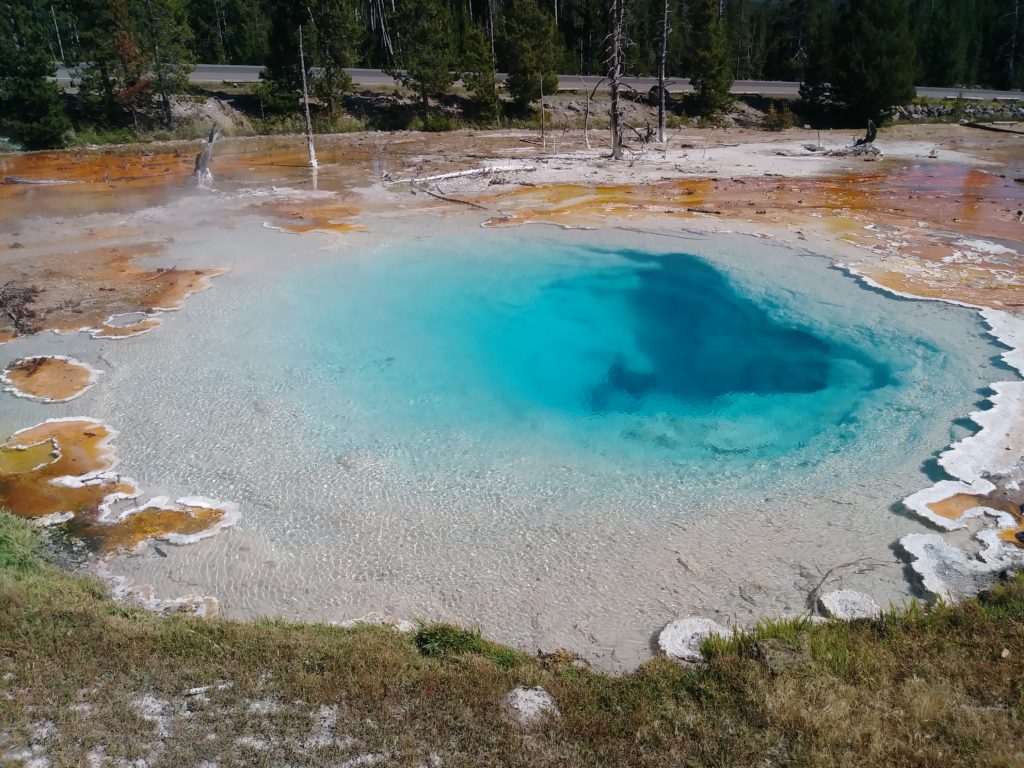
Silex Spring 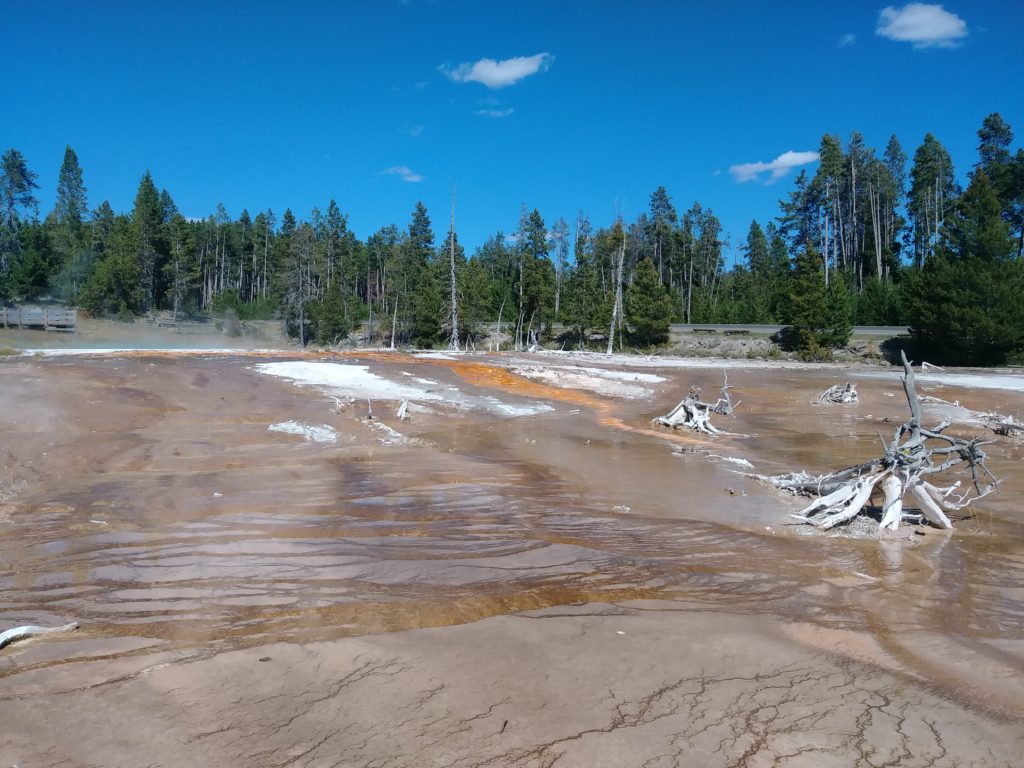
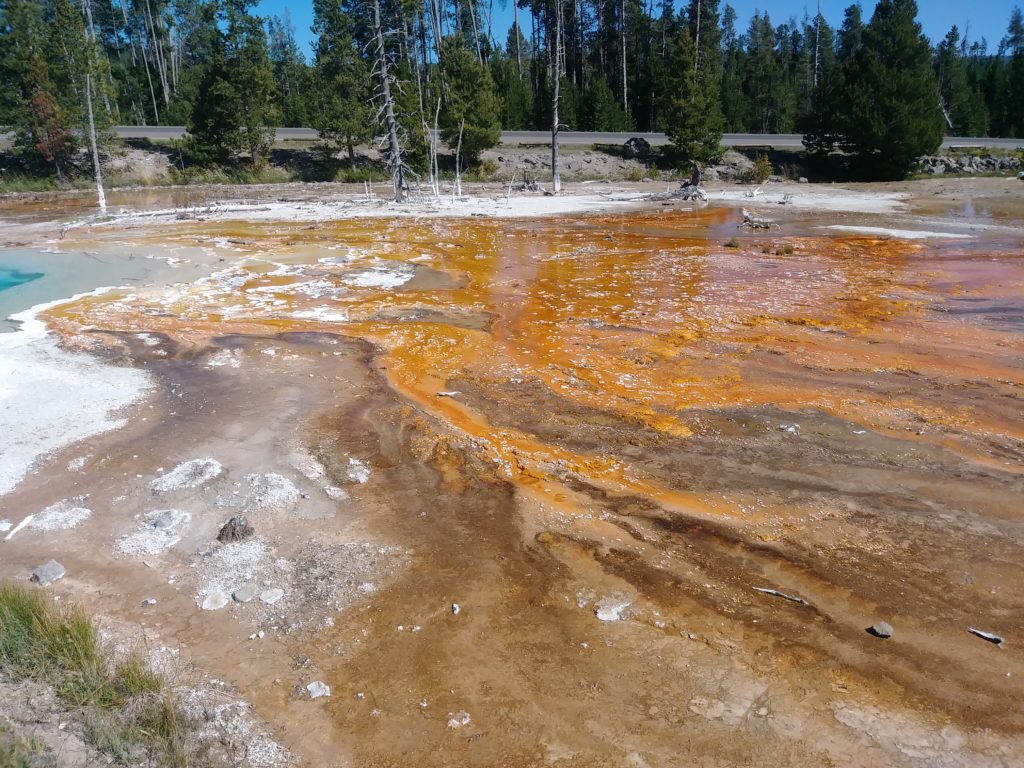
bacteria mat in runoff from Silex Spring
Red Spouter is an interesting phenomenon. It has only existed since an earthquake in 1959, and over the course of a year, it morphs between three different kinds of hydrothermal features, depending on how much water is available. It’s a hot spring in the spring, due to snow melts; it’s a mudpot in late summer, a simmering pot of gurgling mud; then, it’s fumarole in the fall, when it’s nearly dry and just hissing out steam.
The awesome part was Fountain Geyser, which is very visually appealing. Very tall plumes, cool mineral formations, not terribly smelly. Some things in the Lower Basin- inactive geysers? steam vents?- sounded like running washers, some like the forges of hell, clinking and clanging and hissing away. Some just bubbling and hissing, even though could see nothing happening. Eery.
I concentrated on seeing as many of the geothermal sights as I can- I can see trees, lakes, rivers, and mountains almost anywhere, but the visible signs of a Hellmouth? Not so much. Felt like a great lead up to Lucifer Season 5!
Obviously, I ran out of time that day before I could see everything that interested me on this stretch- I drove by Old Faithful, as well as a number of other things I wanted to check out: Fairy, Biscuit, Daisy; Black Sand.
Drove over the Continental Divide, twice- a bit excessive for one road, no?
Miscellaneous notes
About this time in my trip, I had to dig out a belt- not a single pair of jeans or shorts or anything would stay up anymore. I suppose that’s what happens when one runs and hikes over 40 miles a week… and is forced to eat what one cooks over a campstove.
Also about this point in my trip, the overnight temperatures dropped by a good ten degrees- 30°F, then 34°F and 39°F. Although briefly unpleasant, this had the happy result of making the following nights, which remained in the 40s, seem comparatively tropical.
I’d gone for two weeks without a shower by that point. The thing is, despite this, my skin dried out- it’s so dry in Yellowstone. Bag Balm is miraculous for chapped and dry skin. Great for blisters, too.
Come to think of it, though, what with how inconveniently the showers are located in the campgrounds in Yellowstone, especially in Grant, it was almost just as well that they were closed. The inconvenience of getting to them, plus paying for them once there- I think it was almost better to suffer and gain the discount on the nightly rate.
Stargazing on the lakeshore
Well. During the daylight, I scouted the paths down to Yellowstone Lake from the campground, and where the broader sandy strips of shore were located.
The nights were quiet at Canyon Campground- not at Grant. All manner of queer animal noises filled the nights there, including the wolves howling holy hell. Leaving the campground on my own in the dark was probably as gleefully reckless a venture as I have undertaken on this trip. This did not deter me from stargazing. I betook myself down to the lake, well armed with my knife, bearspray, flashlight, and lack of common sense.
I have a famously good sense of direction, and I got there and back without incident. This was one of those 30° nights. I wore every single one of my warm layers, which, fortunately, were enough while I was standing about on the shore.
On the shore- it was breathtaking, worth whatever risk it actually was that I ran going down there. The stars are so bright in Yellowstone- basically no light pollution, so one can see the stars clearly all the way down to the horizon. The night sky never looked so big before to me. The lake reflected all the stars back; the heavens were both above and below me- probably the closest I will ever come to experiencing what it’s like being in deep space.
The trees at my back did block a good portion of the western sky- I rather regretted not having a canoe or kayak to take me out on the water, so that I could be surrounded in every possible direction by the stars… but then, there was so much to see that any more would have been overwhelming.
The stars were bright enough that I picked out Delphinus (the Dolphin) for the first time. It’s rather small, but with a unique shape.
Avalanche Peak
I don’t precisely always plan out my life much.
So, I went for a run as usual the morning I hiked up Avalanche Peak.
I suppose there’s some merit in planning ahead. I might have noted that I’d be climbing 2,100 feet over just two miles on the trail.
*laughs* me, plan ahead. The idea!
So. The trailhead is out by the East Entrance, right across from Lake Eleanor. This is a somewhat popular trail with a very small parking lot at the trailhead, so Parker just made a space for us where only a 4×4 vehicle with a good amount of clearance from the ground could venture.
How does anyone do anything even slightly interesting in a sedan?!
That trail! It only took me an hour and a half to get to the top, but it was so unrelentingly steep. I’m not ashamed to say I stopped to take the occasional breather. The going was rather treacherous in places, especially near the top, where one is crossing a field of loose stones- talus, I believe is the correct term. More treacherous going down, because physics, but it was, of course, otherwise much easier. Well, I swear I could feel my knees wearing out, but that’s beside the point.
The view at the top was just stunning- all of Yellowstone Lake spread out before you, and great views of the surrounding mountains (the Absaroka Range). It was well worth the trouble of getting up there, and I lingered about to enjoy it.
The lingering may have had something to do with the fact that, the minute I got on top of the ridgeline, my phone began beeping and chiming very excitedly- I had a good strong cell signal at the top! There was not even a whisper of a signal up till then.
You start in the forest by a little stream, and from there on the steep incline almost never lets up- so steep you can barely get enough of a foothold to keep from sliding back down whence you came. There is one small, pretty meadow full of blue flowers. You keep climbing through a part of the forest that burned some while back- like walking through a hall of skeletons.
It’s hard to tell, initially, which peak it is you’re going to be climbing- right or left- as the trail switchbacks, alternately pointing up one peak or another. It’s the left. Once that’s sorted out and you’re climbing the left one, the trees gradually peter out and the trail gets incredibly rocky. Small rocks, gravel and a bit larger. Once you’re past the treeline, you’re almost immediately switchbacking up these horrible, steep, rocky switchbacks.
And man do those rocks (the talus) look like they could go for an avalanche at any time.
It’s basically an unmarked trail, aside from a stingy scattering of a handful of orange tags on trees right after the trailhead, but clear nonetheless.
My trail map said the elevation of Avalanche Peak was 10,568 feet; the NPS website claims it’s 10,574. I suppose it was that last unexpected 6 feet that so tired me out. Avalanche Peak consists of an outcropping of razor sharp rocks, and one tenacious plant with lovely purple flowers. It is inhabited by an enormous, sleek, fat, obnoxious Uinta chipmunk- the biggest monster of a chipmunk ever- who had a few passes at stealing my dinner, and even attempted a headfirst dive into my backpack after my dinner. I wasn’t having it.
It was, as you might imagine, fairly windy up there, but bracingly so. I didn’t require any of the warm layers I’d packed. Someone commented to me that it must have felt wonderful to breathe in the success at the top of Avalanche Peak.
I have to confess, my lungs gave me the distinct impression, even at rest, that there wasn’t much of anything to breathe up there at all.
Well, that chipmunk brings up the disappointment of the hike. The entire purpose of hauling my ass up there was to see a pika, but none were in evidence, and it looks like the wrong kind of rocky alpine territory for them, to me- all that talus looks too small to offer any shelter, nooks, or hidey holes for them or the hay they hide against the winter.
My hiking map promised me pikas and marmots. I got a bloody fat chipmunk.
I’d like a refund, if you please.
I had planned to follow this hike with a second one in Pelican Valley, but, when I arrived at the trailhead, I was greeted by signs warning the trail had been closed two days prior due to bear activity in the area.
Sometimes following signs seems like a good idea to me.
Traffic in Yellowstone
After just a few days in the park, I began taking snacks with me in the cab of the truck every time I drove anywhere, as I mentioned at the beginning of this post.
You see, whether it be due to construction or idiot tourists gawking, you spend nearly as much time shifted into park as you do in drive in Yellowstone.
The construction, irritating as it is, I understand. There’s a limited window to work on the roads, following a harsh off season. Those one-way spots drove me bonkers, though- they seemed needless, usually, and were guarded either by temporary traffic lights whose minimum cycles took two minutes, or pilot cars that delighted in erratic guidance.
Then, there are the tourists. If any creature presents itself in sight of the road, hordes of them are slamming on their brakes, corkscrewing about the road, hanging half out their windows to snap pictures, failing to pull off the road when they stop for a better look…. oh, my word.
Most of my passes through Hayden Valley (through which runs the Yellowstone River), I’d hit a bison traffic jam. Now, there’s not much you can do when a bison decides to cross the road- they are enormous, ugly bastards, no mistake, but very tasty. (They serve a delicious bison sloppy joe sandwich at Canyon Lodge.)
But there is quite a lot you can do when your driving is what’s choking traffic.
So, after a couple of days in the park, I began treating all this nonsense as live theater, shifting into park, and tossing back honey roasted peanuts while I enjoyed the show.
I’m relatively certain it was a comedy.
The kindness of strangers
I mentioned that I shared a bearbox with one other site. When I set up camp, I discovered that the bearbox was in use, and somewhat more than half the space was taken up. I considered my options, and decided upon neatly restacking the other site’s stuff on their side, and apologizing for touching their stuff whenever they showed up.
I did so when they got back, quite late at night- a group of lovely young woman who could not have been nicer about it. Not who or the reaction I was expecting. Sierra, Isabelle, Meghan… I think those were the names?
They left me their firewood the morning they packed up early and left, along with a lovely note wishing me safe travels. Apparently it wouldn’t fit in their car. What a lovely thing!
The box looked like a huge amount of wood, but actually it just contained two giant chunks. A downside of buying wood in boxes and not bundles: can’t tell what you’re getting, though the cardboard does burn spectacularly well. Happily, I am a fearsome, strong badass, and I split those huge chunks into enough wood for two nights. I felt very manly and rugged after splitting all that wood, of course. Those excellent ladies not only gave me enough wood for two free fires, but also a surge of satisfied strong accomplishment.
I should probably do something about how loose that splitter head is on the handle, though… it’s getting rather dangerous….
Nah.
Parker and I, just like any knight and faithful steed on a quest, had the pleasure of rescuing two damsels in distress on Sunday morning. These young ladies from LA had the deadest battery I have ever seen- the sort where hooking up the jumper cables isn’t enough- one has to make amiable conversation for many minutes whilst waiting for the battery to pick up enough charge that the car even whimpers out a faint click when you turn the key in the ignition. Apparently they’d sought the aid of another car previous to Parker, and it had failed to jump them.
Well, it took so long I despaired of success, though I insisted we allow ample time for the battery to do anything the battery might do, but Parker, magnificent beast that she is, idled happily away and charged it up. It’s a little magical to jump a car’s dead battery.
No knight in shining armor of old was ever so splendidly mounted as I am in my beloved Parker. She knows how to save the day.
Old Faithful area, day 1
As it turns out, it’s quite impossible to take in all the hydrothermal areas within hiking distance of Old Faithful in one day.
I tried. I put over 10 miles in.
I can hike further than 10 miles in a day, certainly, but time becomes a factor when every 40 seconds you’re stopping to take a picture of yet another fascinating hydrothermal feature.
I spent about 8 continuous hours seeing the sights. I took over 300 pictures. I only covered about half of what was on my arm.
Er- you see, it’s a hassle to keep referencing a piece of paper in your sweaty pocket, or tap through your phone for a list. I determined, given the number of trails and features that I wished to visit, the easiest course of action would be to write them down on my skin for easy reference.
It was freaking brilliant.
What’s next? Why, let me just glance down at my right forearm….
Norris Basin and my drive down to Grant Village had convinced me that the geothermal features in Yellowstone are not all as menacing as the ones I encountered on Wapiti Trail. In fact, once you fill up that boiling water with colorful living inhabitants, they’re oddly beautiful. Still disturbing and sulphurous, but beautiful.
It took me some time to realize why, but I believe I was instinctively aware that those colorful pools and splashes of color were, as one sign read, miniature forests. (Further info to be found by the pictures of Grand Prismatic Spring, below.)
I’d like to start by restating that the boardwalks through Yellowstone’s geothermal areas are almost universally terrifying. Old wood, rotting wood, missing wood, loose boards, nails popping out everywhere (for the love of all that’s holy, don’t do these boardwalks in flip flops or anything else with a soft sole)… perhaps one should use screws, not nails? In places they’ve repaired/replaced the wood, and they’re trying out composite decking in places (which seems to weather and crack alarmingly, so maybe it’s no improvement). The boardwalks shift underfoot and make a dreadful racket.
It’s no big deal. I’ll just plunge into superheated water. No problem. I always wanted to freaking boil to death.
Anyways.
Old Faithful was smoking (steaming) away when I arrived at the sprawling complex that is built up around it. You park in a gigantic parking lot that does indeed fill up during the day, and navigate through a miniature Disney World: lodges, cafeteria, general store, visitor center, artist exhibit building…. it’s all centered on what is basically an unassuming fountain with limited showings throughout the day.
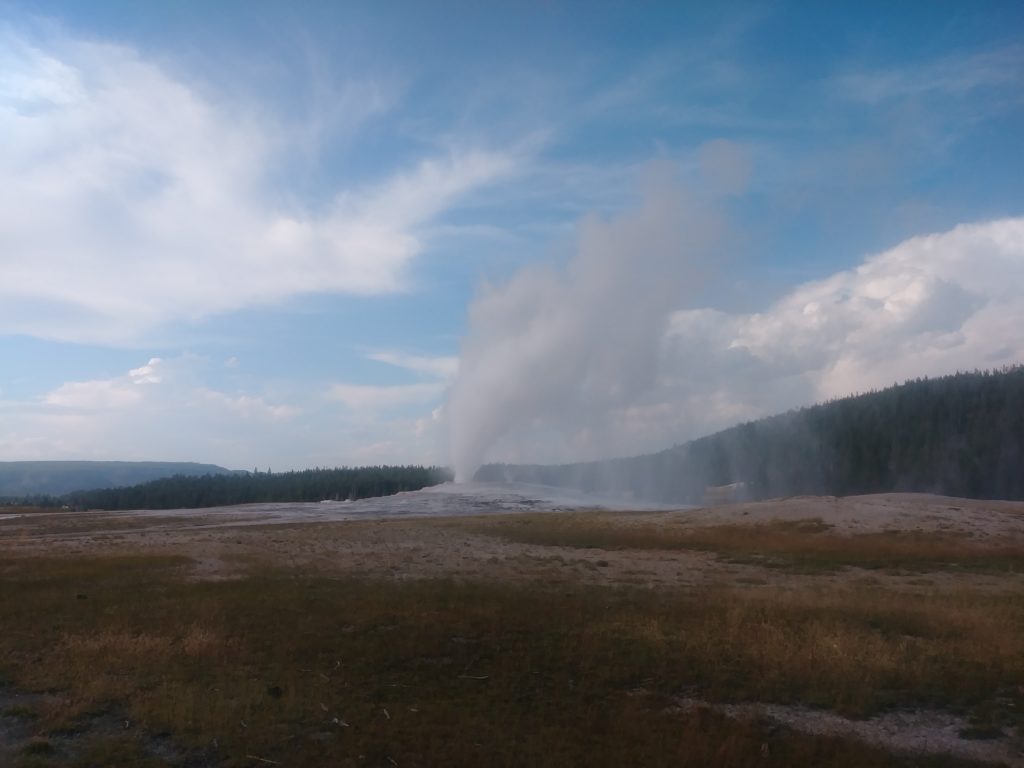
They’ve paved around Old Faithful and installed rows of viewing benches; it’s like an outdoor theater. I watched it erupt twice, from afar in the morning and up close on the benches in the evening.
All I could think was, with the complex they’ve built up around this thing, damn, are they screwed if it ever stops regularly blowing. The NPS has this to say on the subject:
“Thermal features change constantly and it is possible Old Faithful may stop erupting someday. Geysers and other thermal features are evidence of ongoing volcanic activity beneath the surface and change is part of this natural system. Yellowstone preserves the natural geologic processes so that visitors may continue to enjoy this natural system.”
Now, Old Faithful is indeed one of the most spectacular geysers at Yellowstone, in terms of how high the water and steam are flung into the air. Everyone exclaimed appreciatively when it erupted, as if at a favorite trick performed by a circus talent. It’s one of about 500 geysers in the park, but one of only six with predictable eruptions. Park rangers give a range of +/- 10 minutes on the stated prediction times for Old Faithful; the intervals between its eruptions have lengthened by about 30 minutes over the last few decades.
If you feel like tuning in to one of these showings, the Park Service helpfully provides a live webcam of Old Faithful. Link here, webcam near bottom of page. You know, if you’re having a particularly dull day.
Seeing Old Faithful was simply not a lifechanging thrill for me. Certainly it’s worth seeing if you have the chance, of course. I think my favorite geyser was Grotto, with Green Dragon Spring (at Norris) as my favorite hydrothermal feature. Honorable mentions go to Grand Prismatic Spring, Emerald Pool, Punch Bowl Geyser, and that funny yellow pool at the West Thumb Paintpots.
So, I was immediately tempted off the Old Faithful pavement and boardwalk by the trail up to Observation Point, which crosses the Firehole River. It promises a view of the Upper Geyser Basin that includes Old Faithful, and it does provide this. Sadly, it pales in comparison to the overlook above Mystic Falls, and was nothing particularly stunning. However, the trail does branch off to the Solitary Geyser, which obligingly erupts every 5-7 minutes. It was nice and quiet there, just a few folks waiting for the modest eruption (not pictured, as I got a magnificent shot of my index finger instead).
Went back down to the boardwalk that stretches behind Old Faithful to the other hydrothermal features in the area, and there really is a whole mess of cool geysers and hot springs and pools to see, with very strikingly colored bacteria and algae living in them.
Old Faithful is fine, but the boardwalk is a must do. The collection of hydrothermal features is awesome. I was standing watching one of the geysers- Aurum, I think- and a photographer who was attempting to capture it on film commented to me, “It’s mesmerizing, isn’t it?” And, it is. Watching the waters of the springs bubble, or being up close to one of the smaller geysers, so that one sees the mineral formations and the minute variations in the water erupting, is mesmerizing.
Aurum (Gold) Geyser has iron oxide around its rim that makes it look golden. It’s a cone geyser.
Let’s unpack that. Geysers are hot springs that periodically erupt; they may be cone geysers or fountain geysers. Old Faithful is a cone geyser, meaning it has a narrow opening (vent), that acts somewhat like a nozzle. As it erupts over the years, sinter (silica) can build up, creating a cone. The fountain geysers have wide vents full of a pool of water, through which erupting water and steam pass.
Grand Geyser is the world’s tallest predictable geyser. Sadly, I walked past at a time that was inconvenient for the geyser, and did not see it erupt. It is classified as a fountain geyser.
[Any unattributed useful information about the hydrothermic features in Yellowstone is ripped straight from the park signs… which, by the way, often had holes burned right through them from the geysers’ eruptions.]
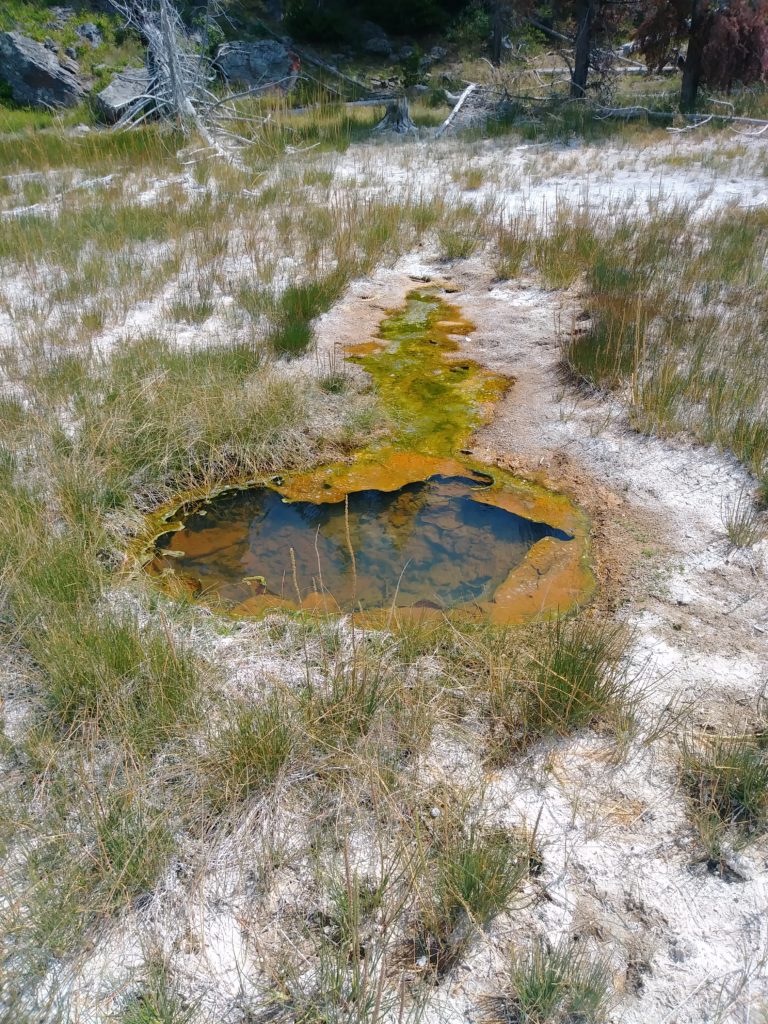
Unlike Norris Geyser Basin (which is acidic), the other geyser basins I visited (Upper, Midway, Lower, West Thumb, and Mammoth Hot Springs) are either alkaline or have neutral pH. For them, color in the pools primarily is caused by the tiny critters living in the pools. Different thermophiles thrive in different temperatures, and can be used to figure out the temperature of the water.

Giant Geyser has been on holiday since March 2019, apparently.
Grotto Geyser, a favorite of mine, is quite striking, and I got to see it erupting later in the day. Its cone is a very unusual shape. Geologists’ best guess is that hundreds or even thousands of years ago, the geyser began in a stand of trees. Its eruptions covered these trees in layers of siliceous sinter (silica).
If I’d had time, I’d’ve gone back to the boardwalk or one of the other trails I enjoyed near Old Faithful in the Upper Basin, and just sat and watched for hours on end, I think, and have never been bored.
Well, slightly bored.
But that’s what Stanley bottles of tea and notepaper are for.
So, I covered the boardwalk north. Just past where it and the parallel bike trail end was a truly lovely pool, well worth going all the way out to see: Morning Glory.
Remember our cautionary tale about the Minute Geyser? Idiots abound. Morning Glory Pool is losing its color due to assholes chucking stuff into it. Every year, park staff fish out rocks, coins, and other debris. This is not simply a hot spring, you know. Critters live in it. Those critters give it its glorious color. I would like to smack someone.
From there, realizing that hanging on to my parking space by Old Faithful would be a far wiser choice than braving the terrific traffic and driving about in search of another parking space at the nearby features, and profiting from the posted maps of the Upper Basin on the boardwalk to see that I could take a rather deserted trail up to Biscuit Basin (on my list, as were Mystic Falls, whose trailhead is behind that basin), I set off.
Biscuit Basin is a short loop of a boardwalk, but the attractions are good. At the back of the boardwalk is an incredibly dusty trail- honestly, the only fault with my decision to hike instead of drive to Biscuit Basin was that I was still in my Jesus shoes, having intended to put on my boots once I left the boardwalk and went in for some serious hiking. My feet got coated with dust, and the incline to the overlook- whose trail was composed of sand and fine gravel- would’ve been better done in hiking boots.
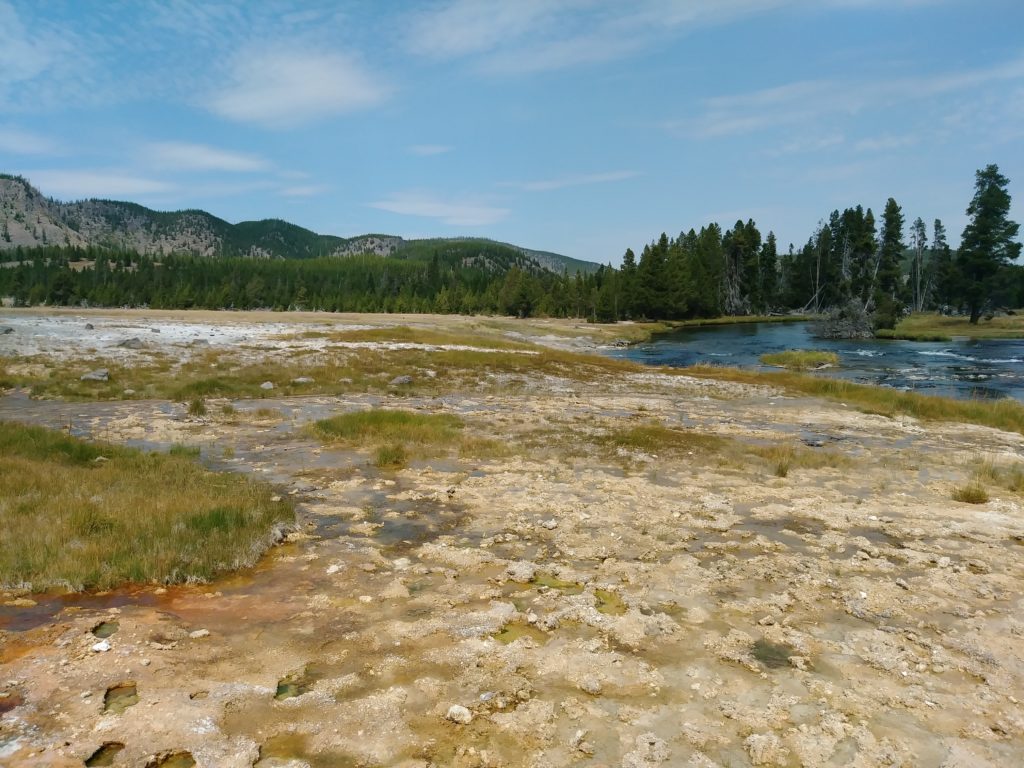
Biscuit Basin is, apparently, a particularly volatile and unpredictable part of the park, according to the sign at its entrance. It is named for the large “rock biscuits” lying about: biscuit-shaped mineral formations.
.
Mystic Falls! So, it’s in Wyoming, not Virginia as The Vampire Diaries tv adaption would have you believe. I did not see any Salvatores, but there were a lot of huge crows about. The falls are very pretty and merit a look- bit hard to find them, since the trailhead’s signs are all ripped away or faded past reading. Good thing I set out that morning with my bugout bag, despite thinking I would just be on the boardwalk before going anywhere I’d need it. I needed all my water and my maps over the course of the day, as it turns out.
Bugout bags are handy like that.
But, what’s really worth doing from that trail is not going to the falls- rather, it’s climbing to the overlook. It’s possible to take a loop up to the overlook and follow it down to the falls, which I did. The view of the whole basin- several basins, as a matter of fact- the geothermal wastes, Firehole River, surrounding mountains- all spread before you- is awesome. Trail’s a bit of a steep climb, but decent switchbacks mediating that, and it isn’t a long hike- certainly nothing like clawing one’s way up Avalanche Peak! There are cool igneous rocks to be seen along the path- obsidian and basalt, if I do not mistake my guess.
Then, of course, after finishing with Biscuit Basin, I had to get my ass back to Old Faithful, since that was where I’d left Parker. I headed back to try the bicycle trail, and had the good fortune to pass by Grotto Geyser when it was erupting. I sat and admired it and drank the last of my 2 quarts of water. It was a great show, and I got sprayed a bit when I went to capture it on camera.
The bicycle trail, compared to the boardwalk, is nearly devoid of points of interest; there’s a loop going out to Daisy Geyser (which I left for another day), and otherwise not much to see until Castle Geyser and the Crested Pool.
The water in Crested Pool often goes above the boiling point, becoming superheated. Castle Geyser is believed to be 250,000 years old- it takes a damn long time to build up a geyser cone like that. (The estimate is based on the observed rate of limestone deposits at Old Faithful.)
Oddball Neighbors
There are pros and cons to being a tenter in a campground. On the one hand, you get to see how everyone else is camping, and that is an entertaining and sometimes edifying exercise.
On the other hand, you get to see how everyone else is camping.
Of course, I am certain they all viewed me with equal misgivings. I have that sort of effect on people. I cultivate it actively.
One set of my neighbors, for example, arrived at their site and proceeded to back their car into a pull-through space. This proceeding did not give me high hopes about their intelligence. They were the ones who forgot to close their car trunk on several nights, as well.
Then there was the sizable encampment of Russians, spanning several sites- a number of families with small children. I have no complaints about them. It’s just that they projected Winnie the Pooh onto a screen every night for their offsprings’ entertainment, and it was somewhat jarring to hear Eeyore being depressed in Russian. I felt like passing him a bottle of vodka.
There was the gentleman attempting to split firewood with a chisel, wearing gloves to protect his soft hands during the process- his wife began to tease him after he’d been over an hour preparing to get a fire going.
Surely she knew he was so woefully inept before she married him?
Then there was the site occupied by practicing witches, or sirens or something. They made these droning hums, sometimes together, around their fire. They tossed and turned incessantly on their noisy air mattress. I overheard one of these witchy-woo neighbors asking the other to tell her about her visions.
Sadly, I did not overhear the elucidation of these visions. They proceeded to directly discuss whose car they’d take for the day’s sightseeing.
You meet all sorts in campgrounds.
I mean, I was there, after all. Rather like in NYC, one is always guaranteed to not be the strangest bird in a campground.
A change in the wind
I profited by a rainy day to drive back to Cody and resupply. I felt a strange pressure on my chest the whole time I was in Cody. It took a little while, but I realized, when it disappeared back in Ystone, that this was due to having descended some 4,000 feet to get to civilization.
Huh.
The following day, I arose and thought the day was again to be rainy again, or at least cloudy.
It wasn’t clouds, precisely. There was a strange, red sun trying to burn through the haze.
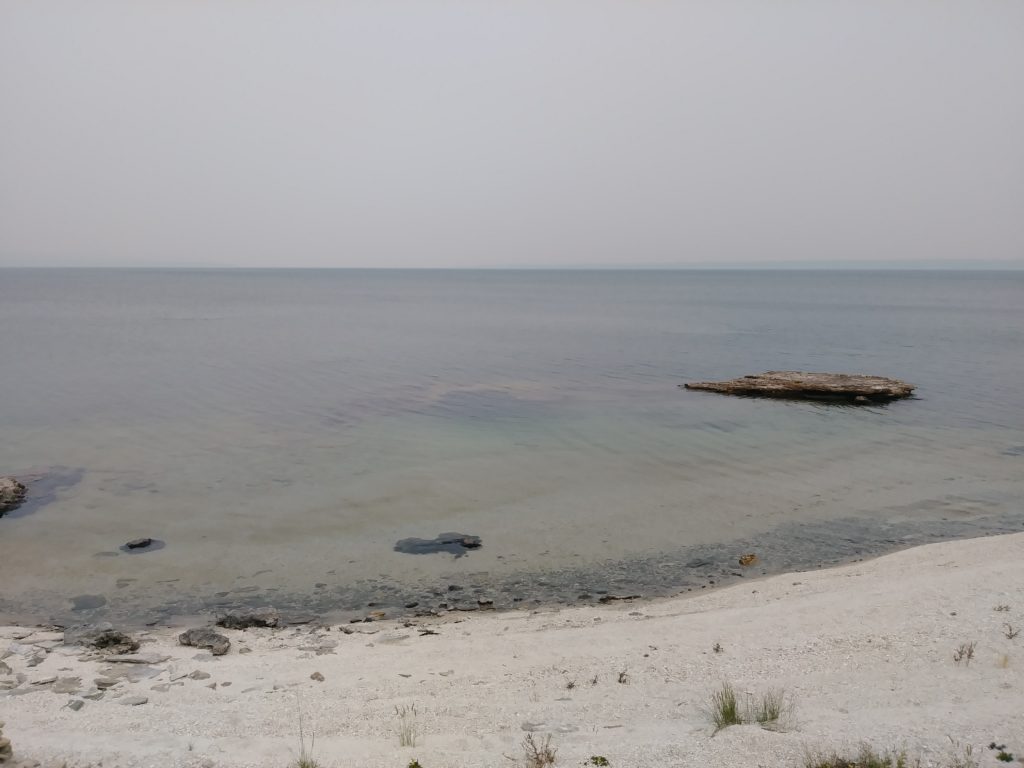
Turns out, the wildfires, though a significant distance away in California, were nonetheless profoundly affecting the atmosphere in Wyoming. The haze lingered- even augmented- for the remaining handful of days I stayed in Yellowstone. It was really rather fortunate that I climbed and took in all the views I did before this occurred.
The invisible Grand Tetons
Directly south of Yellowstone National Park is Grand Teton National Park. I was not particularly keen on visiting it- there’s more than enough in Yellowstone to occupy 2 months, never mind 2 weeks- but it seemed worth a look, so long as I was only an hour or two away.
Sadly, my visit coincided with the arrival of the smoky haze from the west, and it was rather a bust. The haze was so thick that I could only occasionally see outlines of the grand mountains- a terrific tease.
The haze never cleared sufficiently to warrant a return attempt.
West Thumb Geyser Basin
Happily, while the Grand Tetons could not provide entertainment, there were more geothermal features in Yellowstone awaiting me. I explored the geyser basin that lies some mere 2 or 3 miles from Grant Campground when I returned from my disappointing drive to the Grand Tetons.
This geyser basin is less frequented than the others I visited. I am uncertain if this is due to location, or a simple lack of interest, but I thought it a delight. It’s almost twenty miles from Old Faithful, and sits right on the shore of Yellowstone Lake. Its features are every bit as colorful and eye pleasing as any other geyser basin’s in the park.
It was the only place I saw a yellow pool. There are geyser cones sitting out in the lake. The West Thumb of Yellowstone Lake is apparently the result of volcanic activity, and the geothermal features the lingering signs of it. There is one muddy pit that looks exactly like a footprint from Bigfoot- damn things smells like a tuna melt, which was both a nice change and a disturbing development. I believe my nose gradually became accustomed to the disagreeable odors in the park over the course of my stay, but to have one of these devilish pits actually smell good… well, perhaps it was more a product of my not getting enough animal protein in my diet than anything else.
Being at the lakeshore drove home just how much visibility the haze had stolen. Where I had previously had views clear across the lake to the Absaroka Range, I could scarcely make out even the near curves of the shoreline.
Word on the street was that you could catch a fish in Yellowstone Lake and then toss it into the Fishing Cone to cook it for yourself.
Look!!!! I found Bigfoot!
After the boardwalk, I took the short trail up to Yellowstone Lake Overlook that begins in West Thumb Geyser parking lot. It’s a very pretty trail, not hard. There are a couple of steaming fissures at the top as a surprise bonus. My view, however, was sadly hampered by the haze. Otherwise, I think it would have been a fine one.
Old Faithful area, day 2
I returned to the general area of Old Faithful and x’ed off the remainder of the features listed on my arm in rather durable ink.
I believe this was the day when I declared, “My kingdom for a shower!”
Having no kingdom, I received no shower.
Ah, the indignities of a Great Trek when it takes a turn through the wilderness!
Well, Old Faithful, take 2. I started out at Black Sand Basin, so named because obsidian has been worn down into black sand in a few select parts of the geyser basin. It’s one of the smaller basins, but, my word, is it possessed of some interesting features. I particularly enjoyed Emerald Pool, whose striking color was unlike anything else I had seen.
Living on the Edge
Like me!
This informative sign described how bacteria and algae live in colorful mats in the hot water, flies and other insects eat them, and spiders live on the edge of the heat, eating flies.
The thermal features’ heat helps the large mammals, like elk and bison, survive the hard winters.
From Black Sand, I struck out on an apparently little-used path that connected to the loop off the bike path containing Daisy Geyser. I saw the tail end of Daisy’s eruption; honestly, I don’t know why the big deal on that loop is Daisy Geyser. I enjoyed the Punch Bowl Geyser so much more. It has intriguing mineral formations and spectacular thermophiles.
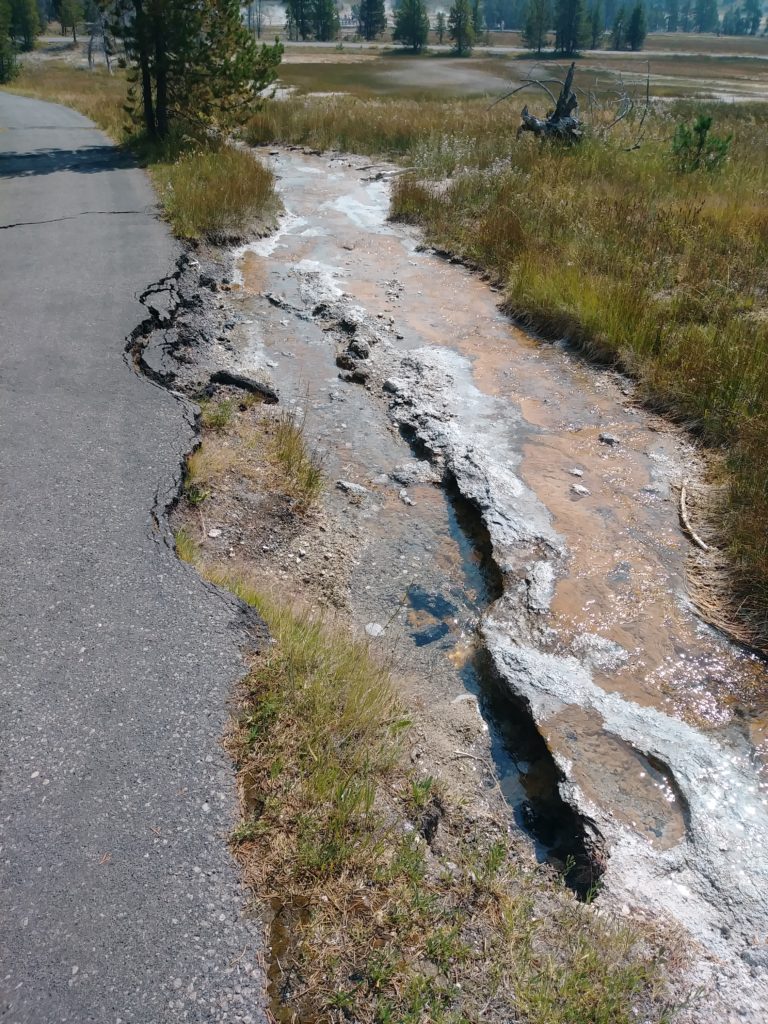
I next drove up to the trailhead for Fairy Falls- the trailhead nearest the falls, at any rate. Fairy Trail in its entirety is on the longish side for a day hike.
Remember how we discussed that I tend to not plan my life as carefully or in as much detail as would be possible? Well, it turns out that this hike out to Fairy Falls also affords the best viewing of Grand Prismatic Spring. Oddly enough, there’s a loop up to an overlook of it about fifteen minutes from the parking lot for the trailhead. You do have a glimpse of Grand Prismatic from the trail, but the view from the overlook is spectacular. It’s everything one sees in the pictures- I must say, I wasn’t expecting it to actually live up to the intense vibrancy of color the pictures promise, but indeed it does.
The blue color comes from light being scattered by fine mineral particles suspended in the water. The bright orange, yellow, and brown in the runoff channels comes from thermophiles (bacteria); it helps them produce energy from the sunlight.
Fairy Falls was well worth the hike (maybe an hour from the parking lot), both for the falls itself and the five otters frolicking in the pool at its base. The trail leads straight up to the pool at the base of the falls, then continues on.
Being at the bottom of a waterfall is more impressive than seeing it from the top, in general, I find. Fairy Falls is narrow, with not a huge volume of water, but it is elegant in its descent. The rocky face it descends is pretty, and the pool at the bottom is very picturesque. It was cold, standing next to the pool, in the shadow of the mountain and getting covered with the spray from the falls. The otters were hanging out in an otter pile on the rocks, by the falls and across the pool from the hikers. Occasionally they went for short swims.
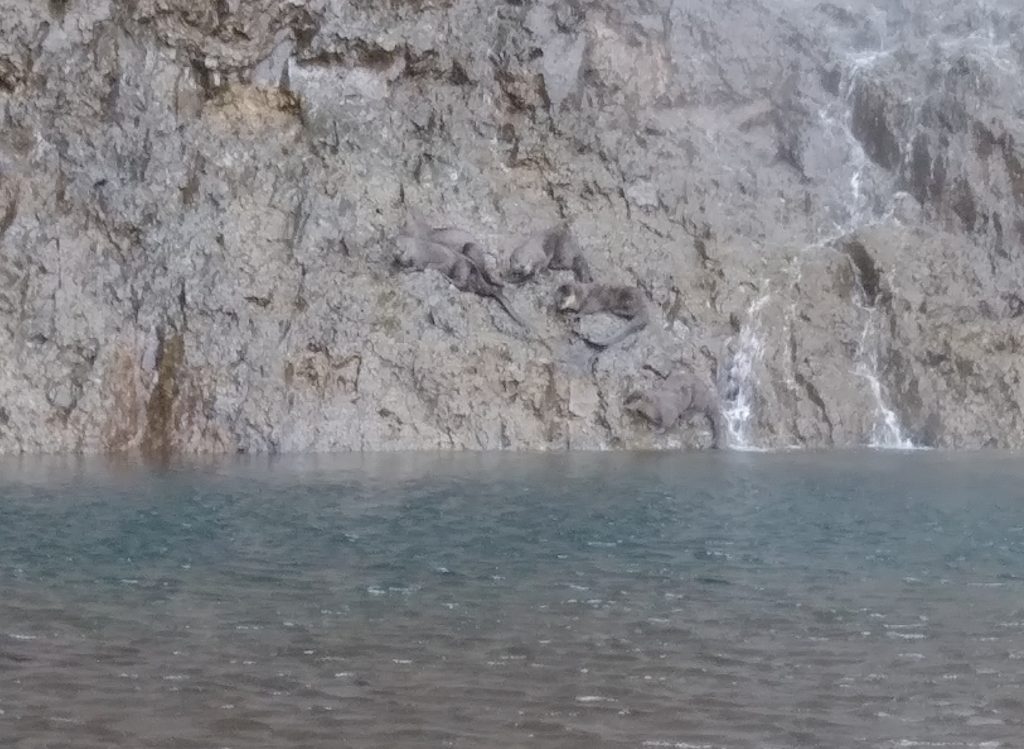
If you continue on the trail, past the falls, you reach two geysers, Imperial and Spray, which merit the short extra hike. You follow a pretty, colorful hot creek up to the larger geyser, which happened to be erupting when I arrived.
My final stop of the day was at Midway Geyser Basin. Crawled around the tiny parking lot- well, mostly sat in the entrance drive, in line) for almost fifteen minutes, and it was clear that, any earlier in the day, securing a parking space in the lot would have been essentially impossible, as evidenced by the numerous cars that still remained scattered along the road for a good ways in either direction.
It’s a short boardwalk- I covered it in 15 minutes, and a I dawdled for pictures, as everyone else was. The other geothermal features were cool, but Grand Prismatic Spring is just too big to properly view from a boardwalk, and too steamy. Can kind of see the colors from that vantage, but the depths of the pool and the brilliant clashes of color that were apparent from the overlook just were not visible on the boardwalk. If I hadn’t seen it from the overlook, I wouldn’t have understood what all the fuss was about.
The thermophiles living in the runoff from Grand Prismatic have been upgraded to “extremophiles,” since they live in conditions so extreme it was at one time thought these were incapable of supporting life. The pool is 200 feet across with a temperature of about 160°F. Almost 500 gallons of water per minute runs off from it into the Firehole River.
I beg your indulgence- I am going to quote one of the informative signs on the boardwalk, rather than use my own words- but I found it extremely interesting.
Miniature Forests
Within the rainbow of orange, red, and brown colors, some microorganisms live in communities of thick mats. Like miniature forests, these mats have a vertical structure and stratified functions. Microbes that live on or near the top of the mat (similar to a forest canopy) use sunlight to perform photosynthesis, which fuels the mat community. Organisms living deeper in the mat (similar to a forest understory) derive energy from chemicals produced by the surface microbes. They perform other vital functions such a decomposition and recycling nutrients to the mat’s “canopy” just like their counterparts in a forest. All of these organisms create an ecosystem in the expanse of a few inches.
I took an extended drive back to my campsite that night, through Hayden Valley again, and remarked upon how Yellowstone is different in the twilight, and not just because of all the critters out (sat in yet another bison jam in the valley, and saw two elk bucks). Somehow the fading light makes the place look more fantastic.
Final days at Yellowstone
I took a bit of a breather from my hyperactive rushing about for the last couple of days. (I know, shocking.) I actually sat and drank my tea in the morning, rather than tossing it back while driving in Parker. I took my camp chair down to the lakeshore, and sat and wrote. I did my laundry. I returned to West Thumb Geyser Basin, found a bench in the shade, and sat and wrote some more. Really, that was an excellent spot- a view of both the lake and the hydrothermal features.
Twin Geyser hasn’t erupted since 1999, apparently.
Two weeks is probably the shortest time one could spend in Yellowstone and not leave thoroughly frustrated by how little of it one had seen. I was ready to go. Still, I’d’ve liked to have done a bit more of what I did those last two days: less scurrying about, more sitting and absorbing the wonders around me. Of course, then I would have missed a number of sights I am very glad I saw.
The day before I left, I learned it was very fortunate indeed that I did part 2 of the Old Faithful area when I did- now Yellowstone had its own fire burning. There was a dark streak visible in the everpresent haze- doubtless the smoke from the nearby fire.
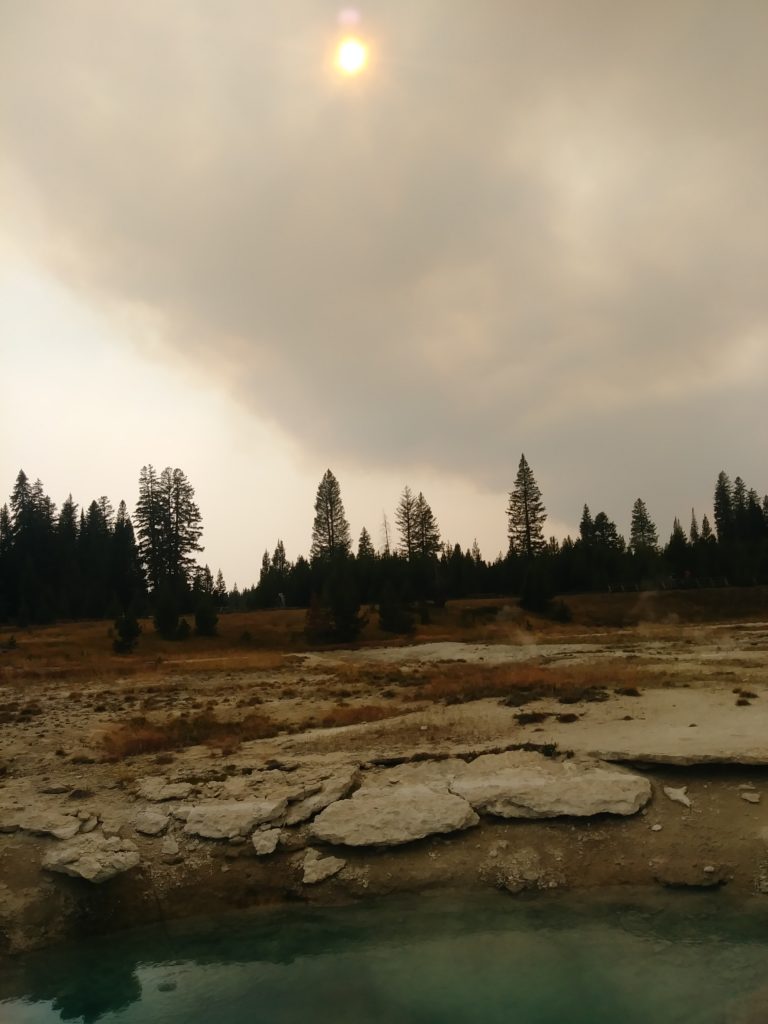
I would like to state for the record that the curious proximity in time between my departure and the setting of this blaze had absolutely nothing to do with one another.
Nothing.
The poor trees. They struggle so to stay alive in Yellowstone- all these scraggly, short lodgepole pines with such a number of dry, brown needles on them, the product of the extreme dryness that seems pervasive in the park at this time.
Miscellaneous
As it turns out, earbuds are strictly designed for those who wash themselves on a regular basis. I find this somewhat discriminatory and disappointing.
Based on license plate sightings, it appeared 1/3 of the state of Utah was driving about Ystone, and a solid 1/4 of Washington state. Colorado and Idaho were represented in large numbers, as well.
Tourist brochures, pinecones, and cardboard… bloody hell, does that shit get a fire going!
Two days before I left, I gave in and bought a souvenir. Drank tea in Yellowstone from my Yellowstone mug, and felt oddly… civilized. Rather enjoyed it, really. So damn, delightfully civilized. I suppose I had been drinking tea out of vacuum bottles for quite a while then, with the rare exception of tea in a disposable cup when I hit a coffeeshop.
Gripe about boots- got them wet on Sunday, let them air out on Monday, had a nasty wet hike in them Tuesday. Wednesday morning I was standing in the bathroom using the hand air dryer on them, and then I stuffed them with paper. And then they were sort of dry by Thursday. They held up well to the hiking I did in them, and the traction was excellent. But if my running sneakers can dry themselves out within three hours, I think 36 ought to be enough for hiking boots. Besides, even after a hundred miles, they still regularly inflicted blisters after five or six miles on a trail, despite excellent socks. It was frustrating. I think I’ll be moving on from Salomon.
The boiling point of water in Yellowstone is 199°F, by the way. My tea water boiled faster! My dinner simmered faster!
I can now confidently assert that maple syrup does not require refrigeration. This makes sense, does it not? Maple trees don’t refrigerate their sap, after all. Aside from the week in the Badlands where I bought ice, my jug of maple syrup remained at air temperature- and sometimes quite a bit above, in the bed, when Parker was in the sun- and it’s just fine.
Conclusion
I think it’s safe to assert that I saw as much in two weeks at Yellowstone as I did in two months of the Great Trek elsewhere.
I never entirely lost that unsettled feeling I got on my first day. I delighted in visiting the colorful geothermal features, but, in the background, simmered the knowledge that we were just all scampering about a caldera formed when the top of a supervolcano’s magma chamber collapsed. A volcano that is still hot.
I am relieved it didn’t explode or shake apart while I was there.
Also, I am fucking filthy. And- tanned?!
Okay, lovelies- on to Washington state!
